
- Trekking & Travel Events
- Travel Organizations
- Himalayan Treks
- Maharashtra Treks
- Karnataka Treks
- Travel Guides
- Weekend Getaways
- Trekking Tips & Advice

Tarsar Marsar Trek: An Ultimate Guide
- Trekking Destinations
Table of Contents
Tarsar Marsar Trek: An Introduction
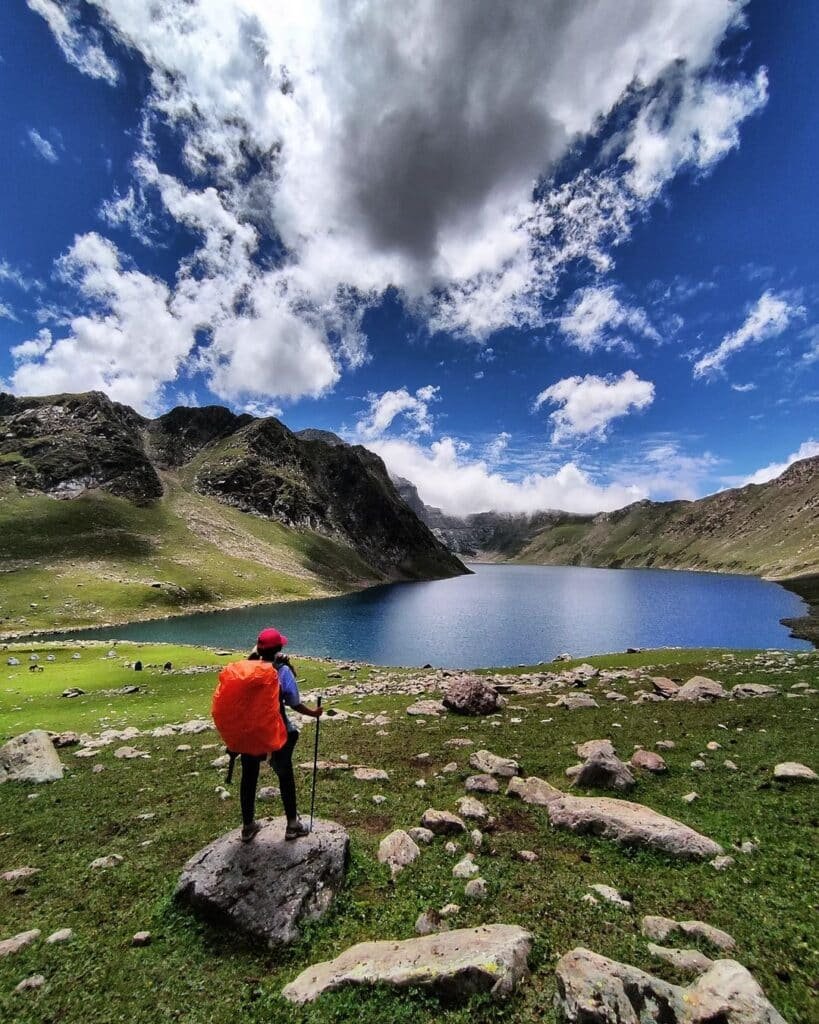
The Tarsar Marsar trek is among the most popular in the Indian Himalayas. The trek takes you through the beautiful valleys of Kashmir, offering breathtaking views of the Tarsar and Marsar lakes. The trek is moderate and can be completed in about 7-9 days. In this article, we will discuss the reasons to go on the trek, what to expect on the trek, and how to plan for it.
Reasons to go on Tarsar Marsar Trek
- The Tarsar Marsar trek is ideal for those who want to experience the beauty of the Himalayas without having to endure a challenging trek. The trek offers diverse landscapes, including beautiful meadows, dense forests, and stunning lakes.
- The Tarsar and Marsar lakes are the highlights of the trek, and they provide an opportunity to camp by the lakeside and enjoy the serene surroundings
What to Expect?
- The trek starts from the Aru Valley and takes you through beautiful meadows and dense forests. As you climb higher, you will see stunning views of the Himalayan peaks.
- The highlight of the trek is the Tarsar and Marsar lakes, which are situated at an altitude of 13,000 feet. Snow-capped peaks surround the lakes and offer a breathtaking view. The trek also involves crossing streams, glaciers, and high-altitude passes.
Planning Your Tarsar Marsar Trek
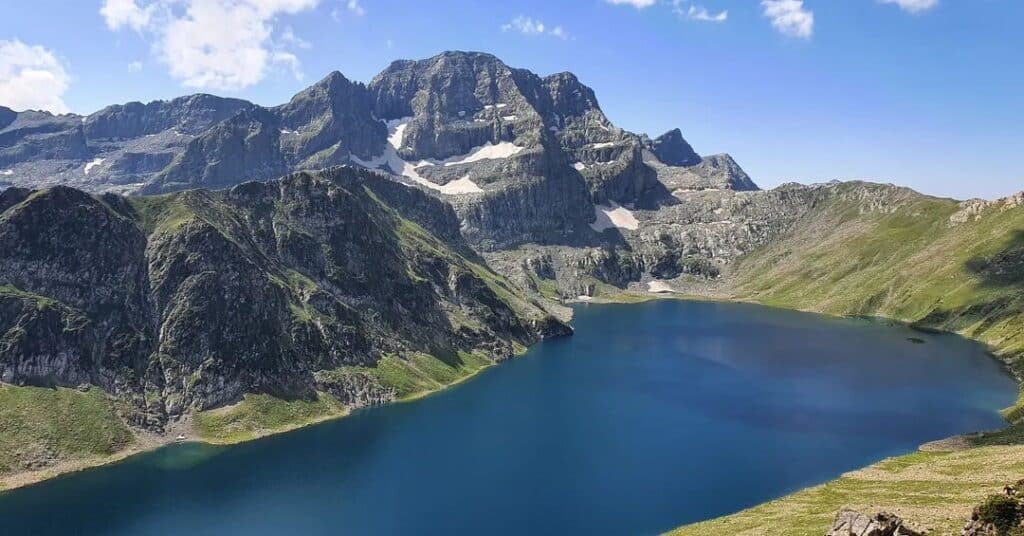
- Best Time to Go: The best time to go on the is from June to September when the weather is pleasant, and the skies are clear.
The trek involves steep ascents and descents, rocky terrain, and high altitude. Trekkers are advised to undergo physical training and acclimatization before embarking on the trek.
- Acclimatization: Since the trek involves high-altitude passes, acclimatizing is essential. You should spend a day or two in Srinagar or Aru Valley to acclimatize before starting the trek.
- Required Permits and Fees: You must obtain a permit from the Forest Department to enter the Tarsar Marsar area. The permit fee is around INR 1000 per person. However, if you are going with a trekking organization, the organization already arranges this.
- Gear and Equipment Checklist: You will need a good pair of trekking shoes, a backpack, a sleeping bag, a tent, warm clothes, and rain gear. You can also rent equipment from trekking agencies. Again, while going with a trekking group, you only need to have good trekking shoes, dry-fit clothing, a 40-60L trekking bag, personal toiletries, etc. A detailed list is shared below.
- Fees Charged by Trekking Groups: Trekking agencies charge around INR 14,000 – INR 16,000 per person for the Tarsar Marsar trek, which includes food, accommodation, entry fees, and guide charges. Some organizations also have the pick-up and drop from Srinagar to the start point & back.
- Best Season: The best time to go on the Tarsar Marsar Trek is between June and September when the weather is pleasant and the trails are open. During this time, the region experiences mild temperatures and clear skies, making it ideal for trekking. However, there maybe rain showers on certain days.
Prefer trekking in groups and having the entire planning sorted out by someone else?
We list over 100 groups in India with their events, contact details, social links and ratings.
Trek The Himalayas
A world of trekking & exploring.
- +91 991 772 4737
- Trekking Group
Bikat Adventures
You dare, we deliver.
- SPAZE ITECH PARK
Trekkers of India
India's biggest trekking community.
- Travel Organization
Getting to the Start Point
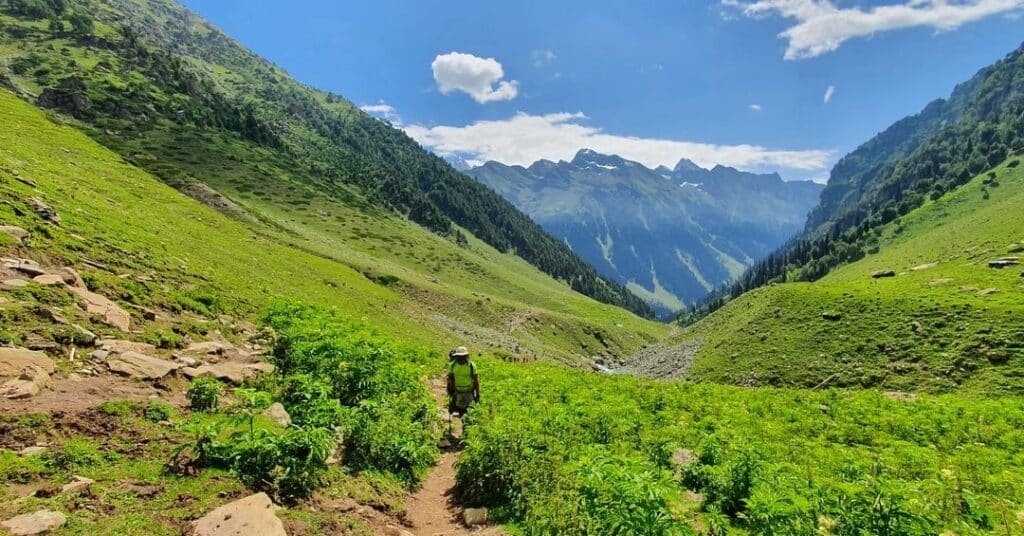
- How to Reach Tarsar Marsar Trek Starting Point: The Tarsar Marsar trek starts from the Aru Valley, about 110 km from Srinagar. You can take a taxi from Srinagar to Aru Valley.
- Local Transportation Options: Local buses and shared taxis are available from Srinagar to Pahalgam, where you can take a cab to Aru Valley. The best option is to take shared taxi from Srinagar, as they run frequently and are affordable (Approx INR 150 – 200 per person).
- Accommodation Options Before and After the Trek: Srinagar and Pahalgam have several accommodation options. You can also stay in tents or guesthouses in Aru Valley.
Tarsar Marsar Trek Itinerary
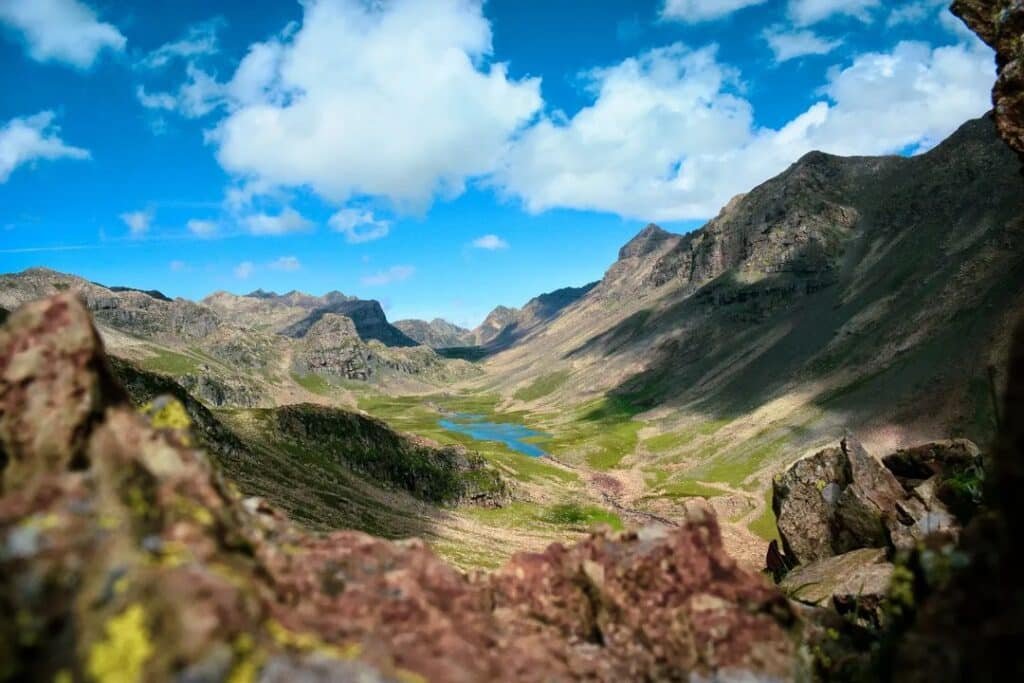
Day 1: Srinagar to Aru Valley
- The first day of the trek involves a four-hour drive from Srinagar to Aru Valley, where you will spend the night. The drive itself is a treat, with stunning scenery all around.
Day 2: Aru Valley to Lidderwat
- Distance: 10 KM | Time: 6 Hours
- The trek begins with a six-hour trek from Aru Valley to Lidderwat. The trail takes you through pine forests, meadows, and streams.
Day 3: Lidderwat to Shekwas
- Distance: 6 KM | Time: 5 Hours
- The third day of the trek is a five-hour hike from Lidderwat to Shekwas. You will pass through dense forests and cross a stream before reaching your destination.
Day 4: Shekwas to Tarsar Lake
- Distance: 4 KM | Time: 5 Hours
- The highlight of the trek, day four, takes you to the beautiful Tarsar Lake. It’s a five-hour trek through lush green meadows, and you’ll also encounter a glacier along the way.
Day 5: Tarsar Lake to Sundarsar
- The fifth day involves a five-hour trek from Tarsar Lake to Sundarsar. The trail takes you through some challenging terrain, but the stunning views throughout the day make it all worthwhile.
Day 6: Sundarsar to Homwas via Marsar Lake
- Distance: 11 KM | Time: 7 Hours
- The sixth day is a five-hour trek Sundarsar to Homwas via Marsar lake. You will encounter a few streams and meadows along the way, making for a pleasant trekking experience. This will be one of the toughest days of the trek because of the ascent involved.
Day 7: Homwas to Aru & Drive to Srinagar
- Distance: 13 KM | Time: 7 Hours
- The last day of the trek is one of the easiest days and can be easily covered in 7 hours with breaks in between for lunch & snacks.
Note: This is a general itinerary, which is followed by most of the trekking groups in India. However, there might be slight differences on the itinerary depending on the trekking group you opt to go with.
Tarsar Marsar Trek Highlights
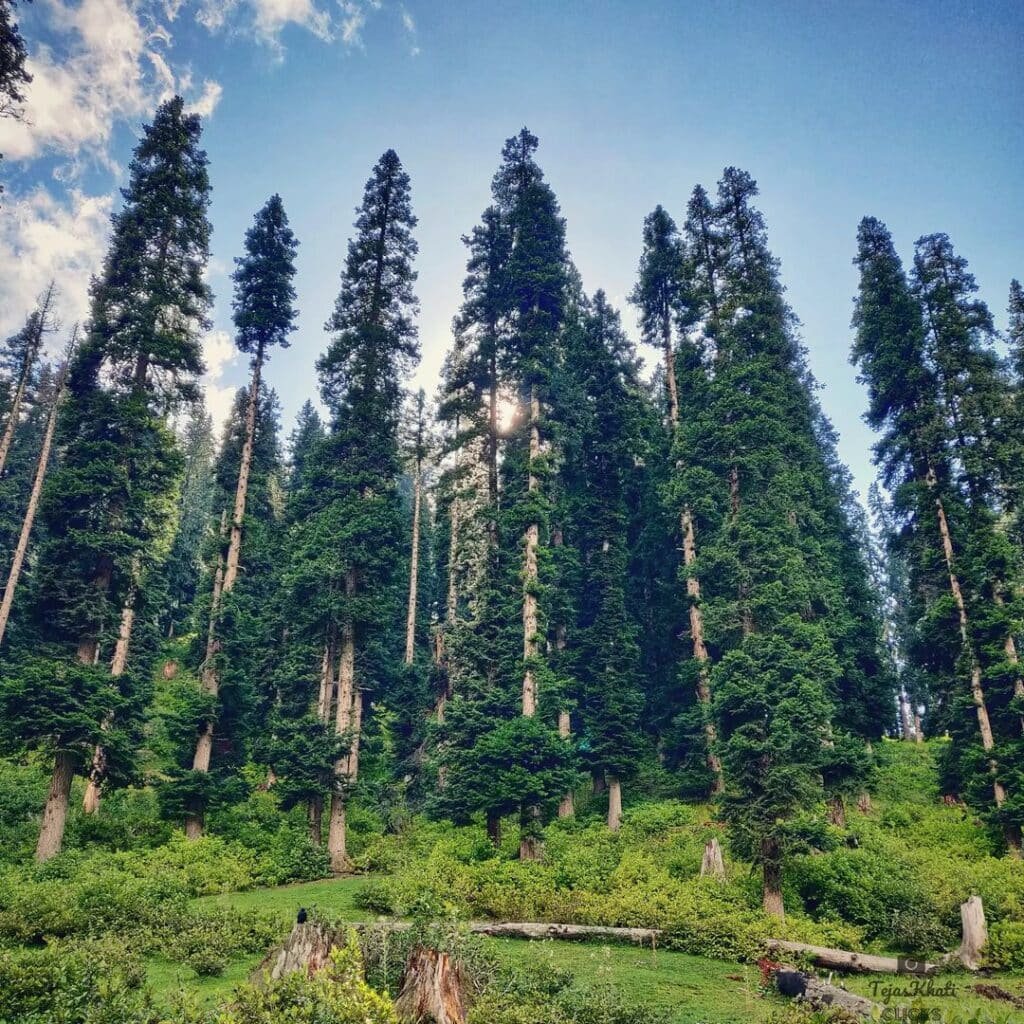
Stunning Scenery:
The Tarsar Marsar Trek offers some of the most beautiful views you’ll ever see. From lush meadows to snow-capped peaks, this trek has it all.
Wildlife Sightings:
The trek is home to some unique flora and fauna, including the Himalayan black bear, musk deer, and snow leopard.
Local Culture:
The trek takes you through several remote villages, giving you a glimpse into the local culture and way of life and the local trek guides have amazing local stories and folklore which give you a glimpse of their culture and history.
The Tarsar and Marsar Lakes:
The two lakes are the highlight of the trek, offering stunning views of the surrounding peaks and a sense of serenity that is hard to find elsewhere.
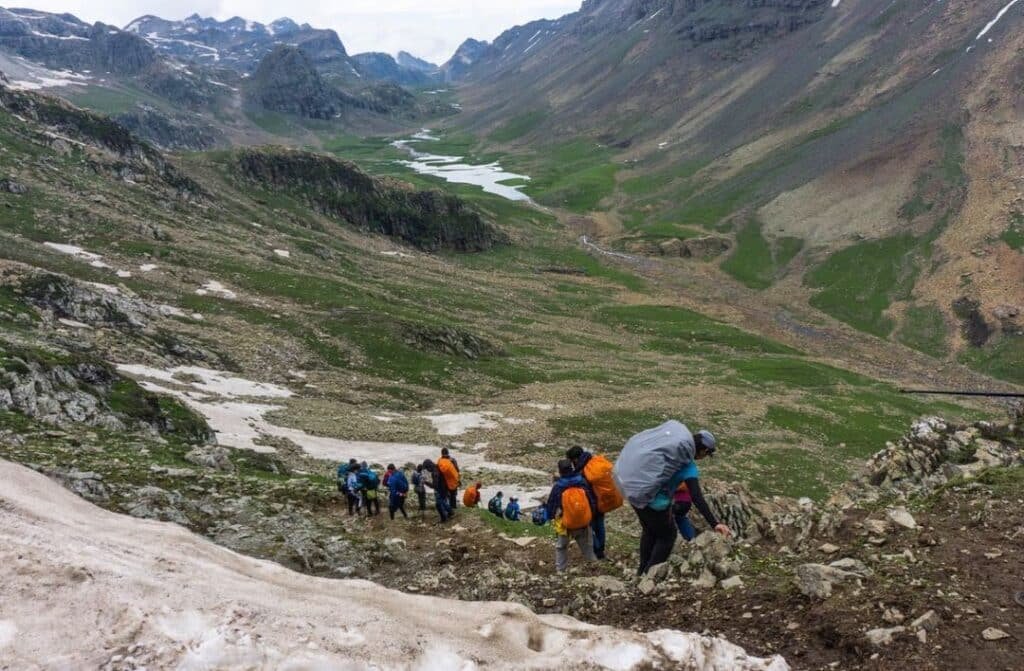
Safety and Health
Altitude Sickness: The trek reaches an altitude of 13,000 feet, so it’s essential to acclimatize yourself to the altitude before starting the trek. Hence, you should reach Srinagar a day or two in advance & stay hydrated throughout the trek and carry hydration tablets if necessary.
Water and Food Safety: The trek involves several streams and water sources, but it’s essential to carry a water purification system to avoid water-borne illnesses. Also, make sure to carry high-energy snacks and stay hydrated throughout the trek.
First Aid Kit: Carry a basic first aid kit that includes essential medications, bandages, and other medical supplies. However, if traveling with a trek group, they make these arrangements for you.
Emergency Evacuation: In case of an emergency, make sure to have travel insurance that covers evacuation services. Make sure to check with the trek group if they provide the travel insurance to cover your expenses.
The trek is around 48 kilometers long and takes about 7 days to complete.
The best time to go on the trek is from June to September when the weather is pleasant, and the lakes are not frozen.
The trek is considered moderately difficult, with some challenging terrain, but it’s doable for most people with proper preparation.
The trek is generally safe, but it’s essential to take proper precautions and follow safety guidelines to avoid any mishaps.
You’ll need a sturdy pair of trekking shoes, warm clothes, a backpack, a tent, a sleeping bag, and a water purification system.
- In conclusion, the Tarsar Marsar Trek is an incredible adventure that offers breathtaking scenery, diverse wildlife sightings, and an immersive experience of the local culture.
- From the picturesque Aru Valley to the serene Tarsar and Marsar Lakes, the trek takes you through some of the most beautiful landscapes in the world. It’s important to keep in mind that the trek requires proper planning, preparation, and caution, especially when it comes to altitude sickness, water and food safety, and emergency evacuation.
- However, with the right mindset and guidance, this trek can be a life-changing experience that you’ll never forget. So what are you waiting for? Start planning your Tarsar Marsar Trek adventure today!
An Immersive Experience of the Trek
Video Credit: Ankit Bhatia Films
Did you find this trek guide for the Tarsar Marsar trek informative?
We have 100s more such guides on similar off-beat experiences & we send out such guides, offers, hidden gems, and trekking destinations weekly via email.
Subscribe to our newsletter to get them directly into your inbox.
Kuari Pass , Bhrigu Lake , Brahmatal Trek , Sar Pass Trek , Shrikhand Mahadev Trek , Buran Ghati Trek , Bali Pass Trek , Kareri Lake Trek , Kashmir Great Lakes Trek , Rupin Pass
- trekking guides
Kashmir Great Lakes Trek: Ultimate Guide - Nomads of India
[…] Related Article Discover the scenic beauty of the Tarsar Marsar trek – an easier alternative to the Kashmir Great La… […]
Trekking Shoes: The Ultimate Guide 2023 - Nomads of India
[…] insulation, and durability. Mountaineering boots. They are good for multi-day hikes like the Tarsar Marsar trek or the Kuari pass […]
Rupin Pass Trek: Unleash the Thrill of the Himalayas - Nomads of India
[…] Kuari Pass, Bhrigu Lake, Brahmatal Trek, Sar Pass Trek, Shrikhand Mahadev Trek, Buran Ghati Trek, Bali Pass Trek, Kareri Lake Trek, Tarsar Marsar Trek […]
Bhrigu Lake Trek: Ultimate DIY Guide 2023 - Nomads of India
[…] Kuari Pass, Brahmatal Trek, Sar Pass Trek, Shrikhand Mahadev Trek, Buran Ghati Trek, Bali Pass Trek, Kareri Lake Trek, Rupin Pass, Tarsar Marsar Trek […]
Kareri Lake Trek: The Ultimate DIY Guide - Nomads of India
[…] Kuari Pass, Bhrigu Lake, Brahmatal Trek, Sar Pass Trek, Shrikhand Mahadev Trek, Buran Ghati Trek, Bali Pass Trek, Kashmir Great Lakes Trek, Rupin Pass, Tarsar Marsar Trek […]
Bali Pass Trek: Exploring the Majestic Himalayan Trail - NOI
[…] Kuari Pass, Bhrigu Lake, Brahmatal Trek, Sar Pass Trek, Shrikhand Mahadev Trek, Buran Ghati Trek, Kashmir Great Lakes Trek, Kareri Lake Trek, Rupin Pass, Tarsar Marsar Trek […]
Hampta Pass - Top 5 reasons why it should be your first Himalayan trek - Nomads of India
[…] Kuari Pass, Bhrigu Lake, Brahmatal Trek, Sar Pass Trek, Shrikhand Mahadev Trek, Buran Ghati Trek, Bali Pass Trek, Kareri Lake Trek, Kashmir Great Lakes Trek, Rupin Pass, Tarsar Marsar Trek […]
Epic Adventure Awaits: The Ultimate Goechala Trek Guide - NOI
[…] Kuari Pass, Bhrigu Lake, Brahmatal Trek, Sar Pass Trek, Shrikhand Mahadev Trek, Buran Ghati Trek, Bali Pass Trek, Kareri Lake Trek, Rupin Pass, Tarsar Marsar Trek […]
Add a comment
Leave a reply · cancel reply.
Your email address will not be published. Required fields are marked *
This site uses Akismet to reduce spam. Learn how your comment data is processed .
- Share via...

Tarsar Marsar
Arguably The Prettiest Trek In India
Enquire Now
Permissions temporarily retracted for 3 treks in Jammu & Kashmir due to unrest in the region click here for more information
click here for more information
TREK DIFFICULTY
TREK DURATION
HIGHEST ALTITUDE
Tarsar Marsar is arguably the prettiest trek in India. This is a title we do not give treks lightly. Especially when its formidable sister trek, Kashmir Great Lakes , is in the picture.
However, Tarsar Marsar is a trek where alpine lakes take a life of their own. It is not just the fact that you get to camp beside these royal blue, snow-fed lakes (you don’t get this camping chance even at KGL). Or the secluded nature of these campsites (a Godsend in today’s trekking scenario!).
You get to circumvent the entire perimeter of Tarsar and Sundersar, offering you multiple perspectives of the very same lake!
Then there is the elusive Marsar, almost always hidden under a shroud of clouds. We see this lake from an overhang, sitting 600–700 ft below. It is a perfect spot to witness the grandeur of the lake, with the sun rising right above it. This is until dollops of clouds waft their way through the U-shaped valley and settle above the lake. The lake disappears from view within seconds!
The Tarsar Marsar trek takes you right to the heart of Kashmir. From the quaint village of Aru to the clearings of Lidderwat. From the rolling green mountains of Shekhawas to the massive alpine lakes. The setting of Tarsar Marsar is such that it leaves you visually stunned for weeks together!
Tarsar Marsar - Complete Trek Information
We have always wanted trekkers to be well-informed before they go on a Himalayan trek. Knowledge is the difference between a safe trek and a dangerous one. It’s also the difference between a wholesome experience and a superficial experience.
Use this section to learn about the Tarsar Marsar trek. It has in-depth information about each day of the trek, what to expect, and how you need to prepare for it. Many years of expertise have gone into this content. Trekkers find these extremely useful.

Quick Itinerary
Get your trek plan

Study this chart to know how much altitude you would gain/lose every day on the Tarsar Marsar Trek
Drive from Srinagar to Aru
Drive distance: 100 km | Drive Duration: 3-4 hours | Pick up point for Indiahikes trekkers: Sheikh Feroze Tours & Travels, Sathu, Barbara Shah Chowk, Srinagar
Transport will be organised from Sheikh Feroze Tours & Travels, Sathu, Barbara Shah Chowk, near Flourmill, Srinagar. at 8 AM sharp. The cost of transport is Rs 600 per trekker and needs to be paid directly to the driver. The vehicle will be non-AC.
Note : The process of your registration, health screening, and document verification start at 1 pm. Ensure you reach Aru on time for it. Do not travel elsewhere on this particular day before your trek.
Trek from Aru to Lidderwat
Trek distance: 10 km | Trek Duration: 6 hours | Altitude gain: 7,960 ft to 9,120 ft
Easy-moderate. Initial gradual ascent for about half an hour followed by gentle undulating walk until you reach the campsite of Lidderwat.
Trek from Lidderwat to Shekwas
Trek distance: 5.6 km | Trek Duration: 5 hours | Altitude gain: 9,120 ft to 11,035 ft
Moderate. Continuously ascending trail for the first couple of hours with a few short level walks. You have a river crossing just before Homwas followed by a gradual ascent.
Trek from Shekwas to Tarsar
Trek distance: 5 km | Trek Duration: 4 hours | Altitude gain: 11,035 ft to 12,435 ft
Moderate. Continuous ascent, mostly on gradual inclines to reach the ridge and then entering into the meadows of Tarsar.
Trek from Tarsar to Sundersar via Tarsar Pass
Trek distance: 5 km | Trek Duration: 5 hours | Altitude gain: 12,435 ft to 12,945 ft via 13,140 ft
Moderate. Steep ascent in the beginning to the pass, followed by a descent and then a gentle ascent to Sundarsar.
Trek from Sundersar to Homwas via Marsar
Trek distance: 9 km | Trek Duration: 7 hours | Altitude loss: 12,945 ft to 11,300 ft via 13,165 ft
Moderate. An hour ascent to Marsar. You later have a gradual descent all the way to Homwas.
Trek from Homwas to Aru. Drive to Srinagar
Trek distance: 13 km | Trek Duration: 6 hours | Altitude loss: 11,300 ft to 7,960 ft
Easy. Gradually descending trail all the way to Aru. The transport costs Rs 3,000 per cab (5-6 seater). You have to pay the driver directly.
Please note: The distance between campsites may vary by 100 meters depending the weather conditions and the route you take. The altitude may also vary by 100 feet for similar reasons.
IMPORTANT POINTS
➤ Advisory Note: For all your travel plans include a buffer day to accommodate bad weather on the trek/political instability. This depends completely on the circumstances of the trek and the situation in Kashmir.
➤ Unforseen Changes: In case of emergencies, we will reroute treks to other trails. Please ensure you're mentally prepared in case such situations arise.
There are often uncertainties when it comes to trekking in Kashmir. If you're planning any trek in Kashmir, ensure you book flexible flight tickets , that allow you to reschedule your flight at no added costs. These are easily available with most airlines.
➤ Documents required: It is mandatory for trekkers to carry a photocopy of their photo id along with the mandatory documents of the Medical Certificate and Disclaimer form. This is required for trek permissions before and during the trek.
➤ Stay facility: Please note that you will be staying in tents on all days of the trek. Trekkers need to make their arrangements for a stay in Srinagar on Day 7.
➤Advisory Note: For all your travel plans include a buffer day to accommodate bad weather on the trek/political instability. This depends completely on the circumstances of the trek and the situation in Kashmir.
➤Unforseen Changes: In case of emergencies, we will reroute treks to other trails. Please ensure you're mentally prepared in case such situations arise.
There are often uncertainties when it comes to trekking in Kashmir. If you're planning any trek in Kashmir, ensure you book flexible flight tickets, that allow you to reschedule your flight at no added costs. These are easily available with most airlines.
➤Documents required: It is mandatory for trekkers to carry a photocopy of their photo id along with the mandatory documents of the Medical Certificate and Disclaimer form. This is required for trek permissions before and during the trek.
➤Stay facility: Please note that you will be staying in tents on all days of the trek. Trekkers need to make their arrangements for a stay in Srinagar on Day 7.

How Does Each Day Look
Complete day-wise guide with photos

Day 1 (Pick-up Day): Drive from Srinagar to Aru

Duration: 3 hours drive | Drive Distance: 100 km

Altitude: 7,960 ft (2,426 m)

Highlights: There are two lovely routes to Pahalgam; one through Anantnag and the other through Bijbehra. The Bijbehra route is a tourist trail where you will drive through excellent rural Kashmir scenery. What tops it is the abundance of apple orchards, walnut and apricot trees along the way.
Pahalgam is about 100 km from Srinagar and Aru is 12 km away from Pahalgam. Pahalgam is a more familiar place around Srinagar so if you are reaching on your own, take a shared vehicle from Srinagar to Pahalgam. It takes about 3 hours to get there.
There are two lovely routes to Pahalgam; one through Anantnag and the other through Bijbehra. The Bijbehra route is a tourist trail where you will drive through excellent rural Kashmir scenery. What tops it is the abundance of apple orchards, walnut and apricot trees along the way.
From Pahalgam, Aru is right across the Lidder River. It takes another half an hour to cover this distance. Today, after a 3.5 hours drive from Srinagar you reach Aru by 1 pm. There are plenty of places to stay at Aru, though they are a tad expensive. Indiahikes trekkers will stay in a homestay at the campsite.

Day 2: Trek from Aru to Lidderwat
Trek Duration: 6 hours | Trek distance: 10 km
Altitude gain: ⇗ 7,960 ft to 9,120 ft
Difficulty: Easy-Moderate. Initial gradual ascent for 30 minutes followed by a gently undulating walk.
Highlights: About 20 minutes when you start into the trail from Aru, we get to see the entire valley dotted with tiny houses. This view is something you don't see from any other place. Catch the first glimpse of what the Kashmir meadows would look like when you reach the tabletop. After about an hour of trekking, the valley opens up and you walk next to the Lidder River. Watch out for the Sheep houses, and bridges throughout the day.
It is a gentle but long climb from Aru to Lidderwat, covering a distance of 10 km in 6 hours. The trail to Lidderwat starts to climb straight out of the village, following the course of the Lidder River. Follow the wide trail past the agricultural department’s fence.
Look back to take a commanding view of the entire region of Aru.
The trail gets into a cluster of fir trees and continues to climb. Half an hour later, the trail pops out at a clearing called Dalla, near Gujjar huts. At Dalla, the trail is no longer a climb, but a gentle undulating walk through thick pines. 20 minutes later, a wide fork in the trail under a giant fir tree signals the diversion to Nandkei.
Nandkei is a cluster of Gujjar settlements across the Lidder. Continue on the trail with the forest thinning out progressively. Half an hour later, the trail leaves the cluster of trees completely and threads through open grasslands. Spot Gujjars and their families crisscrossing the meadows on horsebacks. The trail climbs over so gently that it is hardly noticeable.
Another half-hour later, the trail crosses two clear streams – the second one over a wooden bridge. The streams are clear and the water is safe to drink. It is another hour’s journey to Lidderwat from the bridge. Soon after the bridge, the trail climbs into another small cluster of pine trees.
Sometimes, during peak season, there’s a tea stall on the right – it serves as a good place to catch your breath over a cup of tea. Out of the pine trees, the trail gently climbs a mound, from the top of which is one of the most fascinating sceneries of the day. The Lidder River meets with the trail at the valley bottom, spreading out in springs. Next to the river are grassy glades where the trail runs. Beyond, the Lidder rushes out of a curve around more gorgeous fir forests.
It takes about half-hour to cross this lovely section of the trail and enter the cluster of firs once again. Across the forest and ten minutes later, are the superb meadows of Lidderwat. There are a few Gujjar huts that signal Lidderwat.
A sensible option is to drop down to the wooden bridge, climb out of the meadows on the other side, and camp anywhere. On the other side are lovely clear streams running across the meadows – this is vitally important if you are camping for the night. There are PDA (Pahalgam District Authority) huts for accommodation.
Pro Tip: In the evening, go down to the clump of coniferous trees you see on the map. There is a lovely Gujjar settlement there. You can get a peek at how life is in a Gujjar settlement. It's unlikely that you will get such a close view of a Gujjar settlement on any other trek.
There are also plenty of places to pitch camp. The PDA caretaker runs a private shop and there are quick bites to eat here. The Lidderwat camping site is a dream. Clear streams run across the meadows. Spare time to take long walks that stretch to either end of the meadows. It is a delight that you will rarely come across.

Day 3: Trek from Lidderwat to Shekwas
Trek Duration: 5 hours | Trek distance: 5.6 km
Altitude gain: ⇗ 9,120 ft to 11,035 ft
Difficulty: Moderate. Continuously ascending trail for the first 2 hours with a few short level walks. River crossing just before Homwas followed by gradual ascent.
Highlights: The day when you further enter into the valley. Enjoy the day as you cross multiple streams with deep valleys and big meadows on both sides as you trek from Homwas towards Shekwas. Do not miss the sunset from this campsite. Zadsar is a lake close to Shekwas which is good during the early part of the season. It dries up later in August.
The trail to Tarsar starts to climb right behind the PDA huts – following the course of the river flowing alongside. It leaves the river below and climbs very quickly into the pine forest above you. The trail is straightforward and does not pose any challenge.
Continue to climb past clusters of pines and clearings for an hour and a half, until a stunning view opens up before you. The narrow valley of Lidderwat opens up to tracks of wide-sweeping grasslands. The grasslands merge with the towering mountains, with snow patches in their folds. It is no longer a single valley but many valleys that converge together. The trail ahead converges upwards and to the left past the Bhakarwal shelters, sticking to the right of the river.
Clear streams run down and cut through the trail many times. There are good spots to fill water.
Avoid taking the upward trail. Drop down to the river and cross it, first hopping over a few boulders and then crossing a make-shift long bridge. Follow the river and continue to climb the trail. Half an hour later, the trail around a bend opens up to a wide clearing of Homwas.
There are a few friendly Gujjar huts where you can stop for tea. It is a delight treading on the trail after Homwas. It is mostly on grass and feels lovely under your feet. The trail, now in a south-westerly direction, enters a narrow valley with blue waters of the river as a constant company.
The climb continues to gain altitude. An hour later, you will pass a very old cluster of Silver Birch (Bhoj) trees, and the view opens up to another stunning scenery. This time, a possibly wider grassland leads to two wide green valleys. It stretches out vastly in front of you. Undulating meadows on your left reach out for the sky. Beyond the meadows, tall, dark, snow-patched cliffs shadow the landscape. The trail climbs swiftly past a few Gujjar huts to the camping grounds of Shekwas.
For those on the Tarsar trail, Shekwas is a logical and extremely pretty camping ground. It is a good break after the hard climb.
Pro Tip: Towards evening, take off your shoes and climb this grassy ridge just behind your campsite. Climb as high as you can and find a spot where you can sit and catch the sunset as it's happening in the valley opposite you.

Day 4: Trek from Shekwas to Tarsar
Trek Duration: 4 hours | Trek distance: 5 km
Altitude gain: 11,035 ft to 12,435 ft
Difficulty: Moderate. Continuous ascent, mostly on gradual inclines.
Highlights: The element of surprise keeps you excited as you climb one mound to another just before reaching Tarsar. If you have time, go to the topmost point which is called the Marsar Point. This is where you get the views of both the lakes of Tarsar and Marsar. The other option is to go to Tabaksar.
Past Shekwas, the trail again snakes its way through the grass for a long while. The trail to Tarsar, meanwhile, climbs into a ridge that overhangs the stream.
In a general westerly direction, the trail climbs rapidly towards a conical hill in front. The trail tops a few false ridges, each opening up to different wondrous sceneries. Two hours later, the trail finally gives you a narrow glimpse of Tarsar. Even the slight glimpse is a delight and it is a rush to reach the shores of the lake. Cross the stream over boulders and set your foot on the grassy glades of Tarsar. There are plenty of flat camping spots along the lake and pitching tents is not an issue.
Pro Tip: Later in the evening, take a walk around the sides of the lake. Go to the far end of the lake, if possible. The view and colours of the lake from the other side are very different from what you see at the campsite.
The lake is a stunning display of nature’s capabilities. The waters are turquoise blue and in a cauldron surrounded by snow patches feeding the waters of the lake. If ever there was a place that could come close to paradise, then the camping shores of Tarsar are it!

Day 5: Trek from Tarsar to Sundersar via Tarsar Pass
Trek Duration: 5 hours | Trek distance: 5 km
Altitude gain: 12,435 ft to 12,945 ft via 13,140 ft
Difficulty: Moderate. Steep ascent in the beginning to the pass, followed by a descent and then a gentle ascent to Sundarsar.
Highlights: The highlight of the day would have to be Jagmargi Plains. You just keep walking through the beautiful plains where the streams are knee-deep with horses running around. Sundersar is a moon-shaped lake and the perspective changes from each different point. Both Sunrise and Sunset are unique and something you shouldn't miss out on this. Sitting next to Sundersar during the night is another surreal experience.
The view from the other side of the Tarsar pass is another terrific attraction. The grassy valley stretches out from your left to right in a never-ending stretch of beauty that boggles the imagination. Even the anticipation of your walk on the valley floor is enough to set the heart racing.
On a side note, this is the same valley that leads to the Shekwas meadows. Most trekkers descend from Tarsar, until Shekwas, turn left and get into the Sundarsar valley. By climbing to the pass you’ve saved 3-4 hours of the trek.
Descend from the pass on the shepherds’ trail that leads to the bottom of the valley. Catch up with the trail that runs along the stream on the grassy bed of the valley. Move up the valley, to your left and continue on the trail. Ten minutes later, spot a few Bakkarval shelters on your left.
Behind the shelter, the trail climbs over a short stretch of boulders to tap a knoll. What lies behind the knoll is something that poets reserve their best for. In a vast expanse of meadows, with a widening valley on your left, are the lushest grasslands you’ll ever see. Sheep graze gently on the meadows. Unmindful of your presence even as you brush past them. Horses munch on the same grass in gay abandonment. In the middle of the meadows, the stream turns into a large pond, fed by brooks from the snowmelt of the surrounding mountains. Snow patches on the mountains offset the greenery of the meadows. This delight of nature takes about half-hour to cross.
Pro Tip: I have never seen something as pretty as the Jagmargi meadows. A big part of the meadow is flower-decked with a silent stream running through it. Sheep grazing and horses galloping. Such a setting can only be imagined in a fairy tale. It is wondrous to see it unfolding before our eyes. Whenever on Tarsar Marsar trek, I ensure to trek very slowly through this section. You don't want to miss out on any part of the Jagmargi meadows by rushing through it.
Walk down the trails that lead to the end of the meadow. Towards the end, superbly laid boulders cover the stream. They are laid out so well that it appears as if they were constructed there. Hop along the boulders, climbing rapidly for another 15 minutes, until you reach the base of a ridge that separates the meadow from the valley above it. To get to the top of the ridge, the trail climbs through a narrow boulder-lined valley for another 15 minutes.
Topping the ridge is another moment for the poets.
Another meadow larger than the one you left behind sprawls out in front. Which is more beautiful, it’s hard to say. The settings are similar, almost identical. The valley floor is a vast bed of flowers. Far beyond is another ridge top – the exit route of the Tarsar trek. From the ridge top, look to your left and spot a grazing trail that leads into the folds of the mountains on your left.
The folds lead to enticing snow-laden flanks of mountainsides. Follow the trail that climbs past the stream running down the slope. Briefly, the trail hangs over similar well-laid boulders over the stream. Ten minutes later, the trail magically hops over landscaped grassy mounds to land on the lovely shores of the lake of Sundarsar. To your right and behind, are big flat stretches for camping. Sundarsar is the perfect camping spot after the lovely trek from Tarsar.

Day 6: Trek from Sundersar to Homwas via Marsar
Trek Duration: 7 hours | Trek distance: 9 km
Altitude gain/loss: 12,945 ft to 11,300 ft via 13,165 ft
Difficulty: Moderate. 40 minute ascent to Marsar. Gradual descent all the way to Homwas.
Highlights: The walk is pretty gentle on this day if you remove the boulder section. The trail that we take has multiple exist and can lead to different districts of Kashmir.
From Sundarsar, skirt around the shores of the lake from the right to get to the far side of the lake. There are two logical passes that one can climb. Both lead to Marsar.
The quicker one is over the boulder-laden trail on the left. Climb over the boulders and trace a path towards the pass. Snow over the boulders can make the approach tricky. An ice axe or a trekking pole helps a lot to gain a firm footing. It is a half-hour climb to the pass.
The pass is a lovely grassy stretch that has clear trails leading to flatter grounds just below it. Get down to the flatter stretches and occasionally hop over lovely brooks that run along the trails. Keep to the trail that veers to the left and spot a ridge that climbs on your left and in front.
Five minutes later, climb over to the top of the ridge for an amazing view of Marsar almost 600-700 feet below. Marsar is a hidden beauty, almost always engulfed under dollops of clouds and mist. Almost as large as Tarsar, Marsar is similar looking. Tall, snow-lined cliffs rise off the lake. On the left, the overrun waters of the lake run down a lovely green valley towards Traal.
On the right, the outer edges of the Dachigam reserve forest almost climb up to the shores of the lake. Head back the way you came up to Marsar and get back to Sundarsar in about 40 minutes of descent. At Sundarsar campsite, you have breakfast and start from Homwas.
Pro Tip: On the return, you see the trek from an entirely new perspective. It's like you are doing a brand new trek. That's the most enjoyable part of returning to Aru.
You retrace your steps to Jagmargi valley. Trekkers are extremely lucky to view these grasslands twice and from different directions. Instead of crossing the Tarsar pass, you take a different route to Shekwas. Roughly an hour of walking from Shekwas to Homwas. You are expected to reach Homwas just in time for lunch. You camp at Homwas for the night.

Day 7: Trek from Homwas to Aru. Drive to Srinagar
Trek Duration: 6 hours | Trek distance: 13 km
Drive Duration: 3-4 hours | Drive distance: 100 km
Altitude loss: ⇘ 11,300 ft to 7,960 ft
Difficulty: Easy. Gradually descending trail all the way.
Highlights: Start early in the morning with the sunrise and colours changing in front of the mountains. It is a beautiful walk as you end the trek at Aru.
Today you take the same route that you had taken at the beginning of the trek via Lidderwat. The trail goes downhill and it is a quick descent. It will take you 2 hours from Homwas to Lidderwat.
The beauty of this part of your trek is that you will get to see all of those views that you had initially missed. The shrinking Kolahoi glacier is one of these sights. You will see the pine forests of Lidderwat that you had seen on day one of your treks in a whole new light. After getting some rest at Lidderwat, you head for Aru. It is a 10 km walk from Lidderwat to Aru.
This takes around 4 hours to cover. Stop for lunch en route, you are expected to reach Aru by 4 in the evening. Vehicles will be arranged from Aru to Srinagar. You will reach Srinagar between 7-8 pm.

How Difficult Is Tarsar Marsar Trek
Why fitness is important for the trek

Suitable for Fit Beginners
At Indiahikes, while rating a trek difficulty we consider a number of factors. These include, altitude gained every day, length of trek everyday, highest altitude, nature of the terrain, weather etc. Base on this we rate a trek as easy or difficult or somewhere in between.
Honestly, the Tarsar Marsar trek, which climbs to 13,201 ft, is not too difficult. It is rated as 'moderate' . That too only because trekking days are slightly long.
A moderate rating refers to marginally longer trekking days with a few steep climbs (example: climb to Tarsar Pass). This makes it a notch more difficult than the easy-moderate treks like Kedarkantha and Dayara Bugyal.
But the trek has easy exits and there are no technical sections .
Apart from AMS, be careful during the steep descent from the Tarsar pass. It is a short one but can get tricky if you are descending during the rains. Wearing good quality trekking shoes with a great grip helps here. (For details read: How To Choose The Best Trekking Shoes In India )
Safety on the Tarsar Marsar Trek
- Safety While Trekking in Kashmir
- Safety - Altitude wise
- Emergency Exits and Closest Hospital
While the Tarsar Marsar trek remains untouched during times of unrest, getting to the base camp involves travelling through populated towns like Bhijbera and Anantnag in the picturesque countryside of Kashmir.
On your drive to Aru, be mindful of where you are going, how you are travelling and if your mode of transport is reliable.
|Thumb Rule : Stay cued into the news. Be curious about what’s happening around you. Keep a check on areas that are flagged red. Check if the transport is getting affected and be forthcoming on enquiring about alternate routes.
Be aware, but do not worry or panic. Stay calm and keep the following pointers in mind when you are travelling in Kashmir:
- If you’re staying overnight at Srinagar, stay in touristy areas like Dal Lake or Lal Chowk.
- Blend in with the crowd in terms of dressing and behaviour.
- Avoid going to downtown areas. Stick to tourist spaces as they tend to be safer and well-protected during times of unrest.
- Don’t panic if there is a curfew. Keep calm and wait for it to pass.
To get a clear picture, imagine covering a total of 47.6 km in 6 days. You gain approximately 5,243 ft during this journey, which is mild when spread over 6 days.
That means, on average, you cover 8 km every day. This includes gradual ascents and descents.
That's doable in a well-paced itinerary, like the one we follow for the Tarsar Marsar trek at Indiahikes. The key is to pace it out. It's important because you consistently trek above 10,000 ft for four days.
But if you cut it short, say skip camping at Shekwas, then you are exposed to the risk of AMS. In such a situation, be very cautious of any discomfort in your body which may point to AMS. We will talk about this in detail in the next section.
Attend to your uneasiness and take curative measures. Check oxygen levels, go on a curative course of Diamox, drink water and rest. If you do not feel normal after a few hours or overnight, do not proceed further on the trek.
To help you understand AMS better, we've put together a complete guide about it. This is a series of videos you must watch before you get onto any high altitude trek:
- What Is Altitude sickness? A Quick Look At AMS, HAPE And HACE
- How To Treat Altitude Sickness – AMS, HAPE, & HACE
- How To Prevent Acute Mountain Sickness (AMS), HAPE and HACE
- 3 Life Saving Drugs You MUST Have To Tackle Altitude Sickness – AMS, HAPE and HACE
If you experience any symptoms of AMS, even in the slightest, start taking steps to treat the sickness.
At Indiahikes, our trek leaders are trained and equipped to take care of any emergencies related to AMS.
Medical Emergencies can strike on any trek. The key to dealing with them lies in knowing your exit points. Know how to get out and reach the nearest hospital quickly.
On the Tarsar Marsar trek, your best bet is to descend to Aru or Sumbal.
When you are deep into the trek -- say at Sundarsar -- you easily take a day to reach the Aru exit. If you cannot afford that much time, check for the alternative route via Sumbal.
|Caution : The Sumbal route is 15 km long, and has a stiff descent with a tricky river crossing. Nevertheless, it is a saviour if you are short on time. You can exit within 8 hours from here.
Closest Hospital To Tarsar Marsar
In case of a medical emergency, the closest hospital is at Pahalgam. If you need serious medical attention, head to Srinagar for better facilities.

Best Time To Do Tarsar Marsar Trek
Time your Trek well
The best time to do the Tarsar Marsar trek is from the beginning of July to the beginning of September . It is the traditional monsoon season in the rest of the Indian subcontinent, but things are different in the Kashmir Valley.
Kashmir receives only mild rainfall in July and August. Not at all like in Himachal Pradesh or Uttarakhand. That's because of the Pir Panjal range which prevents most rain clouds from reaching the Kashmir valley.
It’s a boon because it makes for a comfortable trekking experience. In all the other seasons, it’s too cold to trek, the trail and the meadows are buried under snow for the most part.
But even if we look at just one season, the Tarsar Marsar trek changes appearance and colour throughout the three months - July, August and September.

Tarsar Marsar in early July

Tarsar Marsar from mid-July to the third week of August
After mid-July, the Tarsar Marsar trek starts revealing itself in full glory .
You experience this beauty, especially in the Jagmargi plains, as you trek over tiny flowers of colours ranging from violet, and purple to yellow and white.
Frozen chunks of the alpine lakes have melted by now. Waters of Tarsar and Sundarsar are deep blue. Look at Sundarsar from the vantage point, it has this signature royal-blue shade that you see in most photos.

Tarsar Marsar from the end of August to first week of September
Cold sets in as the season progress to the end of August. The evening showers become frequent. But when the clouds part during this time of the year, you witness brilliant blue skies. Their reflection deepens the blue of the alpine lakes , especially of Sundarsar.
You will also see a change in the colour of the meadows. They look a bit roasted, just with a tinge of brown. Watch out for this as you camp at Shekwas. Also, on the day you trek from Tarsar to Sundarsar.
The grass no longer retains the soft, fresh green tinge. The flowers too wilt. And yet, there’s a beauty to this change of tone.
We usually stop our trek towards the first week of September, but some lone trekkers do attempt it till the end of September. So, it’s doable. But may not be the most comfortable time, given the cold temperatures.

How To Reach Tarsar Marsar Basecamp
Plan your travel with this

To reach the Tarsar Marsar trek, you must travel around 100 km south of Srinagar to Pahalgam. The base camp for the Tarsar Marsar trek is Aru , a picturesque hamlet 12 km from Pahalgam.
1. Here's a quick view of how to plan your travel
Day 0: Book your air ticket to Srinagar. We recommend you to reach Srinagar a day before the start date of your trek.
Some stay options for stay at Srinagar: Hotel Chinar Inn , Royal Athena Houseboats and Alhamra Retreats .
Day 9: Book a return flight ticket from Srinagar. Do not book plane tickets to your hometown from Srinagar on Day 8.
- While getting to Srinagar, we recommend you arrive a day earlier and stay at Srinagar. Staying at Srinagar gives you a well-deserved rest for the night. Plus some bonus sightseeing.
- On your return, your trek ends at Aru. We again arrange for transport for trekkers to reach Srinagar. You reach Srinagar between 4.00 and 5.00 pm.
Buffer Day: Keep a buffer day for emergencies. Your trek is 7 days long, but keep an extra 8th day as your buffer day. This is outside the itinerary. On a trek, you cannot predict bad rain, landslides, or a political situation. If you don't use the buffer day on the trek, you can always use it for sightseeing in Srinagar.
Always book your return flight/train tickets after including the buffer day in your itinerary.
2. Planning your onward flight/train booking
If you are travelling from Bengaluru, Chennai, Pune, Mumbai or any other city, book your air tickets for Day Zero, the day before Day 1 on the itinerary. If your trek start day is 24 July, book your air tickets for 23 July to either Srinagar.
There are two options.
Option 1: Fly directly to Srinagar
We recommend this. It gives you an added rest day at Srinagar or even better if you can head towards Aru.
You can travel to Aru, if you land at Srinagar before noon .
Option 2: Taking a train/bus to Jammu and reach Srinagar
(This option is not recommended during the pandemic. Many roadblocks en route from Jammu to Srinagar take as long as 24 hours to open. If you opt to travel via Jammu, keep at least 2 days in buffer)
If you are taking a bus to Jammu, you have multiple options. There are two gates outside Jammu ISBT. You will get shared cabs from both these gates.
If you are reaching the Railway Station, the share cabs to Srinagar will cost between Rs 700 to Rs 1000.
Tip: Shared cabs are more from the Jammu ISBT than the Railway Station. You can travel from the Railway station to the bus stand. They call it " Bus Adda ". The cost of the bus will be Rs 10. The auto will charge around Rs 80 to 120.
Pro Tip: Go to Banihal and catch a train to Srinagar (Naogaon) (Reaching Banihal will be again via shared cabs, which cost Rs 500 to Rs 700) Auto from Srinagar Railway station to Dal Gate, around Rs 150 to Rs 200
This is faster than coming by cabs directly to Srinagar.
3. Planning your return flight/train booking
Booking your return tickets requires some thought. First, always book your return ticket, keeping in mind the buffer day. The drive to Srinagar from Aru is about 3-4 hours. You will reach Srinagar by 5.00 pm. There are no flights from Srinagar late in the evening. So you need to stay in Srinagar. Take the flight the next day. You can book your flight tickets at any time on Day 9. The buffer day must be included in your itinerary. Day 8 is your buffer day. So plan your return journey for Day 9.
Note: The security check at the Srinagar airport is quite stringent. You will have 3 rounds of security checks. Reach the airport at least a couple of hours before your departure time.
Option 1: Flying out from Srinagar
Book your flight out from Srinagar.
Option 2: Taking a train/bus from Jammu
If you are taking the option of moving from Jammu, you will find shared cabs from Srinagar TRC to Jammu. The share cabs to Jammu will cost between Rs 700 to Rs 1000
| Pro Tip: Go to Srinagar (Naogaon) and catch a train to Banihal From Banihal, you can take a shared cab to the Jammu bus stand or Railway station. The cost will be around Rs 500 to Rs 700
4. Planning your hotel/stay
While booking hotels on your return, always book your rooms assuming the buffer day is not being used. Assume the trek is going to run without any hiccups. So what happens if you use your buffer day on the trek? Unfortunately, then you’ll probably lose your hotel booking. So book hotels where you may not have to transfer money in advance. Even if you do, consider it better than missing out on the trek. In Srinagar, it is difficult to find last-minute hotel bookings when you finish the trek.
Hotel options at Srinagar
Hotel Chinar Inn is close to the pickup location. It has clean rooms with good amenities.
If you are trekking with Indiahikes, the cost will be Rs 1,500 per person for a stay and meals (dinner and breakfast). This is for a twin sharing room.
For a single person per room, it costs Rs 2,300 per person for a stay and meals (dinner and breakfast)
Location: https://goo.gl/maps/5V3CgXgAyD2biGcK6
Contact Number: 7006608852 (Firoz)
Royal Athena Houseboats is another option. In addition to good amenities, it gives you the experience of staying in a boathouse.
If you are trekking with Indiahikes, the cost will be Rs 1,750 per person including dinner and breakfast.
Location: https://goo.gl/maps/Zq4BCzTGuBGzawP18
Alhamra Retreats is a guest house with good facilities available. If you are trekking with Indiahikes, the cost of a twin-sharing room is Rs 2,100. For an extra bed in the same room, it costs Rs 700 extra. Triple sharing is Rs 2,800 and four sharing is Rs 3,500.
Location: https://goo.gl/maps/6DCEkw7k7gDGwM449
Contact Number: +91 95965 56700 (Rehan Bakshi)
There are chances your shared/private vehicle may not go till Aru as some of them do not have permission to cross Pahalgam. Enquire about this with the driver.
Aru is 12 km from Pahalgam. Cabs to Aru usually leave from the non-touristy side of Pahalgam. Talk to your cab driver or locals to figure this one out. The journey is barely 20 minutes long.

What To Pack For Your Tarsar Marsar Trek
Things to take
- Mandatory Documents
- The Essentials
- Personal medical kit
These are documents required for legal purposes by Indiahikes and the forest department. Without any of these, you will not be allowed to trek. Keep the documents ready at least a month prior to trek date since we have to take permission from the State Tourism.
- Original and photocopy of government photo identity card. ID cards of either Aadhar card or passport will do. This is required by the forest department for your identification.
- Disclaimer certificate: There are two sections in this. The first part is a personal medical record. The second part is a legal requirement. Download the PDF, read carefully, fill in and sign it. This must be handed over to your Trek Leader during registration at the base camp. – Download disclaimer certificate
- Medical certificate: The medical certificate needs to be filled out by an MBBS doctor, without which the forest department will not issue permissions for your trek. It is also a requirement by Indiahikes – Download medical certificate
Note: Indiahikes has a panel of doctors who can help you with a medical certificate. They are available for online consultation. To get in touch with them, please write to [email protected] . They will respond to you within 24 hours.
Consultation fee: Rs 300
Keep important documents in a clear plastic cover and slide them into the inner pocket at the back of your backpack. This keeps them from getting wet. Please note there is no facility to get printouts and photocopies at Aru.

1. Trekking Shoes:
Tarsar Marsar trek requires sturdy trekking shoes, has good grip, has ankle support, and can handle snow. Here is a quick video on how to choose your trekking shoes .
| Buying Tip : The Trek series and MH series are good options by Decathlon. They are tried and tested. There isn’t any necessity to buy the higher-priced models. Here is a list of other budget shoes that trekkers are using .
| Rental : We have the Trek series and the MH series are available for rent from the Crosstrek Rental store . They are already broken into and in good condition. Rental shoes are not dirty or unhygienic. This is how they are kept clean . Rent here - MH 100 and Trek 100 .
2. Backpack :
For a trek like Tarsar Mrasar, you need a 50-60 litre backpack. Make sure your backpack has good hip support, shoulder support and quick access pockets. Here is a guide on how to choose a backpack .
| Buying Tip : Wildcraft, Decathlon and Adventure Worx usually make good backpacks. While Wildcraft has more expensive ones, the other two brands have budget-friendly backpacks to choose from.
| Rental : The 55-litre backpack is available for rent from the Indiahikes store. They are custom-made for our Himalayan treks. Rent them if you don’t have a backpack. Rent here .
3. Clothes:
Wearing layers is the mantra in the mountains. Layers give you maximum protection from all elements. And when the weather changes in the mountains (as it happens every few hours), you take off or put on layers as required.
Base layer:
3 t-shirts :.
Wear one T-shirt and carry two. Carry full sleeve dry-fit T-shirts (preferably collared). These prevent your arms and neck from getting sunburnt. In the rarified air on the trek, especially at high altitudes, UV rays can burn you in no time . Dry-fit T-shirts quickly dry your sweat, they are easy to wash and in case of a rainy day, they dry quicker. Round neck T-shirts are ok, but collared ones are better.
| Cotton or Synthetic ? As Indians, we love cotton. Down in the plains when the heat is blistering 40°C it makes sense to wear cotton. But it takes a long time to dry when it gets wet. In the mountains, where it is cooler, synthetic is what you wear. They wick sweat rapidly and keep you dry. (But they do tend to smell quickly, so carry a roll-on deodorant with you.)
| Pro Tip : If you are extra susceptible to cold, you could get a set of thermal inners. In our experience, wearing two T-shirts over another works as a better thermal. And they save you weight and space since you’re already carrying them.
3 insulation layers:
The highest altitude you reach on this trek is 13,200 ft. At these altitudes, it can get cold even in the middle of summer. You will need at least 3 insulation layers for this trek. You will need 2 light fleece layers and 1 full-sleeve light sweater. Do not get your grandma stitched sweaters, which can be very heavy. You need sweaters and fleece jackets that can fold into compact rolls.
1 Outer layer:
A padded jacket serves the purpose here. You don’t need a water-resistant material. But you need an outer padded jacket that keeps the wind and cold out. Ensure your padded jacket has a hood as well.
| Do you need a down/feather jacket? Not really. A regular padded/shell jacket will do. This video here will help you to learn more about the difference .
Note : Down/feather jackets are not available these days. Many jackets masquerade as down/feather jackets. They are essentially fine polyester-filled jackets. They mimic the function of a down jacket but are usually expensive.
| Rental : Padded jackets are available for rent at the Crosstrek Rental store. They are custom-made for Indiahikes and trekkers find them terrific, even in winter. Rent here .
Two trek pants:
Two pairs of trek pants should suffice for this trek. Wear one pair and carry two just in case it rains. Trek pants with zippered cut-offs at the thighs are very suitable for treks. Also, choose quick-dry pants over cotton. They dry up soon in case of small stream crossings/rain.
| Buying tip: Go for pants with zippered pockets. They come in handy to keep your phone, handkerchief or pocket snacks.
| Track pants or trek pants? Stretchable track pants make a good backup and can double up as your thermal bottoms. But track pants are not trekking pants -- so don’t use them as your main outerwear. Keep them only as a backup.
Mandatory Accessories, without these too you won’t be able to do the trek.
These accessories are mandatory. Don’t go to Tarsar Marsar without them. Trekkers generally put off purchasing / borrowing the accessories for the last minute. We suggest the opposite. Start gathering these accessories first.
1. Sunglasses:
Sunglasses are to prevent snow blindness. On a trek like Tarsar Marsar, especially in early July expect to walk on long stretches of snow. A small overexposure to direct sunlight on snow can lead to snow blindness (about a half hour’s exposure). That’s because fallen snow is like thousands of mirrors that reflect direct UV rays. So you need sunglasses with UV protection .
| Tip: Try getting sunglasses that wrap around instead of those that have openings on the side. Even peripheral UV ray exposure is not a good idea.
Wear sunglasses if the trekking day is bright and sunny (on open sections, meadows). On a snowy section, you must never take off your sunglasses until the section has been fully crossed.
| Rental: The polarised hiking sunglasses are available for rent from the Indiahikes store. They are custom-made for our Himalayan treks. Rent them if you don’t have a pair of sunglasses. Rent here .
| If you wear spectacles : If you wear spectacles, you can get oversized sunglasses that you wear over your regular glasses (available at Decathlon). If that is cumbersome, photochromic lenses work equally well. Here’s a quick guide on managing sunglasses with spectacles .
| Contact lens users : If you use contact lenses, you can use them on the trek too. The lens solution will not freeze. You will also not face any problems in changing your lens in your tent. Just carry enough cleaning solution with you to clean your fingers well. Wear your sunglasses over your contact lens.
2. Suncap:
A sun cap is mandatory. Trekking without a sun cap can lead to headaches, sunstrokes, quick dehydration, and a sharp drop in trekking performance.
| Tip : In the mountains, the general rule is to keep your head covered at all times. During the day a sun cap protects you from the harsh rays of the sun (it is doubly stronger with naked UV rays). A sun cap keeps your body temperature in balance. In the evening/early morning, the reverse is true. Your head loses your body heat quickly. A woollen cap prevents heat from dissipating from your head.
| Buying Tip: The Crosstrek suncap is available for purchase at the Crosstrek Merchandise store. It is custom-made for our Himalayan treks with UV Protection and an adjustable strap. Buy here .
| Pro Tip : Sun caps with flaps are a blessing for trekkers. They cut out almost all UV leaks. They prevent sunburns in every possible way. They are a lot more effective than sunscreen lotion. A wide-brimmed sports hat also helps to prevent sunburn in a big way.
3. Synthetic hand gloves:
On a trek like Tarsar Marsar, you are going to be handling snow quite a bit if you trek in early July You’ll need gloves to grip something or to steady yourself in snow. You also want the gloves to keep you warm. Get synthetic hand gloves that have waterproofing on the outside and a padded lining on the inside. If you find the combination difficult to get (not likely), wear a tight-fitting fleece hand glove inside a synthetic hand glove. Hand gloves are mandatory on this trek. These are also very useful when it rains to keep your hands dry and warm.
| Buying tip: The Crosstrek Waterproof gloves are available at the Crosstrek Merchandise store. They are custom-made for our Himalayan treks. Buy here .
4. Woollen cap or Balaclava:
Ensure these cover your ears. In the cold mountains, you lose maximum heat from your head, not from your hands, feet or the rest of your body. This is why you need to keep your head protected, especially when the sun is down. Early mornings, late evenings, and a cold trekking day are when you must use your woollen cap.
Your ears are sensitive too, so a woollen head cap that covers your ears is essential. A balaclava is a modern version of the woollen cap. It covers your ears, neck and parts of your face as well. Do not get a woollen cap that only covers your head.
| Buying Tip: The Crosstrek Fleece cap and the Crosstrek neck warmer are available for purchase at the Crosstrek Merchandise store. Buy here - Crosstrek Fleece Cap and Crosstrek Neck Warmer .
5. Socks (3 pairs):
Apart from two sports socks, take a pair of woollen socks. Sports socks give you cushioning plus warmth. Again the mantra is to wear synthetic socks or at least a synthetic blend. Cotton socks soak in water and sweat. They are very hard to dry. As for woollen socks, they help you to keep warm and snug at the night. If you cannot get woollen socks, wearing two sports socks serves the purpose as well.
| Buying Tip: Waterproof socks are available for purchase at the Crosstrek Merchandise store. They are custom-made for our Himalayan treks. Buy here .
6. Headlamp :
Trekkers are often confused about whether they need to get a headlamp or a handheld torch. You need to get a headlamp because it leaves your hands free to do other activities. On the Tarsar Marsar trek you’ll need your hands free to wash dishes, pitch tents and hold your trek poles.
| Buying tip: Ensure your headlamp covers a wider area and is not too focused as a single beam. On a trek, your headlamp must help you see around you as much as ahead of you.
| Rental : Headlamps are available for rent at the Crosstrek Rental store. Rent here .
7. Trekking pole (a pair):
Trekking poles give you stability and balance. They reduce your energy consumption by almost 40%. On the Tarsar Marsar trek there are steep ascents and descents. A pair of trekking poles will make the difference between a comfortable and a strenuous trek. In India, we tend to use a single trekking pole. However, two trekking poles give you greater stability and balance. They also increase your walking pace.
| Rental : Imported side-locking trekking poles are available for rent at the Crosstrek Rental store. Rent here .
8. Rainwear:
On a trek, the weather can change quickly. A bright sunny day can turn into a downpour in a matter of minutes. Carry a poncho or a rain jacket to tackle this. A poncho is a big rain cover with openings for your arms and your head. It is extremely effective because it covers both you and your backpack. It is extremely light and weighs next to nothing.
Rain jackets are more streamlined and less cumbersome but weigh more. Rain pants are not required. Dry fit trek pants dry quickly even if soaking wet.
| Rental: High-grade ponchos are available for rent at the Crosstrek Rental store. Rent here .
9. Rain cover for your backpack:
Backpacks are your life. You carry all your dry clothes and your warm gear in your backpack. Your backpack must stay dry at all times. Modern backpacks usually come with built-in rain-covers. If your backpack does not have a rain cover, ensure you get a rain cover by either (a) buying a rain cover or (b) or cutting a large plastic sheet to the size of your backpack. You can roll the plastic sheet around your backpack and keep it in place with a string or elastic.
| Pro tip: It's good practice to compartmentalise your clothes, accessories, and other things in plastic covers inside your backpack. That way, even if it rains and your backpack gets wet, your things are water-proof inside the backpack.
| Rental Tip: Rain covers are available for rent at the Crosstrek Rental store. Rent here .
10. Daypack (20-30 ltrs, optional):
In your daypack, you carry essentials like water bottles, rainwear, emergency medicines, a headlamp, some snacks, and a warm layer. Your main backpack that carries most of your equipment is accessible only at the campsites.
A day pack is a smaller backpack that is usually of 20-30 ltr capacity. Laptop bags are not day packs. Do not get them.
Other mandatory requirements
1. a toilet kit:.
Keep your toilet kit light. Carry just the basics -- toothbrush, toothpaste, small soap, toilet tissue roll, a small moisturiser, lip balm, and a roll-on deodorant. You will not be able to have a bath on the trek, so don’t overload on soaps and shampoos.
| Pro tip: Carry miniature-sized items. You will not need more than that. If you’re travelling in a group, share one toothpaste for all.
Avoid getting large toilet rolls. The smallest size roll is more than enough for a trek like Tarsar Marsar.
| For women: If you are likely to have your periods on your trek date, don’t worry about it. You can use your pads, tampons or menstrual cups on the trek. There will be toilet tents where you can get changed. Make sure you carry ziplock bags to bring back your menstrual waste. Don’t leave behind any waste in the mountains. Watch this video to learn how to dispose of your sanitary waste .
2. Cutlery:
Carry a lunch box, a coffee mug, and a spoon. Your lunch box must be leakproof. You are expected to wash your cutlery. Trekkers often expect Indiahikes to wash their cutlery. When you allow Indiahikes to wash your cutlery, your cutlery becomes part of a mass washing system. You immediately invite germs, and bacteria to settle on your cutlery. The incidence of stomach disorders rises exponentially.
| Pro tip: Carry stainless steel cutlery. Avoid fancy high-grade plastic cutlery. Stainless steel cutlery is infinitely easier to wash in cold water. Grease is easier to remove and hygiene is at its highest. Watch this video on why steel cutlery is better than plastic.
| Rental Tip 1: Tiffin boxes can be rented at the Crosstrek Rental store. Rent here .
| Buying Tip: The 'Trekker for Life - All purpose mug' is available for purchase at the Crosstrek Merchandise store. Buy here .
3. Two 1 litre bottles or a 2-litre hydration pack:
Tarsar Marsar has long walking days. You need to carry two one-litre water bottles to keep yourself hydrated over the distance. If you are used to a hydration pack, then that is ok too. If one among the two bottles is a lightweight thermos, then that helps you to store warm water on a really cold day or for late evenings and early mornings.
| Rental Tip 2: You could rent lightweight thermos flasks from the Crosstrek Rental store. Rent here .
| Rental Tip 3: Water bottles can be rented at the Crosstrek Rental store. Rent here.
4. Plastic covers:
Carry 3-4 old plastic covers to keep your used clothes. You could use them even for wet clothes. Re-use old plastic bags for this and do not buy new ones.

Carry these medicines with you, easily accessible at all times. Do not take any medicine unless you have consulted your trek leader .
- Diamox (1 Strip): Be on a course of a half tablet of Diamox starting from Delhi every 12 hours (125 mg). Carry on the medication until you descend to Homwas. Being on a preventive course of Diamox greatly reduces the chances of Acute Mountain Sickness on the Tarsar Marsar trek.
- Dolo 650 (5 tablets): This is a paracetamol. It helps to tackle fever, mild pain
- Avomine (4 tablets): Carry this especially if you are prone to motion sickness. Pop one-half hour before the start of your road journey.
- Combiflam (5 tablets): Take a combiflam if you get a sudden twist of the leg or a muscle strain. It is a pain reliever. It also contains paracetamol.
- Digene (4 tablets): Take it if you feel the food that you’ve taken is undigested. Alert your trek leader immediately. It could be a sign of AMS.
- ORS (6 packs): Consume a pack of ORS water at least once a day, usually mid-day when you are in the middle of your trek. It replenishes essential salts lost while trekking. Tip : It also makes cold water easier to drink.
- Knee Brace (optional) : Carry this if you are prone to knee injury or have known issues of knee pain.
Our trek leaders carry a high altitude medical kit with them which also consist of Life Saving Drugs . If there is an emergency our trek leaders know how to tackle it. Meanwhile, contact your trek leader before consuming any of these medicines listed here.
| Pro tip: We find that these medicines by trekkers are rarely used. But you cannot do away with them. At the end of the trek please donate unused medicines to your trek leader. Some of these medicines get distributed to villages on the trek and some are added to the Indiahikes medical kit.

How to get fit for Tarsar Marsar Trek
Fitness matters for the trek
We recommend jogging as the best routine to get fit for a trek. It works on the same muscles that you use while trekking — your calves, glutes and hamstrings. It helps increase your stamina day by day. It is also an easy routine that does not require any equipment or tools.
Fitness target:
To do this trek comfortably, you must be able to cover 5 km in under 35 minutes. This is the minimum fitness required for this trek.

How to achieve this fitness?
- Start jogging at least 4 days a week
- If you cannot run 5 km immediately, start with 2 km and increase to 5 km over 2-3 weeks.
- Once you’re able to run 5 km, increase your pace day by day.
- Gradually increase your pace and bring it down to 5 km in less than 35 mins.
- You must be able to run 5 km in 35 mins consistently for at least 2 weeks before the trek.
This trek requires at least 6-8 weeks of preparation. The longer, the better. So plan your trek soon and start preparing.
Here's a complete guide to get you trek fit.
Strength training tips:
How to get Fitness Approval from the Indiahikes team:
Every trekker needs fitness approval from the Indiahikes team 20 days before the trek date. Without this, you will not be allowed on the trek.
What to upload?
- A minimum of 3 screenshots of your runs/jogs/walks/cycling
- Monthly summary of your routine
Why fitness matters:
Every high-altitude trek comes with a set of challenges. Steep ascents and descents, uneven terrain, snow walks, stream crossings, pass crossings, and summit climb. Even the easiest of treks have some of these challenges if not all of them. Without fitness, trekkers struggle, get injured easily, lag behind, or simply fail to complete the trek.
At Indiahikes, we take pride in the fact that our trekkers are among the fittest in the country. Those who do not meet the fitness requirements are often sent back. Our philosophy is that trekking and fitness go hand in hand. Without fitness, there’s no trekking.
Complete guide to get trek fit

Frequently Asked Questions
Get your questions answered here
The Tarsar Marsar trek is situated in the Pahalgam district. It is slightly towards the west of Kashmir. The trek starts from Aru, a picturesque hamlet, which is 12 km from the famous touristy town of Pahalgam.
If you see the map, notice how the trek moves along with the Lidder river and touches three alpine lakes – Tarsar (12,435 ft), Marsar and Sundersar (12,945 ft). Observe how the route climbs over the Marsar pass (13,201 ft), drops to Homwas (11,300 ft) and then comes back to Aru.
Yes, it is safe to trek in Kashmir. Talking about Tarsar Marsar, while the trek remains untouched during times of unrest, getting to the base camp or onto the trail might raise concerns in times of unrest.
So, here are certain pointers to keep in mind when you are travelling from Srinagar to Pahalgam and then Aru:
- Avoid going to downtown areas. Stick to tourist spaces as they tend to be safer and well-protected during times of unrest
On the Tarsar Marsar Lakes trek you cover 47.6 km in 6 days (7 days including the drive to and from the trek). The altitude ranges from 6,175 ft in Srinagar all the way to Marsar View Point at 13,165 ft. You’ll cover an average of 5-6 km everyday, except the last day when you cover 13 km. This is why the Tarsar Marsar Lakes trek requires good preparation.
Tarsar Marsar trek, which climbs to 13,201 ft, is not really difficult. It is rated as 'moderate' . That too only because trekking days are slightly long.
A moderate rating refers to marginally longer trekking days with a few steep climbs (example: climb to Tarsar Pass, Marsar View Point). This makes it a notch more difficult than the easy-moderate treks like Kedarkantha and Dayara Bugyal.
But the trek has easy exits and there are no technical sections .
But if you cut it short, say skip camping at Shekwas, then you are exposed to the risk of AMS. In such a situation, be very cautious for any discomfort in your body which may point to AMS.
A Himalayan trek like Tarsar Marsar Lakes trek requires a really good fitness level. The trek has long climbs and steep descents daily. As a measure of your fitness, we need you to:
Run at least 5 km in 35 minutes before your trek. Consistency of your workout also matters, so aim to jog 25 km a week or 100 km in a month. It's a minimum mandatory requirement if you wish to trek with us.
Alternatively, cycle for at least 25 km in 60 minutes . Aim to cycle 125 km a week or 500 km in a month. However, running is better suited for your trek preparation.
The Tarsar Marsar Lake trek has a narrow window for trekking. It is possible to trek in Kashmir for only 3 months in a year. The season starts in July and goes till the middle of September.
But the Tarsar Marsar Lake trek is one of the most popular treks in our country. Trekkers eagerly wait to do this trek.
This is why when we open groups for Tarsar Marsar Lake trek early in the year — by end of February-early march and they get fully booked within 2 weeks.
You will get mobile connectivity only till Srinagar. After that the network is sketchy and almost non-existent.
Make sure you finish all your important telephone calls before starting your travel to the basecamp. Inform family members about poor connectivity during the trek.
Note : Prepaid SIM cards do not work in Kashmir.
As for electricity, you won’t have access to electricity or charging points anywhere during the trek.
Yes you can!
If you are above the age of 58 years, you’ll need to submit a Treadmill Test (not older than 12 months) within a week of completing your trek registration. Apart from this, you should also be able to jog 5 km in 45 minutes.
Having too many mules on a trail isn’t good for the ecosystem. This is why, at Indiahikes, we do not encourage offloading. A trekker carries his/her own backpack in the true spirit of trekking.
But if — due to a medical condition — you are unable to carry your own backpack, you may offload your backpack.
The total cost of offloading on the Tarsar Marsar trek is Rs 5,040.
Find details about the offloading process here.
We have a cloakroom facility available at Aru for extra luggage. It costs Rs 200 per luggage. You can keep up to 10 kg.
(The luggage could be a backpack/suitcase/duffel bag or anything similar.).
Cross Anantnag Checkpost before 10 am and Pahalgam Checkpost before 12pm.

5 Reasons Why Indiahikes

When we brought out new trails in Indian trekking, safety came with us. Back in 2012, we were the first to introduce microspikes, and two years later, pulse oximeters became standard thanks to us. Nobody does safe treks like Indiahikes. In the mountains, emergencies don't care who you're with – everyone knows that when trouble hits, you look for the yellow tents of Indiahikes.

We are pioneers in trekking. Since 2007, we have brought out treks that have become India's most famous treks: Roopkund, Rupin Pass, Buran Ghati, Kedarkantha, Kashmir Great Lakes, Tarsar Marsar, Brahmatal, Phulara Ridge—the list goes on. In 2023 alone, we brought out five new treks in Indian trekking. We know treks better than anyone . This comes directly from the reason why Indiahikes was born: to bring out trek information and enable trekkers to trek on their own.

More than 25,000 people trek with us every year. We are the largest trekking organisation in India. 24% of our trekkers come back to trek with us every year. Over 4,000 students from the top educational institutions trek with us every year. Aside from this, families with children choose to trek with Indiahikes knowing that our treks are the safest. We have taken over 8000 children trekking so far, and the number continues to grow.

We focus on designing transformative experiences. Our trek leaders conduct thought-provoking exercises that help you reflect and contemplate. This impact stays with you for a long time. Trekkers return feeling energised, more confident, or developing abilities to deal with difficulties. Many have changed careers, rethought their core values, become more humble, shown gratitude to others, or started a new fitness journey.

Since 2012, we have pioneered sustainable practices that have become standard in trekking. Using eco-bags, our trekkers have cleared over 120 tonnes of litter from the mountains. We do not carry packaged foods; instead, we serve freshly made food. We do not light campfires; we carry coal to light angethis to keep you warm. Our bio-toilets not only keep our toilets odour-free but also enrich the soil. When you trek with us, you leave mountains better.
Campsites at a Glance
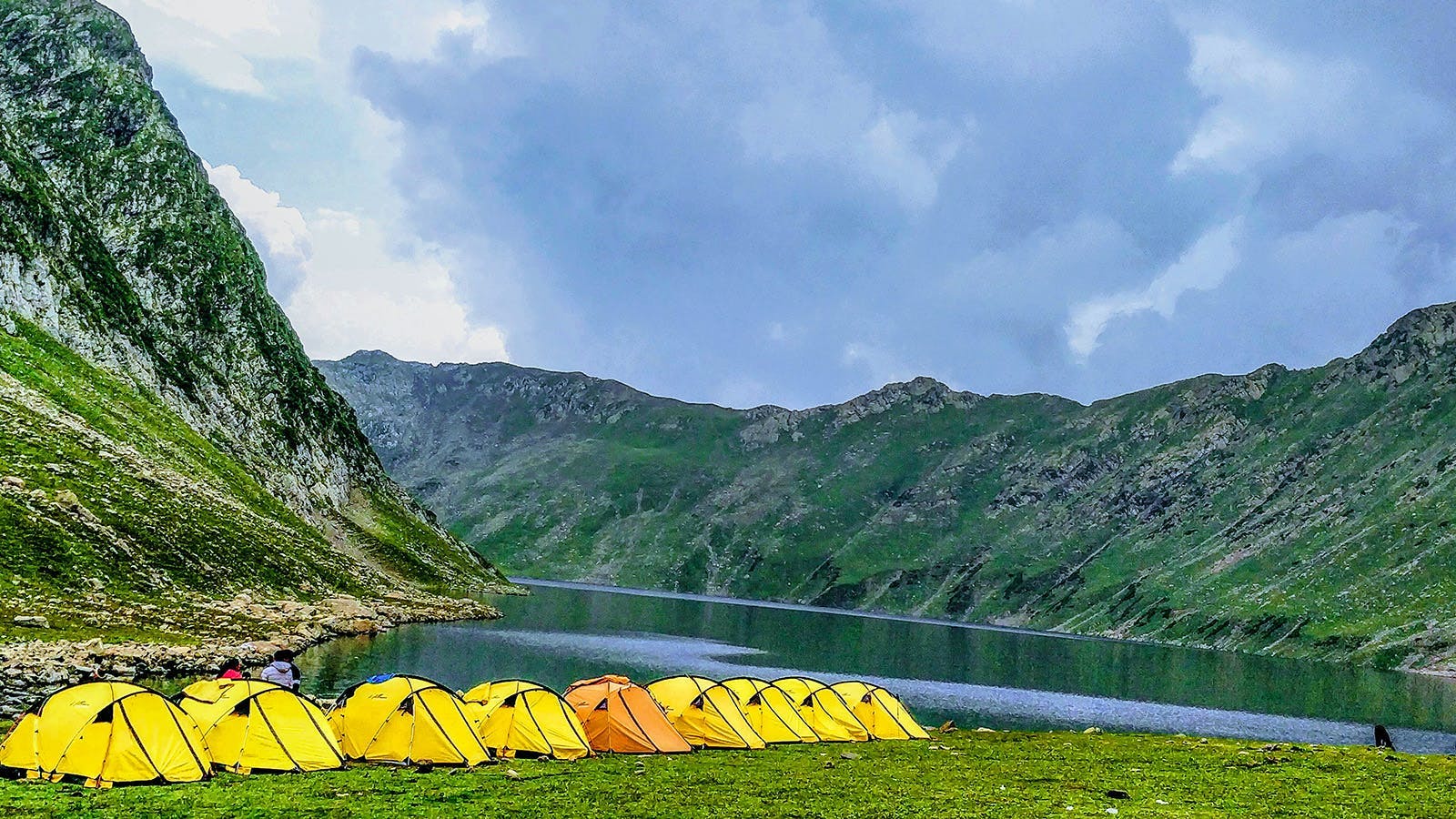
Tarsar Campsite is one of the most memorable experiences of the trek. Picture by Namita Kaith
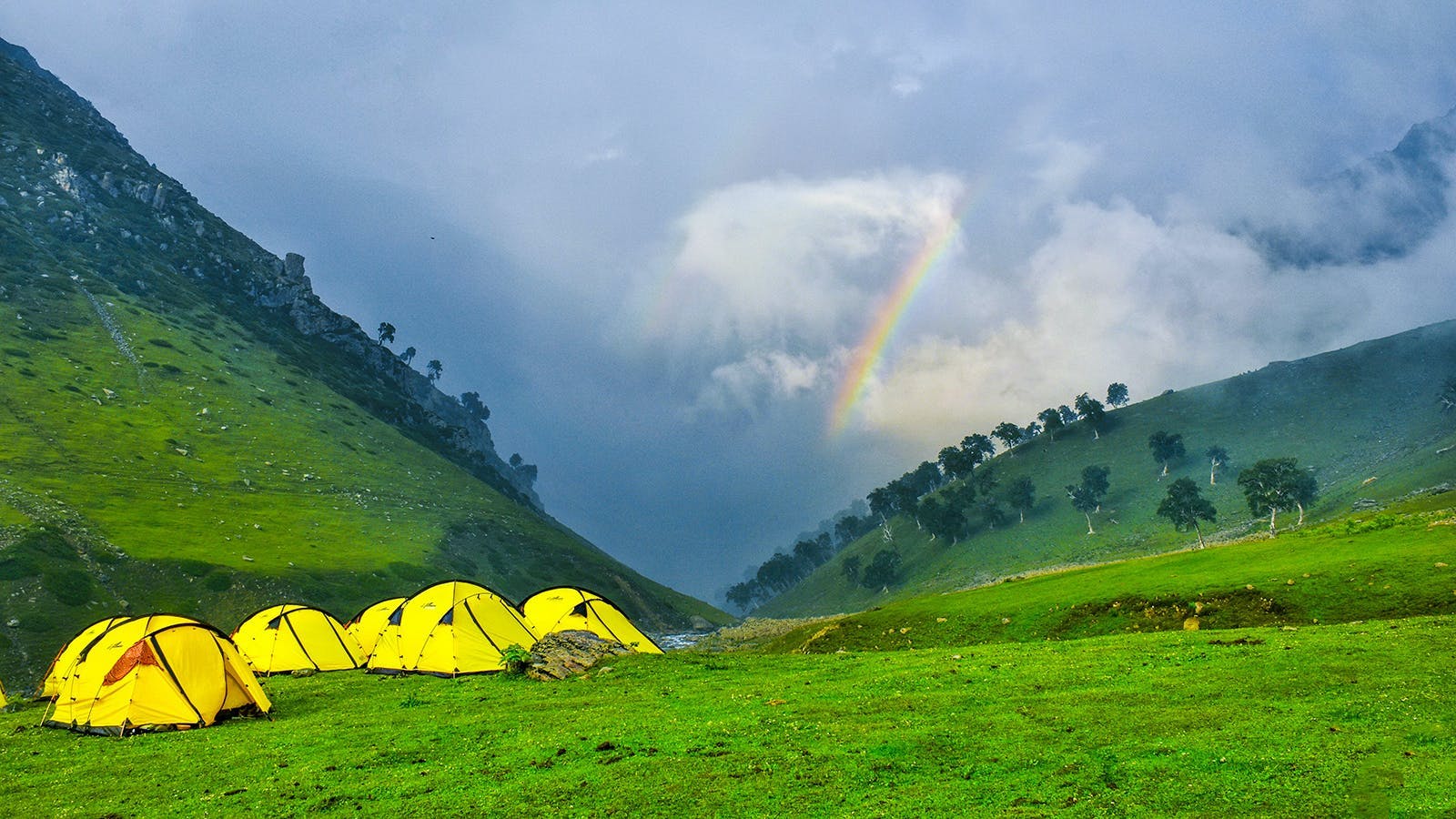
The setting of Shekwas Campsite cannot be compared to any other trek. It is nestled between three valleys intersecting. Picture by Abhijit
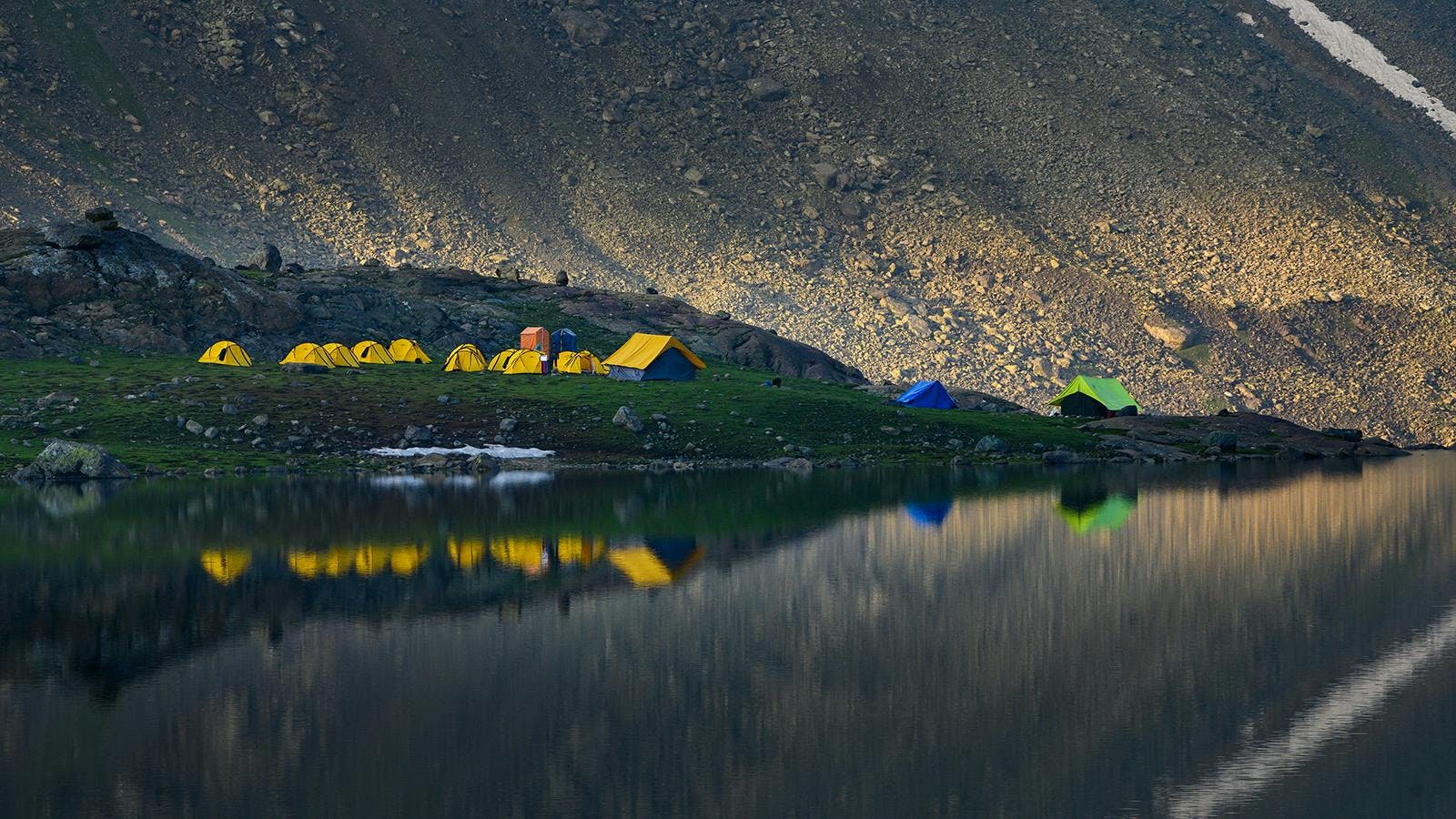
Sundersar Campsite. Circumvent the entire perimeter of Sundersar and it offers you multiple perspectives of the very same lake! Picture by Santhosh
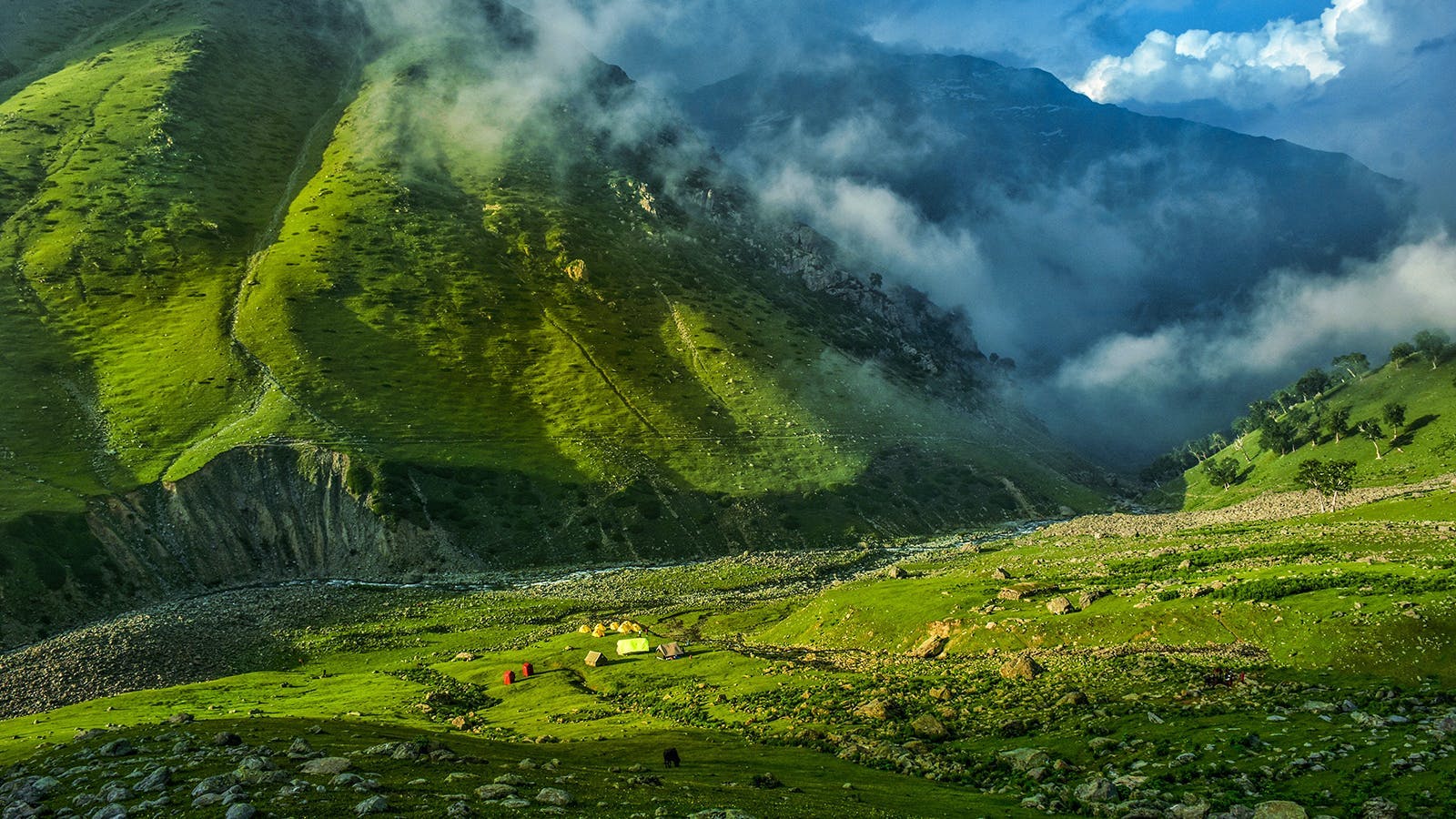
Shekwas Campsite seen from the top of the mound. Picture by Abhijit
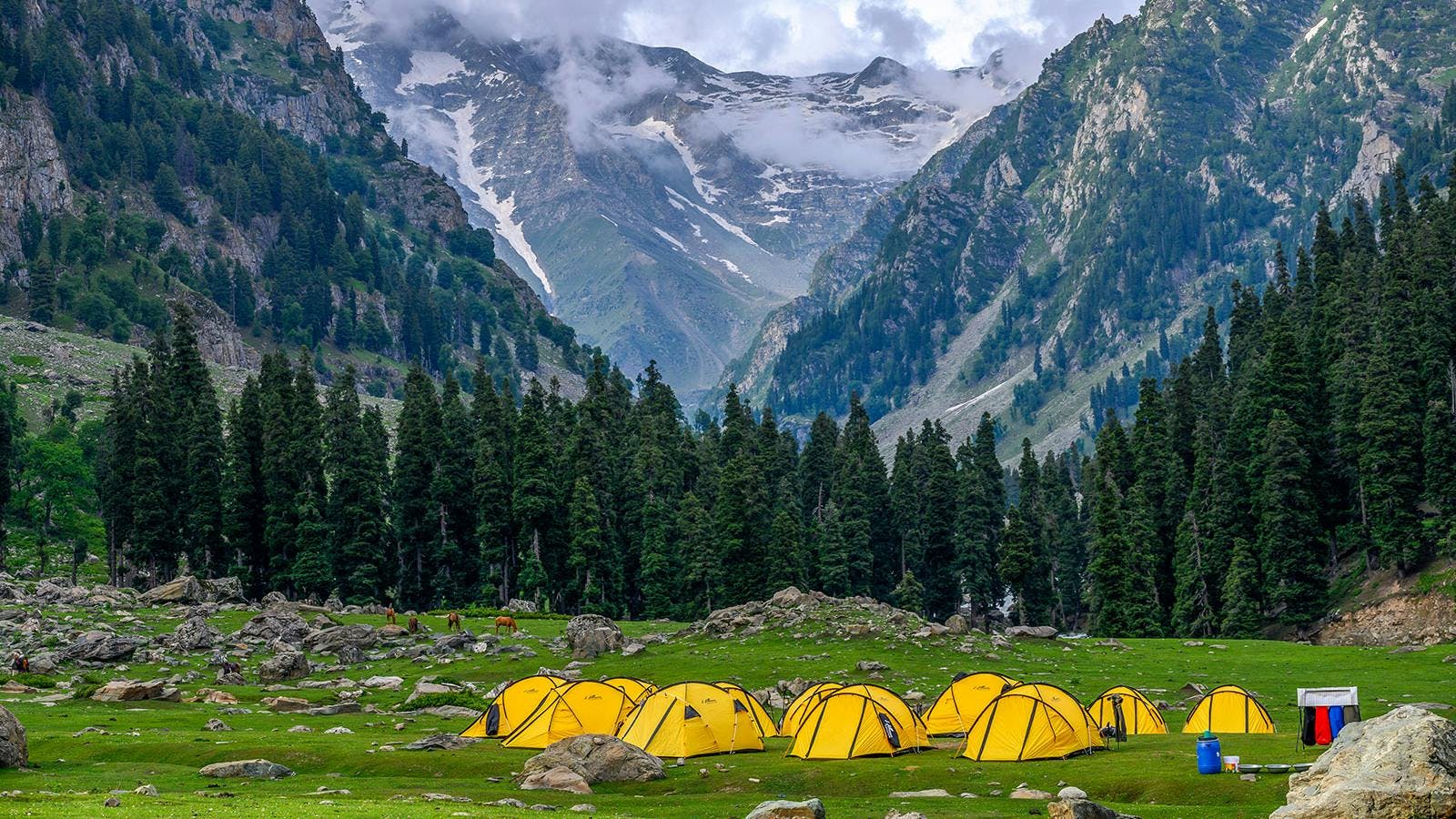
Your first campsite will be the Lidderwat Campsite surrounded by ancient coniferous trees. Picture by Santhosh
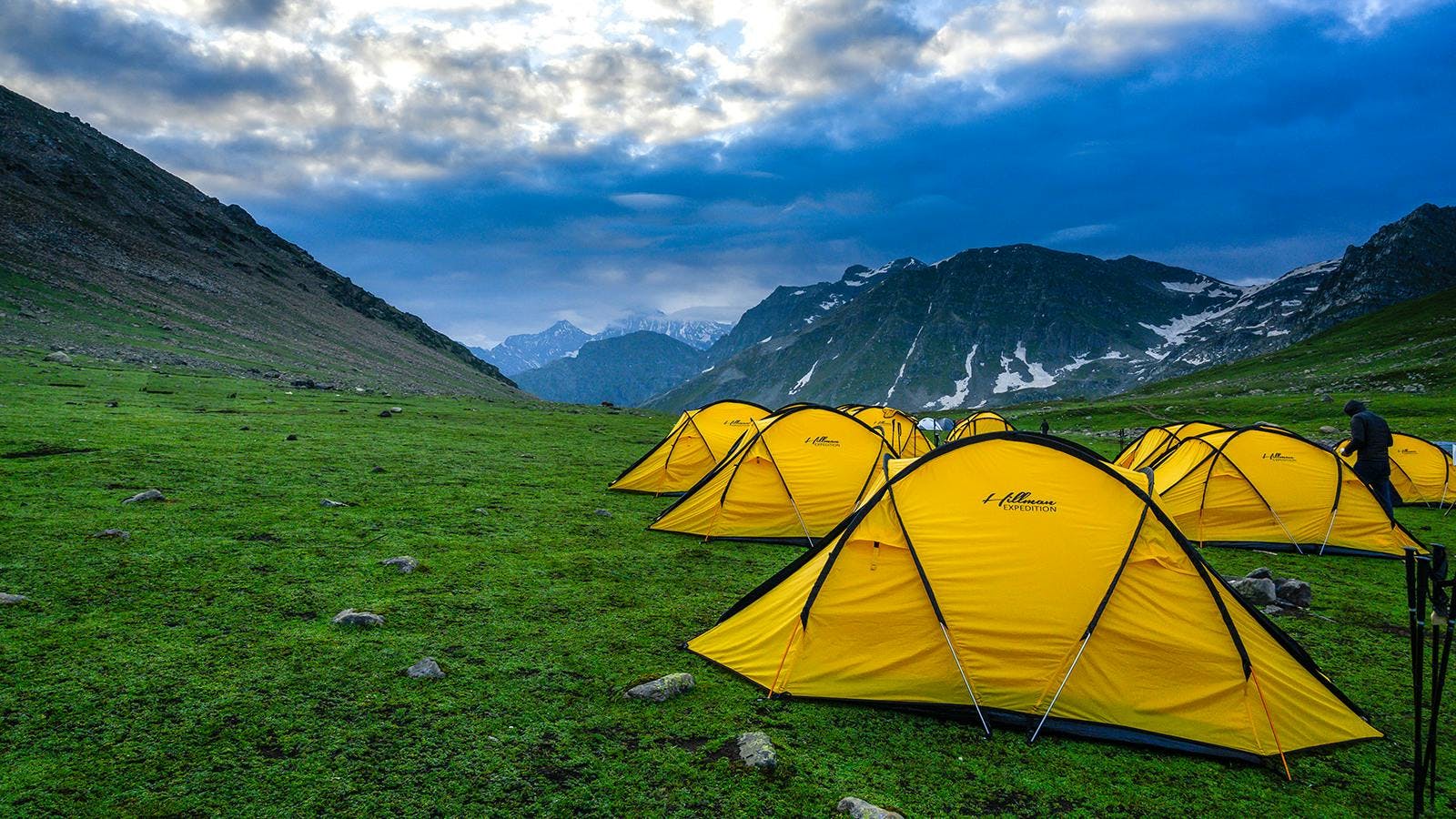
Tarsar Campsite. With increased groups camping next to the lake, Indiahikes has moved a bit above to get the seclusion. Picture by Santhosh
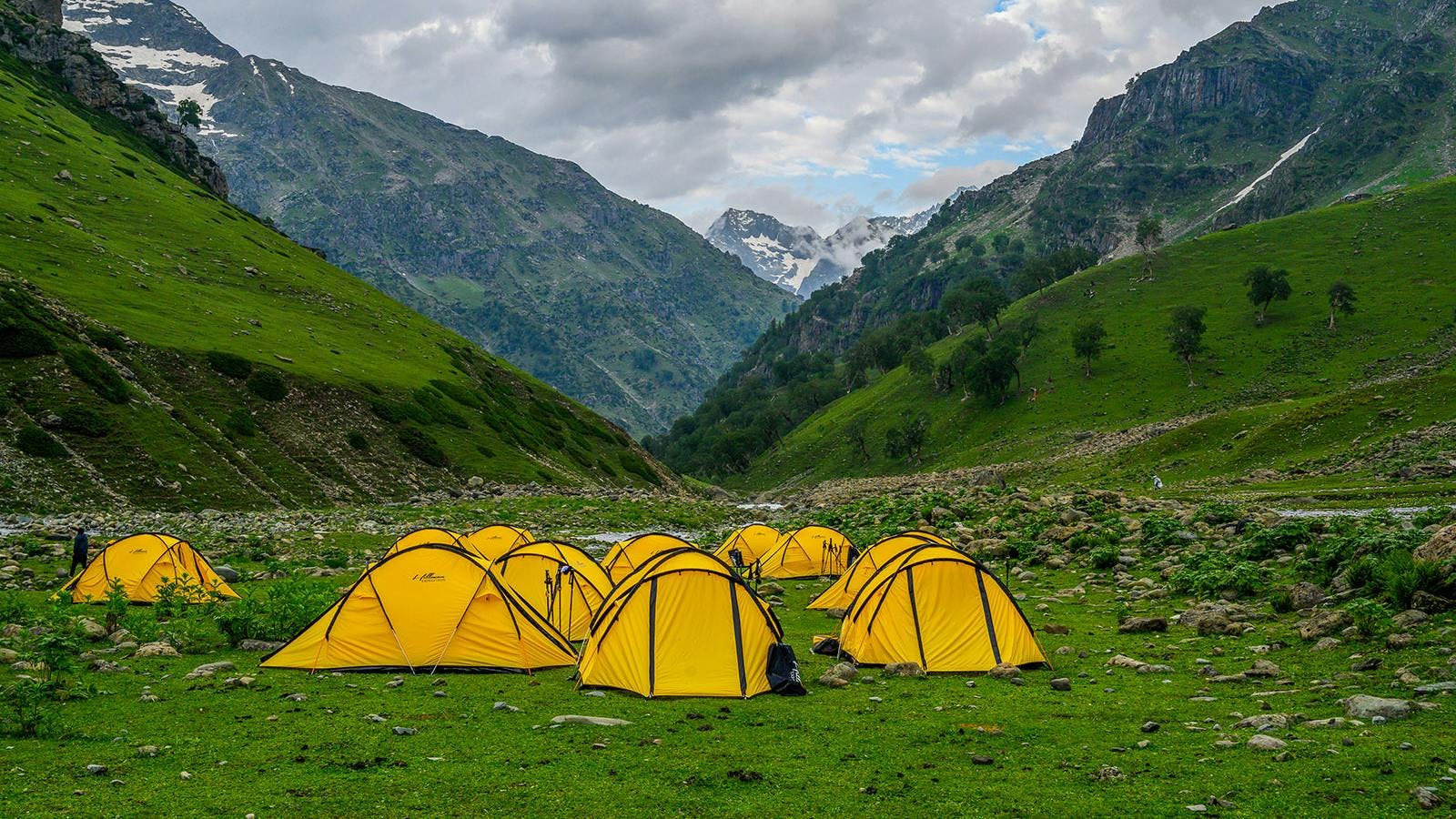
Another photo captured from the Shekwas Campsite. Picture by Santhosh
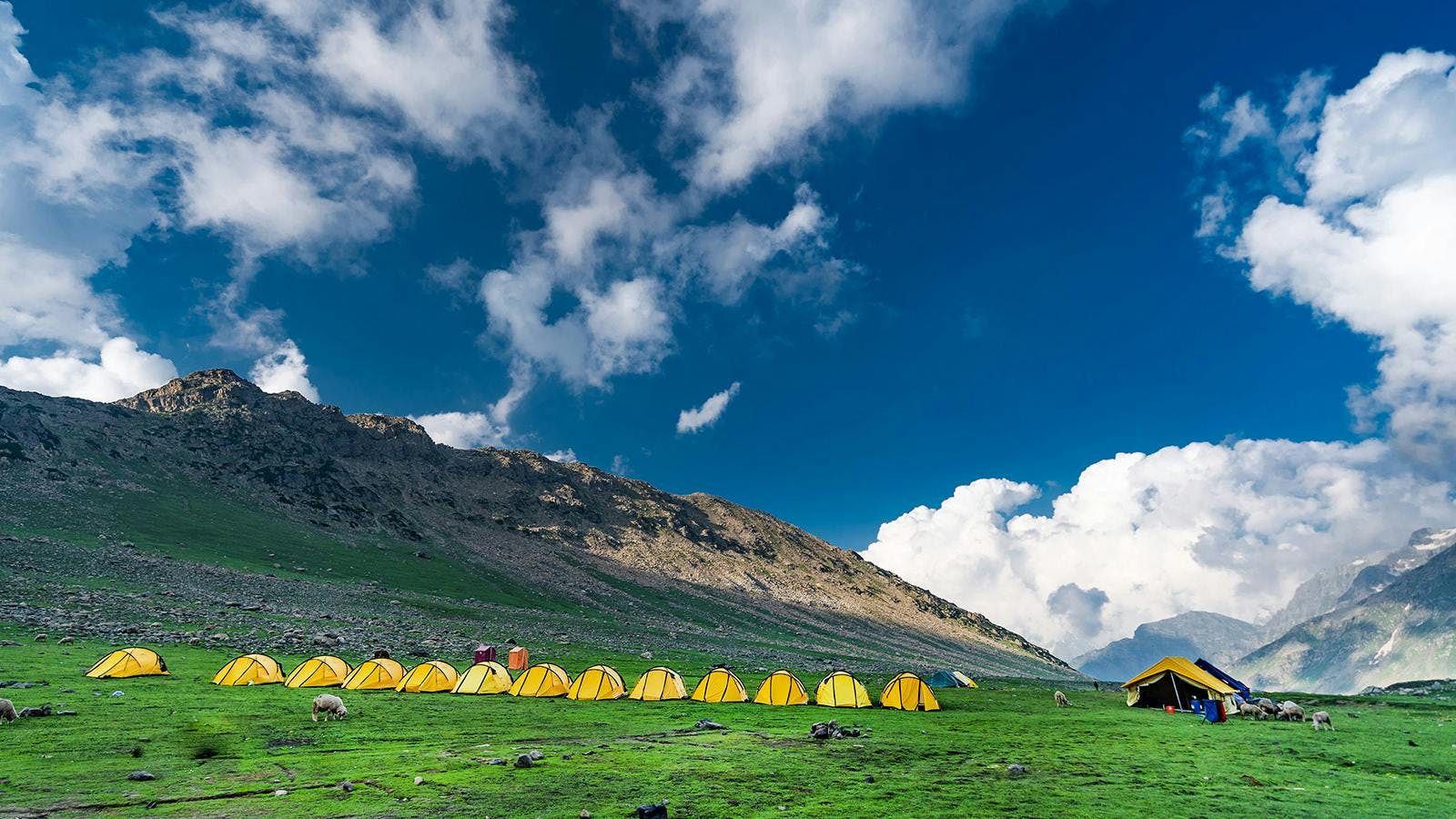
Overlooking the pass of Tarsar. Taken from Tarsar Campsite. Picture by Waleed
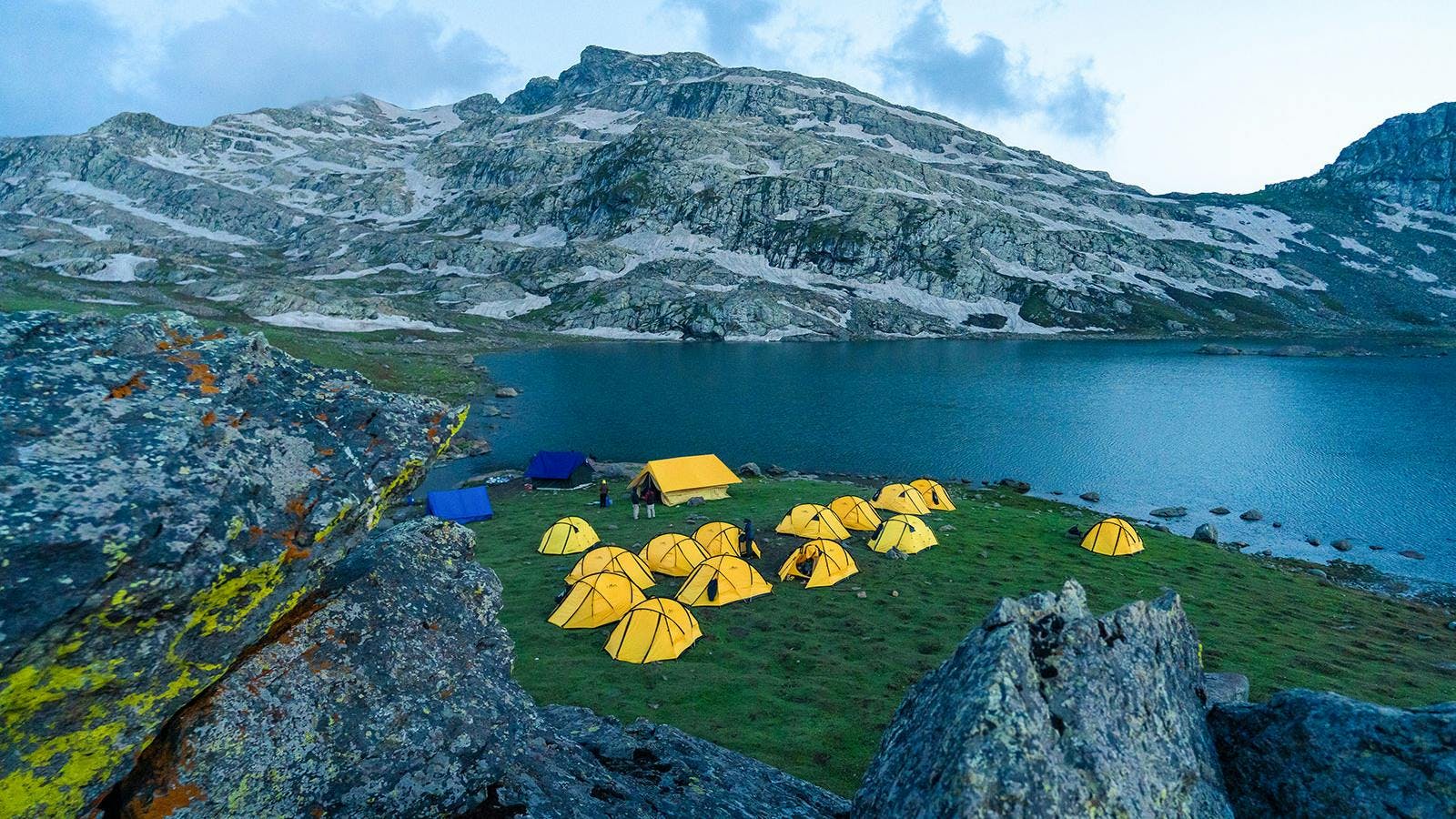
Sundersar Campsite. You will notice the lake resembling the shape of the moon. Picture by Waleed
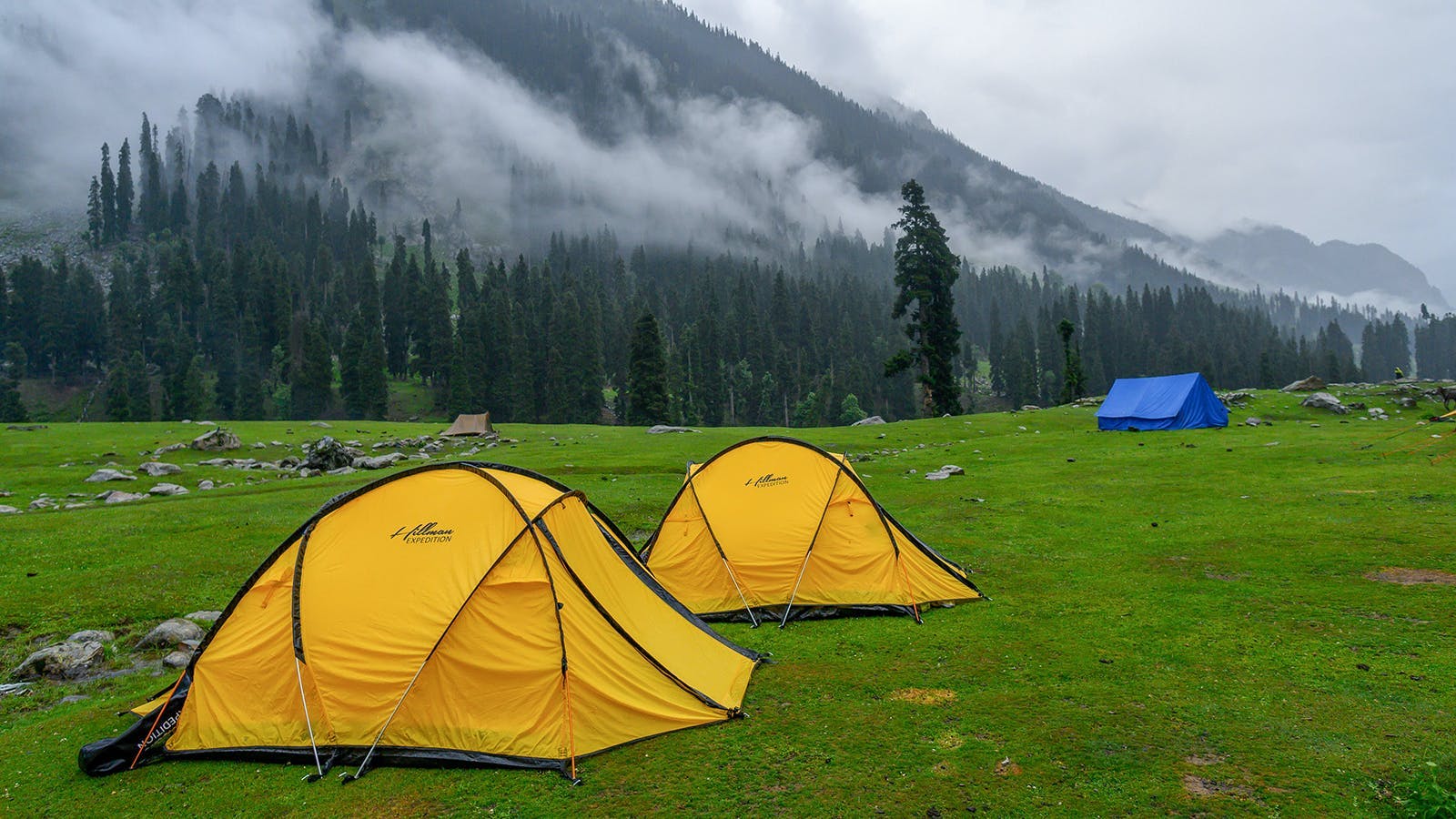
Lidderwat Campsite. The grasslands are a huge place for camping. However, during the peak season, you will have multiple organisations camping together. Picture by Santhosh
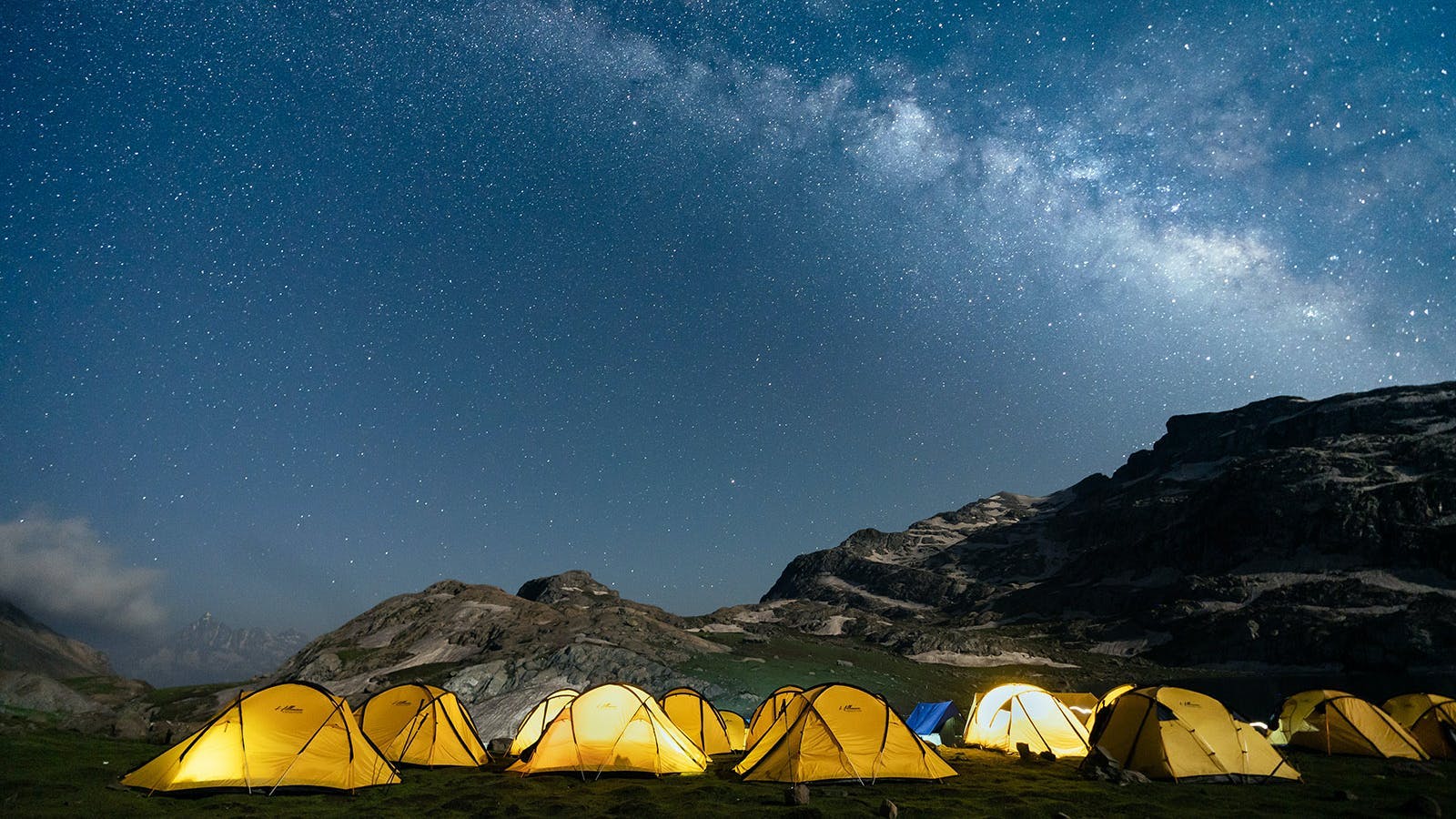
Do not miss the Night sky at Sundersar Campsite. The reflection that you see on the lake is something remarkable to even imagine. Picture by Waleed
Why I Believe Everyone Must Trek: A Note from the Founder

Trekking transforms lives. It has completely changed my life. When I see my colleagues at Indiahikes, all of them have been impacted greatly. The transformations have been profound and irreversible.
I see it in our trekkers too. I have seen them change professions, careers or start a new life. I have seen them get in and out of relationships, and start new projects. These are life-changing experiences.
I have seen children building resilience. I have seen families come together. When I see those above 55, I see them rediscover passion and a sense of purpose. These are not small gains.
In the mountains new professions, new economies and new businesses have opened up. Our staff no longer go to cities to earn their living. Their income has increased. Above all, they are happiest working in this world. Trekking has been truly transformative.
Everyone must trek. It transforms lives far more than you imagine.

Expert Speak
Arjun Majumdar
Founder & CEO, Indiahikes

Arjun Majumdar, the Founder of Indiahikes, went on this exploratory trek almost a decade ago. He is a veteran of
the trekking community in India. He’s an expert when it comes to the trek. Here’s Arjun talking about one of The Prettiest Trek In India country.
I have to admit, the Tarsar Marsar is my favourite trek in Kashmir, even more than the Kashmir Great Lakes. I know I have to hear a lot of flak for this. So I’ll right away get down to why I like this trek so much.
What I Like and Don’t Like About Tarsar Marsar Trek
What I Like About Tarsar Marsar Trek
Arjun Majumdar, the Founder of Indiahikes, went on this exploratory trek almost a decade ago. He is a veteran of the trekking community in India. He’s an expert when it comes to the trek. Here’s Arjun talking about one of The Prettiest Trek In India country. I have to admit, the Tarsar Marsar is my favourite trek in Kashmir, even more than the Kashmir Great Lakes. I know I have to hear a lot of flak for this. So I’ll right away get down to why I like this trek so much.
1 . Intimacy of the Lakes
I loved the intimacy of the lakes on this trek that I didn’t get on the Kashmir Great Lakes trek. I was right on the edge of the shores of the Tarsar and Sundarsar, my tent on the grassy glades of these lakes, watching the dark blue aquamarine waters being fed by snow patches.
The sight stayed with me. I went on long walks all alone along the shores of the lakes, my thoughts to myself. These were rare moments on a trek, which I didn’t get elsewhere. Tarsar always gives me these moments.

The intimate experience of camping by alpine lakes. Photo by Namitha Kaith
2 . Marsar Lake
From Sundarsar there is a secret passage over a Col that led me to a cliff over Marsar. I timed it right twice, an hour after sunrise, to see something spectacular. Rushing down the valley that leads to Marsar, huge columns of clouds rolled in towards Marsar.
Sunlight glinted over the top of the clouds throwing wonderful shadows as they rolled in at an angle. The sight was so spectacular from my vantage point above the cliffs, that I almost wanted to applaud. Within fifteen or twenty minutes the clouds blanketed Marsar, taking the lake out of sight.
Even without the rolling clouds, the sight of Marsar took my breath away. Easily, it was one of the largest lakes with the deepest blue waters that I had seen in Kashmir.

The elusive Marsar lake was caught on camera as soon as the clouds parted. The lake left me dumbfounded the first time I had a glimpse of it. Photo by Harisha NV
3 . Tarsar Lake
The sight of Tarsar as I climbed to the Tarsar pass is one of my favourite sections. I think the best photos of the lake come from this section. I just loved sitting on a ledge, high above the lake, watching the long stretch of blue waters of Tarsar as the morning sun catches it at its best. Every time I do this trek I take out those few minutes to do this. I think most trekkers enjoy this bit a lot.

The dreamy Tarsar Lake. You get to circumvent the entire perimeter of this lake, offering you multiple perspectives. Picture by Sudheer Hegde
4 . The Plains of Jagmargi
My favourite top secret section of the trek is the plains of Jagmargi. You get them an hour or so before you reach Sundarsar. I suddenly found the rushing stream going dead quiet, forming giant crystal clear pools. On my left were vast grasslands, stretched out in a big oval arch.
Somewhere in the far distance, like a western movie, the grasslands touched the foot of rugged hills — a sight I have not seen on any other trek before — an entire big sweep like this.
Sheep and horses grazed peacefully. As I passed by I caressed some of the sheep and they didn’t move an inch. But what stunned me were the flowers. It was a carpet of wildflowers, purple, white, blue and yellow, nurtured by the abundance of water. I couldn’t trek. Because every step I took would crush flowers under my feet. It took me a long while to cross this section.

Wildflowers abound in the meadows of Jagmargi. Photo by Rajesh Kallaje
5 . Shekwas Campsite
Give me the Shekwas campsite for a day and I will trade two campsites from any other trek. I just love the setting! Nestled in the junction of three green valleys (name another trek where you see three valleys intersecting — it is very rare!), a ridge climbs right outside the camp.
I remember I took off my shoes and climbed, and climbed and climbed on those soft grass. I climbed endlessly until the camp was a dot below, perhaps a thousand feet, yet the ridge had a long way to go.
From this viewpoint, I saw what we call Kashmir, a heaven on earth! Sweeping mountains, great grasslands in the valleys, and an undulating landscape that can only be made by a divine source. To top it each of these valleys had a river running through them with the sun setting on its glinting surface. I sat on a small outcrop of a rock for a long time until it was dusk.

The settings of Shekwas campsite can not be compared with any other trek. Picture by Abhijit
6 . The Variety of the Trek

Aru is almost too idyllic to be true. Picture by Santhosh.
What I Don't Like About Tarsar Marsar Trek
1 . This is a hard one. In every trek I can pick flaws, but Tarsar Marsar is a trek that is absolutely flawless.
It is not hard on the legs, it has a lovely drive getting to the base camp. The base camp is worthy enough for a few days of stay! The trek has tremendous variety.
It shows you Kashmir for what heavenly it can be. Plus three beautiful lakes, where you camp next to two of them! All in all, it is a complete package. To me, it edges out even the Kashmir Great Lakes trek. Not by a lot, but surely by a wee bit.
Tarsar Marsar Is Best Discovered Through Pictures
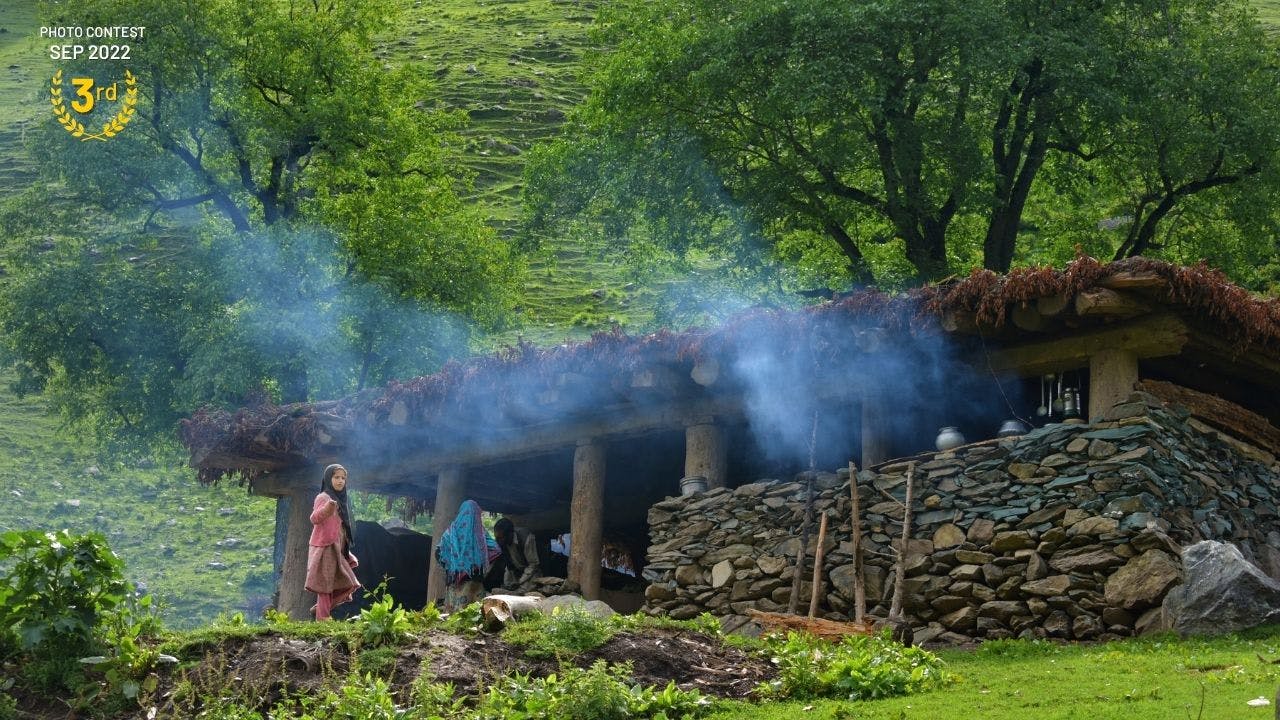
A shepard's hut
Picture by: Siddharth Seth
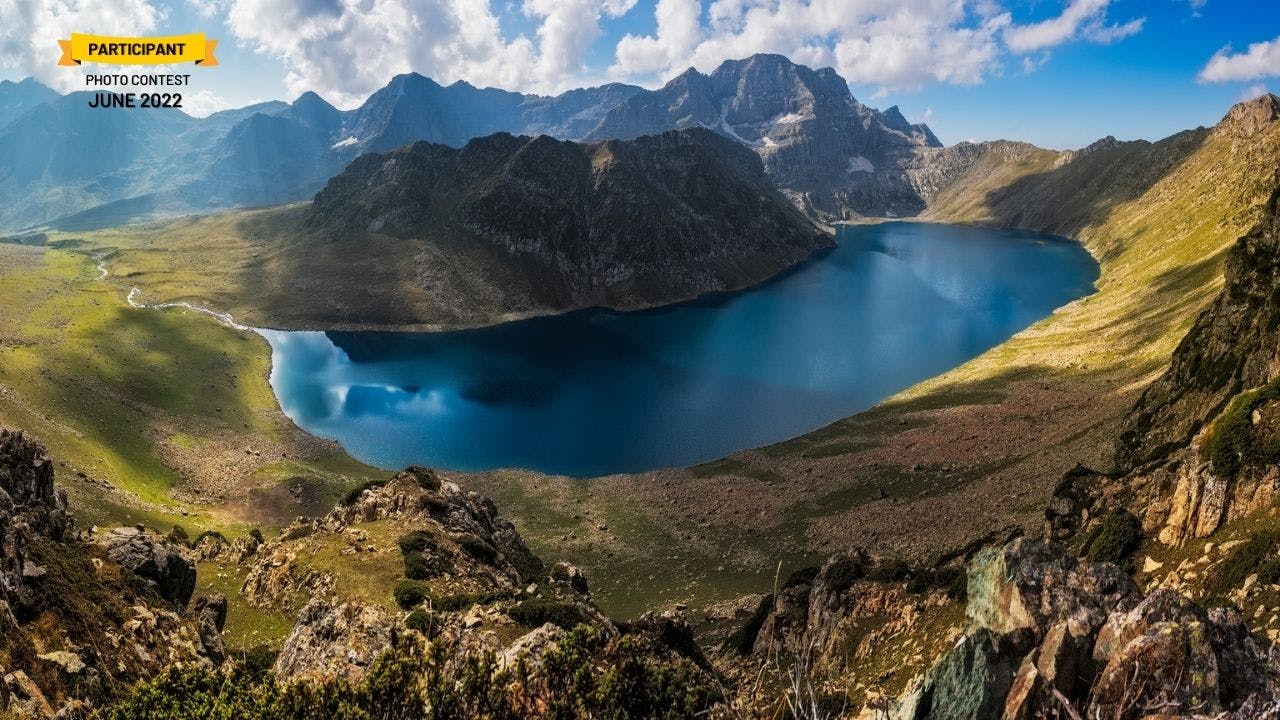
View of Tarsar lake
Picture by: Atinderpal Singh
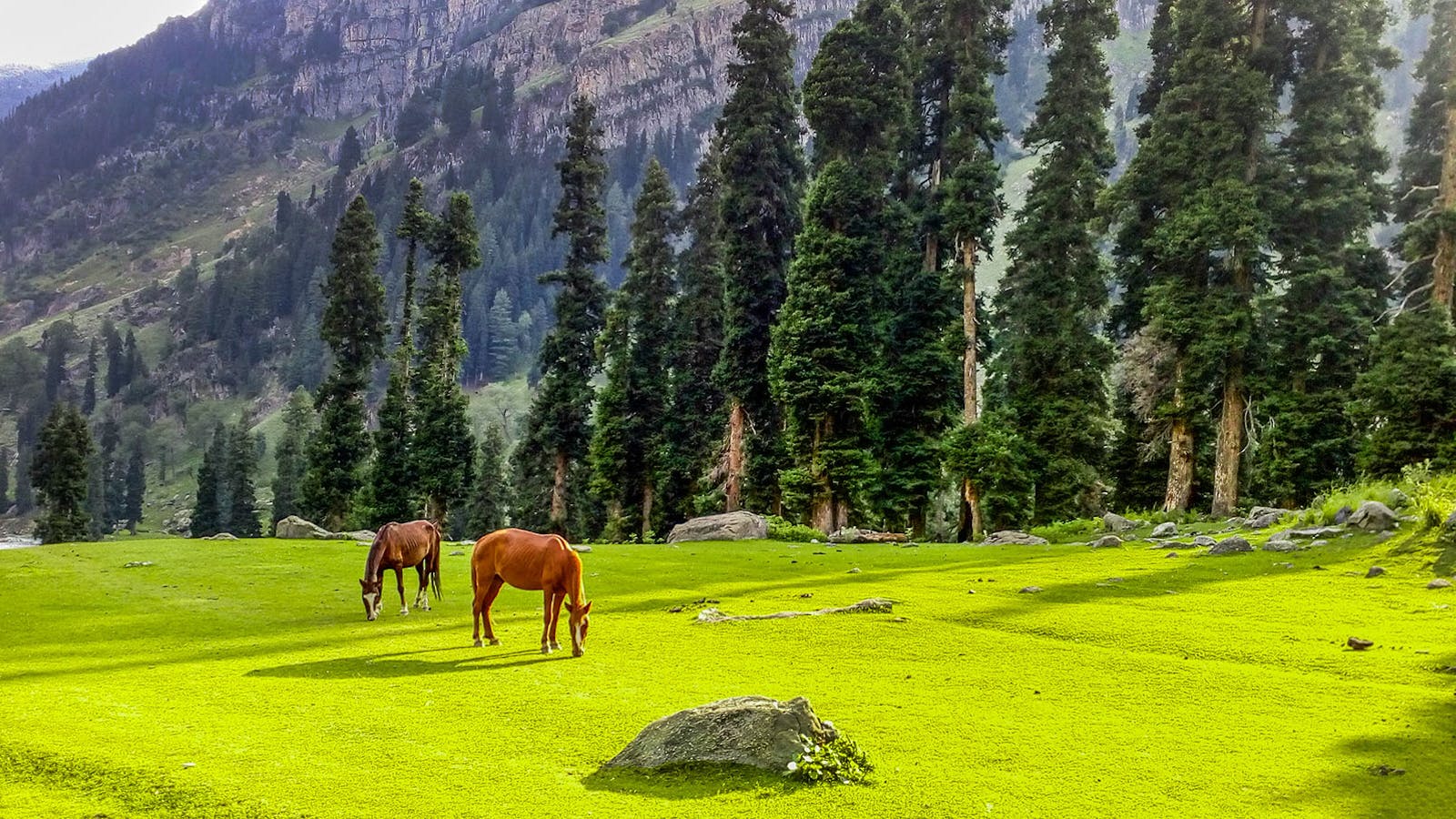
When you trek through the forests and cover the last hump, the grasslands of Lidder are stunning.
Picture by: Gourab Nandy
Grasslands of Lidderwat
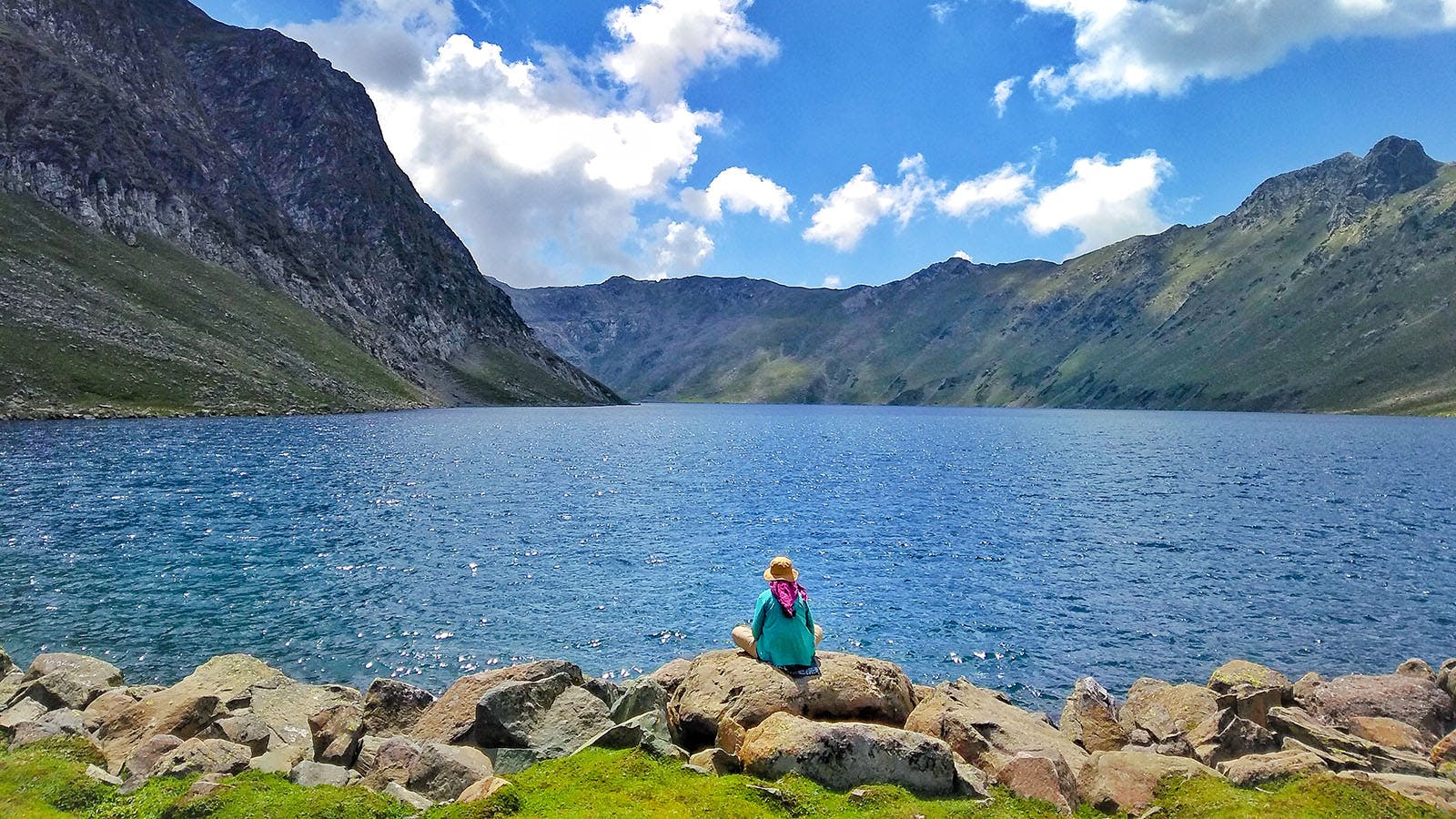
The intimate setting of the Tarsar Lake makes you feel more connected to nature and reflect on your thoughts.
Picture by: Nitesh Salkade
Tarsar Lake
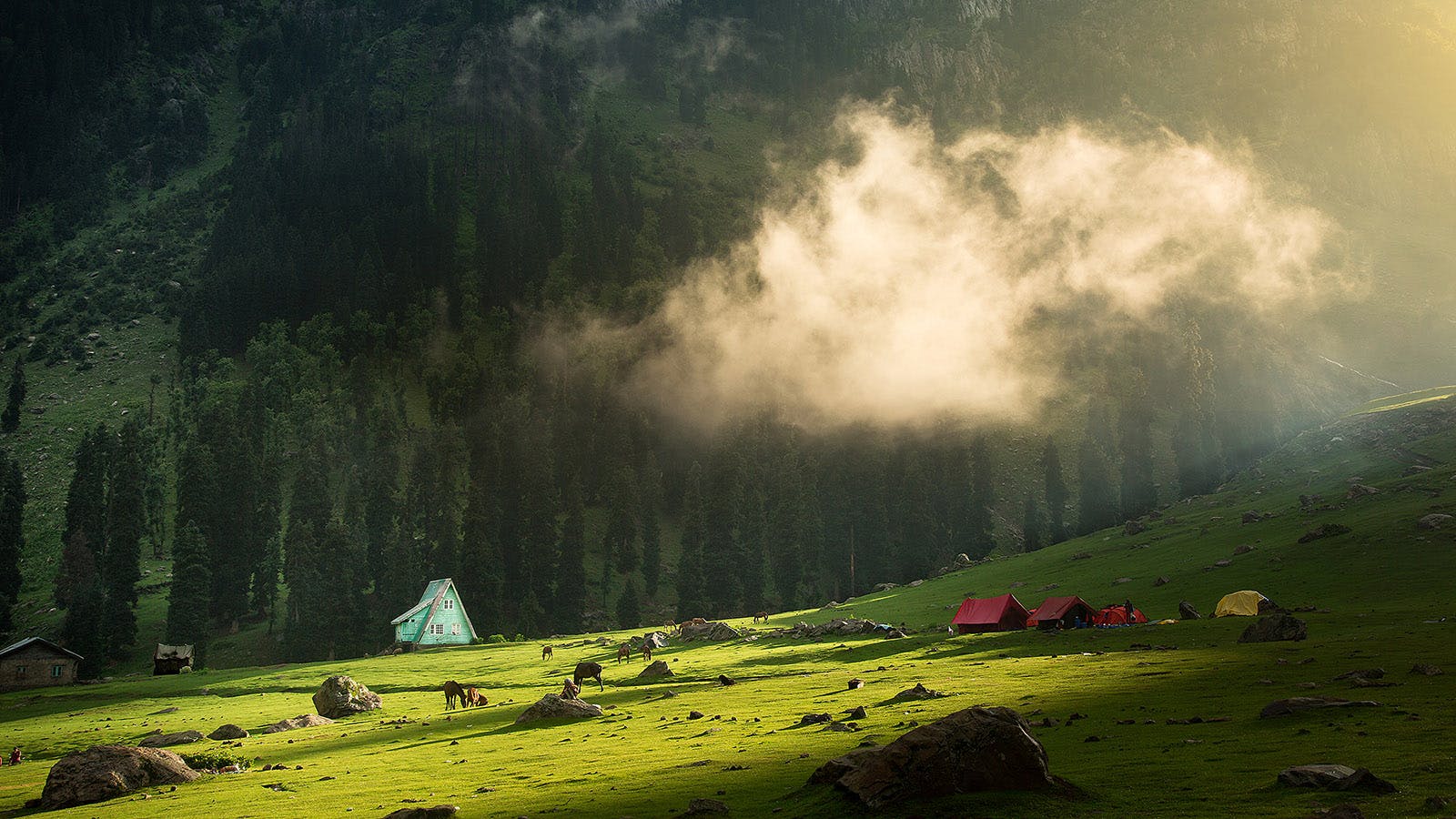
A gorgeous photo at Lidderwat during the early hours of morning.
Picture by: Shreenath
The Iconic Lidderwat Hut.
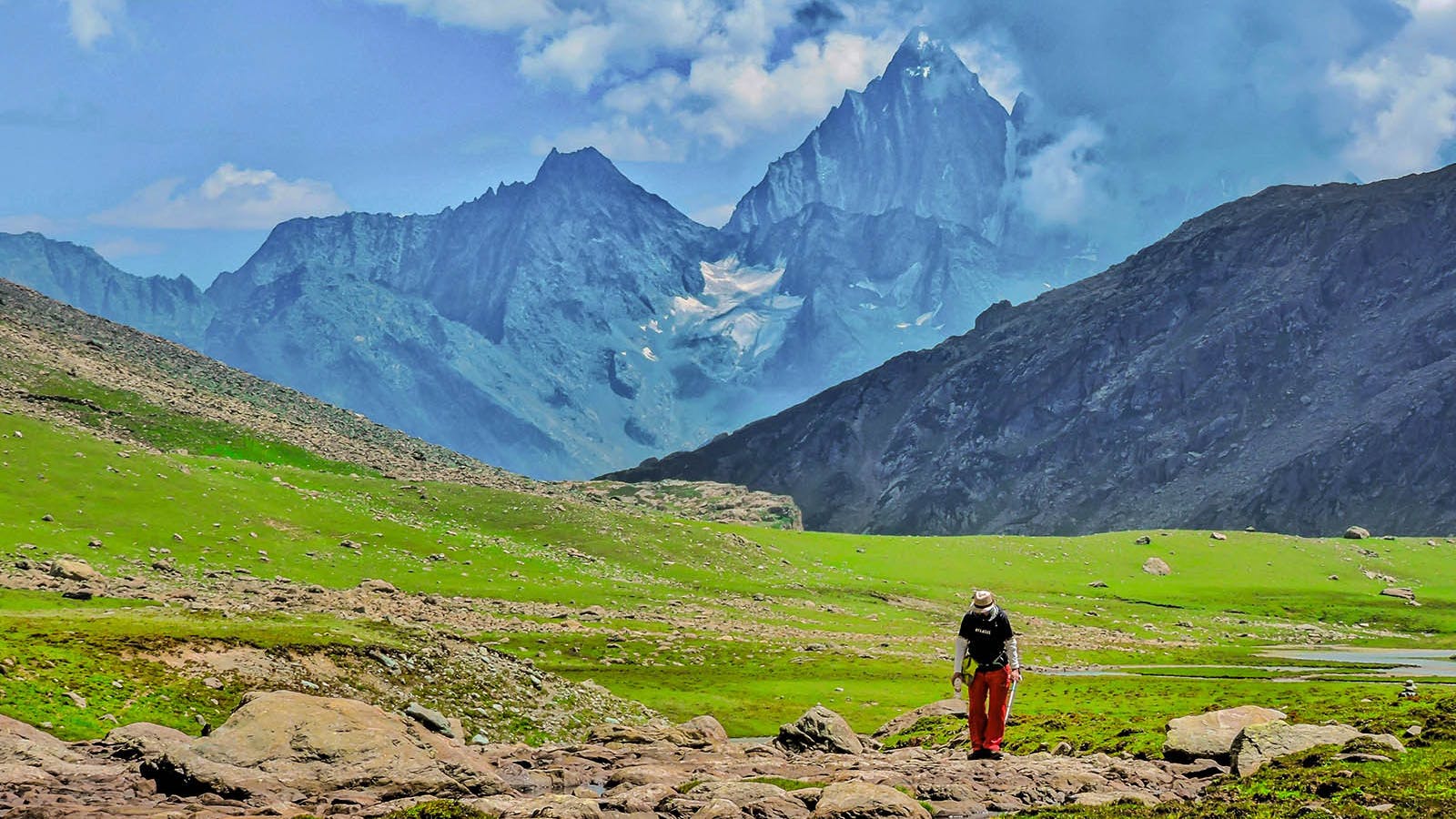
As you take a stroll around the Tarsar lake, do not miss to look up. Mount Kolahoi with the glacier is towering at the horizon.
Mount Kolahoi Peak
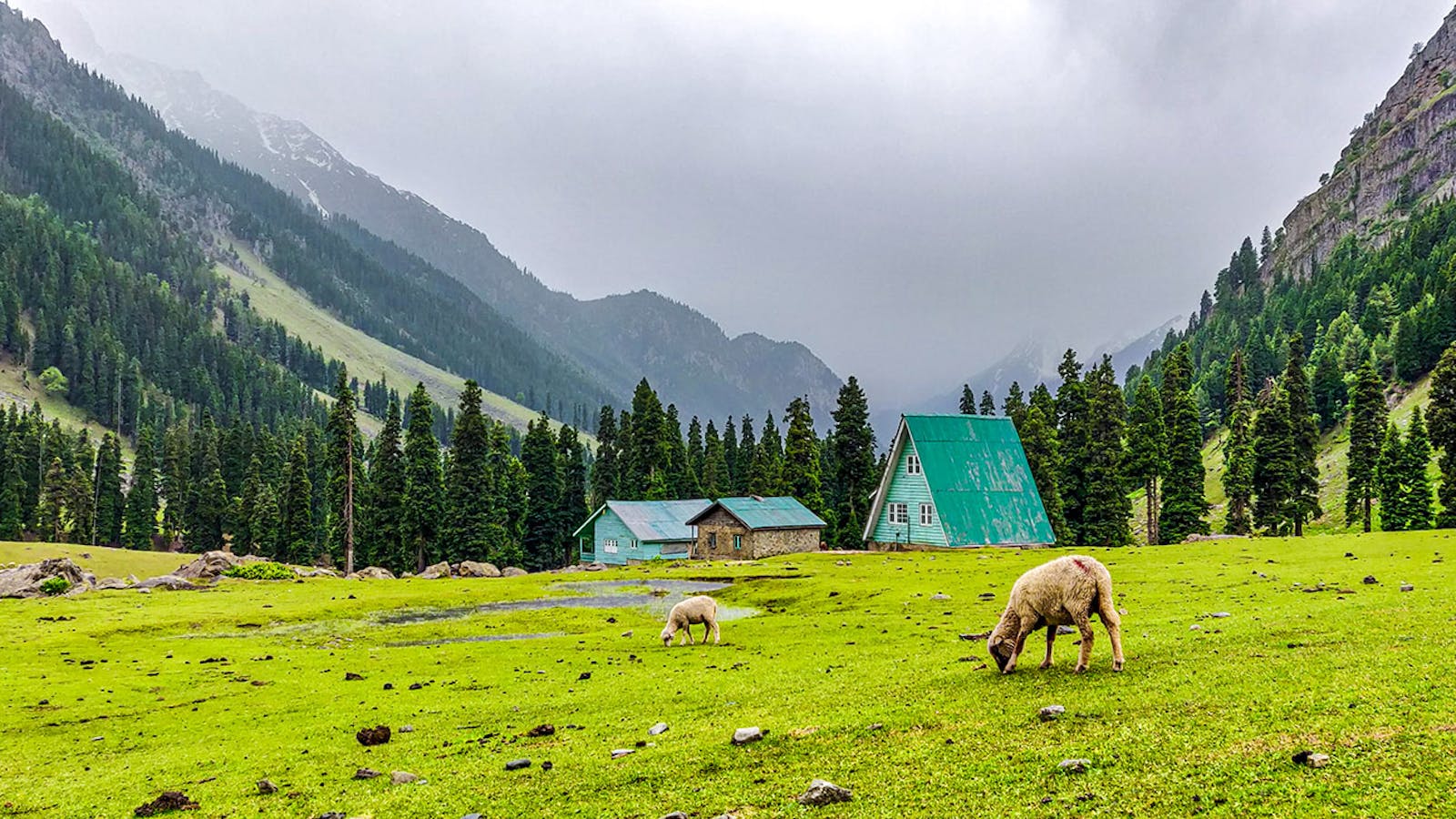
In the evening, go down to the clump of coniferous trees. There is a lovely Gujjar settlement there. You can get a peek at how life is in a Gujjar settlement.
Gujjars of Lidderwat
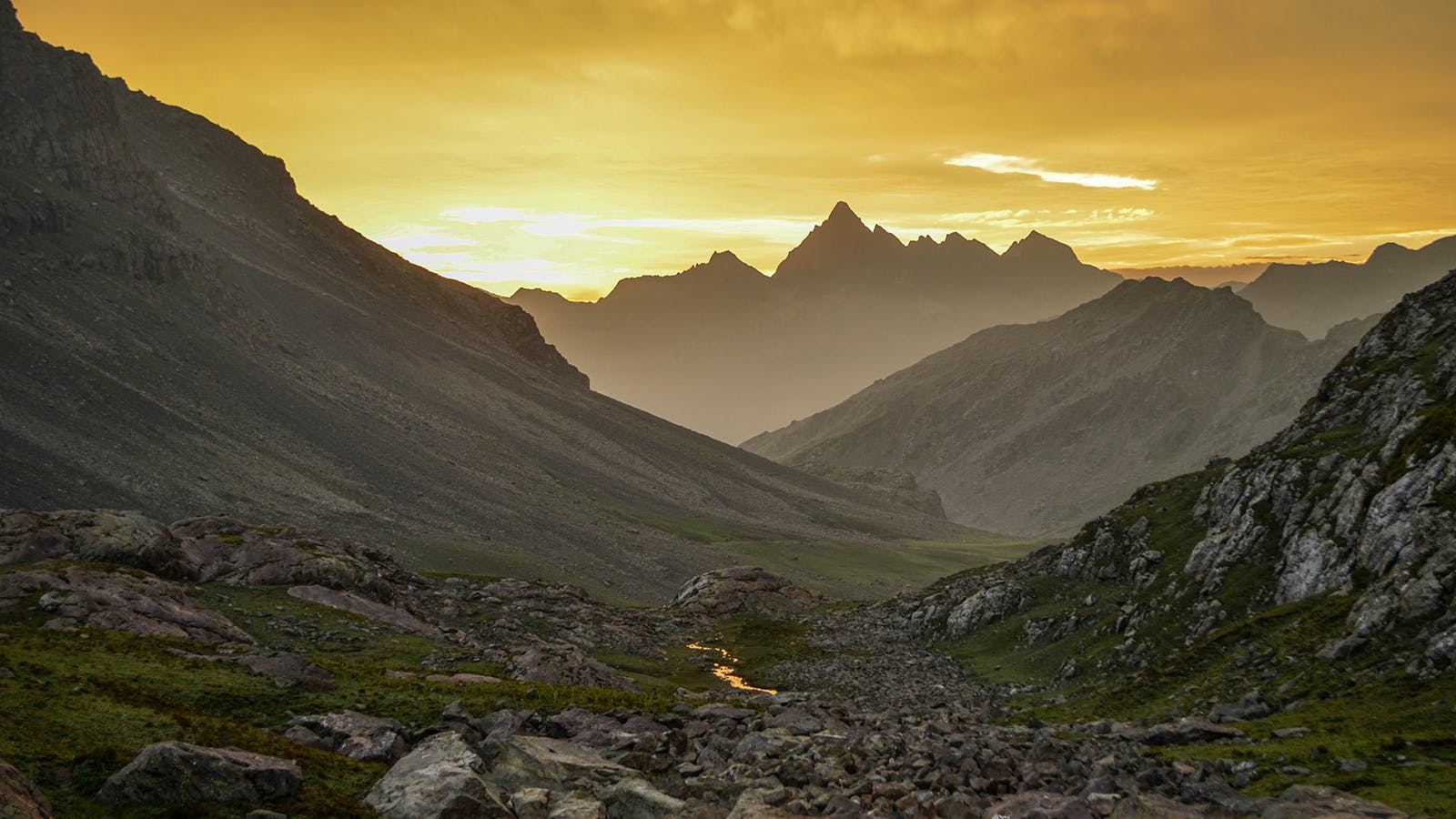
You reach Sundersar in the evening time from Tarsar Pass. Do not miss exploring outside your campsite and looking at the transition of the colours.
Picture by: Ajay
Evening Colors near Sundersar
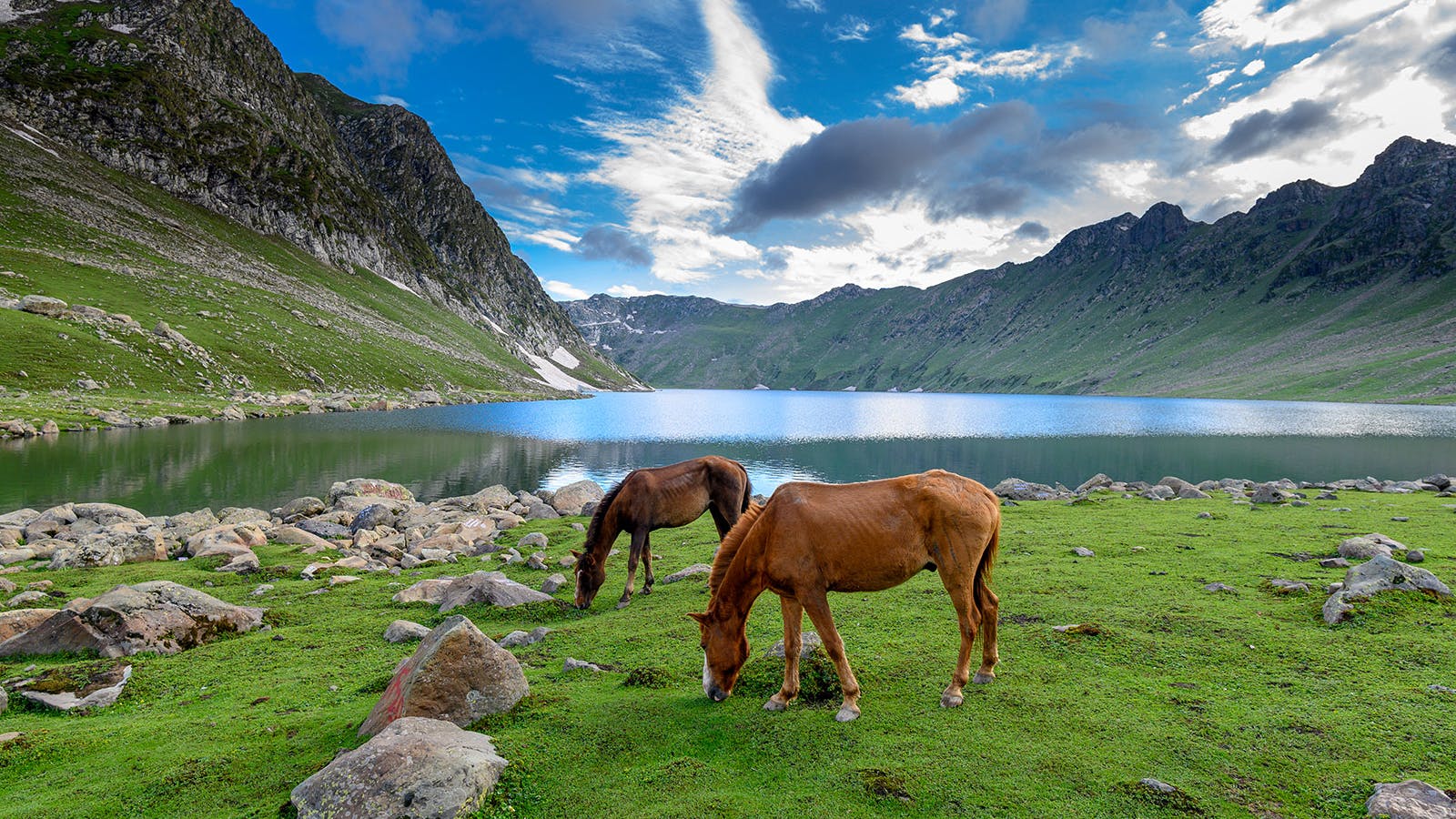
Wild horses grazing along the glades of the Tarsar Lake.
Picture by: Santhosh
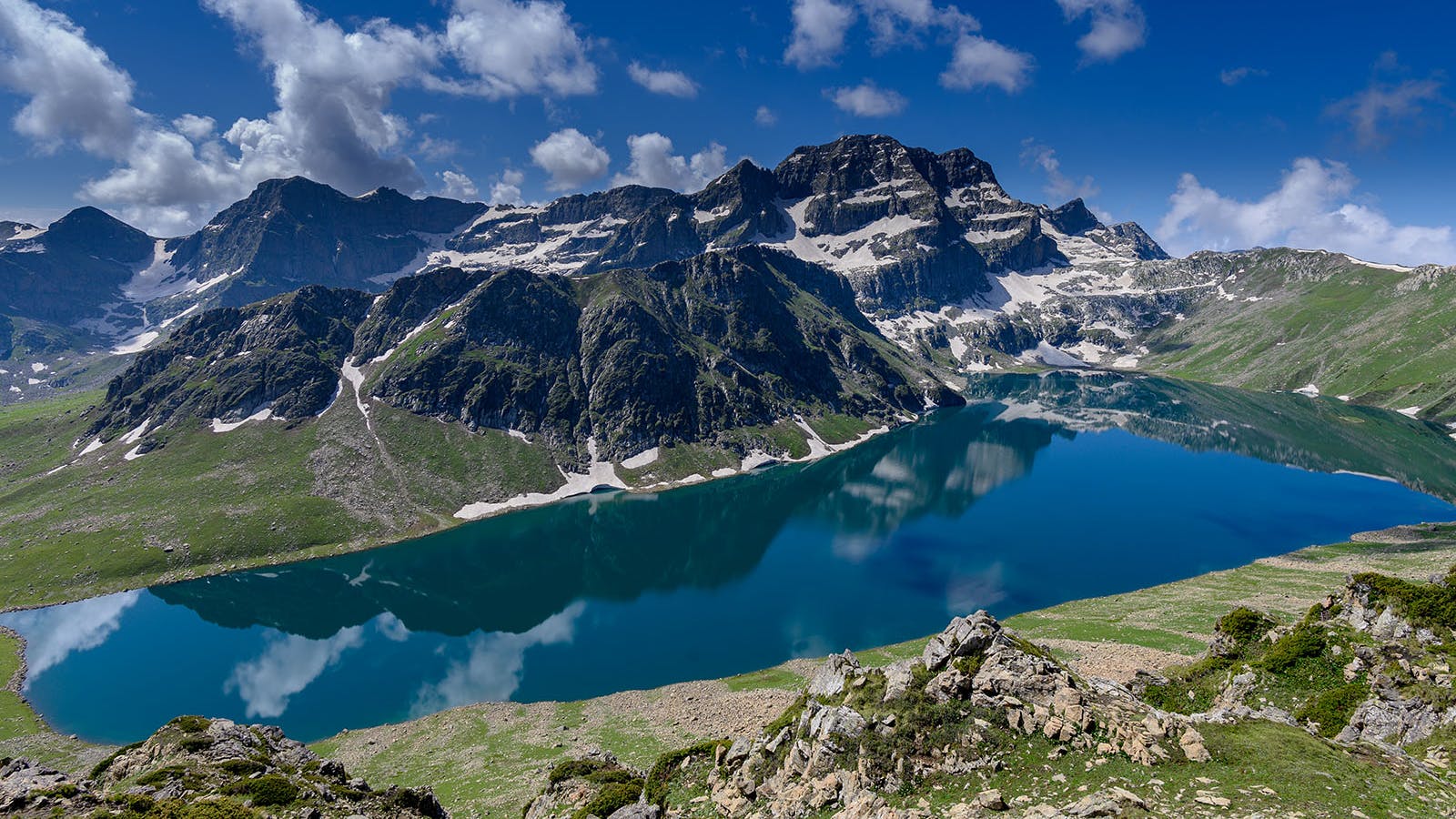
The view and colours of the lake from the other side are very different from what you see at the campsite.
A Different View of Tarsar Lake
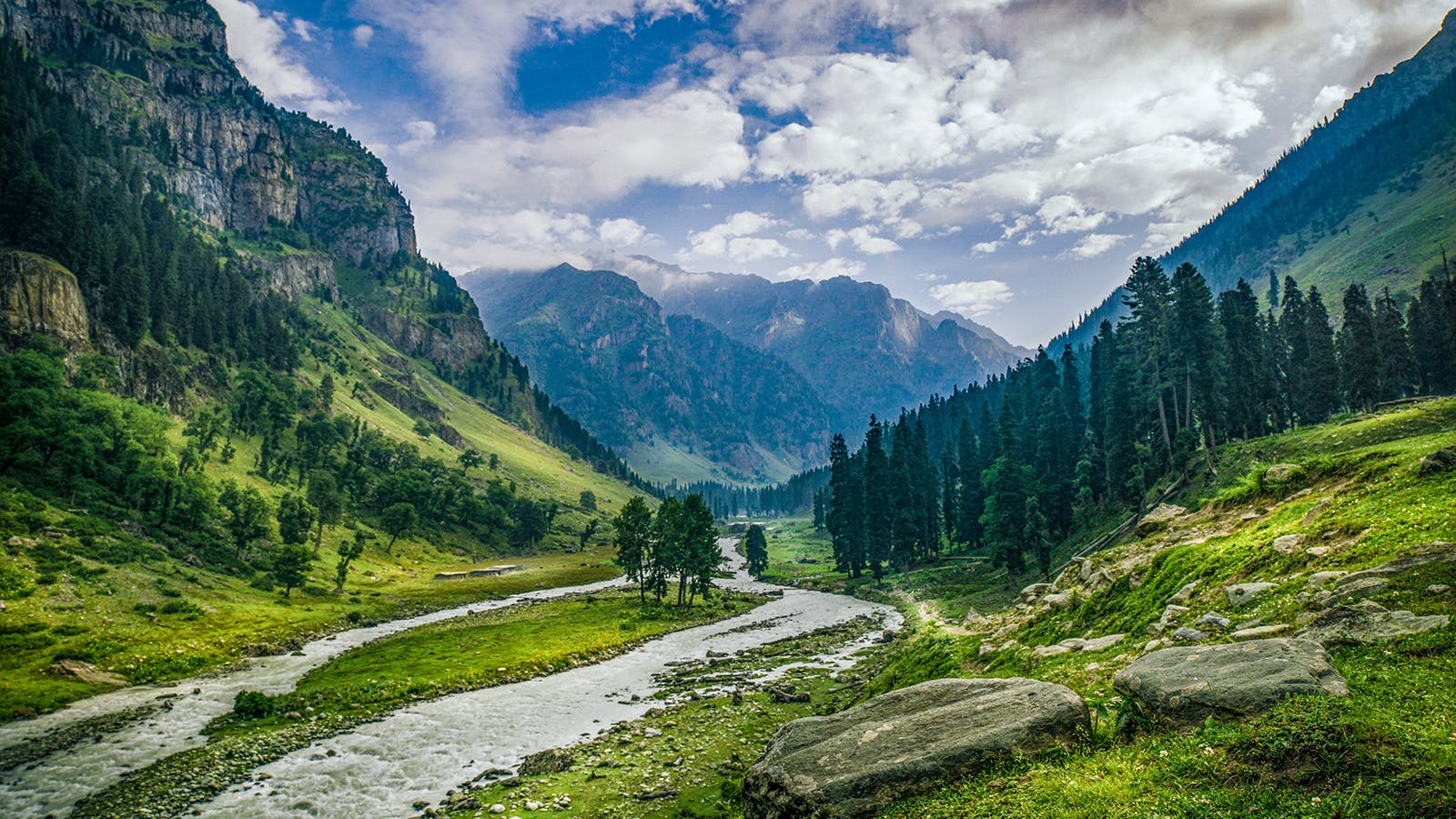
Right from the start of the trek, Lidder River is mostly to your right. When you cross over and approach the campsite, take a look back at the beautiful setting you just crossed.
Picture by: Amit anand
The Lidder River
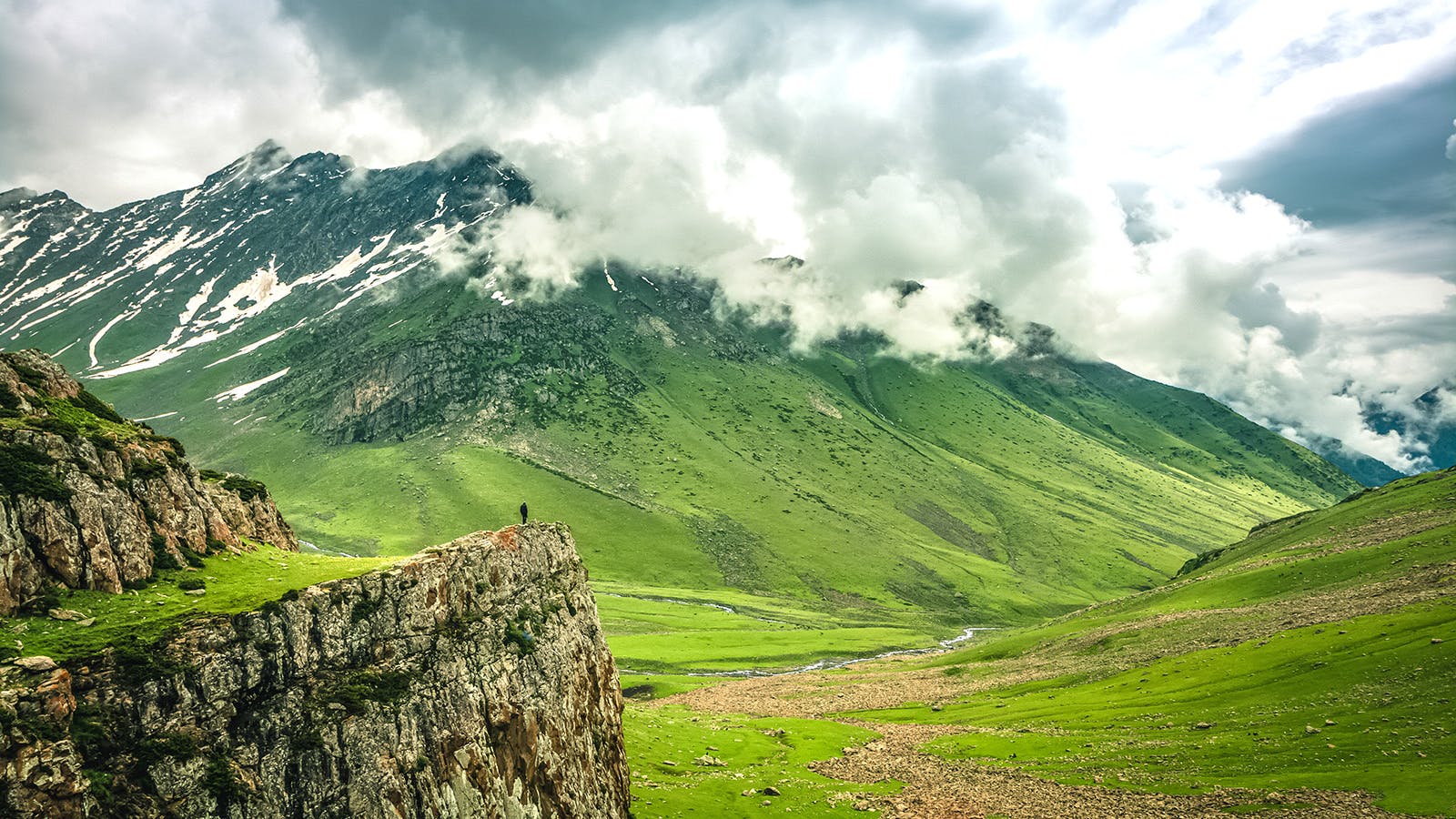
When you trek from Sundersar to Lidderwat via Shekwas, there is a point similar to a cliff where you see the entire wide valley. This point is called the Sangam.
Picture by: Ankit Banerjee
Sangam Valley
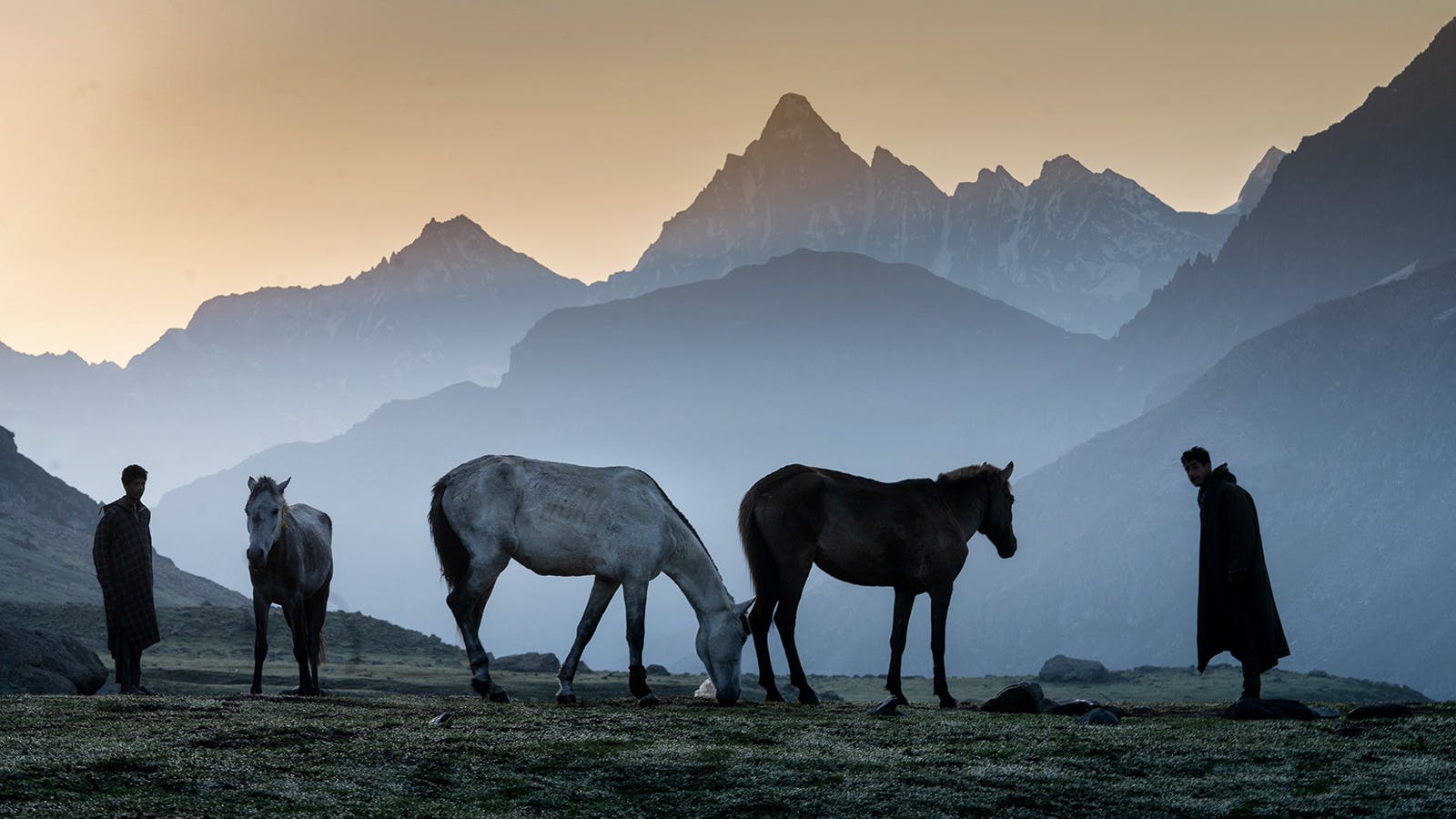
Mule men waiting for the sun to rise and feel the warmth.
Picture by: Waleed
Kolohoi Peak at Tarsar
Trek Trivia
Things Nobody Tells You About Tarsar Marsar Trek
- Mystery into names of the Lakes
- Tribal Tales
- Interesting Fact
Did you know that the name of the Tarsar Marsar Trek is linked to life and death?
The name Tar and Mar in Kashmiri roughly translate to life and death. There is famous local folklore in Kashmir on why these lakes were named as such. Do ask your guides for the story.
Locals say that one can find true peace at the Tarsar lake. It joins one place to another and makes you feel at ease. On the other hand, it is believed that Marsar lake is the opposite.
Sundersar, the second lake on the Tarsar Marsar trek, is more locally known as Chandrasar because of the crescent moon-like shape of the lake. On this trek, you get to visit 3 beautiful lakes that give you a deep insight into Kashmir.

Did you know about the ancient tribe at Lidderwat?
The true start of the Tarsar Marsar trek begins at Lidderwat. Lidderwat is not just a place. It's a junction.
At this junction, there's a family of Gujjars. Gujjars are an ethnic agricultural and pastoral community of India. There's something extremely special about them. They've mostly earned a living by keeping cattle and selling milk, and wool.
As the winters begin, the Gujjars vanish by September and go down to Jammu. They are mostly here from the three months of July to September. Make sure to interact with them and find out more on the trail. They are usually in their Pathani suit.

Did you know that Marsar lake is connected to the mighty Dal lake?
The Marsar lake which you'll come across on the Tarsar Marsar trek is connected to Dal lake. All alpine lakes have runoff. Marsar's runoff connects to Dal lake.
It goes towards Dachigam National park. This national park is between Dal and Tarsar Marsar.
It is a true scenic beauty, and a privilege to witness the aura of the Dal lake. The Marsar lake is small in size. The mysterious vibe and blue colour of the lake are a sign to behold. However, the beauty of this lake will captivate your heart.

Leaving Mountains Better
Green Trails is our promise to leave the mountains better. We have removed over 1 lakh kilos of the waste left behind by others on trekking trails. Yet this is a small percentage of what we do. Green Trails dives into reducing the use of resources, reducing our carbon footprint and bringing about a change in the daily practices of our trekkers too.

Alternative Treks To Do

Tulian Lake
Get Trek Info

Bhrigu Lake

Chandrakhani Pass Trek
The hidden lake trek
The Prettiest Grassland Trek in Himachal

Chandrakhani Pass Tr...
Himachal's most loved pass climb for beginners
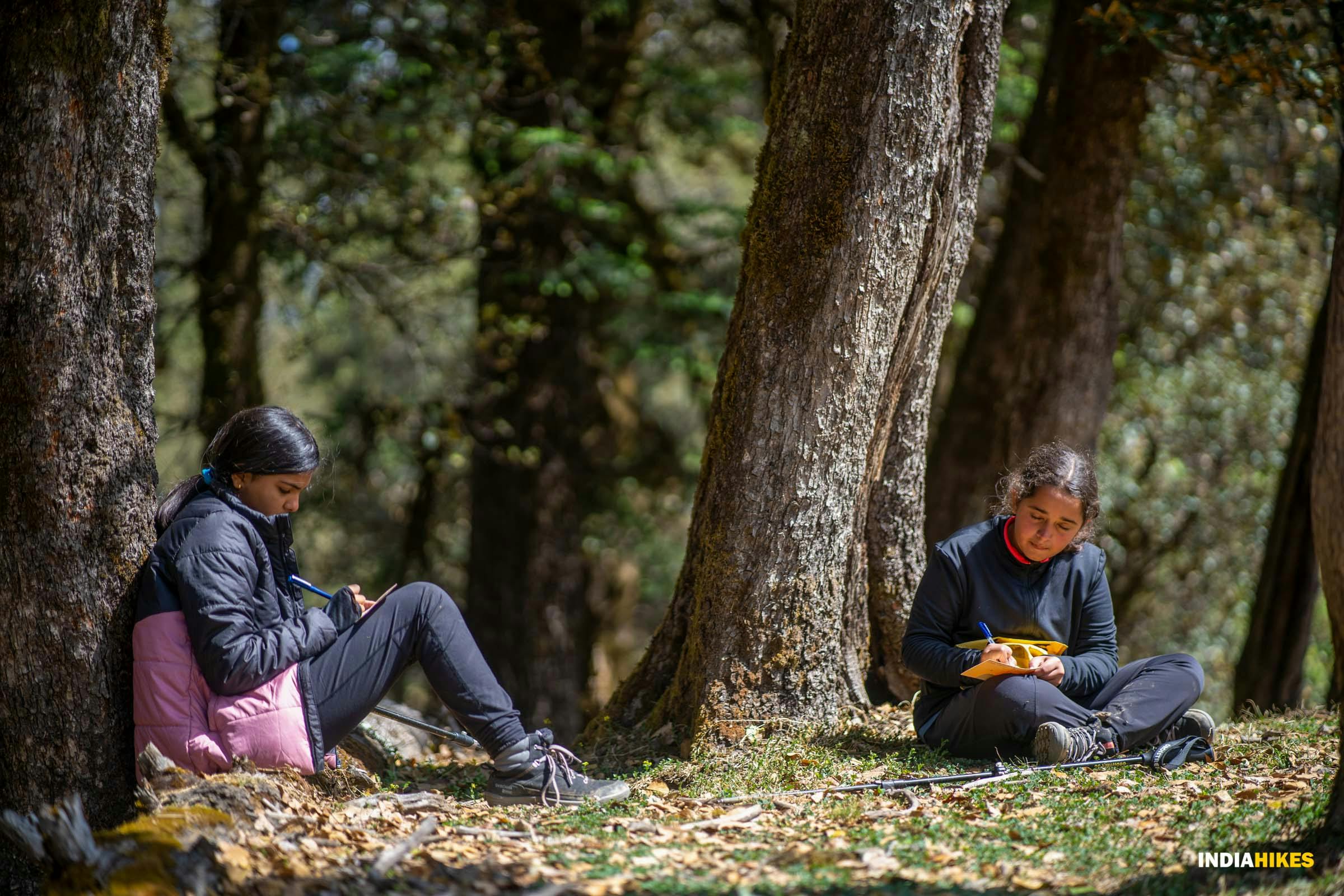
Download The Summer Camp 2024 Brochure
Sign up for our much loved Weekly Mailer
We have terrific trekking tips, trek updates and trek talks to look forward to
Treks by Categories
Treks by season, treks by month, treks by duration, treks by difficulty.
- Easy - Moderate
- Moderate - Difficult
Treks by Region
- Uttarakhand
- Himachal Pradesh
- Lahaul and Spiti
- Jammu & Kashmir
- West Bengal
- Chhattisgarh
Treks by Experience
- Family Treks
- Stargazing Treks
- Senior Treks
- Adventure Therapy
- Summer Camps
- Youth Camps
- Cancellation policy
- Work with us
- Our sustainability practices
- Privacy Policy
- Terms & Conditions
080 468 01269 Mon to Sat - 9.30 AM to 7.30 PM Sun - 9.30 AM to 6.30 PM
Bengaluru Office
139, Defence Colony Road, Defence Layout, Sahakar Nagar, Bengaluru, Karnataka 560092
Dehradun Office
Mohabbewala, Titan Road, Near Titan Factory, Chandramani Khalsa Dehradun - 248002
© 2024 Indiahikes Private Limited
All images are copyrighted by their respective authors.

Tarsar Marsar Trek
Tarsar marsar trek in kashmir.
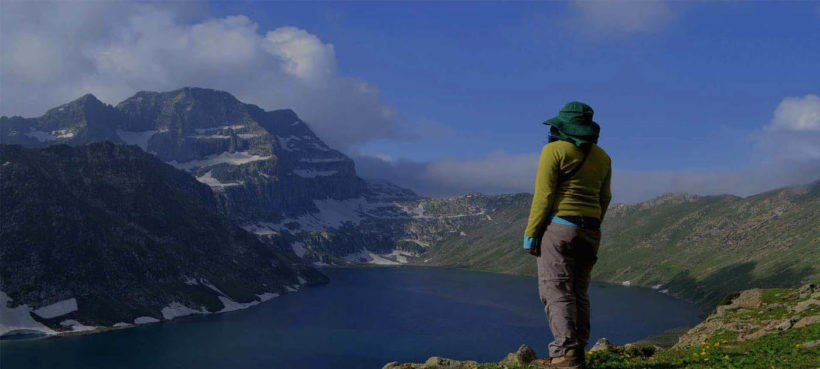
Description
Reviews (4), things to take, available dates, include-exclude, tarsar marsar trek, the prettiest lakes in kashmir aru valley -india- complete information, 2024.
Tarsar Marsar Trek lies in the fascinating beauty of Kashmir which is well known across the globe. Therefore, on Tarsar Marsar Trek go deep in the heart of Kashmir and get totally different experiences of Trekking in India .
During the trek, get a chance to camp beside the serene bluish alpine lakes. And, all the way to Tarsar get multiple sights of the same Lake.
On the other hand, Marsar which remains hidden under a sheet of clouds. Witness its splendor from an overhang lying below 600-700 feet. But, the lake can only be seen until the clouds are clear. So, certainly, Tarsar Marsar is the prettiest lake in India .
The trail hides in a thick blanket of snow and green valley. The lush verdant forests turn white making it a small wonderland! The Tarsar Marsar trek is not only for experienced trekkers but for amateurs and children too families, school groups.
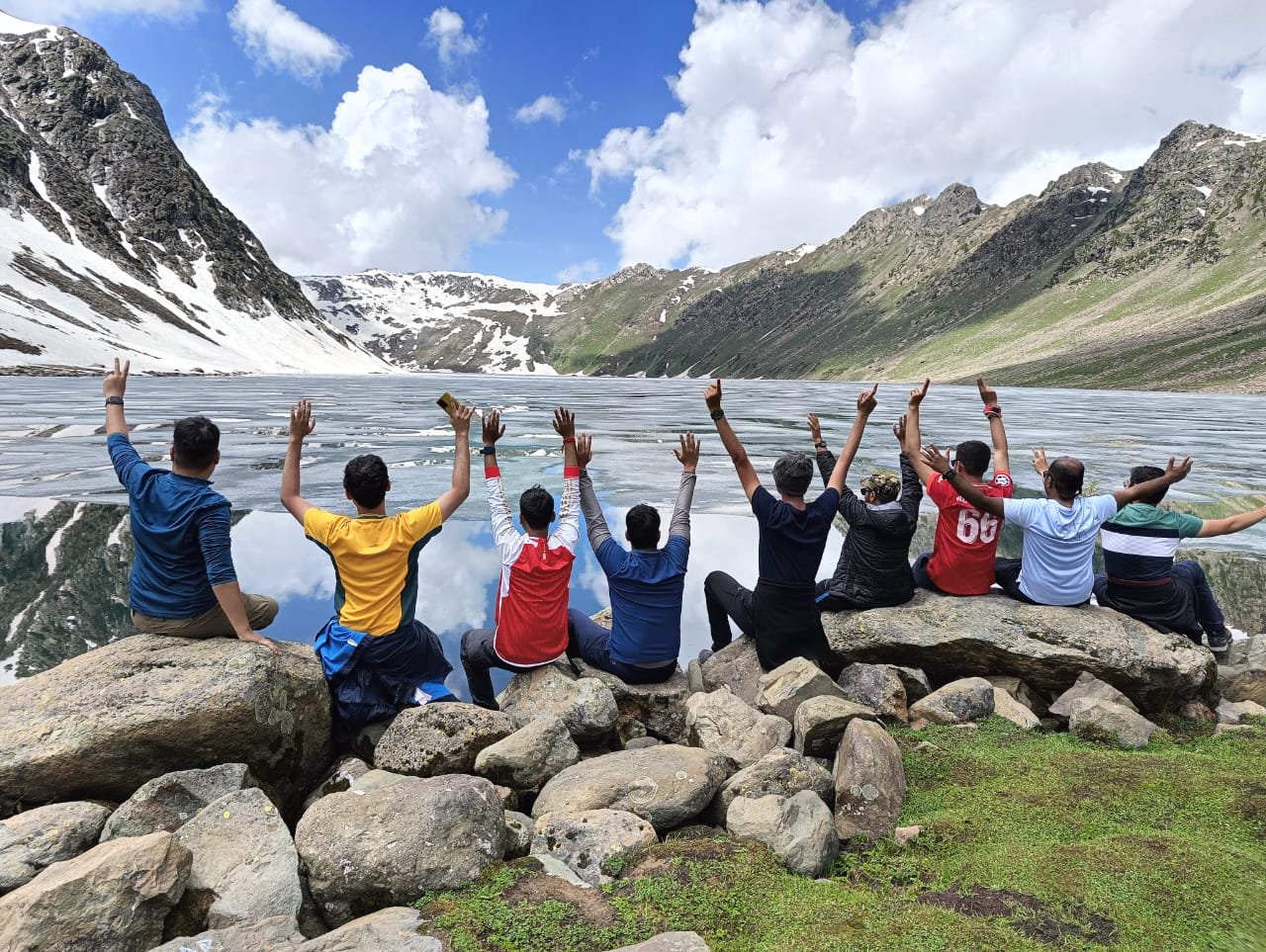
The Tarsar Marsar Trek is a Popular trekking route in the Kashmir Valley
Here are some of the main points of interest along the trek:.
Aru Valley: The trek starts from the picturesque Aru Valley, located about 12 km from the town of Pahalgam.
Lidderwat: After crossing the Lidder River, the trek leads to Lidderwat, a beautiful meadow surrounded by towering mountains.
Sheeshnag: The next stop is Sheeshnag, a glacial lake nestled amidst the mountains. The lake is named after the seven peaks that surround it, which are said to resemble the heads of a mythical creature.
Tarsar Lake: The highlight of the trek is Tarsar Lake, a stunning high-altitude lake located at an elevation of 3,962 meters. The lake is surrounded by lush green meadows and snow-capped peaks, and is a popular camping site.
Marsar Lake: After Tarsar, the trek leads to Marsar Lake, another high-altitude lake situated at an elevation of 3,798 meters. The lake is known for its crystal-clear blue waters and is surrounded by snow-covered mountains.
Homwas: The trek ends at Homwas, a small village located on the banks of the Wangath River.
Overall, the Tarsar Marsar Trek is a challenging but rewarding trek that offers stunning views of some of the most beautiful landscapes in the Kashmir Valley region.
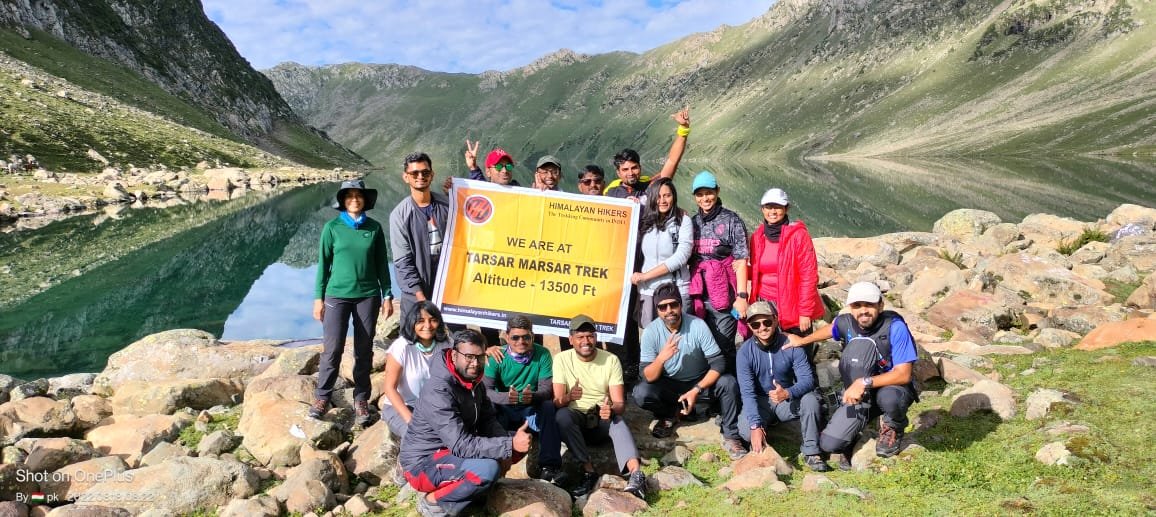
The Astounding Campsites in Tarsar Marsar Trek
The first highlight of this trek is camping beside snow-fed alpine lakes which is the most important and best part of this trek. In addition, witness the changing colors of the lakes as the sun shines upon them. Do not miss the spellbinding sunset and sunrise views over the Lake at Tarsar and Sundersar campsites.
Moreover, explore the amazing clearings lying after the dense coniferous forests and spot few Gujjar huts on the way.
Best Time to Do Tarsar Marsar Trek
Tarsar marsar trek is a very beautiful and moderate trek in the Kashmir aru Valley, The Tarsar marsar Trek is great for those people who have a great passion for mountaineering. Hills and consider it a special purpose in their life.
We are are doing this trek for years, we have every experience related to this trek. The right time to do this trek is from 5th June to the last of September, especially in the months of June, green and colorful bugyal meadows, snow is found in abundance here, which makes your trek very memorable
During the day the temperature of tarsar marsar trek is around ( 05°C to 15 °C and during the night the temperature comes down to 03 °C to 05 °C which is not bad.
You will never consider yourself boring in tarsar marsar Trek, this trek can give you nothing but joy, You will get to see the culture and beauty of Kashmir valley in this trek which will always keep you connected towards the mountain.
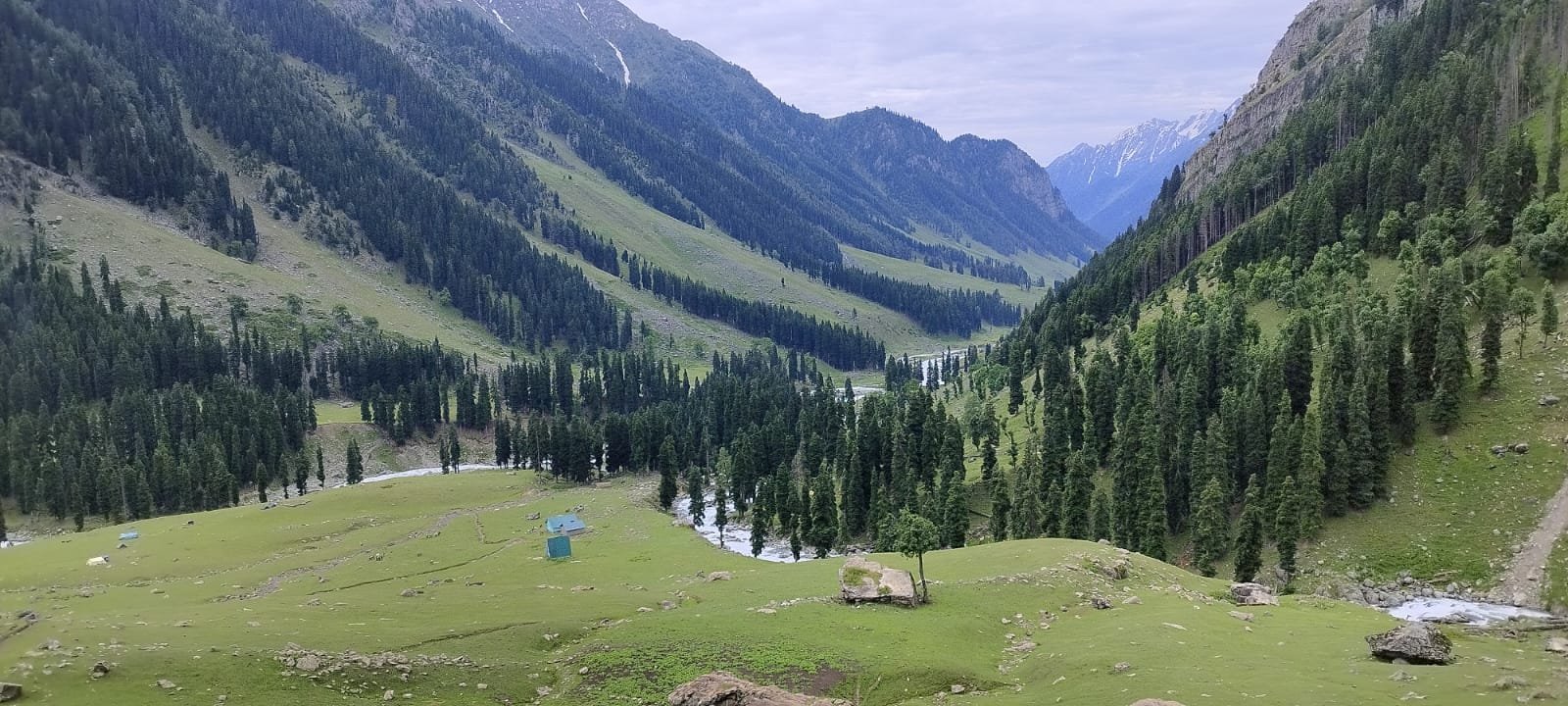
Aru Base Camp & Exotic Grasslands in Tarsar Marsar Trek
Aru is the base camp of Tarsar Marsar trek, it is a small idyllic village surrounded by lavish grasslands. The village is famous because of some cottages, poplar trees, and a rivulet flowing through this village’s heart.
The Aru villagers so heartily welcome trekkers that they surely come again to do another trek. The nature of Kashmir – meadows, rivers, streams, birds, animals and flowers everything is attracting people to visit it. Really, Jammu and Kashmir valley is no less than a paradise which is also known as the Taj of India
Before, Sundersar campsite, pass through wide Jagmargi grasslands. Therefore, get amazed by its pulchritude because the wide grasslands are surrounded by mountains and a small rivulet flows through the pristine valley blooming with colorful flowers in yellow, blue and pink shades.
How Difficult is the Tarsar Marsar Trek?
The Tarsar Marsar trek is considered a moderate to challenging trek, suitable for experienced trekkers or those with a good level of fitness and hiking experience. The difficulty level can vary depending on factors such as weather conditions, personal fitness, and previous trekking experience. Here are some factors to consider:
Terrain : The trek involves traversing through various terrains such as meadows, forests, rocky trails, steep ascents, and descents. The terrain can be uneven and challenging at times, requiring a certain level of physical fitness and stamina.
Altitude : The trek reaches a maximum altitude of around 13,500 feet (4,115 meters) at the Tarsar Pass. Altitude sickness can be a concern, so it’s important to acclimatize properly, stay hydrated, and take necessary precautions.
Distance and Duration : The trek covers a distance of approximately 45-50 kilometers, which is typically completed in 7 days. The daily walking duration can range from 4-7 hours, depending on the itinerary and individual pacing.
Weather and Temperature : The weather in the region can be unpredictable, with cold temperatures, rain, and snow possible even during the trekking season. It’s important to be prepared for varying weather conditions and pack appropriate clothing and gear.
Camping and Facilities : The trek involves camping at various locations along the route. Basic facilities such as tents and sleeping bags are usually provided by trek organizers, but it’s advisable to check in advance. There may be limited or no access to amenities like electricity, running water, or mobile network coverage in certain areas.
Is Tarsar Marsar Trek Safe for me ?
The Tarsar Marsar trek can be moderate, especially for beginners or those with limited trekking experience. However, with proper preparation, guidance, and taking necessary precautions, it can still be a safe and enjoyable experience. Here are some points to consider:
Physical Fitness : The trek requires a reasonable level of physical fitness and endurance. Beginners should assess their fitness level and undertake suitable training before attempting the trek. Regular exercise, cardio workouts, and building stamina through hiking or walking can help prepare the body for the demands of the trek.
Guided Trek : For beginners, it’s advisable to join a guided trek where experienced guides can provide assistance, support, and knowledge about the route. They can help with navigation, and safety precautions, and offer guidance during challenging sections of the trek.
Acclimatization : Proper acclimatization is essential, especially when trekking at high altitudes. Beginners should take the necessary time to acclimatize and adjust to the altitude before attempting the Tarsar Marsar trek. It’s important to follow gradual ascent techniques, stay hydrated, and be aware of the symptoms of altitude sickness.
Safety Precautions : It’s crucial to prioritize safety during the trek. This includes following the guidance of the trek leaders, maintaining a steady pace, using appropriate trekking gear, staying hydrated, and avoiding overexertion. Understanding the risks associated with the trek, such as weather conditions or challenging terrains, is important for making informed decisions.
Preparation and Equipment : Beginners should ensure they have the necessary equipment, clothing, and gear suitable for trekking in varying weather conditions. This includes proper hiking boots, warm clothing, rain gear, a sleeping bag, a first aid kit, and other essential items. It’s advisable to consult with experienced trekkers or seek professional advice to ensure you have the right gear.
Travel Insurance : It’s always recommended to have travel insurance that covers trekking activities, including emergency medical evacuation, in case of unforeseen circumstances or emergencies.
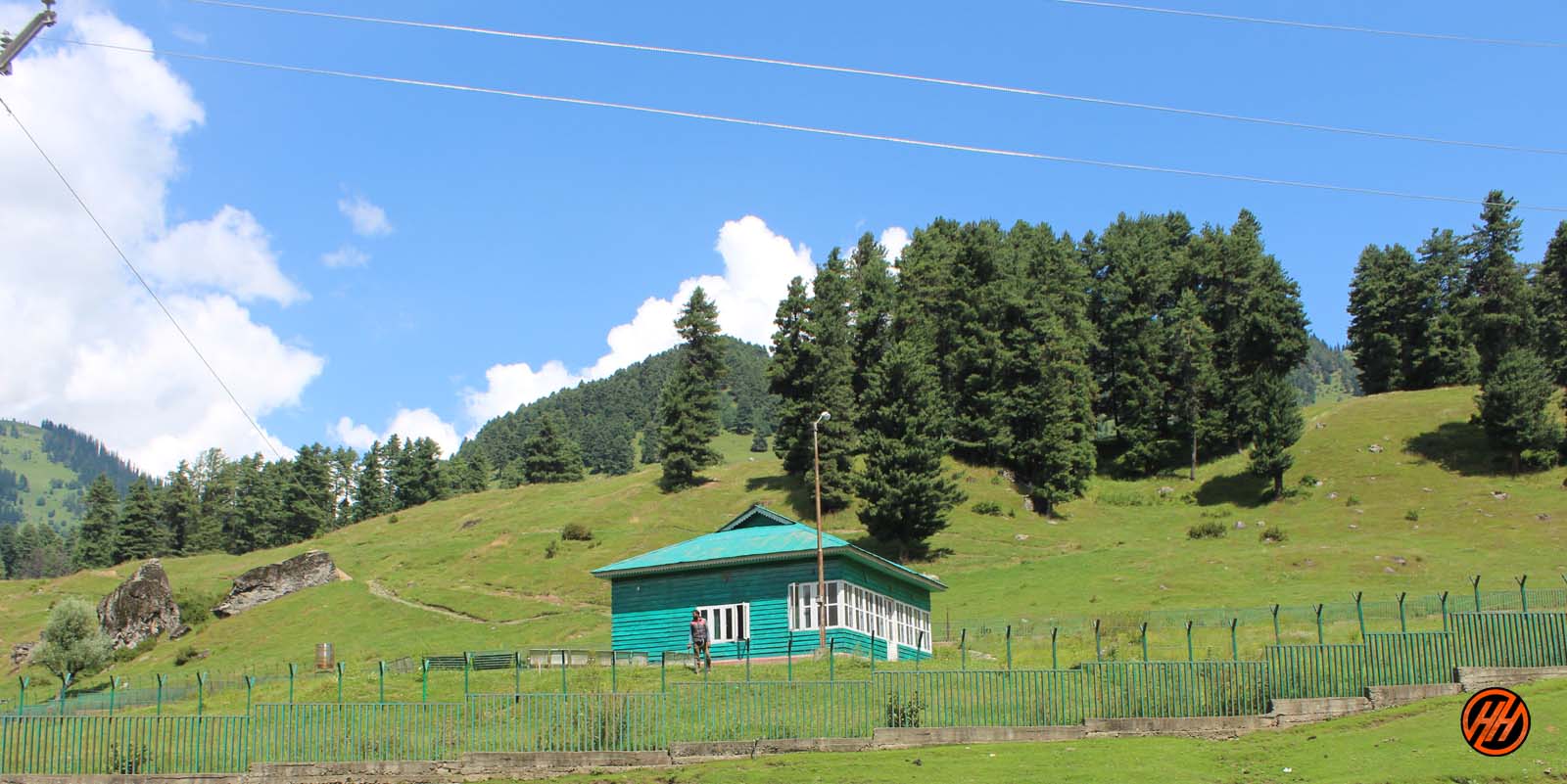
Why choose Tarsar Marsar Trek?
Before heading towards the itinerary, it is really essential to perceive the reason behind choosing Tarsar Marsar Trek.
See firstly, the trekking distance is a total of by taxi 224 Km and on foot 48 km which is to be covered into 6 nights 7 days. From Srinagar to Srinagar
Tarsar Marsar Trek is a low altitude mountain trek Altitudes is 13205 feet
The Starting trail is easy to moderate as compared to other treks this is a Moderate trek. So this trek is best for family and beginners, school tour
Need proper gear & clothing for sub-zero temperatures?
You got to see so many heavenly bodies at one place like the panoramic view of the Himalayan ranges, you can see pine forests, and different varieties of flora and fauna surpassing bona fide Kashmir culture.
I think Do spare time in Interaction with our local’s team, and you will get to know about some of the ancient tales of Indian mythology and our local cultures, these is good ideas for trekkers Beautiful landscapes so carry proper photo gear & Extra battery backup.
The backpack should not exceed 12 kg only
Trekkers carry your Photo ID, Adhar Card, Passport, Visa, medical certificate trek insurance for entry at forest check posts on the trek it is very important
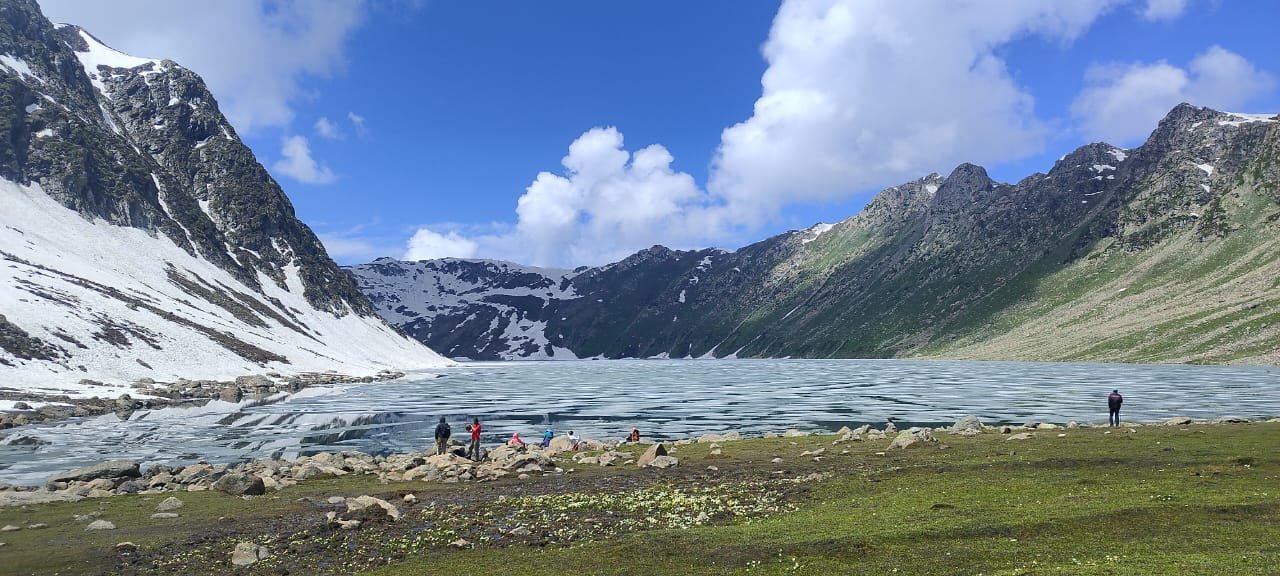
What should you keep in mind for the July, Aug, Sep, Season trek to Tarsar Marsar Trek?
Tarsar Marsar Trek is as good as it is said, you also need to be prepared., Tarsar Marsar Trek is a moderate trek that starts from Srinagar and ends after the trek same point,
So what are the special things to keep in mind before coming on this trek?
Summer Season
Summer trek to Tarsar Marsar Trek is very special, the view and the temperature are all favorable to you
For summer trek, you have to bring only normal clothes, so that your trek can be good, there is no need for hot clothes, but in hiking it is also necessary to bring all the equipment which is necessary for you.
It is necessary to have 3 pairs of clothes from trekking, especially the poncho, you will have to bring every season
In the summer season, the temperature is always normal, so there is no need for hot clothes.
Monsoon Season
During the monsoon season, it rains occasionally during the Tarsar marsar Trek, especially in the Kashmir valley, so if you have dry clothes here, it is very good, even when wet, it dries quickly.
At this time you have to bring at least 3 pairs of clothes, for monsoon trek you do not have to bring too warm clothes, at this time you, hiking pants and t-Sart, I can trek
It’s only a little cold in the morning and evening and the day is a good temperature for you
Before going on any trek, it will be easy for you to take information related to each season.
Trekkers need to know about these, you can ask us anytime like, trek route, trek map, temperature, weather condition, difficulty level, trek starting point, end point, transport, view of the trek, best time to visit, How to reach, trek distance etc, Trek Location, keep this information before going
Altitude we are going to cover in Tarsar Marsar Trek
Aru Village – 7958 feet)
Lidderwat – 9136 feet)
Shekwas camp -11089 feet)
Tarsar Lake – 12500 feet)
Marsar Lake – 11500 feet)
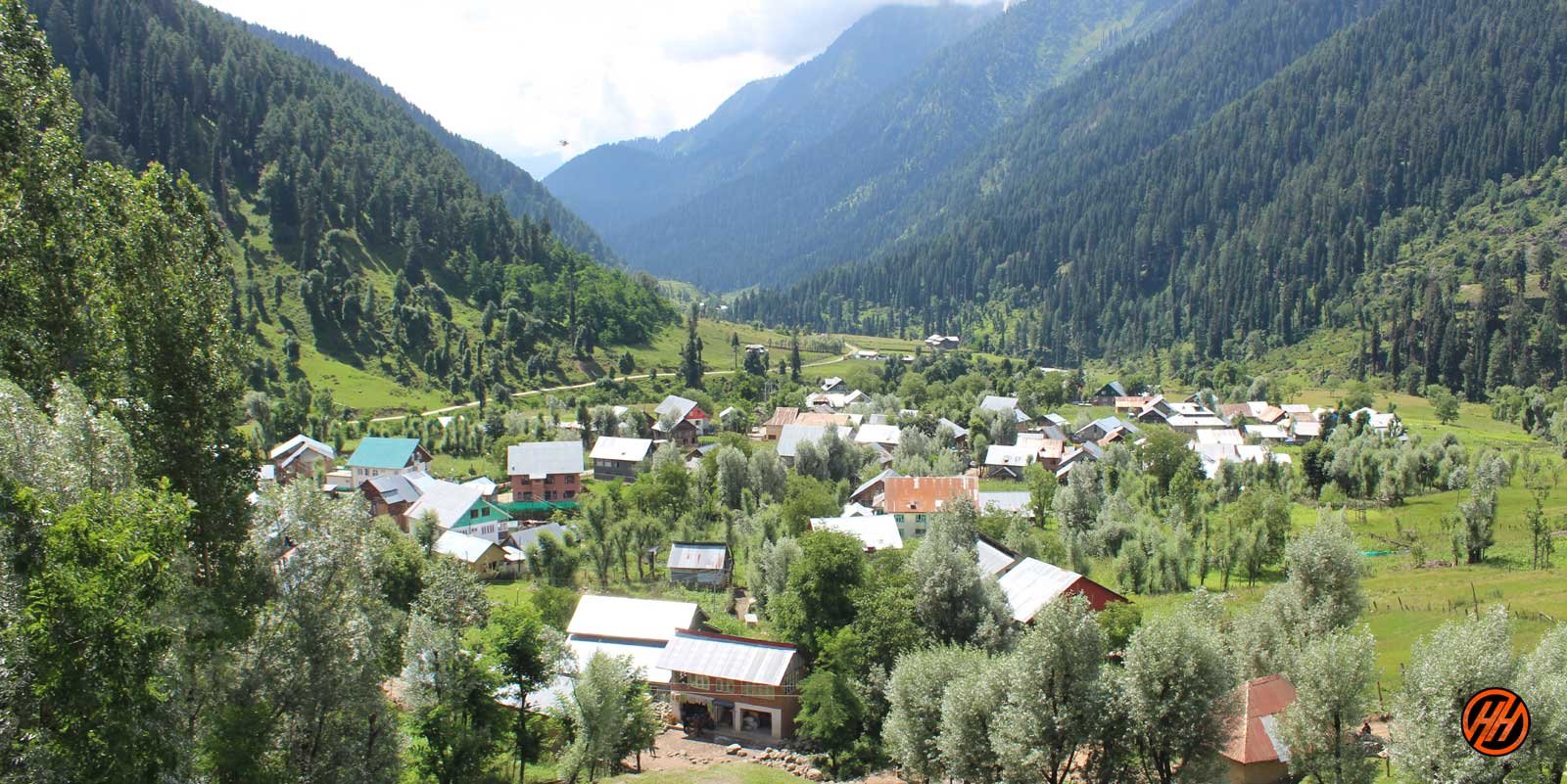
Key Points of Tarsar Marsar Trek
Duration: – 06 Nights 07 Days
Base camp: – Aru Village
Monsoon Temperature: – Day (5°C to 15°C) Night (2° C to 5° C)
Tarsar Marsar – Altitude: – 13205 Feet
Best Time: – June, July August, September
Trek Level: – Moderate
Trek distance: – On foot 23 Km – By taxi 420 km
Group Size: – 8 to 15 people
Short Itinerary of Tarsar Marsar Trek
Day 1- Pickup to you from Srinagar TRC office 1:00 pm – Drive to Aru village – 112 Km (4/5 Hours (7958 feet) overnight stay Home stay
Day 2 – Trek from Aru village to Lidderwat (10 km) (5/6 Hours) (9136 feet) overnight stay at camp
Day 3 – Trek from Lidderwat to Shekwas camp (06 km) (4/5 Hours) (11089 feet) (overnight stay our campsite
Day 4 – Trek from Shekwas camp to Tarsar Lake (05 km) (3/4 Hours) (12500 feet) overnight stay camp.
Day 5 – Trek from Tarsar Lake to Sundersar camp (05 km) (3/4 Hours) (12978 Feet) overnight stay camp
Day 6 – Trek from Sundersar camp to visit Marsar Lake go to Homwas camp (09 km) (6/7 Hours) (11500 Feet) overnight stay camp
Day 7 – Trek from Homwas to Aru Village (13km) same day drive to Srinagar by taxi (112 km) – 4/5 Hours
How to Reach Tarsar Marsar Trek?
To reach Aru, Srinagar for the Tarsar Marsar trek, you can follow these steps:
Arrive in Srinagar : Book a flight to Srinagar International Airport, which is well-connected to major cities in India. Alternatively, you can also reach Srinagar by train or bus from other parts of the country.
Travel to Pahalgam : From Srinagar, you need to travel to Pahalgam, which is the starting point of the Tarsar Marsar trek. You have a few options to reach Pahalgam:
Private Taxi: Hire a private taxi from Srinagar to Pahalgam. This is the most convenient option but can be a bit expensive.
Shared Taxi: You can find shared taxis or cabs near the Tourist Reception Center (TRC) in Srinagar. These taxis follow a fixed route and are a more affordable option.
Public Bus: Take a public bus from Srinagar to Pahalgam. The Srinagar Bus Stand near Lal Chowk is the main bus terminal in the city.
Reach Aru : Aru is a small village located around 12 kilometers from Pahalgam. Once you reach Pahalgam, you can hire a local taxi or take a shared cab from the taxi stand to reach Aru. The journey from Pahalgam to Aru takes approximately 30-40 minutes.
Start the Tarsar Marsar Trek : Aru serves as the starting point for the Tarsar Marsar trek. You can find local trekking guides and porters in Aru if you require their services. Make sure to carry all the necessary trekking gear, equipment, and supplies for the trek.
Please note that it’s always a good idea to check the current travel conditions and any restrictions or permits required for the trek before planning your trip. It’s also recommended to consult with local authorities, tour operators, or experienced trekkers for the most up-to-date information regarding the Tarsar Marsar trek.
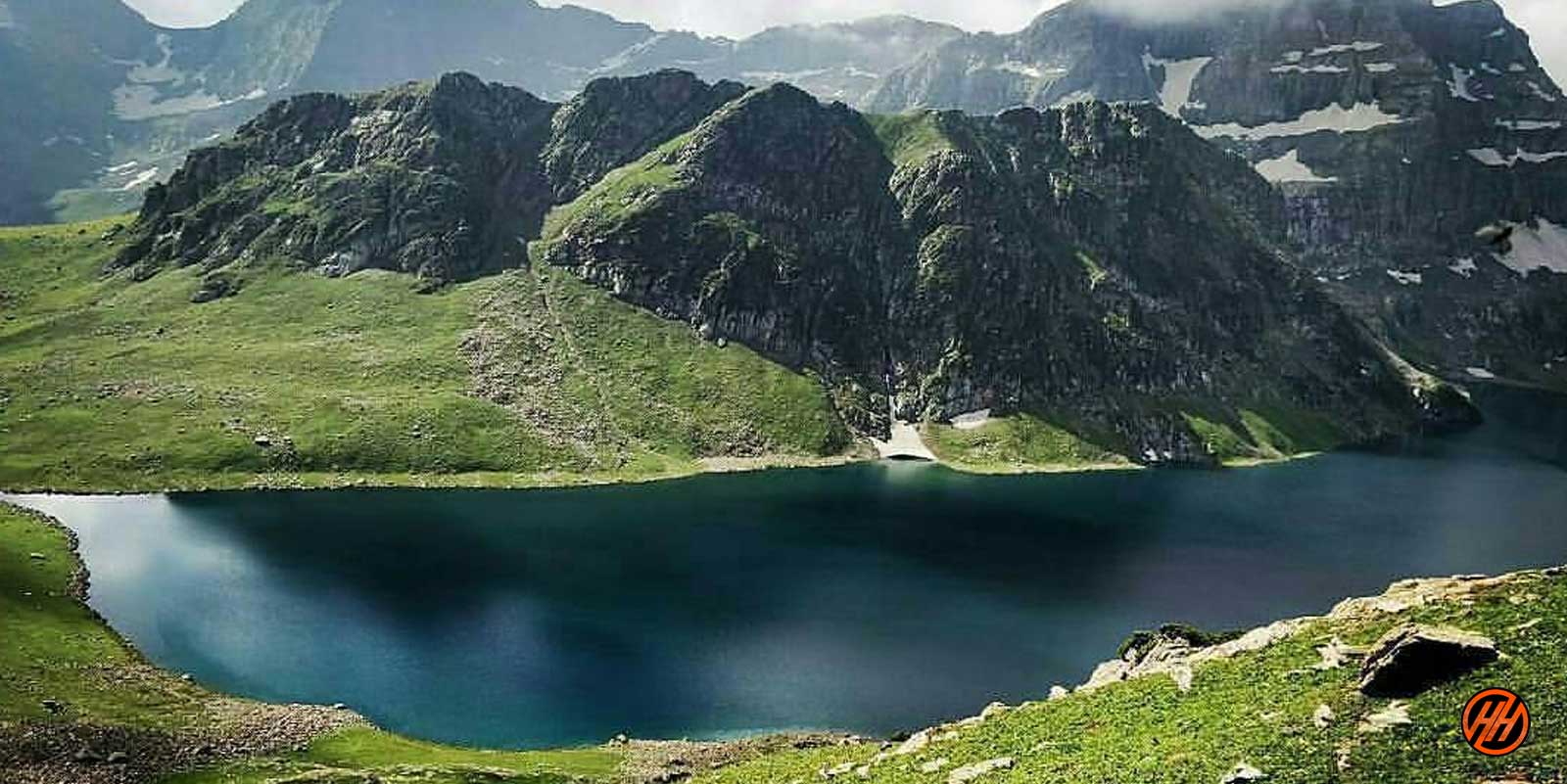
Will there be electricity in the Tarsar Marsar trek
Let me tell you that there is no electricity in the forest area of the Tarsar Marsar trek. Here we use Stobe Light and or Solar Light, candle light at the nights
If you come on this trek, then you should bring your own headlight and your camera with full charge, if possible, it would be good to bring extra battery backup, and also bring the phone after full charge, today people most of phones use the same
You will get the last electricity only in our Home Stay Aru Village, where you have to charge the battery of your phone and camera at night.
What to pack for Tarsar Marsar Trek
When packing for the Tarsar Marsar trek, it’s important to strike a balance between carrying essential items and keeping your backpack light. Here’s a list of items you should consider packing:
Base Layers: Moisture-wicking and quick-drying T-shirts and thermal tops.
Insulating Layers: Fleece jackets or down jackets to keep you warm during colder temperatures.
Waterproof Jacket: A durable rain jacket or windbreaker to protect against rain and wind.
Trekking Pants: Lightweight, quick-drying pants that provide comfort and flexibility.
Warm Layers: A couple of warm sweaters or hoodies for cooler evenings.
Undergarments and Socks: Carry enough pairs for the duration of the trek, preferably moisture-wicking and comfortable.
Hiking Boots: Sturdy, ankle-supporting waterproof boots with good traction.
Camp Shoes: Lightweight and comfortable sandals or slippers for wearing at campsites.
Gear and Equipment :
Backpack: A well-fitting backpack with a capacity of around 50-60 liters to carry your gear.
Sleeping Bag: A warm and lightweight sleeping bag suitable for the temperatures during the trek.
Trekking Poles: Optional but helpful for stability and reducing strain on your knees during ascents and descents.
Headlamp or Flashlight: Essential for navigating in the dark and during early morning or late evening hikes.
Water Bottle and Water Purification: Carry a reusable water bottle and water purification tablets or a water filter to ensure a safe drinking water supply.
Trekking or Hiking Tent: If you prefer to carry your own tent, choose a lightweight and sturdy tent suitable for camping during the trek.
Sleeping Pad: A lightweight inflatable sleeping pad or foam pad for insulation and comfort during camping.
Personal Toiletries: Toothbrush, toothpaste, biodegradable soap, hand sanitizer, toilet paper, and wet wipes.
Sun Protection: Sunscreen, sunglasses, and a wide-brimmed hat to protect against the sun’s rays.
Miscellaneous :
First Aid Kit: Carry a basic first aid kit with essential medications, band-aids, antiseptic ointment, and any personal medications you may require.
Navigation and Communication: A map, compass, or GPS device for navigation, and a fully charged mobile phone with a power bank for communication (keep in mind that network coverage may be limited in certain areas).
Snacks and Energy Bars: Carry lightweight and high-energy snacks such as nuts, energy bars, and dried fruits for quick energy boosts during the trek.
Cash and Identification: Carry sufficient cash in small denominations and a valid identification document.
Remember to pack light and only carry the essential items to avoid unnecessary weight. Additionally, check the weather forecast and the specific requirements of your trek with the trek organizers to ensure you have all the necessary gear and equipment.
Self-Certificate of Emergency Breakout
what we do during an emergency breakout in the tarsar marsar trekking.
Trekking in the Himalayas is not a cup of tea but it is a rewarding experience. However, it’s important to keep things in mind when it comes to Safety. One must know about the weather conditions, the altitude gain, fitness and other factors that can wreck your experience. In such adverse conditions, you are solely responsible for your well being and act maturely.
Read About Safety Tips For Safe Trekking
Preparations before the Trek
You’ve to understand that treks are away from cities and medical help is not always easily available. So, if you are heading for an adventurous trekking trip, stick to certain trekking guidelines and tips. Following these simple tips will help make the trek more fun and experiential for you as well as your fellow trekkers.
These tips and guidelines cater to useful and requisite information about your fitness training, packing and health precautions to be taken before and during the trek.
Firstly, when you start, target 5 km in 40 minutes
Then gradually increase your pace by running at least 4 times a week. Then try to bring it down to 5 km in less than 37 minutes
If you are a person who prefers cycling over running then your target must be 22 km means you should be able to cover 22 km in 60 minutes.
Walking is a great exercise that gives great shape to your legs and your body. It helps in burning calories and cut down excess weight and strengthens the heart.
Jogging is effective in increasing the human lifespan and makes your lungs stronger. It is an aerobic activity that requires a lot of oxygen. This is a great exercise for fighting obesity and staying healthy.
Squats are the best form of functional exercises to improve stability. They also strengthen your legs, thighs, hips, and hamstring.
Another great cardiovascular exercise is pushing your body upstairs after stairs. This is regarded as the best exercise for increasing strength and power
What we do during an emergency breakout in the Tarsar Marsar Trek?
First of all, the safety of trekkers is much more for us, if you see in the trek, then there are all the risks, which I do not think about.
Himalayan Hikers worry more about you that no one should ever have any problem in the trek.
What should we and you keep more safety in the trek
- Whenever you are going for any trek, it is very important that you go completely fit and ready.
- The trek is not difficult, if you make your feet and your mind calm and strong, you will find the trek very easy.
- While trekking, keep in mind that you are walking on the right route or not always with your guide.
- Most people look somewhere and where they are walking, this can cause twitching in your legs, which can ruin your entire trek.
- It is important to ask your doctor if you have any medical problems
- I should always keep my medical kit with me, it is very important.
- Himalayan Hikers always keep a medical kit with you, such as oxygen cylinders, medicine to be given in emergency on the trek
- If any trekkers have any more problems, then they are brought back to the base camp by laying them in the stretcher.
- Our camp in Tarsar marsar trek is around the 6000 feet to 13000 feet where you can not have any problem of oxygen
- In case of any medical problem, the help of your guide or well-informed trekkers should be taken
- If there is major health problems in Tarsar marsar trek , then Nearest Hospital is in Srinagar which is about 112 Kms away from Tarsar Marsar Trek
- Along with the trek we keep getting acclimatization
Day 1 : Pickup to you from Srinagar Airport to Aru Village
Total distance 112 km – 4/5 Hours journey
Mode of journey – By taxi
Altitude – Aru – 7958 feet
Night stay – Hotel – on twin share basis
Reach Aru Village in 3 /4 hours via Pahalgam, to Aru village, you can reach Pahalgam through two routes; Bijbehra is the famous tourist route and the drive is a picturesque one through rural areas of Kashmir.
Witness trees and orchards along the way and in half an hour reach Aru, base camp of Tarsar Marsar trek, Aru village. 7958 feet above mean sea level. A small but beautiful hamlet with wooden homes on stilts.
Day 2 : Trek from Aru village to Lidderwat Camp
Total distance 10 km – 5/6 Hours journey
Mode of journey – On foot
Altitude Lidderwat – 9136 feet
Night Stay – Our Campsite – on twin share basis
After breakfast the start trek from Aru to Lidderwat is a long one. Start your trek through a village and follow the course of River Lidder. The trail is wide and from there whole Aru village is visible. Ahead, reach Dalla; a clearing. From here, enter a pine forest and come across Nandkei; a group of Gujjar settlement.
After you cross this forest section, go further and come across open grasslands, there you can see Gujjar families. Half an hour walk from here will lead you to multiple streams, cross them and reach Lidderwat in another half an hour. Start trekking through the forest of pines, go higher and stare at the beautiful scenery offered. Now, enter the fir forests and after some minutes of walk reach Lidderwat.
The Lidderwat have surpassing meadows and you can camp other side because there is open space for camping. Spend time exploring this place, and enjoy relaxing stay in tents.
Day 3 :Trek from Lidderwat to Shekwas camp
Trek Distance 06 km – 4/5 Hours journey
Altitude – Shekwas – 11089 feet
Night Stay – Our Camp site – on twin share basis
Follow the course of River flowing along and take the trail through pine forest above. After a gradual climb, continue trekking through the pine forests and some small clearings for 30 minutes. Ahead, enter the Lidderwat valley, there are wide grasslands surrounded by mountains with some snow patches.
The splendid valleys meet together and the trail goes upward. Towards the left are Bhakarwal shelters on the right of the river and en route come across small clear streams crossing the trail, you can also refill your water bottles from here.
Now, trek down the river and cross it with the help of boulders and a bridge further. By following the river continue trekking on the trail and after 30 minutes you will reach a wide clearing “Homwas”.
At Homwas you can see some Gujjar huts, trek through a grassy area which is a relief to the feet. After crossing this section come across a narrow valley and trek along the river. Ascend for one hour and reach a point with a group of Silver Birch trees and amazing scenery.
Further, come across grassland beautiful and wide which leads to two soothing green valleys. Have a look at the meadows and pass through the trail with few Gujjar huts to reach your camping site Shekwas. It is an extraordinary ground with mesmerizing sights, spend your night here relaxing in tents.
Day 4 : Trek from Shekwas camp to Tarsar Lake.
Trek Distance 05 km – 3/4 Hours journey
Altitude – Tarsar Lake – 12500 feet
Night Stay – Camp site – on twin share basis
The trail to Tarsar is through a ridge which has an overhanging stream and further it leads to the hill in front. Cross some short ridges opening to awe struck sceneries and after two hours of trekking, get first sight of Tarsar Lake.
The sight will energize you to reach the alpine Lake, cross a stream by hopping on boulders and reach the grassy field of Tarsar. It is a perfect camping spot.
Pitch your tents anywhere on the ground. Camp along the snow fed clear bluish lake and get mesmerized by the idyllic setting. Overnight stay in camp
Day 5 : Trek from Tarsar Lake to Sundersar camp.
Trek Distance – 05 km – 3/4 Hours journey
Altitude – Sundersar – 12978 feet
Night Stay – our Camp – on twin share basis
The other side views of Tarsar are spellbinding and the stretches of grassy valley will leave you speechless because they seem never ending and trekking on the velvety grass of the valley is a bliss. This valley leads to the meadows of Shekwas. But, mostly people descend from Tarsar until the Shekwas leads to Sundersar valley, but climbing this pass saves 3-4 hours.
Start descending through the shepherds’ trail which will take you to middle of the valley. Walk along the stream on the beautiful velvet like grass. En route see Bakkarval shelters lying on left, the trail lies behind these shelters through the boulder area. Further are lushest grasslands you will ever come across and amidst the meadows stream transforms into a large pond which is fed by the snow patches on the mountains.
Cross this section in 30 minutes and come to the meadow’s end. Reach the base of ridge by crossing a stream with the help of boulders, ascend for 15 minutes through a narrow valley to reach the ridge top. Surprisingly a wide meadow pops in front with colorful bed of flowers. The views are enthralling from here and end route of this trek is also visible with a trail leading to mountains.
Follow the trail and reach beautiful grassy land of Sundersar Lake, here you can pitch your tents anywhere on the flat ground, camping here is a delight. Enjoy in the serene beauty of Kashmir and comfortably stay in tents.
Day 6 : Trek from Sundersar camp to visit Marsar Lake go to Homwas camp
Trek Distance – 09 km – 6/7 Hours journey
Altitude – Homwas camp – 11500 feet
Night Stay – our Camp – on twin/three share basis
Pass along the shores of Sundersar Lake to get far side and through two passes you can reach Marsar. Take the shorter trail and ascend through the boulder zone, be careful while ascending because there is snow over the boulders which make this section tough. In 30 minutes pass can be reached which is an amazing grassland with gentle trails leading to the flat grounds below.
Reach the flat grounds and cross the small streams along the trail. Climbing to the ridge starts from here which offers heart racing view of Marsar. It is twin of Tarsar but remains hidden under the mist and clouds. Descend to Sundersar and reach there in 40 minutes.
Spend some time at Sundersar valley and get back to Jagmargi valley, witness the grasslands again and admire the natural beauty. Do not cross the Tarsar pass but go through the different trail to Shekwas, from here you can reach Homwas in 30 minutes. Reach there, setup your tents, have delicious food after today’s long trek, retire for the night
Day 7 : Trek from Homwas to Aru Village (13km) same day drive to Srinagar by taxi (112 km) (4/5 Hours
Total distance – 125 km – 8/9 Hours journey
Mode of journey – – On foot – 13 km – By taxi 112 km
Descend from Homwas to Lidderwat. The sights of today’s trek are beguiling and you can spot Kolahoi glacier on the way. Come across the Lidderwat pine forest, take a break at Lidderwat and then head to Aru. Now, Aru is 13 km away and you can reach there in another 4 hours. Vehicles will be arranged for you till Srinagar. Reach late evening 8 Pm
Mandatory Documents
Please carry the documents given below.
Original and photocopy of government photo identity card- (Aadhar Card, Driving License, Voters ID, etc, Passport and Visa important to foreigners Medical Certificate (First part should be filled by the Doctor and Second part by the Trekker) Declaration Certificates
Note: – Many trekkers commit the same mistake of carrying unnecessary items on a trek which only makes the backpack heavy. It is important to know the right items to carry. It differs from season to season if you are trekking in summers then carry less layers of warm clothing and if you are trekking in winters carry enough layers to protect yourself against chilly cold.
Necessary Items for trekkers

Backpack (50 to 60 liters) A strongly built backpack with good support is compulsory for a trek. (Rain cover is important)
Sturdy Trekking Shoes The shoes should be strong enough with good support. The people ask if sports shoes would be comfortable but it is good to bring the right trekking shoes.
The Clothes You Should Bring On a Trek Avoid keeping extra clothes because it only makes you backpack heavy.
Trek Pants – The jeans are never suitable for a trek so you need at least 2-3 trek pants for treks carry more for longer treks.
Jacket – Jackets are very important to carry on a trek it protects you against the chilly weather. So carry 2 jackets on a week long trek.
Layers of warm Clothing Carry warm woolen layers or fleece. Carry more layers during winter season (at least 2 to 3) and less during summer.
Thermals – The Temperature decreases at night so you might be need thermals for Night.
T- Shirts – Bring those t shirts which dry fast.
Poncho –They are needed if you are trekking on a Rainy day to keep you dry.
Hiking Pole
Water Bottle 2
Cap or Balaclava
Woolen and Waterproof Gloves
Socks (Woolen and Regular)
Torch head light
Personal Toiletry Items – (toothpaste, toothbrush, toilet paper, sanitizer etc.)
Carry Personal Medical Kit
Personal Medical Kit (Carry minimum 5 tablets and maximum 10)
Medicine for Altitude Sickness
Medicine for acidity and discomfort.
Fever and Headache Medicines
Pain Reliever
Motion Sickness Medicine
Medicine for Allergies
Medicine for Diarrhoea
Sprains Cream or Spray
Antiseptic Cream
Stretchable/Elastic bandage
Note:- Please take all medicines only when prescribed by the doctor. In case you face any problem during your trek, discuss and take advice from the Professional guide.
It is important to have some guidelines in place in case something unexpected happens. Here are some general guidelines that may be helpful:
- Have a first-aid kit: Make sure to carry a well-equipped first-aid kit that can be used to treat minor injuries and ailments.
- Follow safety protocols: It is important to follow all safety protocols and guidelines related to the trek. This includes staying on designated trails, avoiding risky or dangerous areas, and staying with your group.
- Have a communication plan: Make sure to have a communication plan in place in case of emergencies. This may include carrying a mobile phone or a satellite phone, or using a walkie-talkie to stay in touch with other members of your group.
- Know the local emergency services: Be aware of the local emergency services available in the area where you will be trekking. This includes knowing the location of the nearest hospital, police station, or rescue service.
- Carry proper gear and equipment: Make sure to carry appropriate gear and equipment for the trek, including proper footwear, warm clothing, and rain gear. This will help you stay comfortable and safe during the trek.
- Follow Leave No Trace principles: Follow Leave No Trace principles and leave the trekking area as you found it. This includes packing out all trash and waste, avoiding damaging vegetation, and respecting wildlife.
- Stay calm and collected: In case something unexpected happens, try to stay calm and collected. Assess the situation and take appropriate action to stay safe and help others in your group.
It’s also a good idea to consult with a local trekking agency or experienced guide before embarking on a trek, as they can provide additional guidance and support to ensure a safe and enjoyable experience.
Tarsar Marsar Trek FAQ
1. What is the Tarsar Marsar Trek? The Tarsar Marsar Trek is a stunning trek in the Kashmir Valley that takes you through alpine meadows, pristine lakes, and beautiful valleys. The trek is known for its twin alpine lakes, Tarsar and Marsar, which are surrounded by majestic mountains.
2. Where is the Tarsar Marsar Trek located? The Tarsar Marsar Trek is located in the Anantnag district of Jammu and Kashmir, India. The trek starts from Aru, a village near Pahalgam.
3. How do I reach the starting point of the trek? The trek starts from Aru. Here’s how you can reach Aru:
- By Air : The nearest airport is Sheikh Ul-Alam International Airport in Srinagar, about 100 km from Aru. From there, you can hire a taxi to Aru.
- By Train : The nearest railway station is Jammu Tawi Railway Station, about 300 km from Srinagar. You can take a bus or taxi from Jammu to Srinagar, and then to Aru.
- By Road : Aru is well-connected by road. You can take a bus or taxi from Srinagar, which is approximately a 3-4 hour drive.
4. What is the best time to visit the Tarsar Marsar? The best time to trek to Tarsar Marsar is during the summer months of July to September. During this period, the weather is pleasant, and the meadows and lakes are at their most beautiful.
5. What is the duration of the trek? The Tarsar Marsar trek typically takes 7-8 days, including travel time to and from Aru.
6. What is the difficulty level of the trek? The trek is considered moderate. It involves gradual ascents and descents, with some steep sections. It is suitable for trekkers with a reasonable level of physical fitness.
7. What is the altitude of the Tarsar Marsar Trek? The highest point of the trek is Marsar Lake, which is at an altitude of approximately 4,000 meters (13,123 feet).
8. What should I pack for the trek? Here’s a list of essential items to pack:
- Warm clothing (layers, thermal wear, down jacket)
- Waterproof jacket and pants
- Trekking shoes with good grip
- Trekking poles
- Backpack (40-60 liters)
- Sleeping bag (if not provided by the trekking company)
- Personal medical kit
- Water bottles and purification tablets
- Snacks and energy bars
- Raincoat/poncho
- Sunscreen, sunglasses, hat
- Flashlight/headlamp with extra batteries
- Toiletries and personal hygiene items
9. Do I need a permit for the trek? Yes, you need permits to trek in the Kashmir region. These can usually be arranged by your trekking company or obtained from local authorities in Srinagar.
10. What kind of accommodation is available during the trek? Accommodation during the trek typically includes camping in tents at designated campsites. The facilities are basic but comfortable.
11. Are there any risks or challenges on the trek? The trek involves challenges such as:
- Changing weather conditions
- Physical strain from long trekking days
- Altitude-related issues
- Navigating remote areas It’s essential to acclimatize properly, stay hydrated, and follow the guidance of your trek leader.
12. Is it safe to trek alone? While it is possible to trek alone, it is highly recommended to join a group or hire a local guide for safety, navigation, and a richer experience.
13. Can I do the trek if I have no prior trekking experience? The trek is moderately challenging and best suited for those with some prior trekking experience. Beginners should ensure they have a good level of physical fitness and perhaps undertake some shorter treks beforehand to build endurance.
14. What kind of food is provided during the trek? Most trekking packages include vegetarian meals, which are nutritious and catered to trekking needs. The food usually includes local cuisine, rice, chapati, vegetables, dal, and snacks.
15. What are some key highlights of the trek?
- Spectacular views of Tarsar and Marsar Lakes
- Beautiful alpine meadows and flower-filled valleys
- Views of snow-clad peaks and glaciers
- Camping beside pristine lakes
- Crossing high mountain passes
16. Are there any cultural or historical aspects of the trek? The trek passes through remote areas inhabited by the Gujjar and Bakarwal communities, offering a glimpse into their nomadic lifestyle and culture. The region is also rich in history and folklore.
17. What kind of fitness is required for the trek? A good level of fitness is required for the Tarsar Marsar trek. Regular cardiovascular exercise, such as jogging, swimming, or cycling, and leg strengthening exercises can help prepare for the trek.
18. What should I be aware of regarding altitude sickness? Altitude sickness can affect anyone above 2,500 meters. To minimize the risk:
- Acclimatize properly
- Stay hydrated
- Avoid alcohol and smoking
- Ascend slowly and give your body time to adjust
This FAQ should provide a thorough overview for anyone considering the Tarsar Marsar trek. If you have more specific questions, feel free to ask!
Are you Looking for Trekking Equipment on Rent?
If any trekker needs trekking equipment on Rent then Himalayan Hikers has the best trekking equipment available on rent.
There are many people behind this who are in great need of it, it is better to hire it at affordable price without spending much money for just a few days.
Rent Costs per Day
1. Hiking shoes Per day Rs. 100/-
2. Hiking Pant Per Day Rs. 100/-
3. Down Jacket Per Day Rs. 100/-
4. Hiking Pole Per Day Rs. 50/-
5. Headlight Per Day Rs. 50/-
6. Trekking Bag 50 to 60 litter Per Day Rs. 50/-
7. Gloves Per Day Rs. 50/-
Trek Equipment You can book directly at the Base Camp of your trek.
27 July to 02 Aug 2024 (Open)
28 July to 03 Aug 2024 (Open)
August -2024
03 Aug to 09 Aug 2024 (Open)
04 Aug to 10 Aug 2024 (Open)
10 Aug to 16 Aug 2024 (Open)
11 Aug to 17 Aug 2024 (Open)
17 Aug to 23 Aug 2024 (Open)
18 Aug to 24 Aug 2024 (Open)
24 Aug to 30 Aug 2024 (Open)
25 Aug to 31 Aug 2024 (Open)
31 Aug to 06 Sep 2024 (Open)
September-2024
What is included in this trek.
Transport Facility from Srinagar to Srinagar Both side (TRC Srinagar ) 1:30 Pm Pickup Time)
Forest Permit and entrance fee
Accommodation in tents on twin/three share basis
All meals: Breakfast, packed lunch, tea, coffee, snacks, soup and Dinner
High quality Dome tents
Sleeping bags
Separate Toilet tents – Ladies and Gents
Dining Tent
Dining Table
Good Experience Trek Leader guide and Technical guide
Medical Kit
Oxygen Cylinders
Crampons and Gaiters
What is not included in this Trek?
Personal Trek Insurance
Personal toiletry Items
If you are a foreigner then your permit costs will be Rs. 2000/- extra which is not included in this package.
Aadhar card and +medical certificate+ Trek insurance are necessary for Indian people.
If you are a foreigner, then bring your visa and passport with you.
For Tarsar Marsar Trek, it is necessary to have medical certificate and trek insurance, without this permit will not be given. J.K Government or forest department
On the first day en route to base camp the breakfast and lunch are not included
last day en dinner are not included
If you don’t pick up your trekking bag yourself then if you need porters for that then its cost Per Bag per Day. 500.00 pay directly in the base camp
We serve three meals a day including snacks and soup. A variety of delectable and healthy food is provided which includes; Indian, Chinese and other Western meals. They are nutritious and keep you fit and healthy on the trek. (Veg food or Jain Food with fruits)
4 reviews for Tarsar Marsar Trek
Kiran Shandilya – July 12, 2021
Really a very good team Himalayan Hikers ? Professional trek leaders / guides , good porters, very good behavior from all of the Himalayan Hikers team / staffs. tarsar marsar trek our 5th trek with them and no problem arises till date with a complete end to end services of Himalayan Hikers team. Really highly satisfied, Keep it up team, we will meet soon ???
haritha singh – July 6, 2021
Have done Tarsar marsar trek with Himalayan hikers 2018 Extremely well trained trek leaders, Food and Camp is well taken care of such that it suits the conditions, and is also tasty. The local people they hire as support staff are very humble, friendly and will help you with anything they can in their capacity if you ask them for.
Rahul Kumar – July 3, 2021
Best experience with himalayan hikers this is best trekking organisation
Priyanka dee – November 20, 2019
Extraordinary experience. Guide (Pravesh) was very helpful and knew the trek routes very well. Great food (lunch dinner and breakfast including healthy soup, hot and coffee) was provided as well as tents with sleeping bags and necessary equipment. I definitely recommend Himalayan Hikers for any nature lover and for anyone who enjoys trekking.
Your email address will not be published. Required fields are marked *
Name *
Email *
Save my name, email, and website in this browser for the next time I comment.
Related Tours
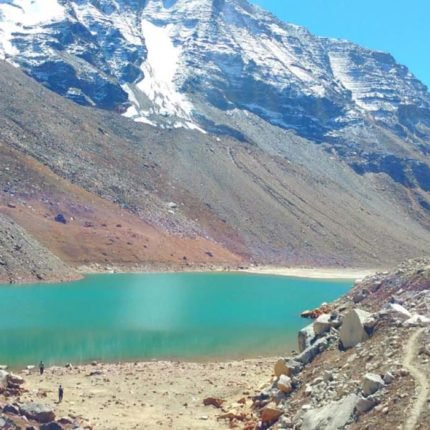
Kedartal Trek
Kedartal Trek is The Source of River Kedar Ganga
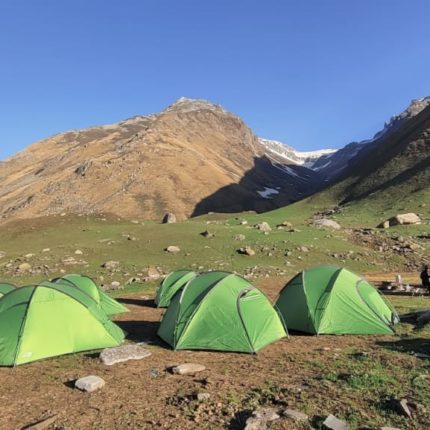
Buran Ghati Trek
Buran Ghati pass is a Adventures Trek or pass in Himachal Pradesh-2024
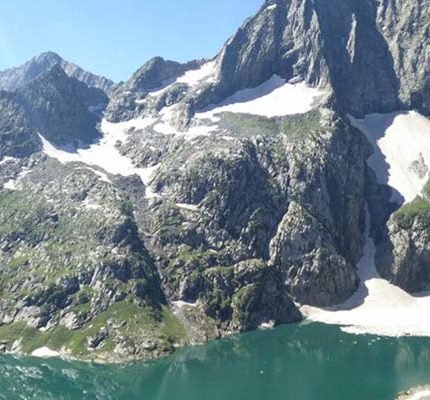
Rohil Basmai Valley Trek
The Rohil Basmai Valley Trek is a versatile trek in Kashmir..
Price: ₹ 14,500.00
Book the tour
Send a quick enquiry.
- Overview Itinerary Dates Include/Exclude
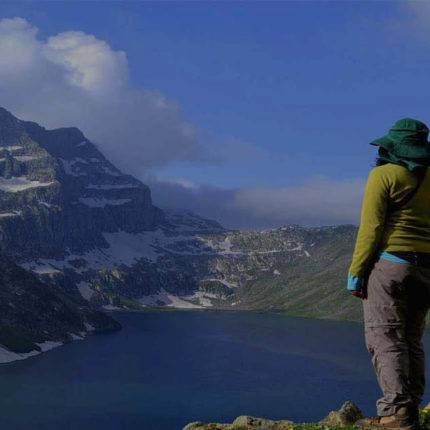

Home » Shop » Tarsar Marsar Trek
- getting there
- detailed itinerary
- cost inclusions
- CANCELLATIONS
- Submit to know Tarsar Marsar trek details
- 1 Week trek
- Jammu Kashmir
- Kashmir Valley Treks
- Moderate Grade Treks in Himalayas
- Monsoon Treks
Tarsar Marsar Trek:
Tarsar Marsar is a fascinating trek in the Kashmir valley that is gaining increasing attention from trekkers. Whether you take a break beside the secluded alpine lakes or walk along a pretty river, green meadows with wildflowers and wide swathes of green – makes this trail a special one during July and August.
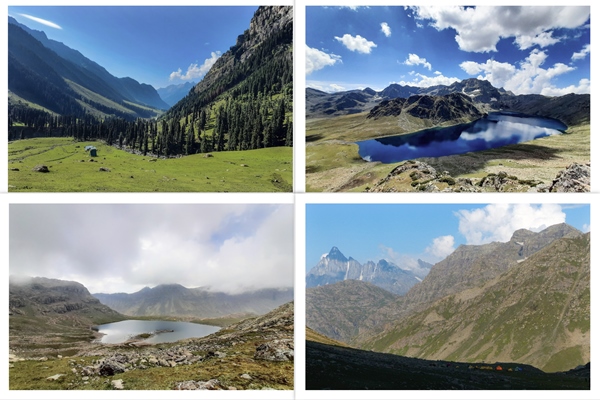
If you see the trail map below, our trek base camp is Aru, one of the upper valleys ahead of the famous Pahalgam town. From here, we will follow the picture perfect Lidder River for a day along cedar and conifer forests to camp at Lidderwat, one of the most beautiful campsites in Kashmir. This place is a broad opening in the valley and the confluence of two streams, one coming from Tarsar and the other from Kolahoi glacier, to form the Lidder River. Henceforth, we will get into the one-side valley that leads us to Tarsar through the meadows of Sekhwas.

Brief Itinerary:
Day 1: Start from Srinagar (or airport) latest by noon and drive to Aru (~ 2440 m/8000 ft) via Pahalgam – 110 Km – 4 hours. Twin sharing tent accommodation. Day 2: Trek from Aru to Lidderwat (~ 2800 m/9180 ft) – 10 Km – 5/6 hours. Camp. Day 3: Trek from Lidderwat to Shekwas camping ground (~3380 m/11100 ft) – 6 Km – 4/5 hours. Day 4: Trek from Shekwas to Tarsar lake (~ 3800 m/12465 ft) – 5 Km – 4 hours. Explore around. Camp. Day 5: Trek from Tarsar to Sundersar (~ 3950 m/12950 ft) via Sonamous/Tarsar Pass (~ 4000 m/13120 ft) – 5 Km – 3/4 hours. Camp. Visit Marsar lake (~ 3960 m/13000 ft) in the afternoon and return to camp (2 hours). Day 6: Trek down to Lidderwat (~ 2800 m/9180 ft) via Shekwas – 14 Km – 6 to 7 hours. Camp Day 7: Lidderwat to Aru (~ 2440 m/8000 ft) – 10 Km – 4 hours – Drive to Srinagar – 110 Km – 4 hours. You will reach Srinagar city by 8 pm. Accommodation on your own. Day 8: Fly out of Srinagar
Important Notes on itinerary:
Carefully read the following points so that you can arrange your tickets and understand the estimated additional expenses outside the TREK FEE.
- You need to reach the latest by 12 noon on Day 1 in Srinagar. After the trek you will return to Srinagar on Day 7 by 8 pm . Arrange your tickets, and stay in Srinagar accordingly.
- We will arrange a shared transportation from Srinagar (from the airport or city centre, TRC) to basecamp Aru and return, The fare is ₹ 5000 one way (Tata Sumo, 5 to 6 sharing). You pay the driver directly, sharing equally with the other team members. Or else you may reach independently to Aru.
- Cost of Mandatory reserve day, i.e. Day 8 is NOT included in the TREK FEE. If we use this during trekking, you need to pay an additional ₹ 2500 per person . This will be collected at Aru.
- If we don’t use the reserve day then you will be back to Srinagar on Day 7 evening. You may take a Shikara ride on Dal Lake, houseboat stay etc in Srinagar.
- Note that prepaid sim cards do not work in Kashmir.
Tarsar Marsar trek map:
Here is a 3D satellite view of the Tarsar Marsar trail.
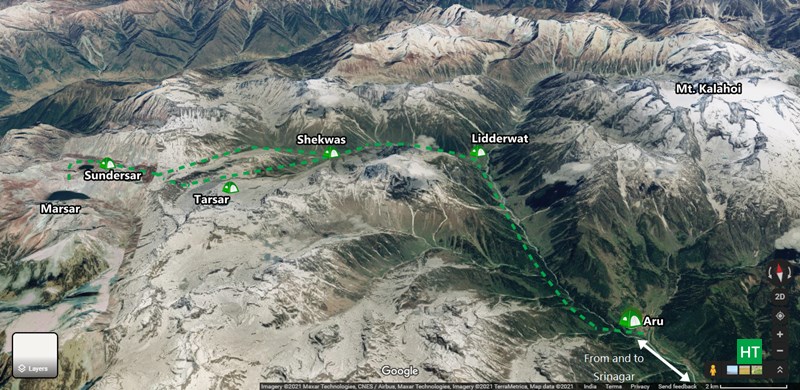
Distance & Altitude profile of the trail:
Below is an indicative profile of the trekking trail. This will give you an idea of the relative gradient (steepness of ascent or descent) of the trekking trail from one campsite to another. Note that you will get more undulations (ups and downs) on the actual trail.
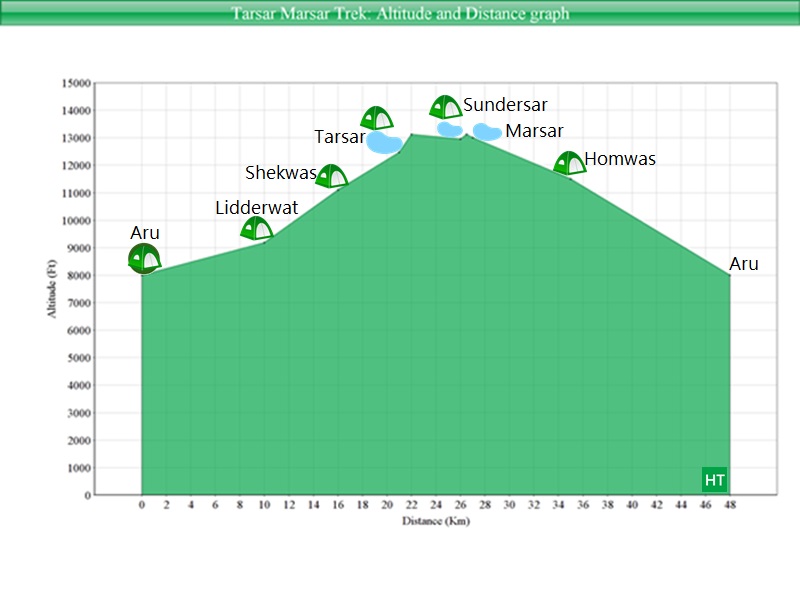
Is this trek suitable for beginners?
Yes, as a first timer you can comfortably complete this trek, provided:
- You are living a healthy and active lifestyle.
- Have a decent amount of physical fitness to endure 5/6 hours of hiking everyday with your backpack. Do check the guidelines to prepare and improve your fitness for treks so that you are comfortable on the trail.
- Proper guidance and logistical support for the trek.
- Assistance with some personal clothing and gear.
The trail reaches a highest point just above 13000 ft which is not very high considering the Himalayas. But if you have struggled to acclimatise in any of your prior high altitude tours (e.g. Rohtang Pass, Leh/Ladakh or Lahaul/Spiti etc.) then you need to be careful. Do consult with us @ 9836133166/9831112469 or shoot an email to [email protected] .
What is the best season for Tarsar Marsar trek? What would the weather be like?
Season time for Tarsar Marsar trek is between late June to late September. The main essence of Kashmir valley , the gushing brooks, verdant meadows with wildflowers are best viewed during July and August.
After mid September green meadows will change to yellowish. From October as the autumn sets in, the weather will be cold. You will see some autumn foliage in giant Chinar trees, which is a cousin of Maple.
Now let us look at some weather data for the Pahalgam area. Our trek starts 10 Km further up and through the upper valleys of Pahalgam. As a result temperatures will be less and so will the rain in general.

As you can see from the above chart temperature remains on the warmer side of the scale and it is conducive for trekking between July to September. Tarsar and Sundersar camps are our higher camps, so these places will be coldest in the course of your hike.
Expect and prepare for a minimum temperature of 0° to 5°C at Tarsar or Sundersar campsites, with some windchill. Usually minimum temperature is attained late in the night/early morning time. At the same time it will be 5°-6°C warmer inside the tent than that of outside.
Will it be raining during Jul-Aug?
Technically there is no “monsoon wind” in Kashmir valley. As you can see from the above chart, main rainfall occurs between January to April due to western disturbances. At the same time it does rain in July and August as well.
Expect some rains, rain showers, afternoon showers/thunderstorms usually not lasting more than an hour. This type of showers are common on mountains but rarely incessant daylong rains. Your trek is for 6 days, so expect rain on some of these days. So carrying a waterproof layer is a must for all.
What type of clothing should I bring for this trek?
It is important to carry proper clothing on this trek. Three layers of clothing are recommended at the campsite in the early morning or evening while you are outside your tent.
- Base layer (moisture-wicking layer; use synthetic and avoid cotton): A quick-dry base layer (dry-fit t-shirt, half or full sleeves) & trekking pants (synthetic, preferably quick-dry, and some wind- or water-proof material is useful)
- Mid layer (warm clothing): Usually a warm jacket (synthetic, hollow fibre, fleece, or down jacket, etc.), but you may use combinations of layers as well (e.g., a light jacket + hoodies + a sweater or a thermal, which you may already have with you).
- Outer layer (weatherproofing): a windproof and waterproof jacket with a hood is best, or a poncho or raincoat.
Note that we don’t have any gear renting facilities, although at some bases, you may get a few on the spot. You may read our opinion on whether should you buy or rent your trekking gear to get a broader understanding.
Check a comprehensive List of things to carry in a himalayan trek or download the PDF. Also read how to choose right trekking gear before purchasing any gear.
How to reach trek basecamp (Aru near Pahalgam):
Our trek basecamp Aru is an offbeat tourist destination 10 Km ahead of famous Pahalgam. It takes between 3 to 4 hours to reach Aru from Srinagar covering around 110 Km distance. Trek’s end point is also Aru. Here is the road map to reach basecamp and the surroundings to give a broad idea of your destination.
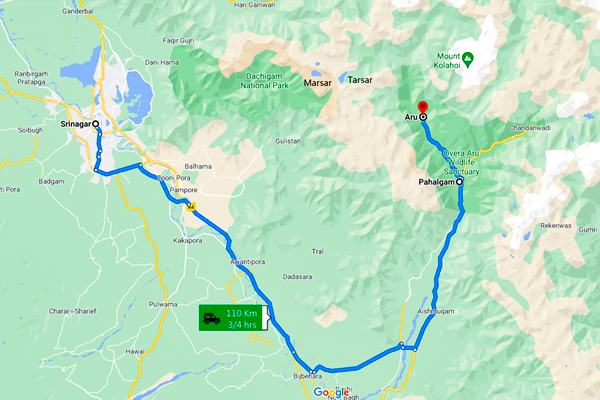
We will arrange a car pick up from the Srinagar airport to basecamp Aru and return to Srinagar. A Toyota Innova charges ₹ 4500 one way (4 to 5 people can seat), one way . You pay directly to the driver sharing equally.
Most convenient way to reach Srinagar is via flight. Sheikh Ul-Alam International Airport in Srinagar (Code: SXR) is around 10 Km away from the city centre.
Otherwise, the nearest railway station is in Jammu (Station Code: JAT) and it takes around 10 hours to reach Srinagar, covering ~ 280 Km.
COVID Update and guidelines 2022:
1) Carry either a fully vaccinated certificate or a RT-PCR negative test report not older than 72 hours. 2) General COVID social distancing and hygiene are to be followed in the lodge/homestay/hotel, especially in the common areas. Carrying masks and sanitisers are a must.
Why treks with HT?
Duration: 6 days of trek; Srinagar to Srinagar in 7 days. Adding a mandatory buffer day it is 8 days, Srinagar to Srinagar.
Prerequisite: Prior trekking experience is nice to have. Good physical fitness is always desired in any trek.
Highest Point: Tarsar ~ 3800 m/12465 ft, Marsar ~ 3960 m/13000 ft, Sundersar ~ 3950 m/12950 ft.
Grade: Moderate
Physicality: 6/10
Length: 50 Km
Seasons: July to September
Further Option: From Naranag drive to Sumbhol and trek to Tarsar and Marsar
Access: Trek starting point is Aru near Pahalgam, 110 Km from Srinagar
Rail station: Jammu Tawi (STN Code: JAT)
Airport: Srinagar (Code: SXR)
Upcoming scheduled dates for KGL trek:
- You can check the scheduled Fixed Departure dates in the calendar available inside Booking Form or inside REGISTER NOW form. Tour starting Dates are highlighted as per our itinerary (Day 1 of 8 days itinerary) .
- At present BOOK NOW functionality is disabled . You can get all the information in your email by submitting the REGISTER NOW form.
- If you are a group of people and available dates are not matching then you may select Custom date mode (by clicking the Select your custom date) and fill in the displayed form.
- You can also check all the available dates at a glance in our TREK CALENDAR .
- Trekkers need to reach Srinagar on Day 1 by 12 noon. Return to Srinagar on Day 7 evening by 8 pm. Arrange your tickets for inward journey and return accordingly.
Getting to Aru (The trek base):
We will arrange a car pickup from Srinagar to Aru and return. This will be shared equally by the availing team members.
The best option to reach Srinagar is by flight. There are direct flights from Delhi and other major cities.
By train one has to reach Jammu and then a drive to Srinagar takes around 12 hours covering approximately 300 Km.
TREK FEE: ₹ 15,500 per person (Aru to Aru) + 5% GST
Inclusions:
All meals during the trek (vegetarian with occasional serving of eggs) including breakfast, hot/packed lunch (carry your lunch box), light refreshment/soup in the evening and dinner. Tea will be served in the morning and evening.
All accommodation in tent during the trek on a twin sharing basis.
Professional Guide, Cook & Helper.
Porters/Packed animals to carry the central logistics.
Camping equipment like Sleeping bag, Carry mattress, Dining tent, Toilet tent, Gaiters, Micro spikes/Crampon.
Permit fee, camping charges, forest levy as required in the trek.
Basic Medical & First Aid kit.
Travel and Medical Insurance Policy covering high altitude trekking tours (For Indian nationals it is included in the TREK FEE, up to 60 years of age). It covers your trek as well as your itinerary for a duration of 7 days.
Exclusions:
Transportation from Srinagar airport to trek base Aru and return. ₹ 5000 one way for a Tata Sumo and can accommodate 5 to 6 persons.
We assume that you will carry your Rucksack/Backpack including all your personal belongings. If you prefer to offload your bag and carried by our horse/porter then an additional Rucksack offloading charge of ₹ 2500 is to be paid directly on spot for the entire duration of the trek. One such rucksack should weigh within 10 kg.
Any tip or gratuity to the HT support staff.
Anything which is NOT mentioned in the “Inclusions” or personal in nature.
- We assume that you have read and understood our “ Terms & Conditions ” before Booking a trek/tour.
- To reserve your place in a scheduled Fixed Departure trek or a Customised/Private trek pay 25% of the Trek/Tour Fee as the initial “Booking Deposit” . You can pay by Net banking/Draft/Cheque/Credit/Debit cards. This will ensure your participation in the desired trek and we will reserve your place in the scheduled date. You need to pay the remaining amount at least 15 days before Trek Starting Date .
- If you book a Trek/Tour before 14 days or less from Trek/Tour Starting Date, you need to pay the full Trek/Tour Fee .
Cancellations:
- “Booking Amount” i.e. 25% of the Trek/Tour Fee is Non-Refundable at any stage.
- If in case you are not able to make it due to unavoidable reason(s), we provide you a very flexible choice of Shifting to another trek within next one year . One year is counted from the starting date of the trek/tour you booked initially with us.
- In case you postpone your trip you need to inform minimum of 15 days before the trek/tour starting date. (Though we suggest to inform us earlier if known)
- In case you postpone a trek/tour before 15 days of the scheduled Trek/Tour Starting date or prior , you may shift to another group of the same trek/tour scheduled in the same season or within next one year. You may shift to another suitable route also. For changing any, you need our approval first. Your request must be in written communication through your registered email with us.
- If you cancel/postpone a trek/tour from 14 days to 8 days before tour starting date , your Booking Amount is Non-Refundable. We will not take any request of shifting dates. We will charge 50% of the amount as Cancellation Charges and process refund of remaining 50%. You may also shift to another group within next year but 25% Booking Amount will be deemed as Cancellation Charge and the rest amount will be transferred to the shifted group.
- If you cancel a trek/tour 7 days (i.e. a week) before Trek/Tour Starting Date or later , there will be NO REFUND.
- In case of any unforeseen incident including but not limited to natural calamities like flood, earthquake, landslide, forest fire or any political unrest, if we are compelled to cancel the trek/trip, you will be entitled to redeem the full amount for the same/similar kind of trek/trip within next one year.
If you need more clarifications write in to [email protected]
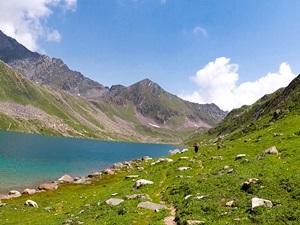
Tour Reviews
There are no reviews yet.
Leave a Review
Cancel reply.
You must be logged in to post a comment.
You May Also Like
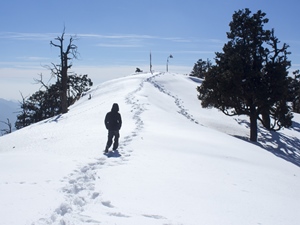
Nag Tibba Trek
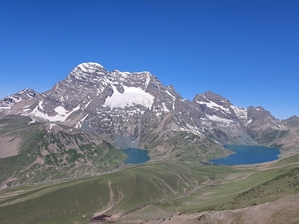
Kashmir Great Lakes Trek
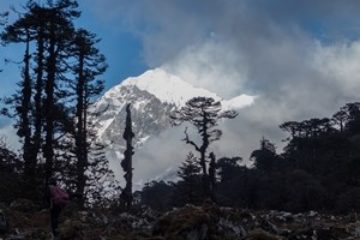
Goecha La Trek
Submit this form that we can email you all the necessary details and call you to discuss., tour starting date: green boxed dates indicate starting of a scheduled fixed departure tour (day 1 of our tour itinerary). please check the calendar and choose a suitable fixed departure date (green boxed) unless dates are not matching or you are looking for a customised/private trip., i accept the terms & conditions.

An Alternative to the Kashmir Great Lakes Trek
Tarsar marsar trek 2023.
May, June, July, August
₹14499+ 5% GST
“not all those who wander are lost.”, tarsar marsar trek, aru to aru, + rs. 2250 backpack offloading + rs. 1600 srinagar to srinagar (transportation) + rs. 1800 single tent accommodationack offloading, difficulty level - 4, kashmir - 9 days - 46 km, up to 15% off in may-jun batches for a limited period ✨, june, july august & sept 2023.
The Tarsar Marsar Trek is a popular 7-8 day trek in Jammu and Kashmir that takes you through some of the most stunning landscapes in the region. The trek starts from the Aru Valley and takes you through beautiful alpine meadows, dense forests, and scenic high-altitude passes before reaching the Tarsar and Marsar lakes.
The Tarsar Marsar Trek is famous for its stunning natural beauty, including two beautiful alpine lakes - Tarsar Lake and Marsar Lake. The lakes are situated at an altitude of over 3,700 meters and are surrounded by snow-capped mountains, lush green meadows, and dense forests, making for a picturesque setting.
The trek also takes you through some of the most beautiful landscapes in the region, including the Aru Valley, Lidderwat, and several high-altitude passes, offering breathtaking views of the surrounding mountains.
In addition to its natural beauty, the Tarsar Marsar Trek is also known for its moderate difficulty level, making it accessible to both beginners and experienced trekkers. The trek can be completed in 7-8 days, making it a perfect getaway for those looking for an adventure in the outdoors.
Overall, the combination of stunning natural beauty, moderate difficulty level, and accessibility make the Tarsar Marsar Trek a popular and highly recommended trekking destination in Jammu and Kashmir.
Itinerary of Tasar Masar Trek
Here's a detailed itinerary for the Tarsar Marsar Trek:
Day 1: Arrival in Srinagar Arrive in Srinagar and meet your trekking team. You will be transferred to the Aru Valley, which is the starting point of the trek. The drive to Aru Valley takes around 4-5 hours. Overnight stay in Aru Valley.
Day 2: Aru Valley to Lidderwat (9 km trek, 5-6 hours) After breakfast, start the trek to Lidderwat. The trail passes through lush green meadows and dense forests. You will cross the Lidder River and reach the campsite in Lidderwat. Overnight stay in Lidderwat.
Day 3: Lidderwat to Shekwas (11 km trek, 6-7 hours) Today's trek is a gradual ascent, taking you through dense forests of pine and fir trees. You will pass by several streams and reach the beautiful meadow of Shekwas. Overnight stay in Shekwas.
Day 4: Shekwas to Tarsar Lake (6 km trek, 3-4 hours) After breakfast, start the trek to Tarsar Lake. The trail takes you through a steep climb and offers stunning views of the surrounding mountains. Once you reach Tarsar Lake, enjoy the scenic beauty of the lake and the surrounding meadows. Overnight stay near Tarsar Lake.
Day 5: Tarsar Lake to Sundarsar Lake (7 km trek, 5-6 hours) Today's trek takes you to another beautiful lake, Sundarsar Lake. The trail passes through a rocky terrain and offers stunning views of the Tarsar Lake. After a gradual climb, you will reach Sundarsar Lake, surrounded by snow-capped mountains. Overnight stay near Sundarsar Lake.
Day 6: Sundarsar Lake to Marsar Lake (8 km trek, 6-7 hours) Today's trek is a challenging one, as you will have to cross a high-altitude pass, the Zach Pass (4,200m), to reach Marsar Lake. The pass offers panoramic views of the surrounding mountains and glaciers. After crossing the pass, you will reach Marsar Lake, which is another stunning alpine lake. Overnight stay near Marsar Lake.
Day 7: Marsar Lake to Homwas (12 km trek, 6-7 hours) Today's trek takes you through a gradual descent, passing through beautiful meadows and forests. You will cross several streams and reach the campsite in Homwas. Overnight stay in Homwas.
Day 8: Homwas to Aru Valley (12 km trek, 4-5 hours) Today is the last day of the trek. After breakfast, start the trek back to the Aru Valley. The trail passes through lush green meadows and forests, and you will cross several streams before reaching the Aru Valley. From there, you will be transferred back to Srinagar. Overnight stay in Srinagar.
Day 9: Departure from Srinagar After breakfast, check out from the hotel and depart from Srinagar with wonderful memories of the Tarsar Marsar Trek.
Note: The itinerary is subject to change depending on weather conditions, group size, and other factors.
What's Included
Meals during the trek
Forest Permits/Camping Charges/Permits, Trek Permit Fee/IMF Permission (Upto the amount charged for Indian nationals)
Camping tents, Temp rated sleeping bags, mattress
Safety Equipment includes static rescue rope, seat harness, carabiners, pulleys
Mountaineering course certified Trek Leader with Wilderness Emergency Responder &
Rescue. course from NIM UttarkashiFirst Aid Certified Local guide, cook, helpers Porters or mules for carrying common luggage
What's Not-Included
Meals during road journeys
Any kind of Insurance
Any expense of personal nature
Portage of personal backpack
Any expense not specified in the inclusion listTransportation to and from Srinagarnd of
Mules or porters to carry personal luggage
Anything not specifically mentioned under the head Inclusions
Inner Line Permit Fee
Essentials to carry
If you're planning to go on an expedition to Kalindi Khal, which is a high-altitude trek in the Indian Himalayas, here are some essential things that you should carry with you:
Trekking Gear: Good quality trekking shoes, trekking poles, backpack, and headlamp with extra batteries.
Clothing: Warm, comfortable, and lightweight clothing that is suitable for high-altitude trekking. This includes thermal wear, a fleece jacket, windcheater, raincoat, trekking pants, gloves, and a hat.
Sleeping gear: A good quality sleeping bag that can withstand sub-zero temperatures, and a sleeping mat or inflatable mattress.
First Aid Kit: A well-stocked first aid kit with essential medicines for high-altitude sickness, pain relief, diarrhea, and other common ailments.
Food and Water: Carry sufficient food and water for the entire trek, and carry a water purification system or tablets to purify water from streams and rivers.
Navigation equipment: Maps, compass, and GPS device.
Sun Protection: Sunglasses, sunscreen, and lip balm.
Personal Items: Camera, phone, power bank, toiletries, and any personal medication that you might need.
Emergency Supplies: Emergency whistle, rope, knife, and a firestarter.
It is always recommended to do proper research and take advice from experienced trekkers or tour guides before embarking on a high-altitude trek like Kalindi Khal.
Footwear Non-skid, deep-treaded, high-ankle trekking shoes Qty -1 Pair of light weight Slipper/Sandals Qty -1
What is the difficulty level of the Tarsar Marsar trek?
The Tarsar Marsar Trek is considered to be a moderate-level trek. The trek involves walking for 7-8 days with an average trekking distance of 10-12 km per day, which requires a decent level of physical fitness.
The trail involves some steep ascents and descents, rocky terrain, and crossing streams, which may require some level of hiking experience. Additionally, the trek involves crossing a high-altitude pass, the Zach Pass, which is challenging but can be easily crossed with proper acclimatization and physical fitness.
However, with proper preparation, a good level of fitness, and following the instructions of the trekking team, the Tarsar Marsar Trek can be a wonderful and enjoyable experience for both beginners and experienced trekkers alike.
What is the budget for the Tarsar Marsar trek?
The budget for the Tarsar Marsar Trek can vary depending on a number of factors such as the trekking season, the duration of the trek, the size of the group, and the level of services required.
On average, the cost for the Tarsar Marsar Trek can range from INR 12,000 to INR 25,000 per person, which includes the cost of food, accommodation, trekking permits, transportation, guide and porter charges, and other miscellaneous expenses.
It's important to note that the cost may vary based on the level of services and amenities provided during the trek, such as luxury camps, private transportation, or additional activities. It's recommended to research and compare prices from multiple trekking companies and choose one that offers good value for money while also ensuring safety and quality services during the trek.
Is Tarsar Marsar safe?
Tarsar Marsar Trek is generally considered safe as long as certain precautions are taken and safety guidelines are followed. Here are some of the safety measures to keep in mind while trekking on the Tarsar Marsar Trek:
1. Trek with a reputable and experienced trekking company or guide who can provide you with the necessary equipment, support, and guidance throughout the trek.
2. Acclimatize well to the altitude and take regular breaks to avoid altitude sickness.
3. Stay hydrated and carry enough water with you during the trek.
4. Be mindful of the weather conditions and carry appropriate clothing and gear for the changing weather.
5. Avoid trekking alone and always stick with the group.
6. Follow the trekking rules and regulations set by the local authorities.
7. Stay updated on the current situation and any possible risks or threats in the region.
While the Tarsar Marsar Trek is generally considered safe, it's always important to be cautious and take necessary safety measures to ensure a safe and enjoyable trekking experience.

Tarsar Marsar Pahalgam Trek
Introduction.
The Tarsar-Marsar Trek is a best alternative and most beautiful than its sibling Great Lakes trek. The trek expedition lies in the remote valley of Aru in Lidder Valley. The Tarsar-Marsar as the name suggests treks to the twin lakes of Tarsar and Marsar. The lakes are separated by a mountain.
The route of the Tarsar Marsar trek lies under the towering height of the highest mountain peak of Kashmir, Mount Kolhoi (5400M). It crosses streams, plenty of colorful meadows. Tarsar Marsar trek route falls within the boundaries of Overa-Aru Wildlife Sanctuary. Long tailed marmots are seen through out the trek, with a rare possibility of a sight of Himalayan Brown bears high up in the meadows.
Though trekking in Kashmir is not the newest but still this expedition is no walk in the park. Arduous days, steep and rocky passes, and altitudes approaching 4000m all collide to create a challenging trek in one of the most beautiful and serene Himalayas of Kashmir.
While planning your trek, as a beginner keep the following points in consideration:-
- you feel fit enough to trek for hours.
- you walk two or three kilometers daily.
- you don’t have any breathing problems.
- you are not scared of heights.
High Altitude Precautions PDF
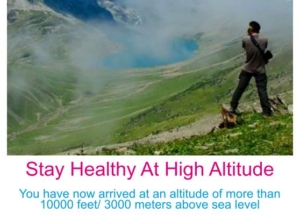
What’s included in the Price?
Twin sharing; 2 persons in a 3-man-tent
Tents (twin sharing), dining and kitchen tent, toilet tents, sleeping bags and mats. Trekking poles (1 per person) also included.
Languages; English, Urdu, Hindi and Kashmiri
Trek -4 meals per day (Breakfast, Lunch, Tea snacks, Dinner)
Wildlife Permits
Packed bottled mineral drinking water (2 ltrs per person) on first day of the trek. Boiled drinking water for the rest trek-days
What’s not included in the Price?
Costs associated with a medical incident, such as your evacuation from the mountain and/ or hospitalization (for which you should have travel insurance)
Additional cost of INR 800/Per Person (one way) An Innova Car (6 person occupancy)
Brief Itinerary
Day 1 :- Arrive Aru Valley, Pahalgam
- Arrive Aru Pahalgam (Alt. 2450m)
- Meet our staff for briefings
- Our first campsite Aru Village
(Welcome Tea, dinner at the camp)
Day 2:- Aru to Lidderwat.
- Altitude: 2450m to 28oom
- 9 kms trek, approx 5 hours
(Breakfast, lunch, tea, dinner)
Day 3 :- Liderwat to Sekwas
- Altitude: 2800m to 3350m
- 6 km trek, approx 5 hours
Day 4:- Sekwas to Tarsar Lake
- Altitude: 3350m to 3700m
- 5 km trek, approx 4 hours
Day 5:- Tarsar to Sundersar
- Altitude: 3700m to 3850
- 7 km trek, approx 5 hours trek
Day 6:- Sundersar to Homwas via Marsar
- Altitude: 3850 to 3400m
- 9 kms trek, approx 6 hours
Day 7:- Homwas to Aru
- Altitude: 3400m to 2150m
- 13 kms trek, approx 6 hours
- End of the trek
(Breakfast, Lunch)
Detailed Itinerary
Day 1: – Arrival. Reception at Aru Valley, Pahalgam. On arrival at Aru Valley bus station, our representative will receive you and shift you to the tented campsite where you will be provided with a welcome tea or kahwa. Meet our guide and staff for an introduction and briefing. Aru is the last town with a market before the start of the trek. Dinner at the campsite.
Day 2: – Aru to Lidderwat. A gradual ascent from Aru to Lidderwat covering a distance of 10 km in 6 hours with an altitude gain of 342 m. Look out for two clear streams and a wooden bridge half hour before Lidderwat. We also pass through Nandkei Gujjar nomad settlements across the Lidder river. Once we reach Lidderwat, we can explore the meadows and the clear streams that run through it which is an absolute delightful experience. Camp for the nightstay at Lidderwat
Day 3: – Lidderwat to Sekhwas. While trekking to Sekhwas we gain an altitude of 480 m in 5 hours covering a distance of 6 km. The trail is mostly ascending with intermediate flat grounds and one river crossing en route. After passing through pine forests and some intermittent clearings we will reach wide sweeping grasslands that are formed from the merger of many valleys that converge here. The trail climbs swiftly past a few Gujjar huts to the camping grounds of Sekhwas. Camp for the night at Sekhwas.
Day 4: – Shekwas to Tarsar. It is a gentle climb to Tarsar through tall grasses, a few ridges and finally to the shore of the lake. Tarsar Lake is 5 km above Sekhwas and takes 4 hours with an altitude gain of 518 meters. The turquoise blue water is surrounded by lush meadows and snow capped peaks – this campsite is truly heaven on earth. Camp at Tarsar for an overnight stay.
Day 5: – Tarsar to Sundersar. The trek to Sundersar covers a distance of 5 km in 5 hours with a pass crossing. Some trekkers attempt a trek to Marsar, which is a closed lake set inside a cauldron with steep sides. The trail is a steep ascent in the beginning, followed by a descent and then a final gentle ascent to the beautiful Sundarsar a small lake. Around the lake are long meadow stretches with little sprouting flowers of yellow, blue and white. Sundarsar has big, flat stretches that is a perfect camping spot.
Day 6: – Visit Marsar, and get down to Homwas. The trail initially is a climb to Marsar, which is at an altitude of 4100m. We explore the surrounding meadows, and finally descend to 3400m. The trek covers a distance of approximately 8 km in 6 hours. The Homwas valley is a sharp drop of over 600m, over a series of meadows. Each of these meadows has a little stream that runs down from snow melts and falls down to the meadow below forming a clear pond, before sliding off the cliff as a waterfall. The Homwas valley floor, again, is a breathtaking piece of nature’s art with small streams, brooks and green pastures. Camp for the night at Homwas.
Day 7: – Homwas to Aru. Descend 1370m, and 14 km from Homwas to Aru. An early start will get us to Aru in about 5 hours. The trek ends at Aru where from you can proceed to your next destination. Our guide can arrange transportation to Srinagar or Pahalgam.
What to Carry?
The trek is supported by horses. You will need to carry only a light sack, weighing about 4-6kg for your items like passport, money, and camera gear. The following is a list of the items you should carry on the trek. If you have items that can not be used on the trek, you can store them at our houseboat or our office and take them back after returning from the trek.
- Please note that only postpaid Indian mobile sim cards (Jio, Airtel and BSNL) work in Kashmir Valley. There’s no cellular connectivity from Day 2 to Day 6 of the trek.
- Please double check your passport or Aadhar numbers before submitting through booking form. These numbers are required for preparation of trek permits.
- Passport or a valid ID card
- Duffel Bag 60 liters
- One Pair Trekking Shoes
- One Pair Trail Approach Shoes
- Trekking Pants
- Hooded Rain Jacket
- One Pair Sunglasses
- One Pair Liner Gloves
- Small Size Day-Pack
- Two Pair Trekking Socks
- One Pair Sandals
- Extra Warm Clothes
- Warm Hooded Down Jacket
- Sunscreen Cream
- Any Personal Medication
Kashmir Treks are achievable by anyone with a healthy lifestyle and a good level of general fitness. Team members should be willing to be part of a team working together to achieve the goal of the expedition. As a team member, you should have an adventurous and robust spirit. The biggest challenge on this expedition will be the many consecutive days of challenging trekking across alpine terrain, much of which at altitudes of above 3000m.
Minimum fitness requirements
- Trek: up to 7km per day.
- Daily activity: up to 5 hours’ trekking per day.
- Carry: up to 5kg in a day-sack.
- Terrain: remote, uneven, snowy, icy, rocky, sometimes exposed terrain at up to 4200m.
- Climate: Can be sunny in valleys and cold and windy at high altitudes. June and September months are cooler than those of July and August. Averages are 3000m, 1°C to 20°C.
- Swim: not required though there will be stream crossings to make.
Address Info
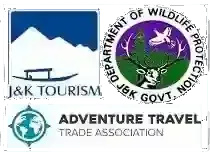
Testimonials

Kashmir Treks on TripAdvisor 5 out of 5 based on 148 reviews.
GET IN TOUCH
Useful links.
.png?w=auto&h=400)
Tarsar Marsar Trek
Tarsar marsar trek overview.
Kashmir, rightfully proclaimed as ‘heaven on Earth’, is a land of pristine mountains, verdant meadows, azure lakes, and breathtaking natural splendour. It is also home to some of the most spectacular treks in the lap of Himalayas, the most popular of which is the Tarsar Marsar Trek. Perched on the high altitude of 13,201 feet, the Tarsar Marsar Lake Trek offers an outstanding trekking experience to all adventure seekers and nature lovers. This trek includes mind blowing trails as well as three alpine lakes named Tarsar, Marsar, and Sundarsar. While trekking, you get an opportunity to walk around the whole circumference of Sundsarsar and Tarsar lakes, witnessing the remarkable phenomena of their changing colours from every angle.
Besides its spectacular mountain and lake vistas, Tarsar Marsar Lake Trek is known for its majestic trails that lead you over the lush green meadows of Kashmir and provide excellent views of the stunning Chinar tree forest. During this trek, you may also see the glacial river Lidder as well as other rivers like the Alaknanda and Bhagirathi as they descend to the lower plains. The finest aspect of the Tarsar Marsar walk is that everyone may partake in this wonderful experience because it is not physically demanding and offers breathtaking vistas of Kashmir at virtually every step.
Book Tarsar Marsar Trek Package
Tarsar marsar trek, jammu and kashmir, quick facts of tarsar marsar trek.

Maximum altitude: 13,201 feet
Grade: Easy to Moderate difficulty level
Duration: 7 days/ 6 nights
Trekking distance: 47 kms
Trail type: One way. Tarsar Marsar lake trek begins and ends at Aru.
Rail head: Jammu railway station
Airport: Srinagar airport
Snow Season: Relatively more in June
Service from: Srinagar to Srinagar
Base camp: Aru (approx 4 hr drive from Srinagar)
Best season: Monsoon treks between the months of July and August
Region: Jammu and Kashmir
Who can participate:
Individuals over the age of ten.The walk is open to newcomers, although prior experience is preferred.The trekker should be able to carry a backpack weighing 10 to 15 kg.Travellers must be physically healthy and have the stamina to complete at least four kilometres in 30 minutes without stopping.
Detailed Itinerary of Tarsar Marsar Trek

Srinagar to Aru
Altitude: 7,958 ft (2,426 m)
Duration: 3.5 hours drive.
- The Tarsar Marsar trek commences from Aru base camp which is around 112 km from Srinagar.
- To ensure that we reach the base camp before nightfall, we will leave from Srinagar around 2 PM.
- On our way to Aru base camp , we will stop at the scenic Pahalgam which is 100 km away from Srinagar and 12 km from Aru.
- The journey to Aru base camp is breathtaking as this hamlet is located on the banks of the glacial river Lidder and includes a stretch of 200 asbestos-roofed cottages perfectly arranged among the lush green meadows of Kashmir.

Aru to Lidderwat
Altitude: 7,958 ft to 9,131 ft
Duration: 6 hours, 10 km
The second day of the Tarsar Marsar lake trek takes you upward from Aru base camp to Lidderwat.
The initial track follows the Lidder River, which links to the uphill village and leads into a dense tangle of Fir trees.
After passing through the conifer forest, you will arrive at Dalla, a huge clearing dotted with various Gujjar homes followed by a deep pine forest and Nandekai village.On the route, you will come across numerous clear valley streams with clean drinking water.
After another one-hour walk, you will arrive at Lidderwat and be rewarded with breathtaking views of green fields and mountains.

Lidderwat to Shekiwas
Altitude: 9,131 ft to 11,039 ft
Duration: 5 hours, 5.6 km
- The trek from Lidderwat to Shekiwas is quite simple because the entire trail is set out in a straight line and is shaded by lovely pine trees.
- The pine forest gives way to a beautiful grassland set between high mountains and a peaceful valley.
- There are numerous clean streams throughout the path where you may replenish your water bottles.
- As the path continues, descend to Hamvas, where you may take a quick stop at the Gujjar huts before climbing to the silver birch or Bhoj tree forest.
- The third day's journey concludes in Shekiwas, one of the best camping spots on the Tarsar Marsar trek.

Shekiwas to Tarsar
Altitude: 11,039 ft to 12,449 ft
Duration: 3-4 hours, 5 km
- Day four begins from the Shekiwas campground and follows a snake-like trek across the grassland until landing at Sumbal.
- Two hours later, after passing through some spectacular views from various ridges in line, you will arrive at a conical highland. Here, you can catch a glimpse of the first lake of the trek- Tarsar. It is a beautiful almond-shaped lake that turns turquoise blue in the evening, shimmering like precious stones amidst the snow-covered mountains.
- After crossing the stream, you will arrive at Tarsar grassland, the campsite for day four of the Tarsar Marsar Trek.

Tarsar to Sundersar
Altitude: 12,449 ft to 12,946 ft
Duration: 5 hours, 5 km
- Day five of the trek leads you to Sundersar valley through Tarsar pass.
- On the ascent to the valley, you will come across the Bakkarval shelters situated on the left side followed by lush green grasslands, streams and a big glacial pond.
- After a 30-minute walk, reach the end of the meadow, cross a brook, and ascend the mountain via a stunning narrow valley.
- Along the way, you'll pass across a large meadow filled with colourful flowers in full bloom.
- Following the route will bring you to the grassy plains of Sundersar Lake, where you may pitch your tents and camp in the tranquil beauty of Kashmir.

Visit Marsar and go to Homvas
Altitude: 12,946 ft to 13,201 ft (Marsar Ridge) to 11,500 ft
Duration: 7 hours, 9 km
On day six, we will hike along the boulder-smitten trail to the Marsar Ridge.
We'll arrive at the pass in about 30 minutes, which opens out into a beautiful grassland with lovely pathways heading downhill to flat plains.
Cross the little streams that run over the flat terrain to climb the Marsar ridge. The views of Marsar Lake from here are breathtaking.
After admiring Marsar's magnificence, begin your 40-minute descent to Sundersar Valley and return to Jagmargi Valley.
Rather than ascending Tarsar Pass, take the alternate trail to Shekwas, which is only a 30-minute walk to Homvas.

Homvas to Aru. Drive to Srinagar
Altitude: 11,500 ft to 7,958 ft
Duration: 6 hours, 13 km
On the last day of Tarsar Marsar trek, descend from Homwas to Lidderwat.
En route, you will catch some beguiling sights that testifies the natural beauty of Kashmir.
You may also spot the magnificent Kolahoi glacier on your way down to Lidderwat.
After crossing the Lidderwat pine forest, take a short break before beginning your 4 hr journey to Aru base camp.
From Aru, you can drive to Srinagar, bidding adieu to this beautiful trekking adventure.
What to Pack for Tarsar Marsar Trek?

- Backpack (50l- 60l): Get a good quality backpack with comfortable shoulder straps and rain cover.
- Trekking shoes: Wear comfortable and waterproof high ankle trekking shoes with good grip.
- Thermal Inners: The temperature at high altitudes is very low and hence, it is recommended to be fully equipped with necessary warmers, sweaters, and full sleeve shirts.
- Jackets: Carry a heavy, windproof and fleece jacket to remain warm and comfortable during Tarsar Marsar trek in October.
- Caps: Bring a sun cap and a woollen cap to protect yourself from the sun and the cold weather.
- Water Bottles: Carry two reusable water bottles of 1 ltr each to remain hydrated throughout the trek.
- Personal medical kit: For emergencies, bring a personal medical kit with all the necessary medications and band-aids.
- Trekking Pole: Bring at least one trekking pole for ease of movement and stability while trekking.
- Gloves: Bring two pairs of waterproof hand gloves.
- Toiletries: Carry essential toiletries like sunscreen, sanitizer, toothbrush, tooth paste, cold cream, toilet paper and wipes.
- Torch: A torch with extra batteries is always useful on a trek.
- Sunglasses: Sunglasses with U/V protection are effective in guarding your eyes from the Sun.
Know Before You Go Tarsar Marsar Trek

By Flight - Srinagar is well-connected to all the major airports of the country, including Delhi and Mumbai. If you plan to travel by air, book a flight to Srinagar airport from anywhere in the country and reach the pick up point in the city via a cab.
By Train - Alternatively, trekkers can travel to Srinagar via train. You can either choose to travel to Jammu railway station (260 km away) or Udhampur railway station (200 km away).
By Bus - You can reach Srinagar bus stand from any major city in the state and nearby areas. From Jammu, the bus ride takes approximately 7h 20 mins.

Srinagar- Pahalgam- Aru- Lidderwat- Shekiwas- Tarsar- Sundaresar- Marsar- Homvas- Aru- Srinagar.
The Tarsar Marsar trek begins with a drive from Srinagar to Aru, with a halt at Pahalgam en route. The climb from Aru to Lidderwat takes place on day two. The third day takes you from Lidderwat to Shekiwas. The most exciting day is day four, when you travel to Tarsar and view the stunning Tarsar Lake. On day five, you begin your journey at Tarsar and end it at Sundersar Lake.Trekkers continue their adventure from Sundersar to Marsar lake on day six, concluding the day at Homvas. On the final day, you return to Aru and drive back to Srinagar.

Before embarking on any trekking journey, it is critical that all participants remember certain important tips to guarantee a pleasant and enjoyable trek. Though the Tarsar Marsar trek is quite simple, there are a few things you should be aware of in order to properly prepare for the expedition. Following are some useful details regarding Tarsar Marsar lake trek:
Tarsar Marsar lake trek is suitable for beginners and amateur trekkers as it is graded as moderately difficult.
The Tarsar Marsar trek leads you to high elevations of 13,201 ft which might lead to acute mountain sickness among some participants. Hence, carry prescriptions and monitor your oxygen levels regularly.
Carry the necessary amount of cash before starting the trek as there is no ATM service available after Pahalgam. It is recommended to withdraw cash even before reaching Pahalgam as it regularly runs out of cash.
Mobile service is available only till Pahalgam. Hence, make all important calls beforehand.
Electricity is accessible till the Aru base camp. As a result, bring a torch and some batteries with you.
You May Also Book
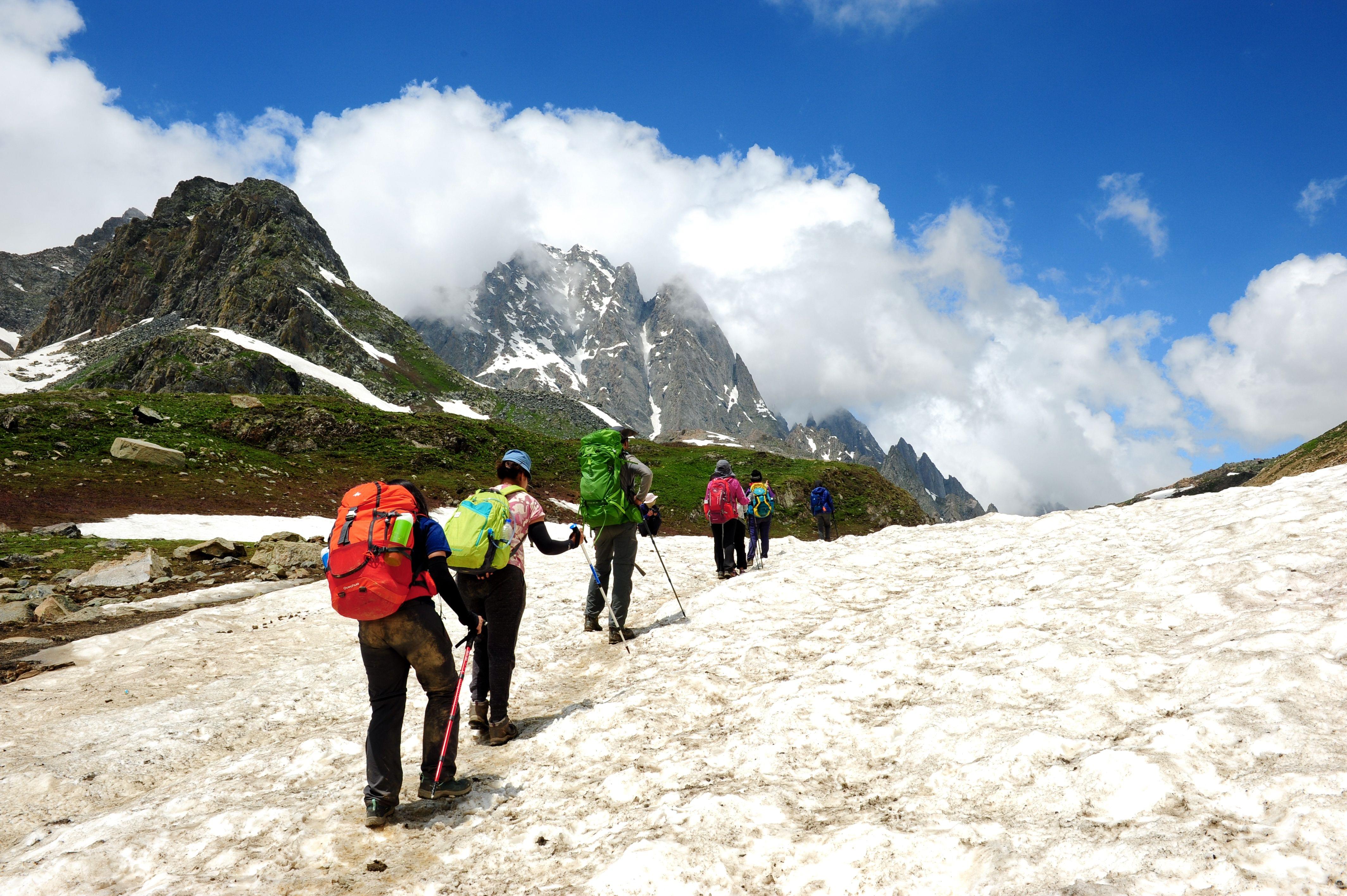
FAQs of Tarsar Marsar Trek
How difficult is tarsar marsar trek.
Tarsar Marsar trek is rated moderately difficult. Hence, even beginners, amateur trekkers, families, and solo trekkers can participate in this trek.
Can a beginner do Tarsar Marsar Trek?
Yes, Tarsar Marsar trek is highly safe and relatively easy trek and is thus, suitable for beginners with no prior trekking experience as well.
How long is Tarsar Marsar Trek?
Tarsar Marsar trek lasts for 7 days and 6 nights and covers a distance of about 47 km.
Is Tarsar Marsar trek open now?
Yes, Tarsar Marsar trek in October is open and high in demand. If you wish to get a seat on the trek, make sure to book your tickets at the earliest.
What is the Best Time to do Tarsar Marsar Trek?
Tarsar Marsar trek is essentially a monsoon trek. As a result, the best time to participate in this adventure is between July and August.
What is the highest altitude of Tarsar Marsar Trek?
The highest altitude of Tarsar Marsar trek is 13,201 ft.
Treks in Himachal
Treks in uttarakhand, weekend treks in india, treks in ladakh & kashmir, treks in nepal, treks in sikkim.
.png?w=auto&h=400)
The content and images used on this site are copyright protected and copyrights vests with the respective owners.
© 2024 www.heyhimalayas.com All rights reserved.
Trek Kashmir
Tarsar marsar lakes trek.
Tarsar Marsar Lake Trek : is one of beautiful cross country alpine lakes trek in vicinity of Lidder valley Pahalgam. The trekking encounters three high altitude glacier fed alpine lakes. The trekking route passes through rugged trails magnificent mountain scenery with wild life flora and fauna of north Indian Himalayas. The trail to the lake is well maintained and very much an alpine lover’s dream. You’ll wind through lush green valleys, pine forest and mountainous snowfields, with each unique landscape eliciting its own wonderment.
Tarsar Marsar Alpine Lakes trek
Don’t expect the whole route to be easy going, though. The hike out will require some work on your part as you switchback through rocky slope. Tarsar is most Scenic Lake in the Pahalgam Alpine Lakes. Hikers will encounter a variety of alpine ecosystems. Ridge top views, and of course the deep blue lake — but not without a steady climb first. The route comes across diversity of Nomadic Shepherd from Aru valley to Sumbal Sonamarg. The Lidder valley is extension point and apparently amazing. It is stacked with pine forests, Mountain peaks, gushing Lidder stream and dales of blossoming plants..

Tarsar Lake
The glacier fed, oligotrophic Lake, Max. Length: 2 kilometers (1.2 mi) Surface area: 2 km2 (0.77 sq mi) Max. Width: 0.8 kilometers (0.50 mi). Situated upper reaches of Kolahoi mountain ranges of Himalayas. The lake is separated by a mountain with elevation of 4000 meters. From other lake of same nature known as Marsar Lake. Which is in the vicinity of Srinagar Dachigam national park near Mahadev mountain peak. These are twin sisters known as Tarsar Marsar Lakes.

Tarsar Marsar Lakes Trek Itinerary
Kashmir Tarsar Marsar Trek Summary: Trekking region : Aru valley Pahalgam District, Anantnag Jammu and Kashmir, North Indian Himalayas. Elevation 4000 meters, Grade: Cross country Moderate, Time requires , 5 to 7 Days. Total Distance 55 KM. Best time June, July, August, September, October. The trekking itinerary for 6 nights 7 Days. From Aru valley to Sumbal Sonamrg for Fixed departure or group treks Link .
Aru valley Pahalgam
Day 1 : Srinagar to Aru Valley (Distance 114 KM 4 Hours drive) . Pick up from Airport or Srinagar and drive through Pampore saffron fields. Kashmir willow bat factories, Awantipora ancient temple ruins. Apple garden, Pahalgam , and finally a narrow high mountain route from Pahalgam to Aru valley. After reaching Aru valley and camping for overnight. A warm up walk can be done up to other beautiful Kotpather valley.
Lidderwat valley
Day 2 : Aru Valley to Lidderwat Valley (11 km Distance 4 to 5 hours trek Elevation 2900 meters). After breakfast the trek passes through Aru market. Before starting the gradual ascend for an hour and reaching up to the first nomadic hutments. From there the trek passes through dense pine forest ahead of the Goirmarg. From Goirmarg the trail meets the Lidder Stream up to the Lidder crossing bridge. Following the bridge crossing furthermore the trail reaches to the Lidderwat valley, overnight camping near fresh water springs.
Day 3: Lidderwat to Sekiwais (8 km Distance 4 hours trek Elevation 3500) . The trekking starts with steep ascend up to Humwais valley ahead of Tarsar stream. After crossing the Tarsar stream, the trail turns narrow up wards to Sikwais valley overnight camping.
Day 4: Sekiwais to Tarsar Lake (8 km Distance 4 Hours Trek Elevation 4000 meters) . T he day starts with leading rise through meadows of Tarsar ranges up to the Tarsar Lake. After reaching to Tarsar Lake overnight camping and sightseeing around lake.
Tarsar Marsar Lakes Trek Video
Marsar Lake Elevation 4000 meters)
Day 5 : Tarsar Lake to Marsar Lake (8 km Distance 4 Hours Trek Elevation 4000 meters) . Afterbreakfast the trek start with sudden ascend up to the cliff of Tarsar Lake. After reach on the pass a beautiful panoramic view of Tarsar Lake. And begins steep descending up to the open valleys of Zachmarg. After reaching the Zachmarg campsite furthermore the visit to Sundersar and Marsar Lakes.
Sonmais Valley 3200 Meters)
Day 6: Marsar Lake to Sonmais Valley (9 km Distance 5 Hours Trek 3200 Meters) . The day start easy walking up to Sonamais top. And begins a steep difficult ascend up to Sonmais valley after reaching the Sonmais campsite, sightseeing around the valley.
Sumbal ( 14 km Distance 6 to 7 Hours Trek )
Day 7: Sonmais to Sumbal ( 14 km Distance 6 to 7 Hours Trek ) . After early morning breakfast descending in dense forest. Encountering wildlife up to Sumbal stop where car will pick us up and drive to Srinagar via Kangan Ganderbal over night house boat.
Day 8 : Shikara tour in Dallake and drop airport.
Book Kashmir Tarsar Marsar Lakes Trek
Share this:.

Tarsar Marsar Trek
Nature’s hidden treasure.
Easy To Moderate

Trek Distance
Trek duration, highest altitude, best season.
July, Aug September
Pick & Drop Point
Nearest airport, railway station.
- Transport Included From Srinagar
July, August September
Get ready to explore the jaw-dropping beauty of Kashmir with Tarsar Marsar Trek. Tarsar Marsar trek has turned out to be the hottest addition among monsoon treks which is grabbing the attention of trekkers from across the world. This trek takes you deep into the heart of Kashmir and offers you a marvelous trekking experience. While trekking, get ready to treat your eyes to stunning sights of Bhagirathi as well as Alaknanda rivers. Tarsar Marsar trek will offer you a chance to explore two high-altitude alpine lakes i.e., Tarsar and Marsar lakes which are nestled at a height of 12,500ft. Among all the trekking destinations in India, the Tarsar Marsar trek will offer the best experience that you cannot afford to miss. The track will take you through stunning pastures of Kashmir, forests, and outstanding high-altitude pastures. If you are lucky enough, then you might even get a chance to catch a glimpse of the milky way in its glittering glory. When it comes to the best time for the Tarsar Marsar trek then you can prefer July to August months. During these months, you will find that floral colors and greenery are in full bloom. During May/June, the snow melts and leaves behind a beautiful lavish carpet of colors.
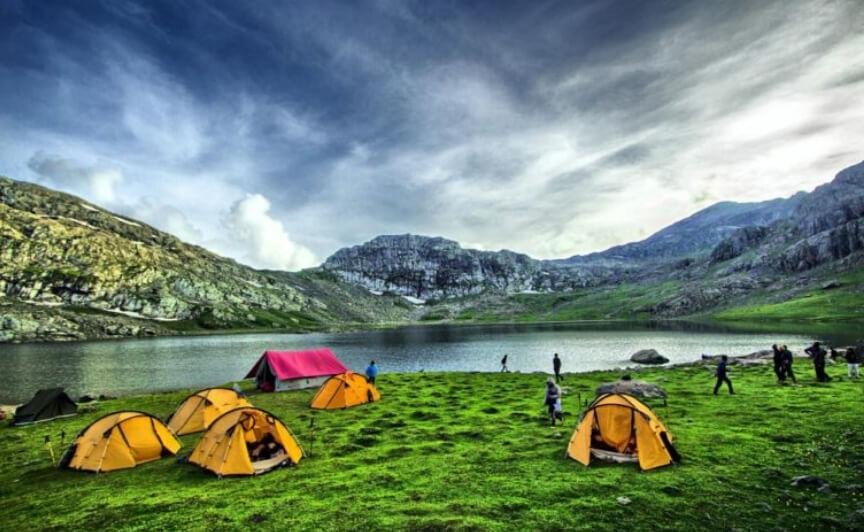
This is the time when the weather here is very pleasant and lovely. The temperature here ranges from 17 to 20 degrees Celsius in the daytime and 3 to 8 degrees Celsius at night. If you are looking for the best alternative to the Kashmir Great Lakes trek then you must definitely consider the Tarsar Marsar trek. The trail is abounded by unspoiled rivers, green meadows, fascinating lakes, and valleys in Dachigam National Park. While trekking along the lakes with clear blue sky offers an outstanding sight and the chance to camp right next to the emerald blue lake of Tarsar. The trail of this amazing trek hides in a thick blanket of the green valley as well as snow. It even turns into a small wonderland when the dark verdant forests turn into white. The Tarsar Marsar Trek is not only ideal for experienced trekkers but for amateurs as well. In the Kashmir valley, Tarsar Marsar is a beautiful and moderate level trek. If you have a passion for mountaineering then a trek to Tarsar Marsar is a must. During the Tarsar Marsar trek, you will never find yourself bored as it will offer you great joy. Get ready to experience the culture and beauty of Kashmir valley during the trek that will ultimately keep you connected to the mountain. The base camp of the Tarsar Marsar trek is Aru which is a small tranquil village fenced beautifully by lavish grasslands. This idyllic village is well-known for cottages, trees, and a stream flowing right from the heart of the village.It is important to have a good fitness level in order to go on this trek. Make sure to wear proper trekking gear and carry all the essential items as advised by the experts.
FIX DEPARTURE
1st, 2nd, 3rd, 4th, 5th, 6th, 7th, 8th, 9th, 10th, 11th, 12th, 13th, 14th, 15th, 16th, 17th, 18th, 19th, 20th, 21st, 22nd, 23rd, 24th, 25th, 26th, 27th, 28th, 29th, 30th, 31st July.
1st, 2nd, 3rd, 4th, 5th, 6th, 7th, 8th, 9th, 10th, 11th, 12th, 13th, 14th, 15th, 16th, 17th, 18th, 19th, 20th, 21st, 22nd, 23rd, 24th, 25th, 26th, 27th, 28th, 29th, 30th, 31st Aug.
1st, 2nd, 3rd, 4th, 5th, 6th, 7th, 8th, 9th, 10th, 11th, 12th, 13th, 14th, 15th, 16th, 17th, 18th, 19th, 20th, 21st, 22nd, 23rd, 24th, 25th, 26th, 27th, 28th, 29th, 30th Sep.
The Tarsar Marsar Lake Trek is a popular trekking route in the Kashmir region of India, known for its stunning alpine lakes and breathtaking landscapes.
The trek typically spans around 6 to 7 days , covering a distance of approximately 48 kilometers , depending on the route taken and the pace of the trekker.
The best time to embark on the Tarsar Marsar Lake Trek is during the summer months, from July to September , when the weather is favorable and the trails are accessible.
While prior trekking experience is not mandatory, it is recommended to have a basic level of fitness and endurance to navigate the terrain comfortably.
The Tarsar Marsar Lake Trek is considered moderate in difficulty, with some steep ascents and descents along the trail. Trekking at high altitudes may also pose challenges for some individuals.
Trekking permits are required for the Tarsar Marsar Lake Trek, which can be obtained from the local authorities or through licensed trekking agencies.
Accommodation during the trek typically includes camping in tents at designated campsites along the route. Basic facilities such as sleeping bags and meals are provided by trek organizers.
It is important to acclimatize properly to the altitude, stay hydrated, and follow the instructions of the trek leader or guide. It is also advisable to carry necessary medications and first aid supplies.
Essential items to pack for the Tarsar Marsar Lake Trek include trekking gear, shoes, warm clothing, waterproof outerwear, sunscreen, sunglasses, a hat, a flashlight, and personal toiletries.
Tarsar marsar Trek (Detailed Itinerary)
The Kashmir Tarsar Marsar trek begins in the afternoon and the very first destination is Aru base camp which is located at a distance of 12km away from Pahalgam. Ary is considered a beautiful tourist stop and the base for two main treks including Tarsar Marsar and Kolahoi Glacier trek. All the trekkers need to meet at Srinagar and then we will head to Aru which is a short drive of almost 3-4 hours. You might face network connectivity at Aru so it is advised to wrap all your communication at Srinagar itself. At Aru, all the trekkers will be greeted at a river-side camping zone. Here you can indulge in several activities like trout fishing in the Lidder, horseback riding, and even heliskiing during the winters. Night stay for all the trekkers is arranged in camps and also hot food will be served.
Get up early in the morning, witness the mesmerizing sunrise, have a healthy breakfast, and get ready to trek for 9-10km which will take almost 6 hours. Today, you will find the trail a pleasant one because it has an easy uphill ascent. After a 9-10km walk, you will enter the trail that is blessed with a thicket of conifers. From here, Aru valley is visible down below. You need to follow the track alongside the River Lidder firstly which is connected to the village uphill directly.The trail will further take you into a cluster of Fir trees and then to a huge clearing, Dalla near the Gujjar huts. From Dalla, the track is quite pleasant as you need to trek on the plain ground within a dense pine forest. As you trek further, cross a wooden bridge and finish the second section of the Fir forest line, the trail will take you to Lidderwat. Here the campsite for the trekkers is located where you can relax and get ready for the next day. Also, you will be served with hot & healthy dinner.
Lidder on day 03 which also takes you to a pine forest. Without much difficulty, you will find that the trail is in a straight line. after trekking for a few minutes, the pine cluster will open to a huge and sweeping grassland that beautifully intersect lofty mountains decked with snow patches here and there. After trekking for half an hour, trekkers will reach the clearing of Hamvas. Take a short break at the Gujjar huts where you can find small shops that offer tea and yummy savories. After this, the ascent is steeper and takes you to a forest of silver birch called Bhoj trees. This will further take you to Shekwas which is a beautiful meadow. Among all the camping sites, the best camping site is Shekwas.
Today, we have to descend a distance of 5km which will take almost 5 hours to complete. Day 04 will start from the Shekwas meadow and further take you through a snake-like path present in the grassland. From here the path will take you to an elevation right on the top of the stream. After trekking for two hours, you will come across the marvelous sights of different ridges from where you can get the first glimpse of the eye-catchy Trasar lake. This lake is an almond shape. By using the fastened rocks and boulders, cross the stream and reach the pretty grassland of Tarsar which is going to be the campsite for day 04. During the night, this lake turns into an attractive shade of turquoise blue and turns out to be a precious stone in the lap of snow-covered mountains.
Get up early in the morning and enjoy the views of Tarsar that are sure to leave you stunned with its untouched beauty. Through the shepherd’s trail, start descending and this trail will take you to the middle of the beautiful valley. Walk along the stream on the pretty velvet-like grass and enjoy nature at its best.Further, you will pass through the lush grasslands and cross the meadows. You can cross this section easily in just 30 minutes and then reach to the end of the meadow. By crossing a stream, reach the base with the aid of boulders, and ascent for almost 15 minutes in order to reach the top of the ridge. Keep following the trail and reach the beautiful grassy land of Sundersar Lake where you can pitch your tents and stay for the night. In this way, you will be able to enjoy the calm and gorgeous Kashmir.
On day 06, we will pass along the shores of Sundersar Lake to get through the two passes from where you will reach your destination i.e., Marsar Lake. Through the boulder zone, take a shorter trail. While ascending, you must be careful as the snow over the boulders makes the trail a bit tough. From here in 30 minutes, you will reach the outstanding grassland with gentle trails. Gradually reach the flat grounds and cross the small streams that come along the trail. From here, climbing the ridge begins and you get the chance to view Marsar Lake. You don’t need to cross the Tarsar pass but go through the diverse trail to Shekwas from where you will ultimately reach Homwas in just 30 minutes. After reaching Homwas, set up your tents, enjoy delicious food and retire for the night to relax your body.
Today is the last day of the trek and we will trek back to Aru from Homwas and then ultimately drive back to Srinagar. The trekkers need to descend from Homwas to Lidderwat. The mesmerizing sights of nature along the trail are sure to surprise you. We will arrange the vehicles for trekkers to reach Srinagar successfully. This will make the end of the Tarsar Marsar trek with lovely reminiscences.
THINGS TO CARRY
Basic gears.
- Backpack & Rain Cover (50-70 Litres)
- Hiking bag (20 litre)
- Trekking Shoes (Ankle Shoes)
- Warm clothes
- Water Bottles
- Jacket (Down or padded)
- Fleece or woolen clothes
- Trek pants and Trousers
- T-shirts (collar and full sleeves)
- Thermal inner wears (both upper and lower)
- Woolen or Fleece cap
- Hand Gloves
- Socks (4 pairs)
- Neck cover, Muffler, Balaclava, any
ACCESSORIES
- Sunscreeen Lotion (SPF 50/70)
- Moisturizer and Lip Balm
- Raincoat and Ponchos
- Power banks
- Trekking pole
- Small Hiking bag (10-20litre) (for summit climb or if you opt to offload your backpack)
- Glucose, Dry fruits
- Personal Toiletries kit
- Toilet paper roll and sanitizer
- Personal basic medical kit
MANDATORY DOCUMENTS
- Original with photocopy of government photo identity card any one (Passport, Aadhaar Card, Driving license or Voter ID)
- Transportation : Srinagar to Aru and return.
- Accommodation (Hotel, Homestay, Camping)
- Meals : All Meals as per menu from first day Dinner to last day Breakfast at basecamp; Vegetarian Meal.
- Camping charges : Camping and forest permit fees for Indian Nationals.
- Trekking equipment : High quality tents (living tent- triple sharing, kitchen tent, dinning tent, toilet tent)
- Sleeping bags, mattresses, liners, Utensils, Gaitors, Microspikes/crampons, ice axe.
- Safety equipment : First aid medical kit, oxygen cylinder, stretchers, rope.
- Mountaineering qualified and experienced Trek leader, Guides, Cook and Support staff.
- Meals during road journeys
- Any personal expenses
- Mules or porter to carry personal luggage
- Anything apart from inclusions
Backpack Offloading Charges
• Offload your backpack to a mule or porter to lighten your load during the trek. • Offloading charges range from ₹300 to ₹900 per day per bag, depending on the specific trek. • Ensure your backpack weighs less than 11 kg and is equipped with a waterproof cover. • Suitcases, trolleys, or duffel bags are not allowed.
Booking Confirmation Policy
• The customer receives a Booking confirmation receipt immediately via Email and WhatsApp of a successful booking.
Cancellation policy
In the event you cancel your trek, cancellation policy we follow :
• Cancellation 20 days before the starting date of the trek – Refund with 10% cancellation charges.
• Cancellation 10 days before the starting date of the trek – Refund with 50% cancellation charges
• Cancellation less than 10 days from the starting date of the trek – No refund
Note : HA gives you a facility in the event of cancellation due to some reason to transfer your trek (same trek and same batch) to your friend.
• The refund will be given in the form of a trek voucher with 1 year validity , you will get an email for your trek voucher, which will take up to 7 working days.

Trekking in the Himalayas is a popular adventure sport for those who love exploring the unknown. The mountain ranges in India provide stunning and exciting trekking paths.
famous Treks
- BALI PASS TREK
- KEDARKANTHA TREK
- HAR KI DUN TREK
- VALLEY OF FLOWERS
- BRAHMATAL TREK
- HAMPTA PASS TREK
- Himalayan Ambition , Vasant Vihar Enclave, Dehradun, Uttarakhand
- +91 9719715444
- +91 9536332828
- +91 9536385777
- [email protected]
- Privacy Policy
- Terms & Conditions
Copyright © Himalayan Ambition 2022 BY ADXVENTURE
Enquiry Now

Tarsar Marsar Trek
- INCLUSIONS/EXCLUSIONS
- THINGS TO CARRY
- Best Price Guaranteed
- Secure & Easy Booking
- 1000+ Happy Customers
- Jammu & kashmir
- Tesar Masar Trek
The Tarsar Lake or Tar Sar is an almond-shaped, oligotrophic alpine lake situated in the Kashmir Valley, specifically in Aru, Anantnag district, Jammu and Kashmir, India. The Tarsar Lake is dominated by the peaks of the Kolahoi mountain some 20 km to the east. The lake is separated by a mountain with a minimum peak elevation of 4,000 meters (13,000 ft.) from another lake of the same nature known as Marsar Lake, which is in the vicinity of Dachigam National Park. Together these two lakes are referred to as the twin sisters. The 16th-century Kashmiri ruler Yusuf Shah Chak mentioned the twin lakes in his poetry, writing to his beloved: When I remember the two tresses of the comely beloved, Tears begin to flow from my eyes like streams from Tarsar and Marsar. The Tarsar Lake is drained by an outlet stream which falls into the Lidder River at Lidderwat, 15 km to the east. Being the nearest seasonal settlement, Lidderwat is located on the trek route to the lake from Aru, Pahalgam. The Marsar Lake on the other hand drains out and flows in the opposite direction of the Tarsar Lake.
- Srinagar to Aru base camp
- Aru to Lidderwat
- Lidderwat to Shekwas
- Shekwas to Tarsar and explore Tarsar
- LTarsar to Sundarsar
- Visit Marsar and then to Homwas
- Homwas to Aru and drive to Srinagar
Inclusions/Exclusions
What is included in the tour.
- Accommodation during the trek.
- Vegetarian Food.
- Trekking Equipment (Tents, Sleeping Bags)
- Safety Equipment (First Aid,ropes,iceaxe,crampons etc)
- Forest permits and camping charges
- Services of Trek Leader,Guide,Cooking Staff.
What is NOT included in the tour
- Personal Expenses of any kind.
- Food during the Transit
- Mules or Porter charges to carry backpacks
- Anything not included in the inclusions above.
Things to Carry
- Sports shoes or trekking shoes in good condition
- 2 liter water bottle per person
- Energy bars, dry fruits, flavored milk, Electrolyte drinks
Kodachadri trekking and camping located on the edges of Karnataka, sanctified with some of the most enchanting landscapes. Abode to abundant peaks and waterfalls. Kodachadri, the tenth highest peak of Karnataka, gets its name from Kodacha and Adri, signifying ‘home of the hill jasmine flowers’ in the local dialect. Otherwise called the Jasmine of Hills, the peak of Kodachadri is an ideal canvas to the setting of the renowned Mookambika Temple and the Mookambika National Park. Residing at the focal point of this National Park, Kodachadri bestows various opportunities to wildlife and trekking buffs. Kodachadri Trek is taking off high at a rise of 4406 feet; the Kodachadri summit is a dramatic peak with dense forest swathe surrounding it. Likewise, it is a characteristic territory to the dazzling scope of biodiversity, for example, Malabar Pied Hornbill, Malabar Languor, and Indian Rock Python , alongside mountain vegetation and indigenous fauna.
Other Popular Tours
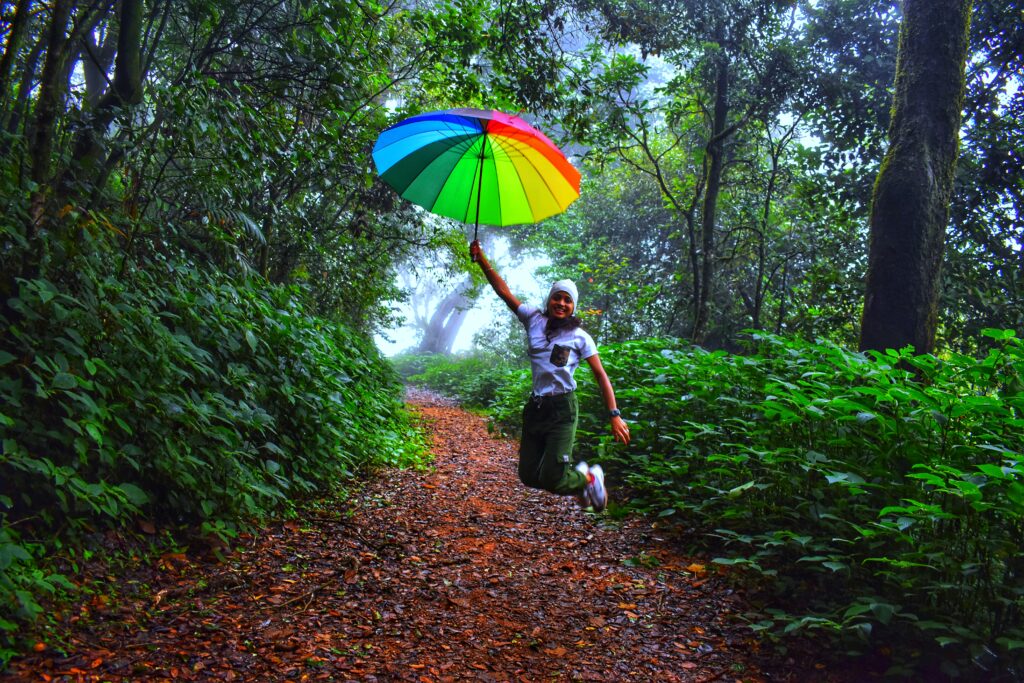
Upcoming Events
Starting from ₹ 3,999
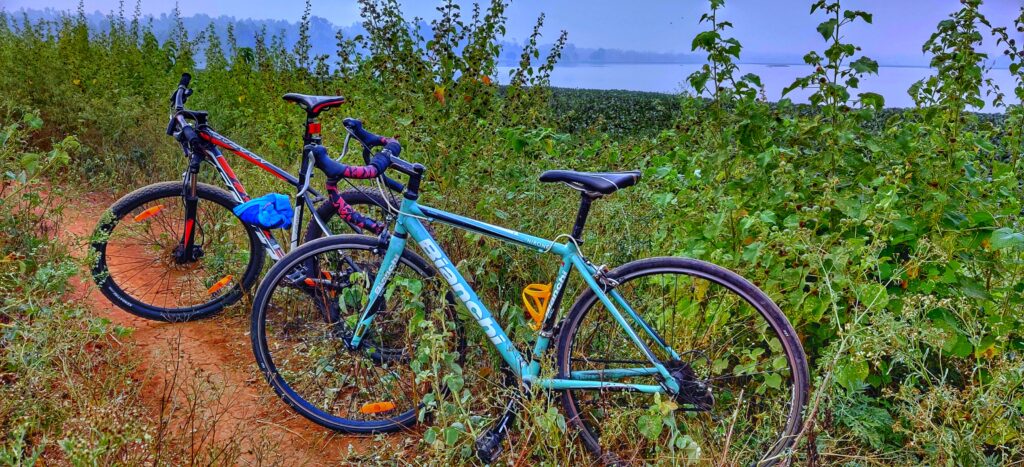
Bangalore Cycling
Search your trek.
- Kumara Parvatha Trek
- Kodachadri Trek
- Kudremukh Trek
- Chikmangalur Camping
- Gokarna Trek
- Tadiandamol Trek
- Gandikota Adventure(Bangalore – Banagalore)
- Anthargange Trek
- Makalidurga Trek
- Kabbaladurga Trek
- Savandurga Trek
- Skandagiri Sunrise Trek
- Uttari Betta Trek
- Gandikota Adventure
- Dudhsagar Trek
- Kalsubai Trek
- Rajmachi Trek
- Jammu & Kashmir
- Great Lakes of Kashmir
- Tarmar Marsar Trek
- Markha Valley Trek
- Kang Yatze II
- Utharakhand
- Pangarchulla Peak Trekking
- Kuari pass trekking and camping
- Har Ki Dun Trek (Garhwal Himalayas)
- Himachal Pradesh
- Brighu Lake Trek
- Hampta Pass Trek
- Weekend Gateway
- Family Trips
- School Trips
Contact Us for Tarsar marsar Trek

TARSAR MARSAR TREK
7 Nights 8 Days
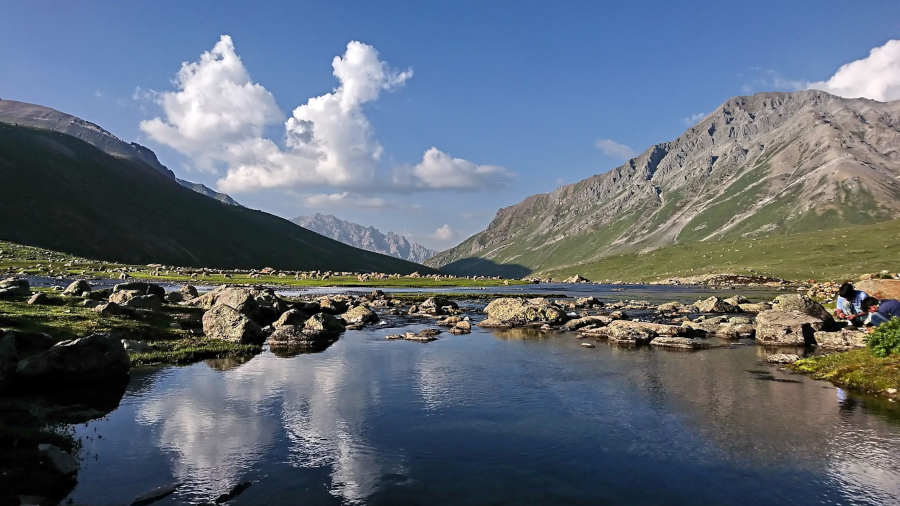
Tarsar Marsar Trek is one of the most beautiful and calm trek of the Kashmir Himalayas. The trek comprises of snow-capped mountains, colorful valleys, dense alpine forests and vast green carpeted meadows and two high altitude alpine lakes, viz, Tarsar and Marsar lakes situated at an altitude of 12500 ft. The trek lies between two wildlife protected areas of Dachigam National Park and Overa-Aru Wildlife Sanctuary. Tarsar Marsar Trek is the best alternative to Kashmir Great Lakes trek and for those who want to avoid the hustle and bustle of the later. The cultural insights include local shepherds, their herds and families residing in the meadows of the trail. On your way from Srinagar to Pahalgam and as well on the houseboat you will get an idea of the local culture, food and religion in Kashmir. There is colour everywhere. The Tarsar Marsar Trek will offer you one of the best trail experiences you will savour for a lifetime.
The program includes all transfers by ac cars. We stay in good quality tents, and even experience staying at a traditional Houseboat. Kashmir Alps can offer this excellent program at very competitive prices.
The tour begins in Srinagar and ends in Srinagar, depending on your further plans.
Day 1. Arrival Srinagar: On arrival at the Srinagar airport (on your own), you will be received by Kashmir Alps representative / driver. Once you board your vehicle, you will proceed to the deluxe houseboat. Later in the evening proceed for shikara ride in Dal Lake. Dinner & overnight will be on board the houseboat in Srinagar.
Accommodation: Houseboat Mughal Palace or similar in Srinagar
Meals: Dinner
Day 2. Srinagar – Aru (130 kms / 4 hours drive) – Lidderwat (5 hours trek): After breakfast at the houseboat, we drive to Aru and pack our load and backpacks on horses and start our trek. The trek begins with a mild yet long climb from the village of Aru to Lidderwat, which is about 10 km away. The trail snakes along the cool Ladder river. A few minutes into the trek, and you can see the beautiful area of Aru behind you. Soon the trail enters beautiful forests of fir, and opens out to the Dalla clearing. Now the trek becomes gentler and evener. About 2 – 3 hours later, the trail curves into dense fir forests, and to the stunning meadows of Lidderwat. Camp overnight at the dreamy campsite of Lidderwat.
Accommodation: 2 persons per tent (spacious)
All Meals: Breakfast, lunch, tea/snacks and Dinner
Day 3. Lidderwat – Sekwas (5 hrs trek). An easy to moderate day. Continue the trail alongside the Lidder river, and dips down into the fantastic forests of pine. Move past the cluster of trees and watch incredible views unfold before you. The expansive grasslands of Lidderwat blend in with the snowy mountains, along with misty valleys. The trail enters a tapering valley graced by a snaking blue river and soon leads to the lovely campsite of Sekwas
Day 4. Sekwas to Tarsar (5 hrs trek). Once you leave Shekwas, the trail along the path leading up to Tarsar, via a ridge overlooking a stream. The narrow ridges pop up to stunning views of the valley. About two hours later, the trail offers a slight sneak peek into the wonderful Tarsar lake. Crossing a stream through rocky terrains and boulders land you at the grasslands of Tarsar. Camp here for the night.
Day 5. Tarsar to Sundersar (5 hrs trek). The Tarsar Pass commands numerous beautiful views, and the valley spans out beautifully. Trekking through the pass saves you a few hours, which is saying something. The trail that descends from the pass to the bottom of the valley opens up to a verdant valley. Another stretch of meadows, grasslands, streams, and boulders brings you to the magical campsite of Sundarsar Lake, where you camp overnight.
Day 6. Sundersar to Homwas via Marsar (6 hrs trek).
The trail from Sundarsar stretched far across the lake, and towards Marsar. The one that goes over boulders is a quicker trail, although a bit tricky. This is where you’ll thank yourself for carrying a trekking pole or ice axe. Soon the path opens up to grassy patches, and past a few beautiful brooks. Soon, the climb leads to stunning vistas of Marsar, enveloped in cloudy haloes. The lake, looking quite similar to Tarsar lake, is lined by beautiful mountains on the side. From Marsar, you descend back to Sundesar Campsite. After that stick to the trail heading towards Zachmargi valley, this will land us at the homwas campsite.
Day 7. Homwas to Aru (5 hrs trek) – Srinagar (3 hours drive).
Post a hearty breakfast, we take the same route which we took at the beginning of the trek via Liddervat. It is a full descent, and our path unfolds along several gurgling streams, along with a handful of shepherd huts and settlements. It will take around 2 hours from Homwas to Liddervat, it is a 10km walk from Liddervat to Aru. From here, you depart for Srinagar, which takes maximum 3 hours drive.
Meals: Breakfast, lunch and Dinner
Day 8 Srinagar – Departure Today after breakfast, check out from your hotel and proceed to Srinagar airport.
Accommodation: N/A
Meals: Breakfast
✔ All transfers by private ac cars including airport assistance.
✔ 6 nights of tented accommodation Twin sharing; 2 persons in a 3-man-tent.
✔ 2 nights (before and after the trek) Houseboat Mughal Palace or same in Srinagar.
✔ All trekking gear included. Tents (twin sharing), dining and kitchen tent, toilet tents, sleeping bags and mats. Trekking poles (1 per person) also included.
✔ Local Guides and Cooking staff. Languages; English, Urdu, Hindi and Kashmiri.
✔ All cooking utensils. LPG stoves.
✔ Offloading. .Horses to carry your backpack throughout the trek (offloading) (except day sack)
✔ Meal plan- Vegetarian meals including eggs and cheese, unless specified. Trek-4 meals per day (Breakfast, Lunch, Tea snacks, Dinner). Houseboat – 2 Meals (Dinner and Breakfast).
✔ Trek and Wildlife Permits.
✔ Drinking Water (boiled) during the trek.
✔ First Aid Kit.
NOT INCLUDED
X Domestic and international flight.
X Personal expenses.
X Insurance.
X Everything not mentioned in the “Included” list.
PRICE PER PERSON (INCLUSIVE OF ALL TAXES)
Standard: INR 16100/
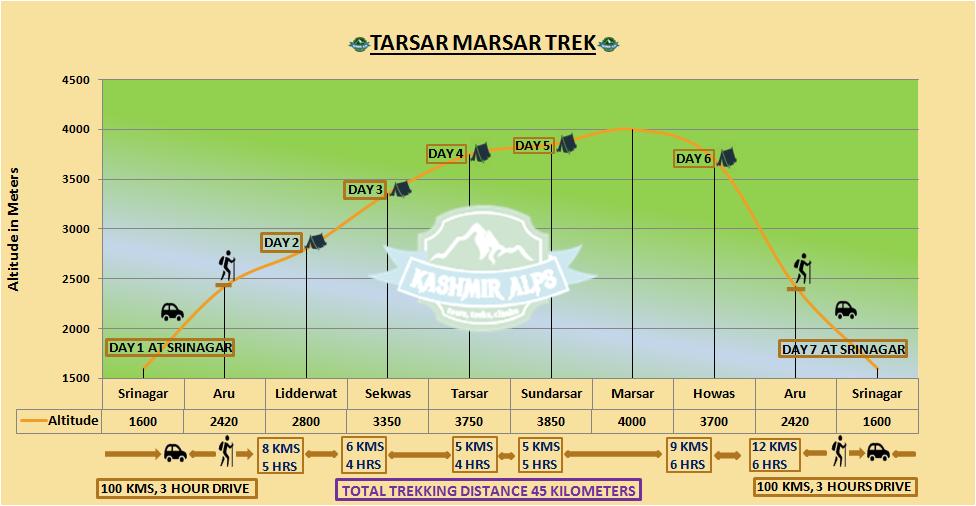
TARSAR MARSAR ALTITUDE MAP
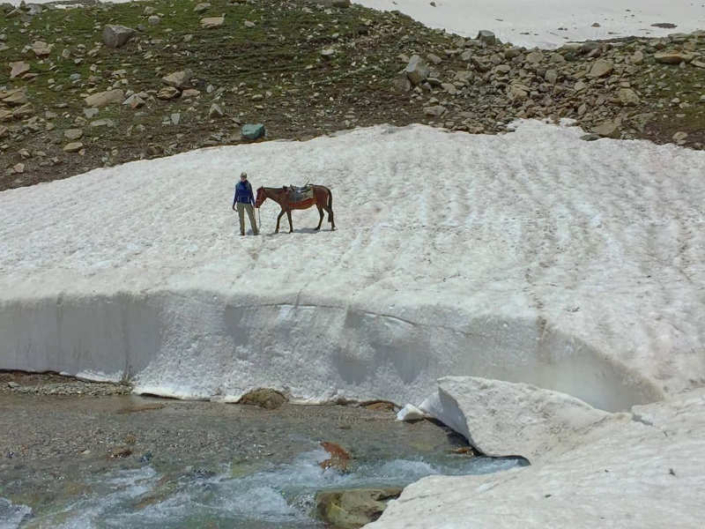
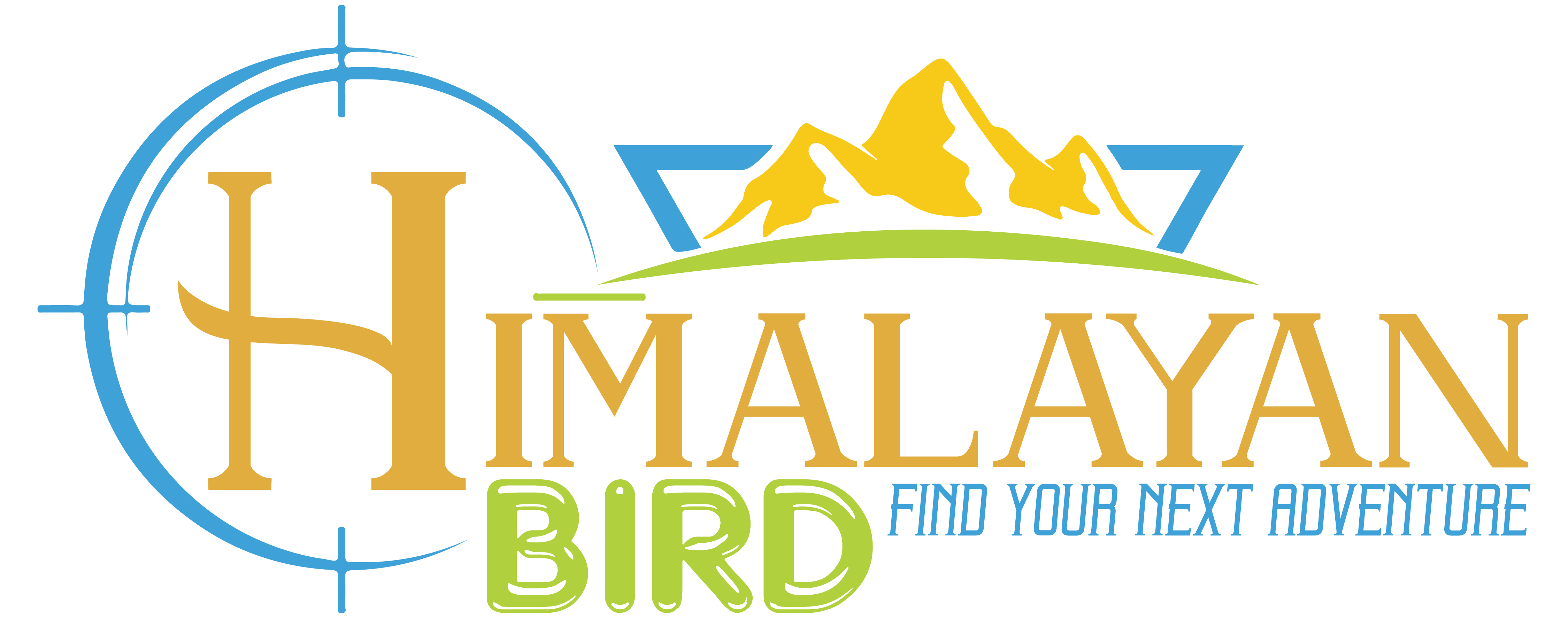
- Tarsar Marsar Trek
- Moderate + Easy Trek
- Max. Altitude 4000 m.
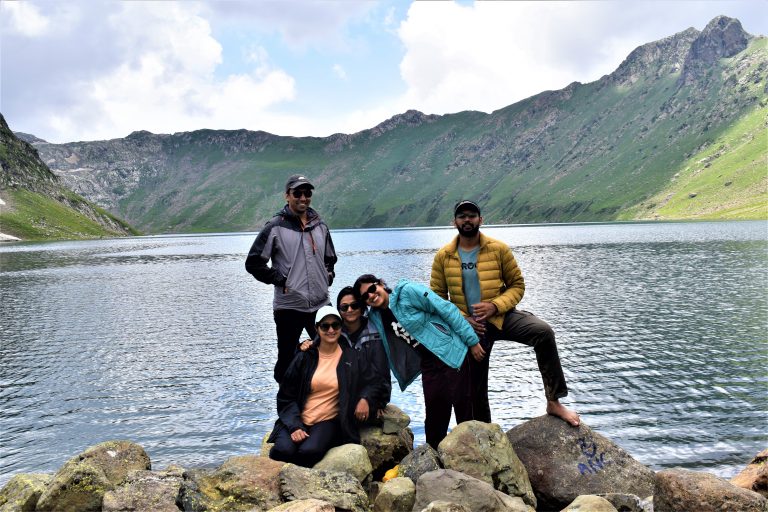
Inclusions of the trek
- Cost INR 15000 On Fixed Dates
- Tourist Taxi - Srinagar to Aru and Return.
- 3 time delicious meals, Tea/Coffee and Refreshments.
- Mules and Horses to carry rucksack.
- Pup Tents and Dome Tents.
- Guest House Stay during start of the trek.
- Dinning Tents.
- High Altitude Cook
- Hiking poles/rods.
- Sleeping bags (-8) and Sleeping Pads.
- Trekking and fishing permits.
- Experienced Trek Leader and guides.
- Dal Lake Sightseeing.
Quick Booking FOrm
Overview of tarsar marsar trek.
Tarsar and Marsar lakes are no doubt 2 wonders of nature located in the lap of the Pir Panchal mountain Range of Lesser Himalayas. The Lakes are surrounded by the number of Pinnacles lying around 4000 to 5000 meters above sea level. The Tarsar Marsar trek comes across the district Anantnag in the Union Territory of Kashmir. The total distance from Srinagar to Aru Village is 94 km. The altitude of trailhead Aru is 2433 m, the first campsite named Lidderwat is located at an altitude of 3000 m, and the Tarsar Lake is located at an altitude of 3795 meters above sea level. The first stretch of 10 kms from Aru to Lidderwat is the easiest part of the trek.
The Landscape of the trek.
During this journey of 7 days, you will witness the miracles of nature in the form of green lush meadows, inverted waterfalls, snow-fed rivers, snow-capped mountains, tall pine trees, gypsy life, wildflowers, valleys, and the open view of the lesser Himalayas including high mountain peak of Kashmir (Mt. Kolahoi 5425 m).The Tarsar Marsar Lakes trek is the only trek mentioned on the Lonely Planet guide for Indian Himalayas. The charming trek in the lap of majestic mountains peaks of Kashmir. This pleasant trek is an adventure of a lifetime and a must-do trek of the Indian Himalayas.
Experience during the trek.
The Tarsar Marsar trek provides the ultimate blend of adventure and fun while being close to nature. Starting the trek from Aru Village and entering treeline on the banks of river Lidder makes the trek melodious. The distance from Aru to the Tarsar Lake ridge is 24 km so the total distance of astounding Tarsar Marsar Lakes Trek is 48 km (29.82 miles). The temperate remains cold even during peak summertime so proper winter clothing is recommended. When we are talking about the route of Tarsar Marsar Lakes, it is moderate just because a very small part of the trek has steep ascent and roughness. The difficulty level of the trek has been graded as moderate for the people who have some experience of high-altitude trekking.
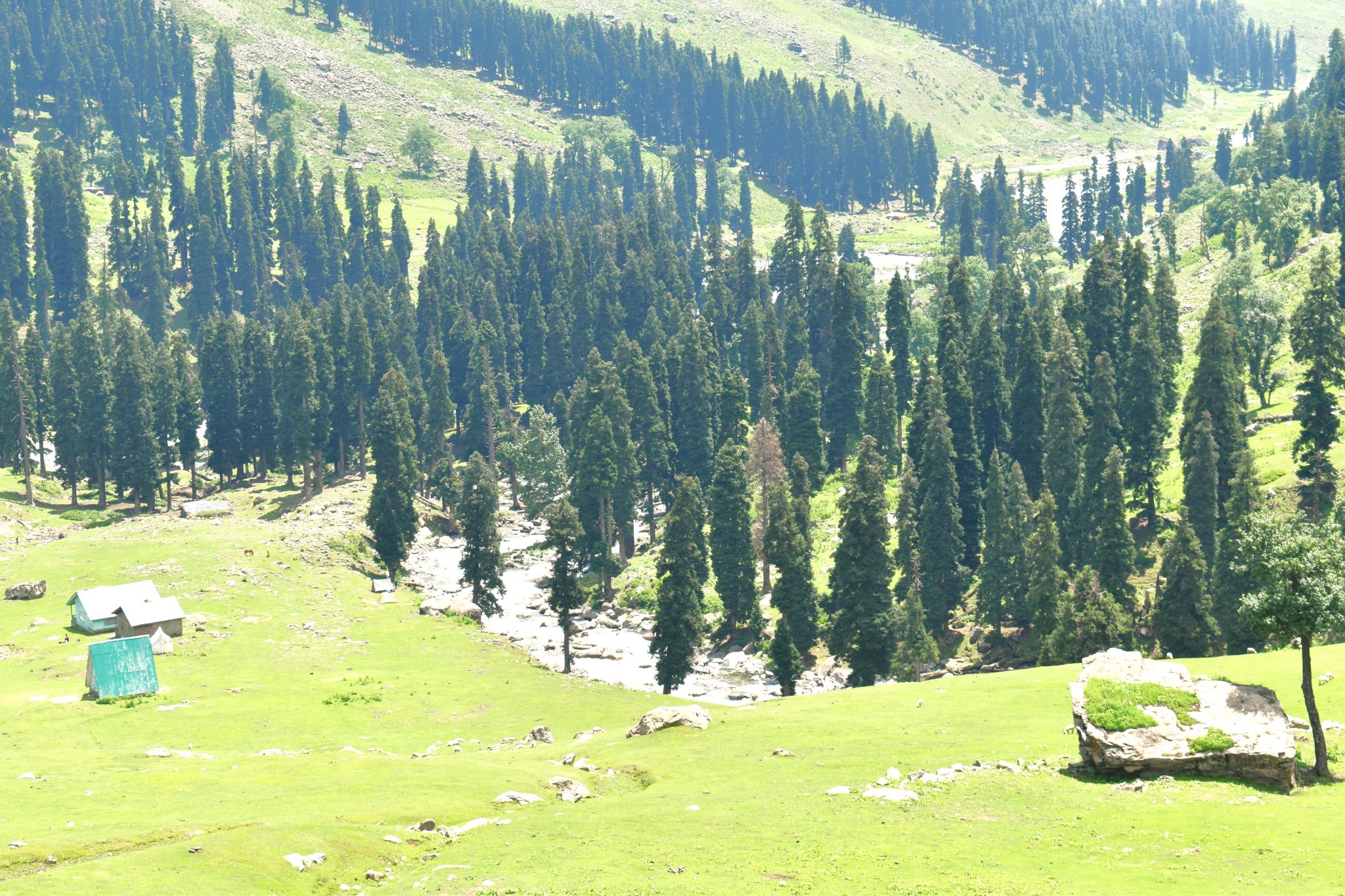
How to Reach Srinagar
- Direct flights
Kashmir does have only one commercial Airport which we can reach by direct flights from Delhi (DEL) Airport, Bangalore, Jammu, And Hyderabad. All the flights from other parts of India reach via Delhi to Srinagar (SXR), Kashmir.
Government and Private bus services to Jammu are available from from Delhi and from other parts of India. Jammu onwards you can again choose state government bus service or choose tourist taxi from Jammu to Srinagar. Tourist taxi, Public transport And UT Government Bus Service will be available easily from Jammu to Srinagar.
The train services can be used up to Jammu And Banihal only. Tourist taxi, Public transport And UT Government Bus Service will be available easily from Jammu to Srinagar. The distance of 270 Km from Jammu to Srinagar is usually been covered in 6 to 7 hours.

Map of Tarsar Marsar Trek
The Tarsar Marsar Trek has three main stretches. 1. Aru to Lidderwat – 10 Km. 2. Lidderwat to Shekwas – 6.Km. 3. Shekwas to Tarsar 6 Km. The first stretch of the trek is easiest part of the trek which can be identified easily on the map too.The Lidderwat is a triangular piece of land surrounded by pine trees and water streams. Lidderwat onwards it’s time to gain elevation through the route shown on the map. The coordinates of Tarsar Lake are 34°8′24″N 75°8′53″E and 34.144°N 75.110°E for the Marsar Lake. Reaching Homwas after the gradual ascent of 3 hours. As the map of Tarsar Marsar Lake shows the incline in the route. Crossing the river at Homwas and going through boulder walk for 20 min will take to Shekwas campsite.
The Tarsar Marsar Trek has three main stretches. 1. Aru to Lidderwat – 10 Km. 2. Lidderwat to Shekwas – 6.Km. 3. Shekwas to Tarsar 6 Km. The first stretch of the trek is easiest part of the trek. which can be identified easily on the map too.The Lidderwat is a triangular piece of land surrounded by pine trees and water streams. Lidderwat onwards it’s time to gain elevation through the route shown on the map. The coordinates of Tarsar Lake are 34°8′24″N 75°8′53″E and 34.144°N 75.110°E for the Marsar Lake. Reaching Homwas after the gradual ascent of 3 hours. As the map of Tarsar Marsar Lake shows the incline in the route. Crossing the river at Homwas and going through boulder walk for 20 min will take to Shekwas campsite.
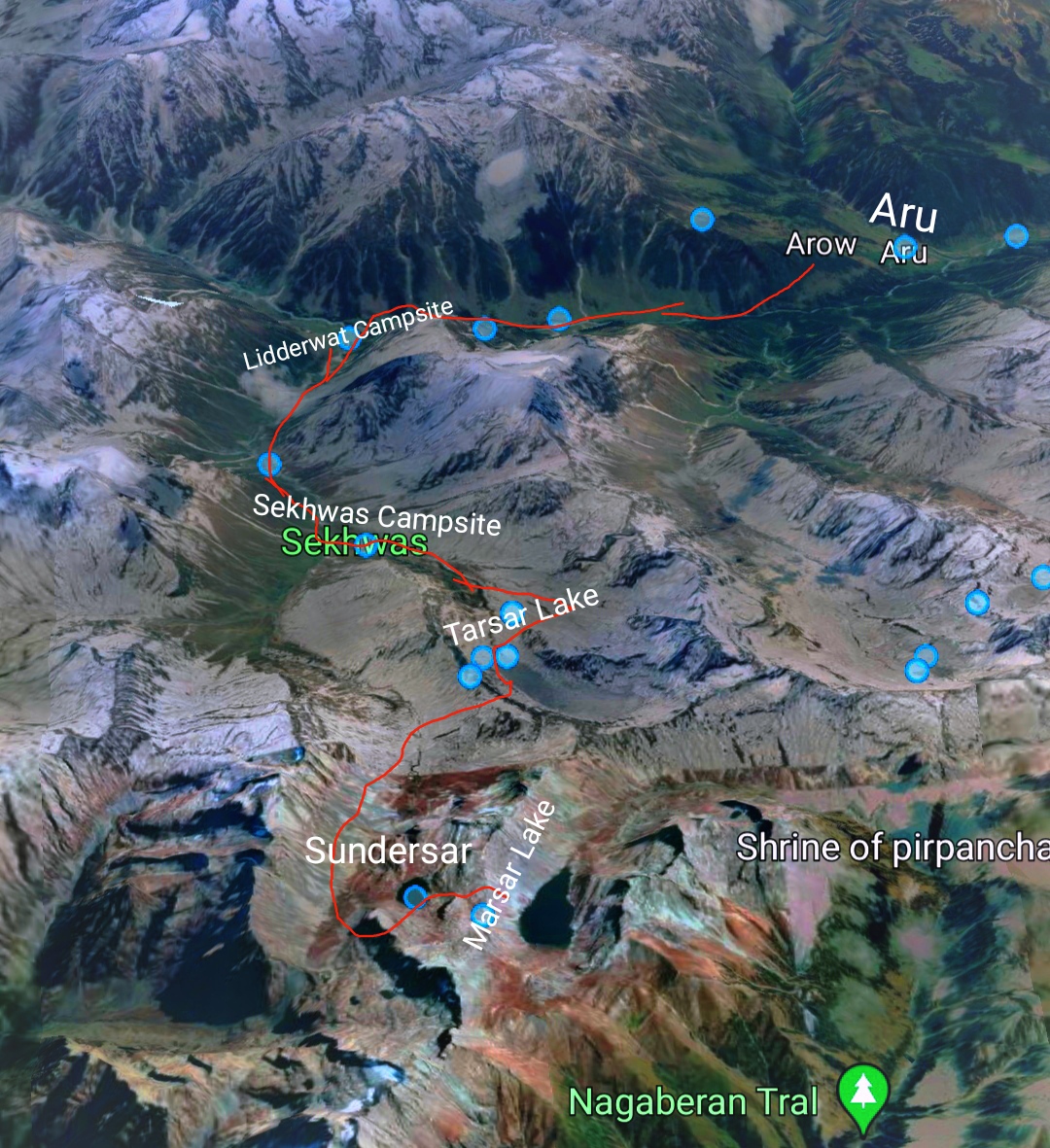
Short ITinerary Tarsar MArsar Trek
Note: Trekkers are advised to reach Srinagar a day before the trek will commence. Our itinerary doesn’t include any buffer day but trekkers must add a buffer day in order to secure their departure. Bad weather conditions sometimes take an extra day to reach back on road safe and sound.
Day 1: Srinagar - Aru campsite
During the first day, we will send the tourist taxi at a programmed time and we will be heading towards the trailhead by covering a distance of 94 km. This will be an acclimatization day with a few km walk around the Aru valley. Night stay will be at Aru Campsite at an elevation 2433 m.
Day 2: Aru campsite - Lidderwat
Trek distance: 10 km
Time Taken: 6 – 7 hours
Altitude gain: 400 meters
Trek type: Easy + moderate trek through the rolling slopes of Lidder Valley
Day 3: Lidderwat - Shekwas
Trek distance: 6 km
Altitude gain : 582 meters
Trek type: The trek starts with a gradual ascent and the route turns flat at fewer places. After a boulder walk of 20 minutes followed by the river crossing, we will get to Shekwas.
Day 4: Shekwas to Tarsar Lake
Trek distance: 5 km
Time Taken: 4 hours
Altitude gain: 430 meters
Trek type: Moderate ascent over the incline meadow of Tarsar Valley. Upon reaching altitude of 3500 m the route turns flat with little incline at the end.
Day 5: Tarsar Lake - Sundersar
Time Taken: 5 hours
Altitude gain: 155 meters
Trek type: Ascent trek of 1 hours to cross the ridge which parrel to Tarsar Lake followed by descent and normal Walk. Ending with a gradual climb of 1 hour.
Day 6: Sundersar - Lidderwat
Trek distance: 15 km
Time Taken: 7 hours
Elevation Loss: 800 meters
Trek type: Gradual descent trek through the valley of Tarsar and Homwas. 20 percent of the route is little rough.
Day 7: Lidderwat - Aru - Srinagar
Time Taken: 8 hours
Elevation Loss: 582 meters
Trek type: Descent through the rolling slopes of Lidder Valley and parallel to the Lidder river. 3 hours drive to Srinagar from Aru Village.
Day 8: Buffer Day
Trek distance: 0 km
Time Taken: 0 hours
Height lose : 000 meters
Best Time To Do Tarsar Marsar trek

Being the most astonishing trek of the Indian Himalayas. The best time to do Tarsar Masar Trek is from 1 June to 15 September. Peak Sumer season is the best time to explore this part of the Himalayas. During starting June the temperate remains cold and the landscape above 3000 meters is partially covered with snow. During July the meadows get in their bloom and snow can be found in the gullies and mountain peaks. In the month of August, the weather gets dry and fewer chances of rain when compared to June and July. During September the weather remains fully dry and also there is no conjunction on the trail. So the best time to visit Tarsar Marsar Lakes is from Starting June to the end of September and also permissible by the department of Tourism Kashmir (UT) for the said season.
In the month of October the weather gets harsh and the meadows turn brown and cold winds from Dras make the region freezing. As per the protocols of the Tourism Department, the trek is permitted from June to September only. Mountain Expeditions can take place in the area by permission of IMF and UT Tourism Authorities during peak summer time only. The best time to explore the alpine lakes of Kashmir is peak summertime only. When comparing Tarsar Marsar Lake trek to Kashmir great lakes trek the Tarsar Marsar open a month earlier than KGL trek.
Fixed Depature Dates for 2022
- 2 June to 8 June
- 10 June to 16 June
- 18 June to 24 June
- 26 June to 2 July
- 04 July to 10 July
- 11 July to 17 July
- 18 July to 25 July
- 27 July to 2 August
- 4 Aug to 10 Aug
- 11 Aug to 17 Aug
- 18 Aug to 24 Aug
- 26 Aug to 2 Sep
- 4 Sep to 10 Sep
- 12 Sep to 18 Sep
- 20 Sep to 26 Sep
- 28 Sep to 4 Oct
Detailed itinerary of the TRek
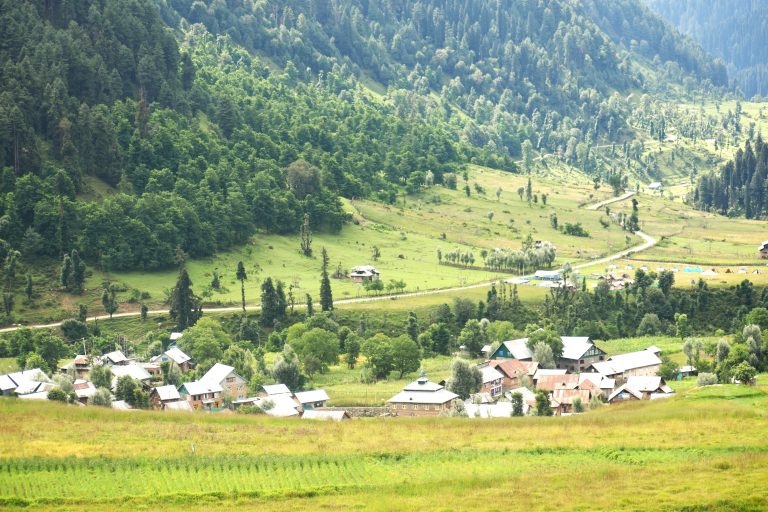
Day 1: Srinagar to Aru Campsite
We welcome you to an awesome adventure with Himalayan Bird Adventures. The driver will be sent to pick you up from any of the locations in Srinagar. After meeting the trek coordinator, we will be heading to the Aru, which is 90 km away from Srinagar and takes 3 to 4 hours. The remaining time of the day will spent on acclimatization walk at the Aru Valley and end the day with the delicious meals. Aru Valley is going to be the campsite for the first day. Enjoying the time in the beautiful valley and getting ready by acclimatizing till the next morning.
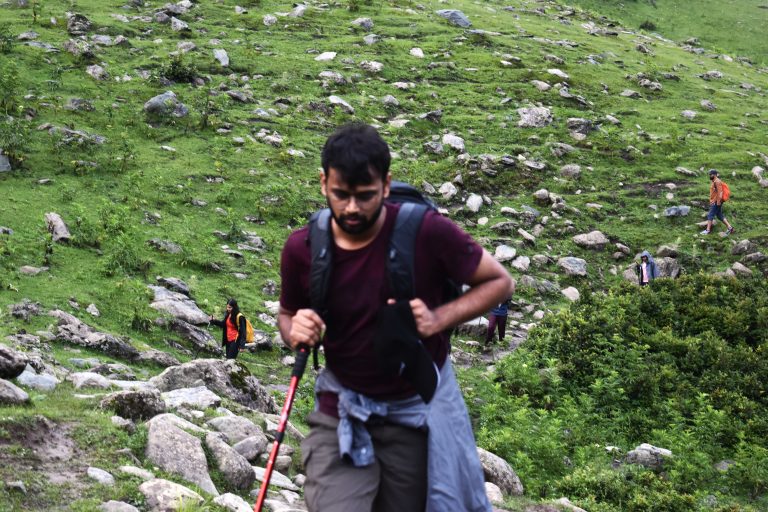
Day 2: Aru to Lidderwat
On leaving the Aru Campsite 2400 m, we will be walking in the treeline with the normal walk towards Lidderwat through the banks of river Lidder. The trekking route is 12 km from Aru to Lidderwat, Most of the route is normal with very gradual gain in elevation . Lidderwat (2800 m) is the base camp for a number of multi-day and short treks like the Kolahoi Summit Trek and other alpine lakes trek. Camping at Lidderwat overnight and explore the surroundings.

Day 3: Lidderwat to Shekwas campsite
Right after breaakfast at 7 in the morning, we will start a gradual ascent of 7 km from Lidderwat to Shekwas. As you go higher through the ridges and meadows of Tarsar Lake, the wider view of surrounding mountains makes the trek joyful. During the trek, you will walk parallel but opposite to the water stream which is the outflow of Tarsar Lake. Later this stream joins the Lidder river which itself is a tributary and the Jehlum river. On every step there will be the elevation gain and at this point, a little push is needed. Finally with 20 minutes of boulder walk followed by a river crossing will take you to the Shekwas campsite. The spectacular view of surrounding mountains reminds the fact that Kashmir is fully photogenic. Enjoy the tea and coffee in the evening bonfire at Shekwas campsite.
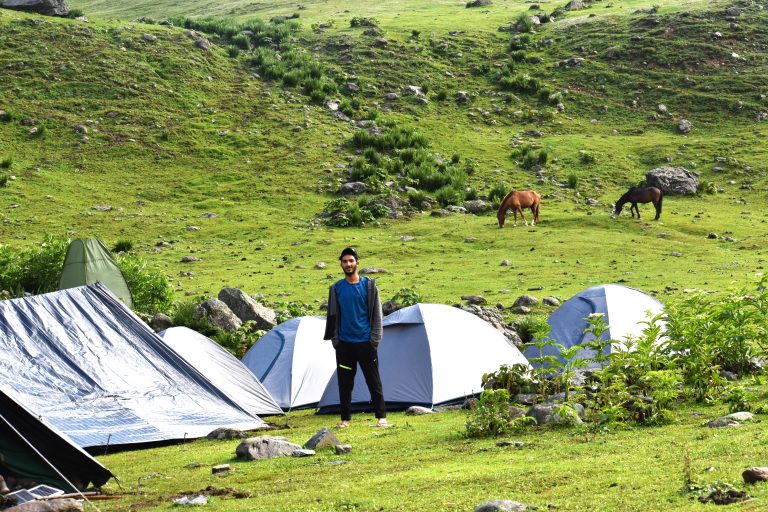
Day 4: Shekwas to Tarsar LAke CampSite
Spending the night a Shekwas verily helps trekkers to acclimatize properly. By the morning it remains a little cold but as you start walking through the route the body temperature gets warm. The total distance from Shekwas to Tarsar Lake is 3.5 km through a slope of 40 degrees angle. The surrounding meadows are been used by Gujjars and Bakerwalls to graze their herd during the peak winter season on such high altitudes. After the trek of 2 hours, a flat landscape covered with spiky peaks named locally at marg. At once a sparkling view from one of its corners takes away all your tiredness because this is the adventure experience you were looking for. Reaching Tarsar Lake is the major part of the trek, the camping will be just 200 m away from the lake.
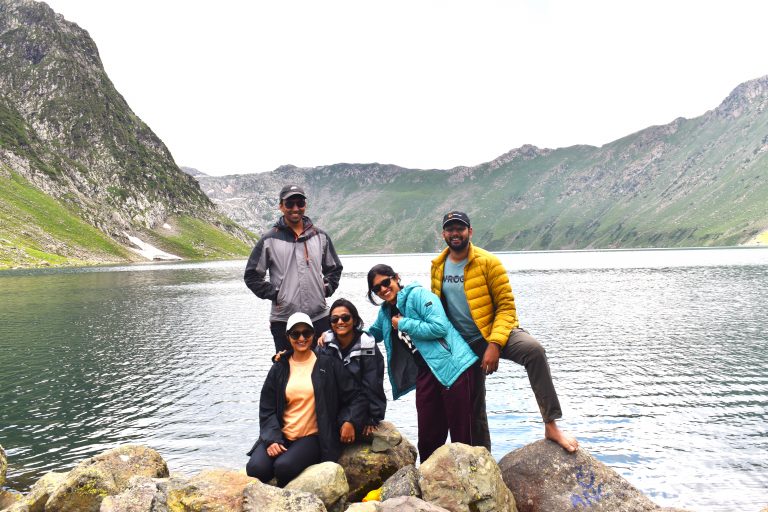
Day 5: Tarsar to Sundersar
The next part of the trek is Sundersar Lake, it takes 1 to 2 hours to cross a nearby ridge that is parallel to Lake. After a steep ascent of an hour, it’s time to descent to a flat landscape, locally called at Zagi. Shepherds and Gypgy camps can be seen in the valley with herds of sheep and goats Going through one hour of ascent, we will be on the banks of Sundersar Lake. Wildflower beds can be seen during the end of July and starting August only. After having our lunch, we will head to the next milestone which is Marsar Lake. It takes just an hour to reach the ridge from where Marsar Lake can be seen. The Lake is 1 km in the length and 500 m in width. This almond-shaped lake remains under clouds which results in a cold temperate nearby the Lake.
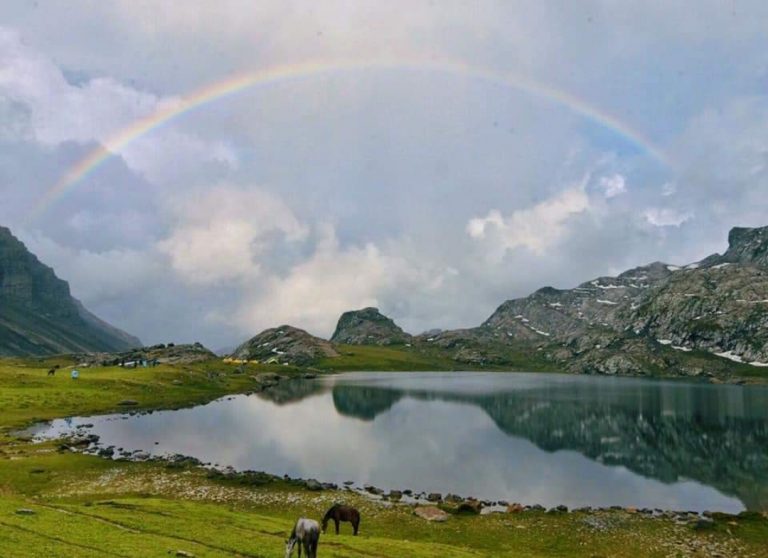
Day 6: Sundersar to Lidderwat
Now onwards on every step, we will lose the altitude. Reaching Lidderwat campsite is a little bit challenging but not difficult. The total distance of 14 km will be covered in 8 to 9 hours. While the decent there will be more pressure on the knees and on the front portion of the feet, using the two hiking poles can help to avoid much pressure. Turing left near the ridge of Tarsar Lake will bypass the lake and we reach very close to the Shekwas. The temperature remains 20 to 30 degrees Celcius during peak summertime but due to the long walk, it feels too hot. Staying hydrated is important in order to remain fit on the trek. Ending the day on the awesome campsite of Lidderwat is a relaxing moment in the lap of mountains.
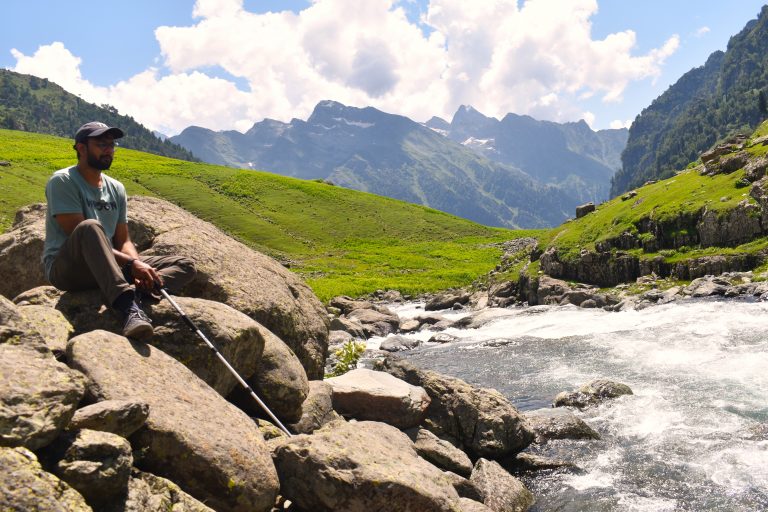
Day 7: Lidderwat to Aru to Srinagar
Ending an awesome adventure with its never lost beautiful memories. It will be a trek of 3 to 4 hours from Lidderwat to Aru. Walking down on the rolling slopes and parallel to the flow of River Lidder. Taking packed meals on banks on river shore gives a melodious experience. Upon reaching Aru, our cabs will be ready to drop you at Srinagar.
Frequently Asked Questions
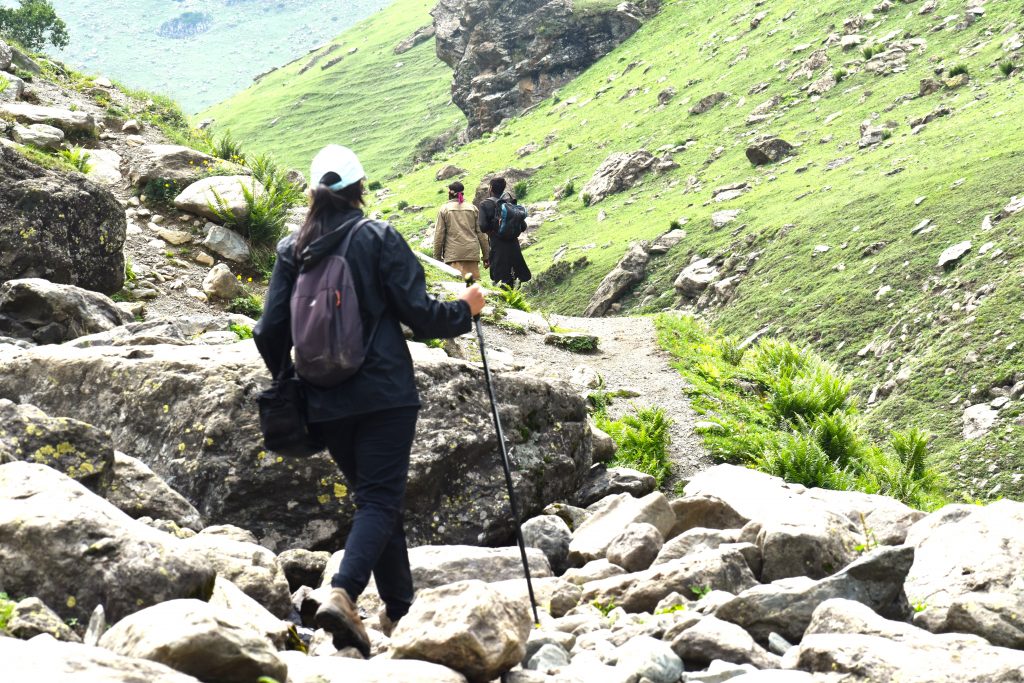
Is Tarsar Marsar Safe?
The situation in the valley after 2016 has been improved dramatically and millions of tourists and trekkers visited the valley till now. Currently, a large number of educated youth are part of the tourism industry and are playing a good role to take this industry to a higher level. Department of Tourism Kashmir has been awarded for handling the highest number of tourists throughout the country in 2021. Talking about the Safety of the Tarsar Marsar Trek, Tarsar Marsar lakes lies in the forest block of Aru. Thousands of trekkers complete the Tarsar Marsar trek every month safe and Happily. The area is full of tourists during summers mostly and the route is busy with the trekkers, porters, mules with loads. Solo trekking could be dangerous on the trek because is a living place for a number of wild animals including Himalayan brown and black bears, leopards, and poisonous vipers.
Tarsar Marsar Trek Heigh?
The maximum elevation you will reach during the trek is 4000 m (13,123 foot). The trek starts from the elevation of 2433 m, the elevation of Lidderwat is 3000 m, and the Tarsar Lake is located at an altitude of 3795 m ASL. The scenic beauty of Sundersar always amazes the trekkers and is located at an elevation of 4000 m and last alpine lake is Marsar Lake located at an elevation 3870 m above sea level.
How do you get from Pahalgam to Tarsar Lake? How do you get to Tarsar Marsar Lake?
Pahalgam is an awesome tourism destination and gives birth to a number of multiday and short trekking trails. Aru Village is popular trailhead for many beautiful Treks which includes the Tarsar Marsar trek also. Getting to Tarsar Marsar from Pahalgam needs proper planning and logistics. It takes only 30 to 40 minutes to cover the distance of 12 km from Pahalgam to Aru. One must choose an adventure company if they want to do Tarsar Marsar Trek. You can join the fixed dates of different companies or can do it privately through a local operator. The trekking will start from Aru onwards. The first day of camping will be at Lidderwatt which gives another thrill to this adventure. After a gradual ascent of 6 hours, you will be at Shekwas. Next, you will see the miracle of Nature in form of Tarsar Lake.
Where is Tarsar Marsar located?
Tarsar Marsar lakes are located in the lap of the Pir Panchal mountain Range of Lesser Himalayas. The area comes under District Anantnag of Kashmir (UT). It takes 4 to 5 hours from Srinagar to reach the trailhead of the trek which is Aru Village. The Aru is 94 km away from Srinagar and 12 km from Pahalgam. The trek is surrounded by dominating mountain peaks including Mt. Kolahoi Getting an awesome adventure experience in the wilderness of this green Himalayan region is an adventure of a lifetime.
How tough is Tarsar Marsar Trek? Is Tarsar Marsar difficult?
The Tarsar Marsar Lakes trek is graded as a moderate trek when compared to other treks of the Indian Himalayas. For the beginners, it could be a little difficult trek because of their inexperience. The route of the trek contains roughness of 30 percent only. During the trek, the altitude gain takes place very gradually even the first stretch is very moderate. The total distance of the trek is 48 Km in which more than 40 percent is walking on a flat meadow and rolling slopes. The trek is one the best trek for beginners because the route of the trek doesn't require too much push and because of the gradual ascent of the trek.
Tarsar Marsar Trek In August
The season for the Tarsar Marsar trek starts from the second week of June and still depends on the scale of snow present on the route. During the starting season, the meadows and valleys remain partially covered by snow and the temperature remains very low. During this season the traffic of trekkers remains low. Doing Tarsar Marsar in August is one of the best decisions you can make to explore the trek in an awesome way. During August the wildflowers are already covering the meadows. The landscape is fully green and very few chances of rain are in August when compared to June and July. When it comes to the best time to do Tarsar Marsar Trek it is from Starting July to the end of August. In August the scenic beauty of the trek is at its fullest with a google flow of trekkers on the trek.
Which two lakes are known as twin sisters?
Tarsar And Marsar Lakes are called twin Lakes because they look very much similar. The Marsar Lake is just a 2-hour trek away from Tarsar Lake. They are just separated by a mountain ridge at an elevation of 4000 m. The alpine lakes have been also included in the poetry of Yusuf Shah Chak. " When I remember the two tresses of the comely beloved, Tears begin to flow from my eyes like streams from Tarsar and Marsar." The outlet of Tarsar Lake is a major tributary of Lidderiver which itself is tributary of Jhelum river. There is a myth too that there were twin ghost sisters named Tarsar and Marsar and they died in 2 different nearby places where lakes are formed.
How long is Tarsar Marsar Trek?
The Tarsar Marsar is trek is a total 48 km long trek. Starting the trek from Aru village of the Kashmir Valley. It takes up to 4 to 5 hours to cover the distance of 94 km from Srinagar to Aru. The first part of the adventure is through the rolling slopes and meadows of Lidder Valley. The stretch is 10 km and ends at Lidderwat, an awesome campsite covered with water, streams, and pine trees on all sides. The second stretch is to reach Shekwas which needs a little bit of push but the experience is amazing during these 7 kms. Reaching.The next part is Marar Lake which is just 1 hour away from the campsite.
Tarsar Marsar Lake Trek Price/Cost?
The average cost of the 7 Days Tarsar Marsar Trek is 150000 INR but still depends on the trek inclusions. Its recommended by the department of Tourism Jammu and Kashmir, a trekker must do his/her trek with a registered Adventure tour operator only. The price which we have mentioned doesn't include transportation and load ferrying (Offloading) but includes the 3 meals a day, professional guide, All camping equipment, permits with trek 360 trek insurance, First Aid and helper. The operator will include staff like Cooks, guides, porters, and mules to carry loads. Trekkers must check the things to carry before arriving for the trek.
Terms And Conditions
Cancellation policy.
- The cancellation of any trek or tour must be notified by sending an email to [email protected] . Ca ncellation will be accepted only by receiving an email from our official email address.
- If the cancellation is requested 40 days before the first day of the trek, 90 percent of that amount will be refunded.
- Cancellation requested between 40 to 30 days prior to the trek only partial refund will be provided.
- If cancellation is requested 30 days before the first day of the trek, in such a situation there will be only 30 percent amount refunded.
- The decided trek fee can be changed if group size is decreased from the client end.
- In case of any untoward situation like a natural disaster, national emergency, terrorist activity, bad weather conditions take place, we will be fully responsible to take decisions.
Physical Fitness
- Getting a medical certificate from a registered medical officer is must before starting your trek. If you suffer from severe lung/heart/muscle disorders or any disease that can turn fatal, You cant take part in any trek with us.
- In case you lack the required fitness or are suffering from any disease that can turn fatal in the mountains, Himalayan Bird reserves the right to bar your participation from doing the trek without any refund/compensation.
- Trekkers are advised to focus on physical fitness inorder to remain fit during the trek and explore better. Following endurances can help beginners and experienced trekkers to remain fit and explore better during the trek.
Endurance Exercises:
- Brisk walking or jogging.
- Yard work (mowing, raking)
- Climbing stairs or hills.
- Playing tennis or basketbal
Travel Insurance
Having travel insurance is an important protocol all trekkers should follow. The cost of the trek doesn’t include any sort of insurance. Trekkers/Travelers travel insurance must cover accidents, injury, illness, and death medical expenses including any related to pre-existing medical conditions, emergency repatriation including helicopter rescue and air ambulance where applicable, and personal liability.
Promotional Material
- Himalayanbird.com reserves the right to take photographs/videos of participants and use them for any marketing/promotional activity.
- Indian Tourists must provide valid identity proof in order to get enrolled for the trek permissions. A valid passport and visa for all the tourists who are from outside India.
- Objects should be some on our email address before starting the trek.

Immerse yourself in the lush landscapes, pristine lakes, and majestic peaks that define this region.
- Kashmir Great Lakes
- Gangabal Lakes Trek
- Short Treks in Kashmir
- Tulian Lake Trek
- Marchoi (Winter Trek)
QUICK lINKS
- Enquire Now
- Privacy Policy
Get In Touch
Chandpora, Harwan, Srinagar, Kashmir(UT), India
- Email: [email protected]
- Phone: +91-8899210442
- Hours: Mon-Sat 8:00AM - 9:00PM
© 2024 All Rights Reserved.
Embark on the extraordinary
Unveil the magic of Kashmir through our exclusive trekking offers
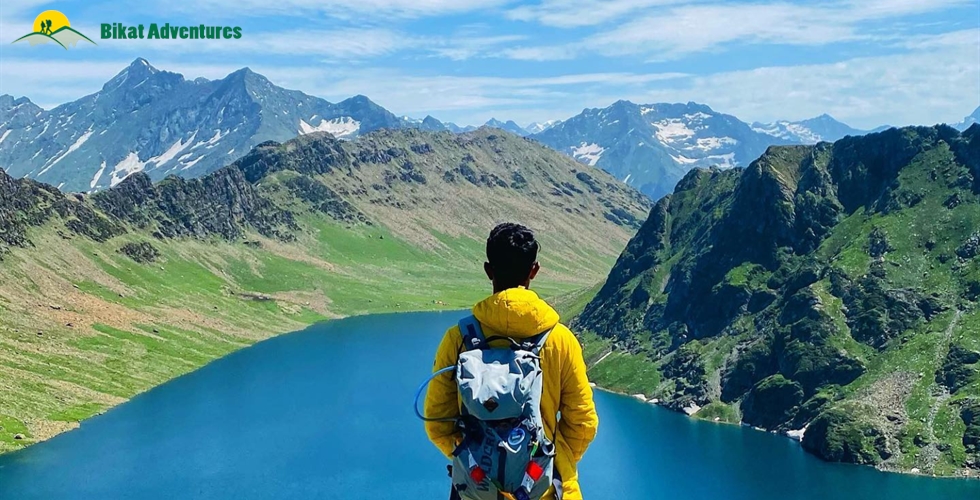
Tarsar Marsar Trek
A Shorter and Easier Alternative to the Kashmir Great Lakes Trek
Available Batches
August 2024, september 2024.
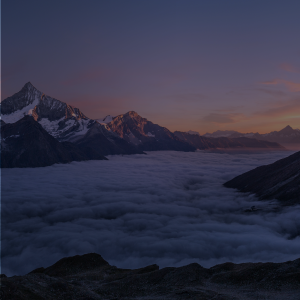
Brief Description
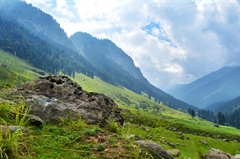
Brief Itinerary
Detailed itinerary.
Arrival at Aru (8,038 ft)-103 km drive
Report at Dal Lake gate number 1 at 12 noon. You will board a vehicle that takes you on a 2 hour drive to Aru, winding roads that take you through one of Kashmir’s famed tourist destinations of Pahalgam. Aru, our base camp for the Tarsar - Marsar trek, is another 12 kms ahead of Pahalgam. Stay overnight in tents at the open grassy campsite at Aru.
Aru to Lidderwat (9.022 ft)-8 kms
We head out into the tree cover, visible at a distance from the campsite, leaving behind the green pen pastures. The trek starts with a gradual ascend for 2 to 3 hours through a beautiful pine forest trail. A short level walk along the Lidder river thereafter brings you to a tea stall. Another gradual ascend for 1 hour and you can see the Lidder forest rest house in sight. Cross a bridge and get to the Lidder campsite on the other side of the river.
Lidderwat to Sekhwas (11,154 ft)-6 kms
The day’s trek starts with a moderate to steep ascent for 1 hour, followed by a level walk for another hour before we break for lunch, beside a gentle stream. We leave the tree line behind here, and ascend gradually for 1 more hour to reach the Shekwas campsite. From here one can get a good view of the surrounding mountains and the path heading up to the Tarsar lake. A short 1 hour hike from the Sekhwas campsite will take you to the small yet charming Jadar Lake. Return to Sekhwas and rest for the night.
Sekhwas to Tarsar Lake (12,467 ft) -4 kms
A trek to the first of the lakes, Tarsar, is on the agenda today. We trek uphill from the Shekwas campsite, keeping the stream flowing down to our right. The views of the mountains get grander and more snow-clad peaks become visible all around us as we approach the Tarsar Lake. 2 hours of trekking and the beautiful lake reveals itself amidst imposing mountain ridges on 3 sides. A wonderful opportunity to camp next to the emerald blue waters of Tarsar Lake. Spend the day exploring the trails around the Tarsar Lake only to witness the grandeur of the lake surrounded by majestic mountains. The beauty of the lake is that it changes colors depending on the time of the day, season and the angle from which one looks at the lake. Retire for the night.
Tarsar to Sundersar (12,960 ft) via Sonamous Pass (12,960 ft)- 6 km
Today, we have to cross the ridge which surrounds the Tarsar lake. An hour's climb to the top of the ridge and then we descend into the valley on the other side. The view of the valley leading to Zachmargi on the other side of the ridge is simply breathtaking. Upon descending into the valley, we walk along the stream which drains from Sundarsar. Set up camp at Sundarsar. Relax and admire the serene Sundersar Lake. Retire for the night.
Visit Marsar Lake (12, 946 ft) and go to Homwas (11,500 ft) via Marsar ridge (13,201 ft)- 9 km
Walking around Sundersar, we trek up and over a saddle on a ridge located on the far side of the lake. Marsar is an hour's trek away from here. The trail takes you to a vantage point which gives you unparalleled views of the Marsar Lake, which is almost always engulfed under clouds and mist. The weather this height turns bad fast and is unpredictable. So, after soaking in the beauty of the lake and its surroundings, we turn back towards Zachmargi from Sundersar. From here instead of taking the Tarsar pass and reach Sekhwas, we trek for 2 to 3 hours to reach the campsite of Homwas. Retire for the night.
Homwas to Aru (8038 ft) to Srinagar - 13 km. Drive 103 km to Srinagar
Today we depart the campsite of Homwas and take the same route we took at the beginning of the trek to reach Aru via Lidderwat. A two hours descent from Homwas will take you to Lidderwat and this time you can witness all the epic views that you had missed earlier on this trail. Passing through the pine forests of Lidderwat, we rest at Lidderwat for some time before resuming our trek to Aru which will take about 4 more hours to cover. Expect to reach Aru by 1600 hours and our vehicles will be waiting at Aru to drive you to Srinagar. Expect to reach Srinagar by 1900 hours.
What's Included
- Meals during the trek
- Forest Permits/Camping Charges/Permits, Trek Permit Fee/IMF Permission (Upto the amount charged for Indian nationals)
- Camping tents, Temp rated sleeping bags, mattress
- Safety Equipment includes static rescue rope, seat harness, carabiners, pulleys
- Mountaineering course certified Trek Leader with Wilderness Emergency Responder & Rescue. course from NIM Uttarkashi
- First Aid Certified Local guide, cook, helpers
- Porters or mules for carrying common luggage
What's Not Included
- Meals during road journeys
- Any kind of Insurance
- Any expense of personal nature
- Portage of personal backpack
- Any expense not specified in the inclusion list
- Transportation to and from Srinagar
Are you Eligible for this Adventure?
Located at an elevation of 4,000M, Tarsar Marsar Trek is a moderate level trek which for its difficulty level is suitable for anyone with some prior experience of high-altitudes.
Max Altitude

BRS Level Required
Tarsar Marsar Trek is a level 4 adventure on the Bikat Rating Scale.
TThis makes it mandatory for you tomhave high-altitude experience of preferably multiple treks marked at level 3 on the BRS. The altitude, the terrain, and the nature of the climb demand a certain level of endurance and a need for you to be aware of how your body reacts to the various features of the high-altitude environment.
If you do not know what level of BRS trek would suit you best, worry not! Fill out this Form:

we will send you a progression chart to help you comfortably get out of your comfort zone in order to level up and ultimately reach your highest potential in the big, bad world of outdoor adventure.
Packing List
This is a list of essential items for individuals doing the trek with Bikat Adventures. This list contains only those items which the participants are required to bring with them. The list excludes those items which are provided by Bikat Adventures on the trek. We have divided the items into five categories. All the items in the list are essential except for those marked as optional.
Trekking Gear
- Ruck sack bag with rain cover. Qty -1
- Day Pack Bag - Recommended for treks with summit day
- Head Torch with spare Batteries. Qty -1
- U V protection sunglasses. Qty -1 Here is how you can choose the best sunglasses for trekking.
- Water Bottles: 2 bottles of 1 liter each
- Non-skid, deep treaded, high-ankle trekking shoes Qty -1
- Pair of light weight Slipper/Sandals Qty -1
- Quick Dry Warm lower or Track Pants. Qty - 2
- Full sleeves T-shirts/ Sweatshirts. 1 for every 2 days of trekking
- Pair of thick woolen socks. 1 pair for every two days of trekking
- Thermal Body warmer Upper & Lower. Qty-1
- Undergarments. Qty - 1 for every day of trekking
- Warm jacket closed at wrist & neck .Qty-1
- Full sleeves sweater. Qty -1
- Rain wear ( Jacket & Pants ) . Qty-1
- Pair of waterproof, warm gloves. Qty-1
- Woolen cap. Qty-1
- Sun shielding Hat. Qty -1
- Personal toiletries kit (Small Towel, Toilet paper, paper soap, Bar soap, toothbrush, toothpaste, cold cream, etc.)
- Sun screen lotion small pack. Qty -1 Here is your Sun Protection 101 to stay safe in the bright sunny outdoors.
- Lip Balm small pack. Qty-1
- Small size, Light weight & Leak proof lunch box. Qty-1
- Plate. Qty- 1
- Spoon.Qty-1
- Tea/Coffee (plastic) Mug.Qty-1
Miscellaneous
- Camera (Optional)
- Carry your medicines in plenty in case you have any specific ailment. Consult your doctor before joining the trek.
- Dry fruits, Nuts, Chocolate bars (Optional)
Frequently Asked Questions
Eligibility, is this adventure good for me, what’s a good fitness benchmark for this adventure, what skills do i need to complete this adventure, what is the minimum and maximum age limit, about the activity, where is it located, what are some of its highlights, what are some of its challenges, what is the best season for this, what is the accommodation type, what is the temperature like here, is it technically challenging, connectivity, how do i reach the starting point, is there cellular network available throughout, where is the nearest atm, if i choose to travel to the base with you, what is the pick-up point, what time is the drop-off on the last day, what are the nearby attractions that i can explore, equipment & gear, what equipment is provided to us, what can i rent from you, where will i receive the rented items, where do i have to return the rented items, what gear do i need to bring, are there local shops to rent/buy equipment, facilities & additional services, can i offload my bag, can i leave any extra luggage i carry at the base of this adventure, what are the meals like, what are the washroom/ toilet facilities like, what should i do if i get my period on this adventure, what are the medical facilities available to me on this adventure, are there any electricity charging points on this adventure, mandatory documents, what documents do i need to carry, do i need insurance for this, do i need a permit for this, certification, do you provide a certificate of completion, when and how will i get the certificate of completion, international travel, will i need a visa, when should i apply for the visa, what kinds of insurance do i need to travel here, what is the specialty of this when compared to other mountain ranges, till which month can i make a booking for this, what is the qualification of the outdoor leader provided to us, how do you choose your outdoor leaders, is it safe for women, what is the ratio of outdoor leader to participants, what do you do in case of an emergency, what are the rescue options on this adventure, how do you choose your equipment, can i attempt this adventure if i have a specific medical condition, sustainability, what kind of camping do you practice on your outdoor adventures, why are you against fixed camping in the outdoors, how do you manage overcrowding on certain trails, what are some things to remember when using a dry toilet, why should i avoid wet wipes in the outdoors, where should i dispose of my sanitary waste if i am on my period, why should i carry my own utensils on an outdoor adventure, booking process, what happens after i make the payment, do you create a whatsapp group of participants before the start date of the activity, do i need to submit a medical certificate, do i need to submit an undertaking form.
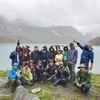
Small Group Size
Our batch sizes are capped at 15 for smaller treks with the trek leader and trekker ratio of 1:8. This ratio, in our years of experience, has proven to deliver the best trekking experience for individuals as well as groups. Capping the size of the group ensures individual attention to each trekker so that no signs of distress or need during the trek go unnoticed. It also helps to form a more cohesive cohort with better group energy which helps define the rhythm and pace of days on the trek. As you go higher up on the BRS scale, since the stakes are higher, expeditions have an even smaller group size with the ratio of expedition leader to climber set at 1:2.
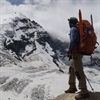
Qualified Trek Leaders
We follow a rigorous regime of hiring and training our experts in the field. Each trek leader is a certified mountaineer with years of experience in the field. In addition to their qualification, they also go through practical and situational training to tackle any and all kinds of sudden conditions that may present themselves on the ground. Being unpredictable is the core nature of the mountains but being ready for any circumstance as best as possible is a controllable asset that we try to nurture. Our field experts are also trained in basic medicine and first-aid response. Watch: Forerunners - The Making of A Trek Leader At Bikat Adventures
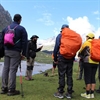
Guided Progression
Since Bikat Adventures is a learning-based organization, we help you climb up the ladder of difficulty within the sphere of outdoor adventure systematically. Our on-ground training modules are designed to handhold you through the upskilling process so that you are ready to take on bigger challenges.
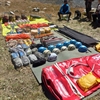
Equipment Quality and Check
All the gear used on our treks and expeditions is tried and tested, maintained for good quality, and is overall top-notch in quality and condition. We are continually looking to obtain the best of everything there is in the market so as to ensure optimum safety.
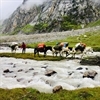
Support Systems
Along with the staff you see on-ground, we have a team of superheroes working in the background to give you the best experience possible. Our background team also comprises local staff from each area who know the region best. Having local support helps with studying the area, pre-planning, execution, and in receiving timely support in case of emergencies in these remote locations.
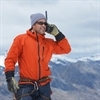
Communication
Our on-field staff is in constant contact with our teams based in primary locations so as to eliminate any avoidable delay in reaching additional help and support when required. We try to use the best tools for communication available, including satellite phones, in regions where they are not restricted.
What our customers Say

Cancellation Policy
Cash refund
Cancellations up to 30 days prior to departure date
5% deduction
Cancellations between 30 days to 15 days prior to departure date
50% deduction
Cancellations within 15 days prior to departure date
Voucher refund
Cancellations up to 5 days prior to departure date
No Deduction
Cancellations within 5 days prior to departure date
- Cash refund is applicable only in case of bookings made without using any promotional offer code or vouchers
- This is only a brief of cancellation terms. For finer details please refer Detailed Cancellation Policy.
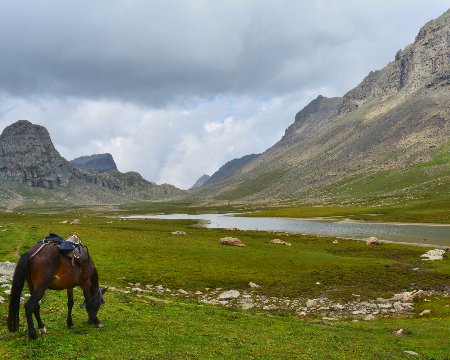
Subscribe for latest updates & offers
Similar adventures.

Hampta Pass Trek
An enchanting cross-over from manali to spiti.
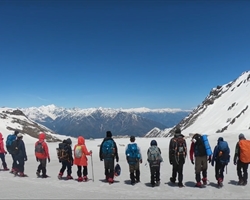
Buran Ghati Trek
Trek with the most thrilling rappelling experience.
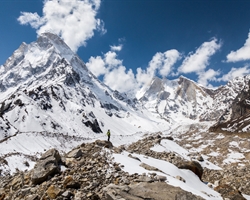
Gaumukh Tapovan Trek
Not just a trek but a journey to the source of river ganga.
Uttarakhand
Enter your Email
Events by categories.

Mountaineering

Scuba Diving
Events by months.
- January July
- February August
- March September
- April October
- May November
- June December
Events By Nights
- 5 & More Night
- Environmental Policy
- Privacy Policy
- Term & Conditions
- Work With Us
- Address: 303, 3rd Floor, Tower B4, Spaze Itech Park, Sector 49. Gurgaon
- Pre Sale - 8448680062 , Post Sale - 8588878499, 9667639126
Bikat Adventures
- Cancellation & Refunds
- Content Sharing
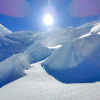
© 2024 Bikat Adventures - All Rights Reserved
Powered by: novel knett software solutions, submit enquiry.
Kashmir Mountains

Tarsar Marsar Lake Trek
7 Nights 8 Days
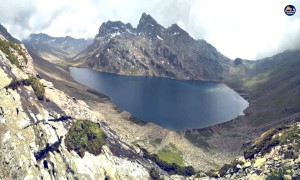
The trail is lined with lush meadows, crystal-clear rivers, and mesmerizing mountains and valleys. You can camp next to the emerald-blue lake of Tarsar. The best alternative for the Kashmir Great Lakes trek.
The enchanting Tarsar Lake and Sundersar Lake are the first features on the trail. The best part is that you can camp right next to these serene blue lakes, which are stunning and offer some of the most breathtaking views.
The Marsar Lake is the next stop on this path, and the dramatic views it offers are almost always covered by clouds. Marsar Lake is at a lower altitude, so you can see it from above, but it’s amazing how the clouds change every day. You have to get there early to see these amazing views.
What makes the trek to Tarsar Marsar Lake so appealing?
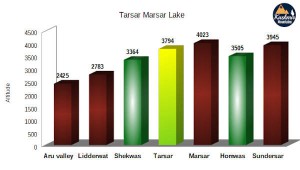
The tranquility of the surroundings is what makes the Tarsar Marsar Lake trek appealing. The expedition is a peaceful and nurturing journey to the stunning landscape. You can get a panoramic view of the entire landscape from the highest ridges on this scenic trek.
The trek is easy enough for anyone who enjoys the outdoors. The trek has a maximum elevation of 13,000 feet. The trek begins with a brief ascent before entering the dense forest. With the sound of the Lidder river and the chirping of birds, the trail through the pine forest is calming. After about 5 kilometers through the forest, the trail merges with a vast meadow. The Lidder river runs alongside the wavy meadow. When you get to the Lidderwat campsite, it’s a pleasant, easy walk.
Tarsar Marsar Lake Trek Itinerary
Srinagar city is known as the Venice of the East for its unique aquatic culture. The Numerous Lakes and Rivers are all interconnected through canal ways giving rise to a unique city known for its Lavish Houseboats which are intricately designed of pine wood. You will be hosted in these houseboats which are found nowhere else, Once you Arrive you will be taken for a ride around the lake Exploring floating vegetable gardens and islands on the Dal Lake. Overnight at Houseboat.
Brief Overview of the Day
- Srinagar to Aru Valley 107 km Drive
- Trek Distance – 10 Km
- Trek Duration – 5 Hours
- Max Altitude – 9,150 ft
- Night stay in tent.
Srinagar to Aru Valley 107 km Drive from Srinagar up to Aru valley via Pahalgam 3 hours drive.
Today we will start walking upstream towards Lidderwat. Soon we will enter a thick forest of conifer trees and you will be able to see Aru Valley down at a distance. After crossing the forest we will reach Nandekai Village which is mostly inhabited by seasonal migrating shepherds. The trek is an easy trail with a gradual ascent.
As we keep walking further we will come across a log bridge and we can rest here for a while before continuing our journey to Lidderwat which is about two hours away from this point. We will enter another wooded area which opens up at the meadows of Lidderwat village. We will be camping near the river for the night.
- Trek Distance – 6.5 Km
- Duration – 5 Hours
- Max Altitude – 11,000 ft.
The destination for today is Shekwas. As we start walking away from the Lidder river, we will enter a pine forest that is not very thick and has a number of clearings throughout the trail. There will be multiple clear water streams crossing our path so we don’t have to worry about the water supplies for today. As we keep walking we will enter another migrant village known as Homwas. Crossing a log bridge, we will enter Shekwas village. The meadows at this location are breathtaking which extends to a distance as far as eyes can see. We will trek a further higher from the village to reach our camping site.
- Trek Distance – 5 Km.
- Duration – 4 Hours
- Max Altitude – 12,449 ft.
- Night stay in camps at Tarsar Lake
The beautiful trail to Marsar starts with grassy meadows of Shekwas, a beautiful natural lawn. After walking on the grass for some time, we will cross over a hill to reach the first ridge. It will take around 3 hours from here and over a few more ridges to reach Tarsar. The view of the lake will keep unfolding magically before your eyes as we keep crossing the subsequent ridges. On the final part of the trail, we will come across a stream which we will cross by walking over bounders before finally stepping into the grassland around Tarsar Lake. This is our camping site for today and you can take your time to explore the beautiful area around the lake.
- Max Altitude – 13,000 ft.
We will wake up early and start walking to the adjacent valley of Sundersar via Tarsar Pass. This part of the trail is a bit difficult as the ascent to the pass is steep but it becomes an easy gentle walk down to Sundersar. The trail will take you through a high exit pass, grasslands, and through places filled with wildflowers. Once we reach the valley, we will trek over a trail filled with boulders along the stream to reach Sundersar lake and camp here for the night.
- Trek Distance – 9 Km
- Duration – 6 Hours
- Max Altitude – 13,400 ft.
We will start climbing up higher through the Marsar ridge. The trek is of moderate difficulty as you will find yourself walking over the boulders with melting ice which makes it difficult to walk. Watch your step carefully and follow your trek leader to avoid injuries. After crossing this area filled with boulders, we will start descending to a flat trail with many water streams crossing our way. The lake is located in a similar setting as the previous one. You will be able to see the snow melting from cliffs and feeding water to the lake.
After spending some time at Marsar Lake, we will make our way back to Sundersar Valley and from there we will walk to Homwas. Night stay will be in camps at Homwas.
- Trek Distance – 13 km
- Aru Valley to Srinagar 107 km Drive
Today you take the same route that you had taken at the beginning of the trek via Lidderwat. The trail goes downhill and it is a quick descent. It will take you 2 hours from Homwas to Lidderwat. The beauty of this part of your trek is that you will get to see all of those views that you had initially missed. The shrinking Kolahoi glacier is one of these sights. You will see the pine forests of Lidderwat that you had seen on day one of your treks in a whole new light. After getting some rest at Lidderwat, you head for Aru. It is a 10 km walk from Lidderwat to Aru. This takes around 4 hours to cover. Stop for lunch en-route, you are expected to reach Aru by 4 in the evening. Vehicles will be arranged from Aru to Srinagar. You will reach Srinagar between 7-8 pm overnight stay Houseboat.
After breakfast at houseboat. Our representative will drop you at Srinagar Airport.
Your trek includes
- Pick Up and drop off from Srinagar Airport.
- 2 Nights stay in Houseboat with Breakfast and dinner.
- Transfers from Srinagar to Trekking Start Point and return.
- Qualified Guide, and Support staff.
- Meals while on trek (Veg & Egg).
- Trekking Permits.
- First-aid medical kits.
- Flight tickets.
- Mules or porters to carry personal extra luggage. Note: Bag weight should not be more than 10 kg.
- Something not specifically mentioned under the pinnacle.
- Any kind of emergency evacuation charges.
- Things to Carry
Health & Safety
Cancellation policy.
- Trekking Shoes (Do not carry sneakers/ sports shoes. Carry shoes that has good grip and ankle support)
- Backpack (40 -60 litres): A backpack with sturdy straps and a supporting frame. Rain cover for a backpack is essential.
- Daypack 20 litres: On the day of the summit, you’ll need a smaller backpack to carry water, snacks and your medical kit. Bring a foldable backpack.
- Layers/Warm Clothes/Thermals
- Trek Pants/T-shirts/Undergarments as per your convenience. Carry the actual number required and stay light Sunglasses, Suncap, sunscreen.
- Hand gloves, socks 2 pairs and woollen socks
- Headlamp/LED Torch is mandatory
- Trekking Pole
- Poncho/Raincoat
- Cutlery: Carry a spoon, coffee mug and a lunch box. (Mandatory)
- Personal Medikit
- Toiletries: moisturiser, light towel, lip balm, toilet paper, toothbrush, toothpaste, hand sanitiser. Do not carry wet wipes. One 1 litre water bottle.
- Plastic covers: carry a few extra plastic bags for wet clothes. Make sure you take them back and not litter the mountains.
- Before starting the trek, calculate your BMI (Ideal BMI should be between 18.5 and 24.9)
- Health and Safety checks mentioned below should be made before getting prepared for the trek
- A balanced mind and body is the first thing that should be given importance before taking off, because this is what will bring out the best of you in every condition.
- Your body should be fit enough to cover the entire trek with the backpacks on your back along with your body weight. That is why proper stamina and strength is needed. Also because trekking is done in uneven multi terrains and not on smooth paths. So in order to gain leg strength, perform simple squats.
- Flexibility is very important when it comes to trekking. A good flexibility will be an advantage while walking on trails, climbing and river crossing etc. Attain flexibility by simple stretching or yoga.
- As the Himalayan treks are basically ascending and descending the slopes, you will need a proper transmission of Oxygen from the lungs and heart to the body muscles. For this, trekkers should have a good cardiovascular endurance that can be gained by doing cardio exercises like running, swimming, cycling etc.
It is good to make your booking two months prior in advance. In the event of cancellation of any trek/adventure activity due to any reasons, it is compulsory to notify us in writing. Cancellation charges will only be effective from the date we receive your request in writing.
If the trek is cancelled by us due to any reason (heavy snowfall, rainfall, natural disaster etc.) then the refund would not be initiated but you can go on the same trek another year. Kashmir Mountain Adventures Family is always with you, Thanks The cancellation charges are as follows:
- (No bank charges deducted will be Refundable)
- Up to 30 Days – 90% cost is Refundable
- Between 21 to 30 Days – 50% cost is Refundable
- Less than 20 Days – No Refund
- (Refunds are initiated in 7-8 business days)

17,500 + 5% GST
- Trek Overview
- Inclusions & Exclusions
- Photo Gallery
Need help? Talk to our Trek Coordinator on +91-9797130169
- Tarsar Marsar Trek
- GETTING THERE
- DETAILED ITINERARY
- COST INCLUSION
- CANCELLATION
- Jammu Kashmir
- Kashmir Valley Treks
- Moderate Grade Treks in Himalayas
- Monsoon Trek
- One Week Trek
Tarsar Marsar Trek: A Kashmiri Gem Unveiled
Embark on a captivating journey through the enchanting Kashmir Valley with the Tarsar Marsar Trek, a hidden gem that has been gaining the admiration of trekkers. This picturesque trek, adorned with secluded alpine lakes, meandering rivers, lush meadows, and vibrant wildflowers, unveils its magic during July and August.
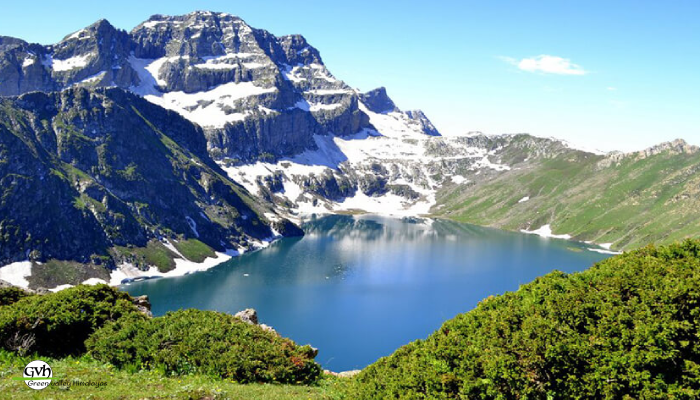
Trail Highlights:
- Trek Base Camp – Aru: Commencing from Aru, an upper valley beyond the famous Pahalgam town, the adventure unfolds. Aru sets the stage, leading us to the pristine Lidder River, surrounded by cedar and conifer forests.
- Lidderwat Campsite: A day’s trek along the Lidder River brings us to the mesmerizing Lidderwat, one of Kashmir’s most beautiful campsites. It marks the confluence of two streams, originating from the Tarsar and Kolahoi glaciers, shaping the Lidder River.
- Meadows of Sekhwas: Venturing into a valley on one side, the trail meanders through the lush meadows of Sekhwas, gradually revealing the beauty of Tarsar.
Brief Itinerary:
- Day 1: Start from Srinagar (or airport) by noon – Drive to Aru (~2440 m/8000 ft) via Pahalgam – 110 Km – 4 hours. Twin sharing tent accommodation.
- Day 2: Trek from Aru to Lidderwat (~2800 m/9180 ft) – 10 Km – 5/6 hours. Camp.
- Day 3: Trek from Lidderwat to Shekwas camping ground (~3380 m/11100 ft) – 6 Km – 4/5 hours.
- Day 4: Trek from Shekwas to Tarsar Lake (~3800 m/12465 ft) – 5 Km – 4 hours. Explore around. Camp.
- Day 5: Trek from Tarsar to Sundersar (~3950 m/12950 ft) via Sonamous/Tarsar Pass (~4000 m/13120 ft) – 5 Km – 3/4 hours. Camp. Visit Marsar Lake (~3960 m/13000 ft) in the afternoon and return to camp (2 hours).
- Day 6: Trek down to Lidderwat (~2800 m/9180 ft) via Shekwas – 14 Km – 6 to 7 hours. Camp.
- Day 7: Lidderwat to Aru (~2440 m/8000 ft) – 10 Km – 4 hours – Drive to Srinagar – 110 Km – 4 hours. Reach Srinagar city by 8 pm. Accommodation on your own.
- Day 8: Fly out of Srinagar
Important Notes on the itinerary:
- Ensure arrival in Srinagar by noon on Day 1. After the trek, return to Srinagar on Day 7 by 8 pm. Plan tickets and stay accordingly.
- Shared transportation from Srinagar to Basecamp Aru and return can be arranged. The fare is ₹5000 one way (Tata Sumo, 5 to 6 sharing), payable directly to the driver.
- The cost of the mandatory reserve day (Day 8) is NOT included in the TREK FEE. If used during trekking, an additional ₹2500 per person will be collected at Aru.
- If the reserve day isn’t utilized, return to Srinagar on Day 7 evening. Enjoy optional activities like a Shikara ride on Dal Lake or a houseboat stay in Srinagar.
Is this trek suitable for beginners?
Absolutely! Tarsar Marsar Trek is welcoming to first-timers, provided:
- You maintain a healthy and active lifestyle.
- Possess sufficient physical fitness to endure 5/6 hours of hiking daily with your backpack.
- Seek proper guidance, logistical support, and assistance with some personal clothing and gear.
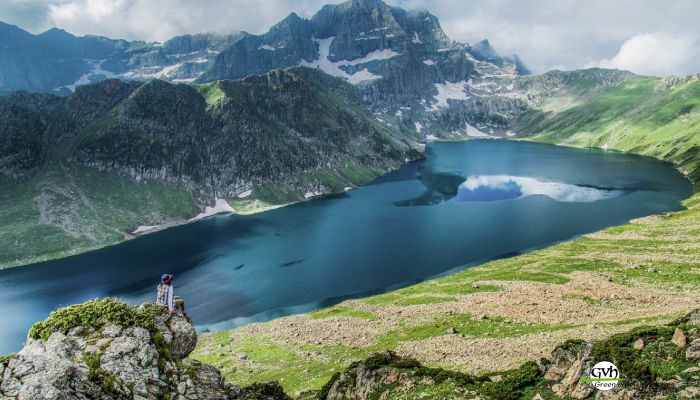
Best Season for Tarsar Marsar Trek: Weather Insights
The prime season for the Tarsar Marsar trek spans from late June to late September. July and August unveil the essence of Kashmir Valley with gushing brooks, verdant meadows, and wildflowers.
- After mid-September, meadows transition to hues of yellow. In October, as autumn sets in, expect colder weather.
- Anticipate a minimum temperature of 0° to 5°C at Tarsar or Sundersar campsites, with some windchill. A waterproof layer is essential.
Rains in July-Aug?
While there is no “monsoon wind” in Kashmir, July and August may experience occasional rain showers or thunderstorms, lasting around an hour. Be prepared with a waterproof layer.
Clothing Recommendations:
- Base layer (moisture-wicking): Quick-dry t-shirt, trekking pants (synthetic, wind- or water-proof).
- Mid layer (warm clothing): Warm jacket (synthetic, fleece, down jacket).
- Outer layer (weatherproofing): Windproof and waterproof jacket or poncho.
Remember, we don’t provide gear renting facilities, so it’s advisable to carry your own. Consult our comprehensive list of things to carry for a Himalayan trek and explore how to choose the right trekking gear.
Reaching Trek Basecamp (Aru near Pahalgam):
Our basecamp Aru, located 10 Km ahead of Pahalgam, is accessible via a 3 to 4-hour drive from Srinagar. We offer a shared car pick-up from Srinagar airport to Aru and return. A Toyota Innova charges ₹4500 one way (4 to 5 people can share), payable directly to the driver.
The most convenient way to reach Srinagar is by flight to Sheikh Ul-Alam International Airport (Code: SXR). Alternatively, the nearest railway station is in Jammu (Code: JAT), around 10 hours away from Srinagar.
Embark on the Tarsar Marsar Trek, where every step unravels the beauty of Kashmir. Join Great Himalayan Vacations for an unforgettable adventure, blending nature’s wonders with the thrill of exploration.
Duration: 6 days of trek; Srinagar to Srinagar in 7 days. Adding a mandatory buffer day it is 8 days, Srinagar to Srinagar.
Prerequisite: Prior trekking experience is nice to have. Good physical fitness is always desired in any trek.
Grade: Moderate
Physicality: 6/10
Trail Length: 50 Km
Highest Point: Tarsar ~ 3800 m/12465 ft, Marsar ~ 3960 m/13000 ft, Sundersar ~ 3950 m/12950 ft.
Seasons: July to September
Further Option: From Naranag drive to Sumbhol and trek to Tarsar and Marsar
Access: Trek starting point is Aru near Pahalgam, 110 Km from Srinagar
Railway station: Jammu Tawi (STN Code: JAT)
Airport: Srinagar (Code: SXR)
Upcoming Scheduled Dates for Tarsar Marsar Trek:
- For your convenience, you can review the scheduled Fixed Departure dates in the calendar provided within the Booking Form or the REGISTER NOW form. The starting dates of the tour are highlighted according to our 8-day itinerary.
- Currently, the BOOK NOW functionality is disabled. However, you can still receive all the necessary information via email by completing the REGISTER NOW form.
- In case you’re part of a group and the available dates don’t align with your schedule, you have the option to choose the Custom date mode. Simply click on “Select your custom date” and fill in the displayed form accordingly.
- You can also refer to our TREK CALENDAR to get a quick overview of all the available dates.
- Participants are required to arrive in Srinagar by noon on Day 1 of the trek. The return journey to Srinagar is scheduled for Day 7 in the evening, around 8 pm. Please make sure to arrange your tickets for both the inward and return journeys accordingly.
Getting to Aru (The Trek Base):
- We facilitate car pickups from Srinagar to Aru and return, with the cost shared equally among the team members availing the service.
- The most convenient option to reach Srinagar is by flight, with direct flights available from Delhi and other major cities.
- For those traveling by train, the journey involves reaching Jammu first. From there, a drive to Srinagar takes around 12 hours, covering a distance of approximately 300 km.
Arrival in Srinagar and Drive to Aru
Trek from aru to lidderwat, trek from lidderwat to shekwas camping ground, trek from shekwas to tarsar lake, trek from tarsar to sundersar via sonamous/tarsar pass, trek back to lidderwat, trek from lidderwat to aru and drive to srinagar, departure from srinagar.
Trek Fee: ₹ 15,500 per person (Aru to Aru) + 5% GST.
Inclusions:
All meals during the trek, including vegetarian options with occasional servings of eggs. Tea is served in the morning and evening. Accommodation in tents during the trek on a twin-sharing basis. Professional Guide, Cook & Helper. Porters/Packed animals to carry the central logistics. Camping equipment like Sleeping bag, Carry mattress, Dining tent, Toilet tent, Gaiters, Microspikes/crampons. Permit fee, camping charges, and forest levy as required in the trek. Basic Medical & First Aid kit. Travel and Medical Insurance Policy covering high-altitude trekking tours.
Exclusions:
Transportation from Srinagar airport to trek base Aru and return. ₹ 5000 one way for a Tata Sumo. Rucksack/Backpack offloading charge of ₹ 2500 for the entire duration of the trek if preferred. Any tip or gratuity to the HT support staff. Anything that is NOT mentioned in the “Inclusions” or personal.
- We assume that you have read and understood our “Terms & Conditions” ( https://greenvalleyhimalayas.com/terms-and-conditions ) before Booking a trek/tour.
- To reserve your place in a scheduled Fixed Departure trek or a Customised/Private trek pay 25% of the TREK/TOUR FEE as the initial “Booking Deposit” . You can pay by Net banking/Draft/Cheque/Credit/Debit/AMEX cards. This will ensure your participation in the desired trek and we will reserve your place on the scheduled date. You need to pay the remaining amount at least 15 days before the Trek Starting Date .
- If you book a Trek/Tour before 14 days or less from the Trek/Tour Starting Date, you need to pay the full TREK/TOUR FEE .
Cancellations:
- “Booking Amount” i.e. 25% of the TREK/TOUR FEE is Non-Refundable at any stage.
- If in case you are not able to make it due to unavoidable reasons (s), we provide you a very flexible choice of Shifting to another trek within the next one year . One year is counted from the starting date of the trek/tour you booked initially with us.
- In case you postpone your trip you need to inform a minimum of 15 days before the trek/tour starting date. (Though we suggest to inform us earlier if know)
- In case you postpone a trek/tour 15 days before the scheduled Trek/Tour Starting date or prior , you may shift to another group of the same trek/tour scheduled in the same season or within the next one year. You may shift to another suitable route also. For changing any, you need our approval first. Your request must be in written communication through your registered email with us.
- If you cancel/postpone a trek/tour from 14 days to 8 days before the tour starting date , your Booking Amount is Non-Refundable. We will not take any requests for shifting dates. We will charge 50% of the amount as Cancellation Charges and process a refund of the remaining 50%. You may also shift to another group within next year but 25% Booking Amount will be deemed as Cancellation Charge and the rest amount will be transferred to the shifted group.
- If you cancel a trek/tour 7 days (i.e. a week) before the Trek/Tour Starting Date or later , there will be NO REFUND.
- In case of any unforeseen incident including but not limited to natural calamities like flood, earthquake, landslide, forest fire, or any political unrest, if we are compelled to cancel the trek/trip, you will be entitled to redeem the full amount for the same/similar kind of trek/trip within next one year.
If you need more clarifications write to [email protected]

Leave a Review
Cancel reply.
Save my name, email, and website in this browser for the next time I comment.
Tour Reviews
There are no reviews yet.
You May Also Like
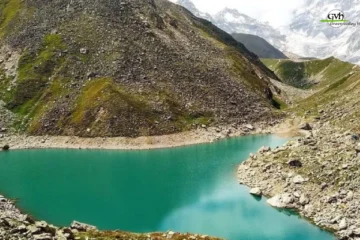
Satopanth Tal Trek

Char Dham Yatra 2024

Har Ki Dun Trek
Get best quote.
Fill this will get in touch for further details
Tarsar Marsar Trek: One of the Most Beautiful Trek in Kashmir
The ethereal beauty of Kashmir is undoubtedly impressive, which infatuates poets, nature lovers, and tourists. The state’s landscape is embellished with snow-covered mountains, velvety green meadows, fast-flowing rivers, alpine forests, beautiful alpine lakes, and whatnot. Truly, Kashmir deserves the title of “Heaven on Earth".
Keeping aside the natural beauty, Kashmir is also the place of several popular Himalayan trails. Tarsar Marsar trek is one of them.
The trail you follow on the Tarsar Marsar lake trek is unbelievably beautiful. In this extensive guide, I am going to discuss all the facts, attractions, and aspects of this trek.
Tarsar Marsar Lake
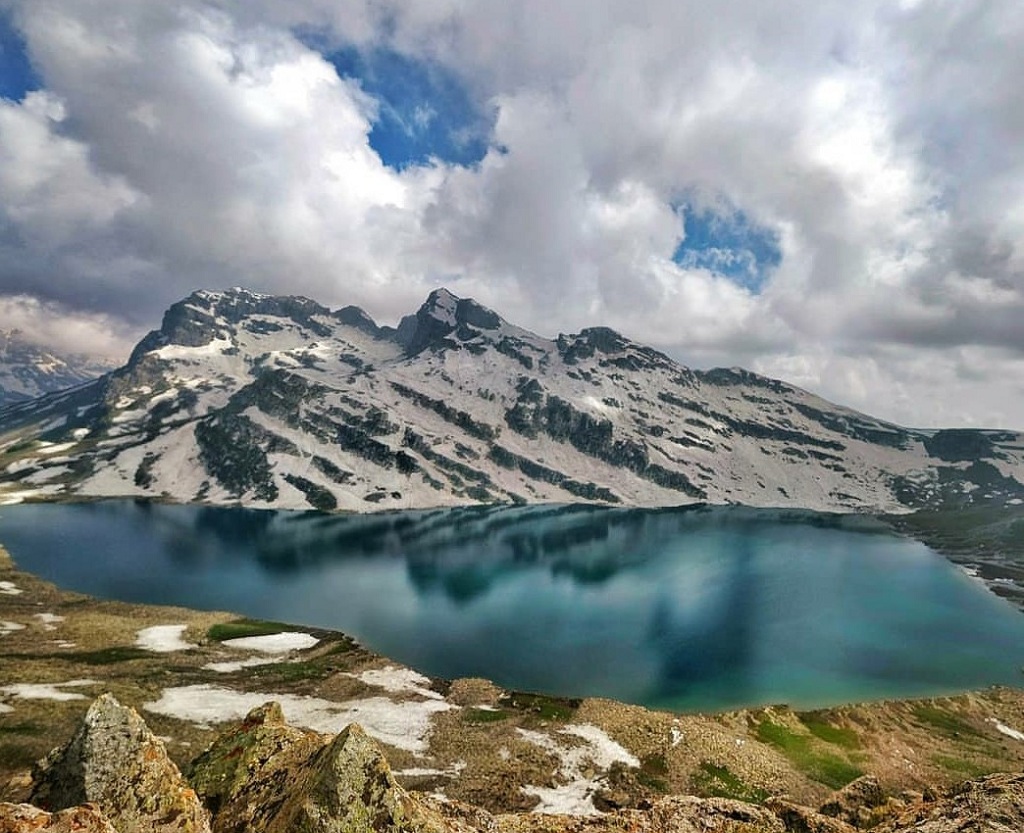
Tarsar Lake and Marsar Lake are two alpine lakes situated at the altitude of 12500ft and 13000ft respectively in the Kashmir Himalayas.
These two lakes are of similar nature and separated by a mountain. This is why they are called twin sisters.
Tarsar Marsar's location is 20 km to the east of Kolahoi Mountain in the Anantnag district of Jammu & Kashmir. Marsar Lake is specifically in the neighboring area of Dachigam national park. The exquisite Tarsar Marsar lake location and the incredibly pretty landscape of the area are the two things that have made people crazy about this trek.
Best Time to Visit Tarsar Marsar
The best time for the Tarsar Marsar trek is from April to September.
The trail of the Tarsar Marsar trek in May remains clear and the landscape greener. Trek to Tarsar Marsar in June is again a good time to go for.
The best time of all for the Tarsar Marsar trek in August and September. In these two monsoon months, there is little rainfall in the Kashmir valley and the weather remains clear and tourist-friendly.
Weather and Temperature
July to August is the coziest time for this trek. The daytime temperature roams around 15 to 18 degrees when sunny. In cloudy or rainy weather temperature ranges from 4 to 5 degrees. But at night temperature falls drastically to 1-3 degrees.
From mid-August to September Tarsar Marsar weather starts becoming colder. During this time temperature at night fluctuates from -3 to -5 degrees.
Tarsar Marsar Trek: Quick Facts
- Altitude Range: 7950 ft to 13,400 ft
- Location: Anantnag District, Jammu & Kashmir
- Duration: 7 Days
- Difficulty Level: Easy to Moderate
- Total Distance: 47.6 Km
- Starting Point: Srinagar
- Ending Point: Srinagar
- Base Camp: Aru
- Best Time to Visit: April to September
- Temperature: 15 to18 degrees (Highest), -3 to -5 degrees (Lowest)
- Nearest Airport: Sheikh-Ul-Alam International Airport, Srinagar
- Nearest Railway Station: Jammu Tawi
- Nearest ATM: Pahalgam
A short glimpse of the complete itinerary
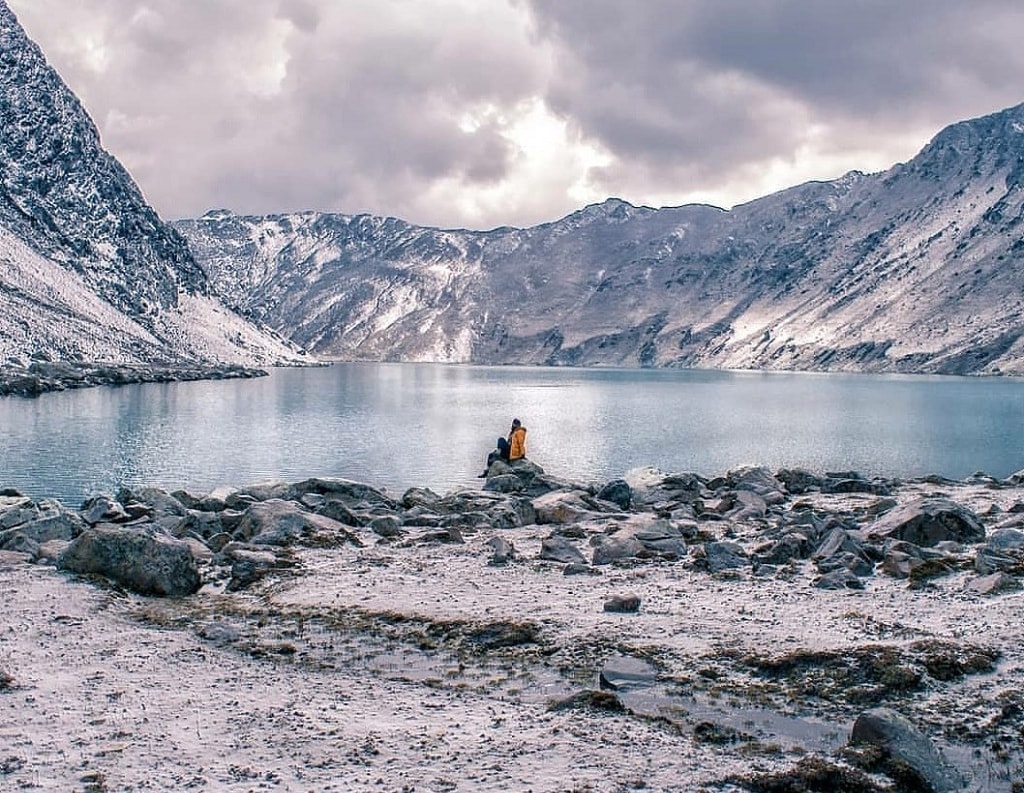
Your journey starts at Srinagar . Our pick up and drop service will drive you to the base camp at Aru via Pahalgam. The total distance is 112 Km you cover by the road that takes 3 to 4 hours. On the way, the best view is the apple orchards and alpine trees. Aru is a picturesque hamlet at the banks of Lidder river at 7959 ft altitude where you spend the first night of your trip.
On the second day say goodbye to Aru and start an easy 10km long ascent following the upstream of Lidder river. You have to trek for 6 hours on the second day. After crossing some local Gujjar settlements and two freshwater creeks you step into Lidderwat valley. The enchanting birds-eye view of Aru valley and Aru village will motivate you to proceed further. The journey for this day will end with camping at Lidderwat valley tucked at 9150 ft, close to the Lidder River.
On day 3 the journey of 5.5 Km starts from the meadow of Lidderwat and finishes at the valley of Shekwas. It generally takes 5 hrs.
From Lidderwat valley the trail follows the Lidder river and enters a pine forest. A wooden bridge will take you to the other side of the Lidder river and after half an hour hiking along the river, you will reach Homwas, a small dell.
Right after Homwas the path is straight and comfortable but not for so long. Trek a steep ascent afterward through a forest of Bhoj trees and some more valleys and clearing you to step into Shekwas, another meadow at 11000 ft where you spend the night in a tent.
The best time for the beautiful alpine lakes you are going to encounter in this trek.
The trail makes you cross several ridges on mountain streams. After steep climbing and trekking for two hours, you will get the first glimpse of the beautiful almond shaped Tarsar lake. The site energizes the beholder to reach the lake as quickly as possible. Trek to Tarsar lake at 12500ft height takes 3 to 4 hours to complete and covers 5 Km distance on this day.
The crystal clear water of Tarsar lake is quartz blue at night, seems like dreamland amidst snow covered mountains.
On day 5 you will witness surpassing beauty on your way from Tarsar to Sundersar lake. The trek starts from Tarsar valley and heads towards Shekwas valley. Following the streams and shepherd’s trail, you will pass through lush green grasslands leaving behind Bakharwal Thatch.
A hike of a total of 5 km taking 5 hours will unfold the coveted Sundersar lake and the valley adjacent to it. The journey for the day ends here with camping at 13000ft altitude at the lakeshore.
The next day your destination is Marsar lake from Sundersar valley.
Traversing the Sundersar Lake you will reach the other side where you have to follow the shorter pass out of two passes. Following a steep ascend through a boulder-filled area you will get into an amazingly beautiful green meadow, and streams intersecting it.
On this day (Day 6) the trek demands you to cover 9 Km in 7 hrs.
Marsar Lake is visible only after you climb to the ridges. Marsar, the twin lake of Tarsar is located at 13400ft. The lake is elusive, remains hidden behind the curtain of clouds most of the time. The landscape of the Marsar lake at the base of mountains from an overhanging cliff is the best attraction of this trek.
On day 7, towards the end of the trip, you head back to Homwas through Jagmargi valley, trekking 13 Km in 6 hrs.
Tips for Tarsar Marsar Trek
- Tarsar Marsar Kashmir trek is 47.6 km long from the base camp. The trek takes you to the highest 13400ft on the mountain. Therefore, acute mountain sickness is common among first-timers or to those who are more prone to AMS.
Carry medications, check oxygens level, and be attentive to your body. If feeling uneasy then drink water, take medicines, and rest for hours. If you are still not well then discontinue the trek.
- Tarsar Marsar is a monsoon trek, so never forget to pack a raincoat, plastic bags in your backpack. Also, carry a waterproof cover for your backpack.
- Pahalgam has the last ATM, but do not rely on the last ATM as it runs out of cash frequently. Withdraw cash at Srinagar or even before that.
- Mobile service works till Pahalgam. Also, the prepaid SIM does not work in Kashmir. So better take a postpaid phone connection especially for this trek.
- Electricity is available till the base camp of Aru. Also, in Aru, there is no power backup, so if the electricity service shuts down it takes some time to come back. Therefore, carry a torch and some batteries with you.
- Do carry the original and a copy of the government-issued identity card. Voter card, Aadhar card, passport, driving license - any one of these is enough. Before trekking, you need to submit the documents to the forest department. Without this step, no one is allowed trekking.
How to Reach the basecamp
To get to the trek you must reach Srinagar. Don't forget to report at the tourist report center of Srinagar.
To Srinagar
Srinagar is well connected with the rest of the country by train and airways.
Most airlines operate flights to Srinagar’s Sheikh-Ul-Alam airport. Metro cities like New Delhi, Chennai, Bangalore, Kolkata, Mumbai are directly connected to Srinagar by air.
The nearest railway station to Srinagar is Jammu. Jammu is again well connected to major junction stations of India.
From Jammu, one can take a flight to Srinagar which takes merely 40 minutes, or take a direct bus that takes around 10 hrs. Taxi and cabs are other options too taking 8 to 9 hrs to reach Srinagar.
Srinagar to Aru(basecamp)
At Moxtain, we provide you with pick up and drop car service from Srinagar to Aru and Aru to Srinagar.
If you want to arrange transportation on your own, then both shared cab and private cab services are available from Srinagar to Pahalgam. From Pahalgam, you need to change your taxi.
However, no bus service is available to Aru.
Difficulty Level of Trek
Tarsar Marsar trek level is easy to moderate. Some portions of the trail have rough patches, steep ascent or descent, and boulder-filled zones that make this trek a little tricky for beginners.
The difficult descent through the pass that comes after Sunderser lake, towards Marsar lake may be the biggest hurdle for any first-timer. Still, a well-prepared individual with good quality trekking shoes can easily overcome it.
If you don't have any experience of trekking but are committed and very passionate about taking this trip, then prepare yourself mentally and physically for 2-3 months.
For experienced trekkers, this trek is a big YES to go for.
Lastly, the Tarsar Marsar lake trek has a lot to offer. There are a very few lake treks in the Himalayas which are as magnificent, as bold, and beautiful as this is in terms of scenery, and the mild challenges the trail throws to trekkers.
So, whatever your experience level is, this trek technically is for all except small children, family, and aged people.
Is This Trek Safe
This trek is absolutely safe because the trail is located in a remote part of Kashmir, far away from urban settlements, and no probability of agitation and skirmish.
The only time when you come in contact with civilization is when you commute from Srinagar to Aru or return to Srinagar by road.
During this time, if you suddenly encounter unrest or a sudden curfew imposed, then don’t panic. Taking some precautionary measures can save you from an unpleasant and dangerous situation, like-
- Stay in tourist areas, never try to explore unknown areas and downtown on your own.
- Before booking any private transportation, ask for details and try to verify the information you have been provided with.
- Stay alarmed and informed with local news, be vigilant about what is happening around you.
Tarsar Marsar Kashmir trek is operated with professional trek leaders who have sound knowledge of the respective terrain and other local circumstances. They are trained to handle AMS and other medical attention initially. The trek is also organized for a span of 7 days so that you can acclimatize well and handle the physical strain of the journey.
Deals And Offer
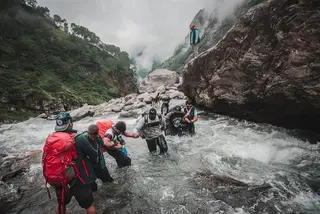
Hampta Pass Trek
4.87 ( 438 ), hampta pass trek 2024 - chandratal lake trek | moxtain, free cancellation till 30 days prior trek, rental & gear available on rent, book with 20% initial amount.
See Dates / Book Now
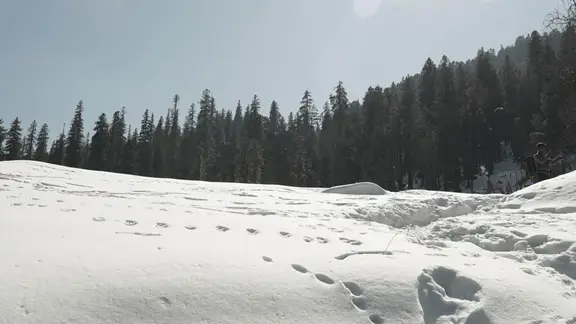
Dayara Bugyal Trek
4.85 ( 398 ), dayara bugyal trek 2024 - 6 days trek | moxtain.
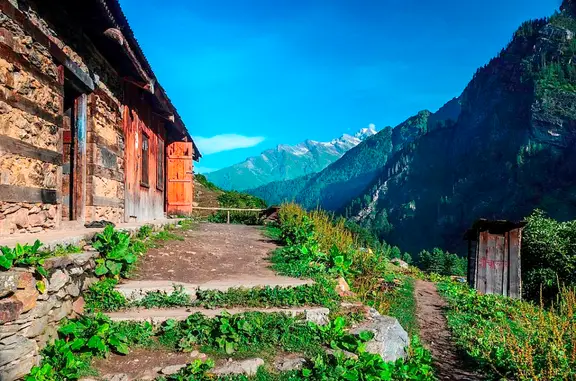
Kasol-Kheerganga-Tosh-Malana-Trek
4.56 ( 24 ), similar blogs.
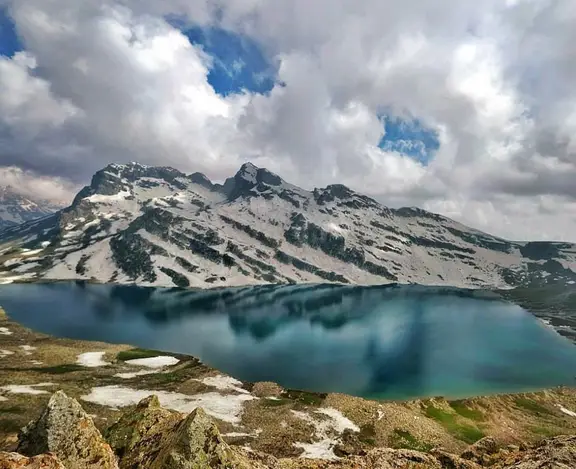
Kedartal: The Glacial Lake Trek in Garhwal Himalayas
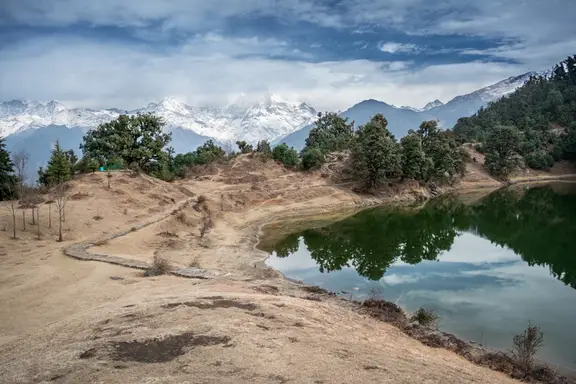
Deoriatal: Weekend Trek in Uttarakhand
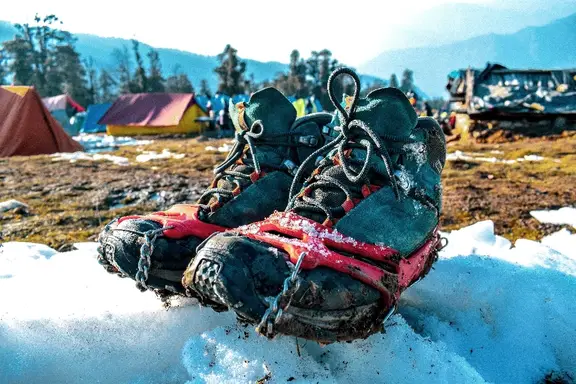
Crampons Vs Microspikes: What To Use For A Trek?
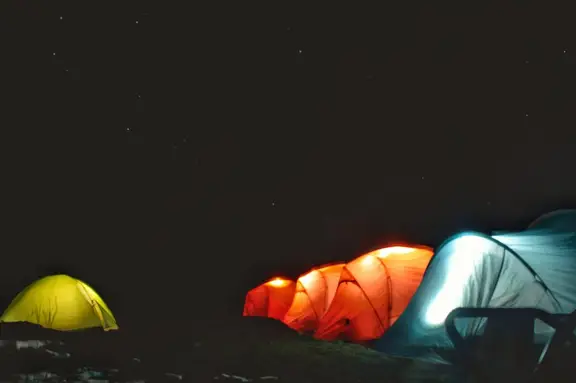
Toilets facility at the campsites
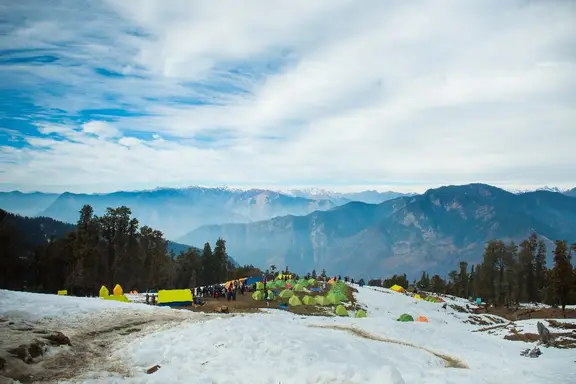
Top 11 Adventure Activities In India For Brave Hearts
Similar trips, everest base camp trek, stok kangri, annapurna base camp trek, goechala trek, nag tibba trek, deoriatal chandrashila, sandakphu phalut trek, bara bhangal, mayali pass.
 (1).webp)
Nafran Valley Trek
 (1).webp)
Kashmir | India
Max Altitude
Trekking Km
Moderate to Difficult
Help & Support
15450 /person $ /person.
- August-2024
- +5% GST (goods and services tax)
- Services from Aru to Mondlan.
- Meeting Point & (Pickup/ Drop Point) & Tourist reception center, Raj Bagh, Srinagar
Reporting Time : 12:00 pm. Drop Time : 6:30 pm to 7:30 pm (Timings are subject to change based on weather and road conditions).& Please reach Srinagar a day before to avoid any delays.
Insurance 245
Insurance is Mandatory.
Non-Indian rates are slightly higher. Trek coordinator will provide balance payment link post-booking.
- Get insurance through us or elsewhere. If not through us, email for a refund after booking.
Cancellation 4 or more days before the start of the trip results in a 100% cash refund.
Cancellation less than 4 days from the start of the trip results in no refund.
Transport 1600
Transportation Srinagar to Aru & retun is optional
Choose add-ons during booking. If missed, log in and add them later
Book transportation at least 10 days before the trek.
Cancellation less than 4 days from the start of the trip results in a 50% cash refund.
Cancellation after the trip date does not qualify for a refund.
Offload 5000
Backpack offload is optional
Choose add-ons during booking. If missed, log in and add them later.
Book off-load at least 10 days before the trek.
For offline bookings at the base camp, a convenience fee of Rs. 5500 applies.
Cancellations made before the trip date will receive a full refund.
For more information. Please complete this form.
Trek Name: Nafran Valley Trek
Adventure Type: Trekking
Base Camp: Aru
Season: Monsoon | Autumn |
Month: July | August | September |
Country: India
Altitude: 13800 Ft.
Grade: Moderate to Difficult
Rail Head: Jammu
Stay: Camping (Twin sharing) & Hotel/Guesthouse
Food: Meals while on trek & at Hotel/Guesthouse (Veg & Eggs)
Location: Kashmir
Distance: 56 Km.
Trail Type: One way trail | Camping in various locations, starting and ending at the different point.
AirPort: Srinagar (sheikh ul-alam international)
Why Nafran Valley Is A Must-Do Trek?
The beauty of Kashmir is simply bewitching and treks like Kashmir Great Lakes Trek and Tarsar Marsar Trek stand as great examples. While these two treks are immensely popular, there are many other trekking trails in Kashmir that are equally as beautiful and unfold in front of you the pristine and untouched beauty of Kashmir Valley. Nafran Valley is one such trek.
The trek to Nafran Valley starts from Aru village which is about 112 km away from Srinagar. Throughout the Nafran Valley Trek, you will cross varied sceneries from green meadows, and mystical jungles to an alpine lake - a complete bouquet for a trekking enthusiast. Aru Valley, Harnag Lake, and Nafran Valley altogether make this trek an interesting destination for trekking in Kashmir .
The meadows of Nafran Valley are inhabited by shepherds between June to October and stay in mud houses. During these months you will see a lot of cattle and horses grazing in the Nafran valley and in winter these shepherds descend down to lower altitudes when the Nafran Valley isn’t habitable anymore.
If you are planning an offbeat adventure in Kashmir then the Nafran Valley Trek is an amazing choice. This is a high-altitude trek so there are chances of AMS.
Pay close attention to your body and keep alert if you notice any signs of AMS. If you do not feel well, are nauseated, or have a headache, you should immediately report to your Trek Leader so that immediate measures can be taken.
About The Trek
Nafran valley trek starts from aru village near pahalgam and takes 7 days to complete the entire trekking adventure..
Day 1: Starts with a scenic drive from Srinagar to Aru Valley from where the Nafran Valley Trek starts. Reach Srinagar one day before the journey. Our representatives will pick you up from Srinagar and drive you all the way to Aru. The next day we start the Nafran Valley Trek from Aru to Araam Pathri, through a forest walk.
On Day 3: We trek from Araam Pathri to the gorgeous valley, we will stay in the valley for two nights. On the second night, we will go on an acclimatization walk to the beautiful Harnag Lake. The emerald lake presents a serene environment to rejuvenate yourself. The following day, we trek from Nafran Valley to Aaram Pathri. Aram Pathri is a big open meadow where you will camp for the night. This meadow gives a beautiful experience of what trekking in Kashmir is like.
Leaving this idyllic campsite behind, we trek towards Bhaj Margi, which is another large clearing with shepherd dwellings. This is the last leg of our Nafran Valley Trek. From Bhaj Margi, on the last day, we will trek to Aru and drive back to Srinagar ending the beautiful Nafran Valley Trek.
What To Expect At The Trek?
Nafran Valley Trek is a moderate to difficult grade trek. This means to embark on this trek, you need to have a good level of fitness and prior experiencewith a Himalayan Trek can be helpful. The trail is a blend of ascents and descents, and quite steeply so in some places. The trek takes you to an altitude of 14,127 ft and is a short trail with steep ascents, which can increase the difficulty level.
You can experience a series of unique landscapes on this trek. Apart from the lovely meadows, you will get to see jungles, glaciers, river streams, and even an alpine lake. The Nafran Valley Trek will surprise you with its sheer beauty. Between the months of June to October, you can see the Nafran meadows inhabited by shepherd troops, who then descend to lower altitudes as the weather gets colder. In the Nafran Valley, you will get to see the lifestyle of a shepherd who lives in the Nafran Valley feeding their livestock and earning a livelihood.
The best time to visit Nafran Valley is from the month of July to Septembe r when the entire valley is blooming with wildflowers and is verdant green. With the onset of July, the snow in the Nafran Valley begins to melt unveiling the green carpet of grass beneath and it also receives the most rainfall as compared to other months making the green even more striking. August is the blooming season, the valley is lush green with cattle grazing all over the valley. In September, the flowers begin to reduce but the valley is beautiful nonetheless and the skies are clear and beautiful. The temperature during these months stays between 12°C to 18°C in the daytime and 5°C to 10°C at night.
- Who can Participate
- Important Links
- How to Reach
- Trek Essential
Who Can Participate
- Age; 12 years +.
- First timers can apply; previous trekking experience is more appreciated.
- The climber must be fit and have sufficient stamina to cover 5 km of distance in 35 minutes without stress.
- The climber should be able to carry a 10-15 kg backpack.
Drive From Srinagar To Aru
- Altitude: 2,400 m/ 7,950 ft.
- Drive Distance: 112 km | 4 hrs.
- Stay in Home Stay.
The trek starts from Aru village. We will begin our journey from Srinagar and drive about 112 km from Srinagar to reach Aru. Arrive at the designated pick-up point and our representatives will pick you up and drive you to Aru. From Srinagar, we will drive to Pahalgam which is 100 km away from Srinagar and Aru village lies 12 km away from Srinagar across the Lidder River.
Aru is a fairly developed tourist spot, located on the bank of the Lidder River and is also the base camp for the popular Tarsar Marsar Trek and the Kolahoi Glacier Trek. It is also a hub for adventure activities like horse riding and heliskiing in winter. Trout fishing in the Lidder River is also a popular sport here. Network connections are not very stable in Aru and all network connections don’t work there so you need to have all your communications wrapped up at Pahalgam. We will be staying in camps at Aru and our campsite is located in a beautiful location by the Lidder River.
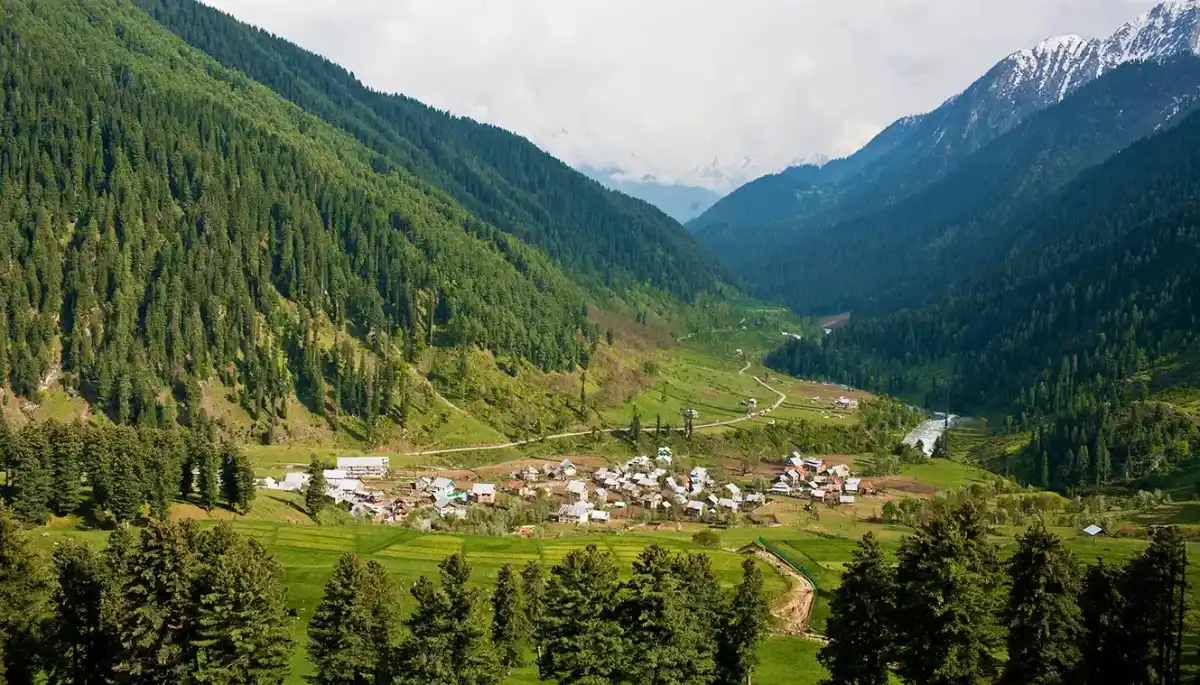
Trek From Aru To Araam Pathri
- Altitude(Araam Pathri): 2,950 m/ 9700 ft.
- Trek Distance: 12 km | 5-6 hrs approx.
- Stay: In camps (twin sharing).
This is our first day of trekking in Kashmir and today we will trek from Aru to Arram Pathri. The trek starts with a gentle uphill climb and after walking for about 800 meters, you will enter a forested zone. Continue walking and after some time the trek forks into two. The left trail leads to a clearing with a vantage point. It takes about 3 hrs to reach. The right path, on the other hand, leads us to our campsite.
Follow the trail on the right which will lead you to a muddy patch. There’s also a higher road that can be taken during the rainy days when there is too much mud but it is not accessible most of the time. Once you reach the muddy patch, it’s a steep uphill climb of about 500 meters at the end of which you will reach a shepherd settlement called Geerwad. From here on, you will walk on grasslands and forest covers all the way to a small riverside clearing. This is Gagad Pathri. Araam Pathri is yet a little ahead. On the way to Araam Pathri you will find an abandoned hermit’s cave and even remains of an ancient fort. Walk a little further and you will cross an wooden plank bridge to get on the right side of the river followed by another crossing that will again take you to the left side of the river. Here, you will observe a couple of mud huts that serve as the summer dwellings of the shepherds. This clearing is called Kansal Pathri. Keep walking uphill along the ridge on your left towards Aaram Pathri. Once you reach a section with a cluster of Gujjar huts, you know you have reached Aram Pathari. Upon reaching Araam Pathri, we will find a suitable location to pitch the camps.
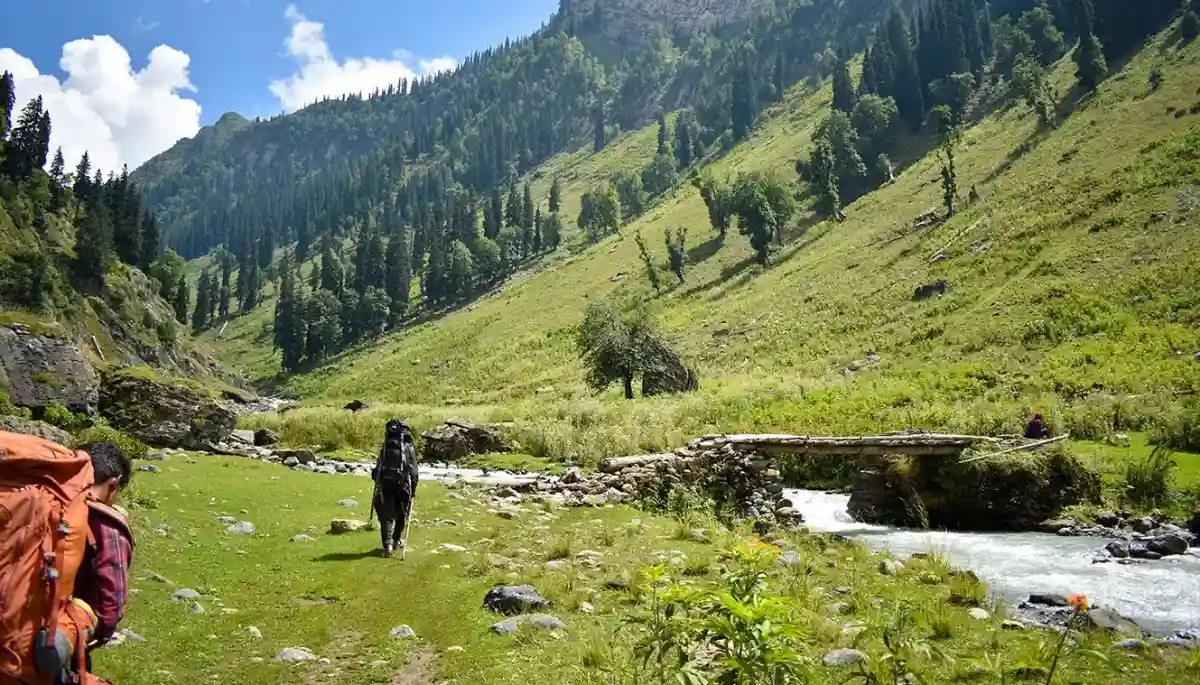
Trek From Araam Pathri To Harnag Lake via Harnag Pass
- Altitude(Harnag Lake): 3,650 m/ 12100 ft.
- Altitude(Harnag Pass): 3800m/12500 ft.
- Trek Distance: 10 km | 6-7 hrs.
- Stay: In tents (twin-sharing).
Today we will trek from Araam Pathri to Harnag Lake via Harnag Pass. The climb up the pass is steep and also has some rocks and boulders along the way. Be very careful in the rocky section as some buolders are quite slippery due to a stream flowing from the top of the pass. As you reach the Harnag Pass, from the top you can see the wide Nafran Valley below and you will also spot the Harnag Lake. The descent to Harnag Lake has a similar terrain as during the ascent. Once you reach the Harnag Lake, sit for a while and enjoy the serenity. Tonight we will camp by this beautiful lake.
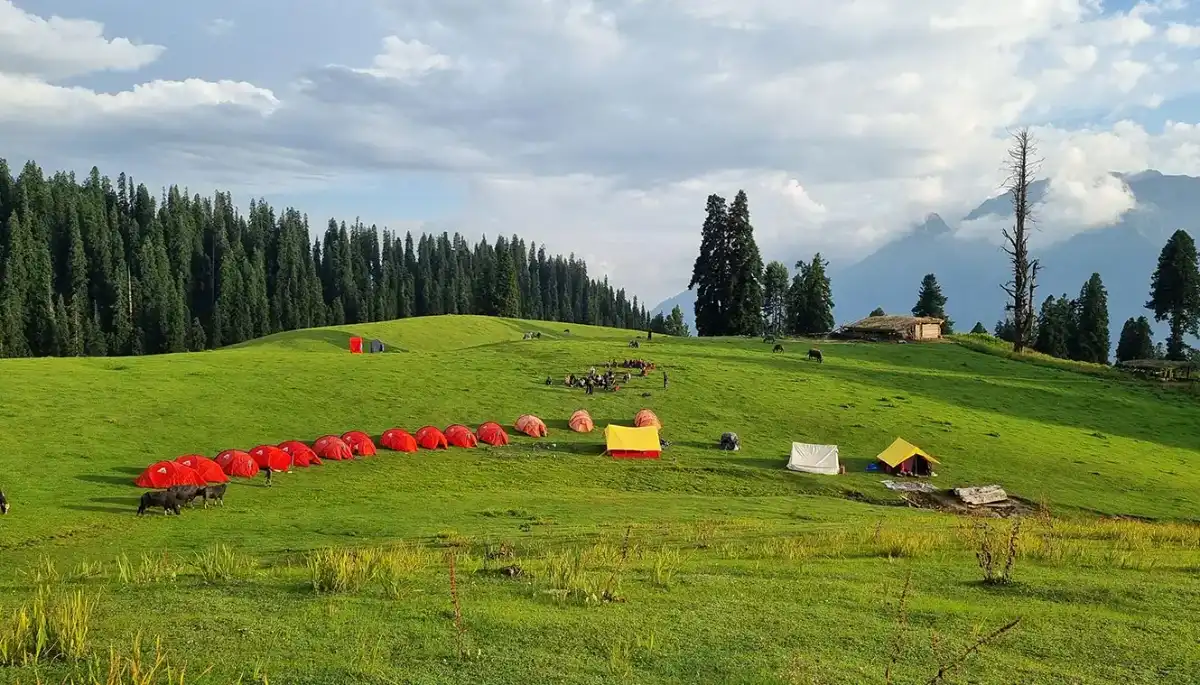
Trek From Harnag Lake to Harbhagwan Lake and back to Harnag Lake
- Altitude(Harbhagwan Lake): 4200 m/13800 ft.
- Trek Distance: 8 km(Both way) | 5-6 hrs.
- Stay: In tents (twin-sharing).
Today’s hike is going to be challenging. You’ll start on a clear trail in a wide valley, which gradually becomes more hilly. After crossing two streams about 2 km from Harnag Lake, you’ll arrive at the Kolahoi glacier viewpoint. Here, you’ll get an amazing view of the massive Kolahoi glacier at the edge of Mt. Kolahoi on your left. Take a moment to enjoy the sight of the glacier in the valley—it’s not something you see every day! You’ll also notice the east face of Mt. Kolahoi.
Look to the right of the glacier to spot a pointed peak. This is the gateway to Harbhagwan Lake. The trail gets steeper here, with a tough 2 km climb ahead. You’ll gain about 2,264 feet in altitude during this stretch, so take it slow and watch for signs of high altitude sickness. If you experience any symptoms, descend immediately.
The ascent begins on soft, grassy terrain with many boulder sections. Be careful on the boulders, as they can cause slips, falls, and ankle twists. Once you reach a flatter area on the ridge, the trail fades away. Follow the stream flowing from the top—it will lead you straight to Harbhagwan Lake. Harbhagwan Lake is incredibly beautiful, set in a stunning location. Big chunks of ice break off the hanging glacier and feed the pristine blue lake. After spending some time by the Harbhagwan Lake, we will descend back to Harnag Lake.
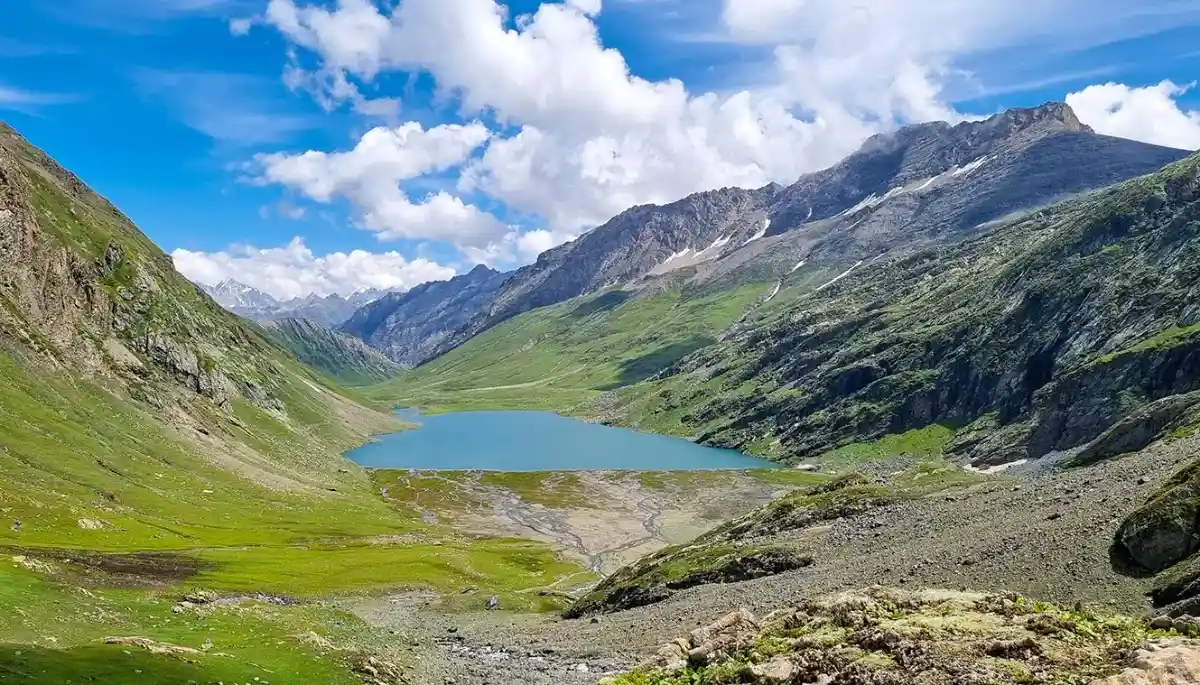
Trek From Harnag Lake to Dhingapani (Nafran Valley)
- Altitude(Nafran Valley): 3,200 m/10,500 ft
- Trek Distance: 8 km | 4-5 hrs approx.
Today is the day you have been waiting for. We will finally arrive at the beautiful Nafran Valley. From Harnag Lake, we will descend down to the beautiful Nafran Valley. From Harnag Lake it's a 9 km descent to Nafran Valley. Be extra careful on your descent as it's through rock and boulders and can be quite tricky. Listen to your Trek Leaders advice carefully. Enjoy your walk along the beautiful meadows and occasionally stop by to capture the beauty of nature all around. The magnificent meadows of Nafran Valley with the rock formations and a creek running through the valley will completely capture your senses. We will spend the night in this beautiful Valley.
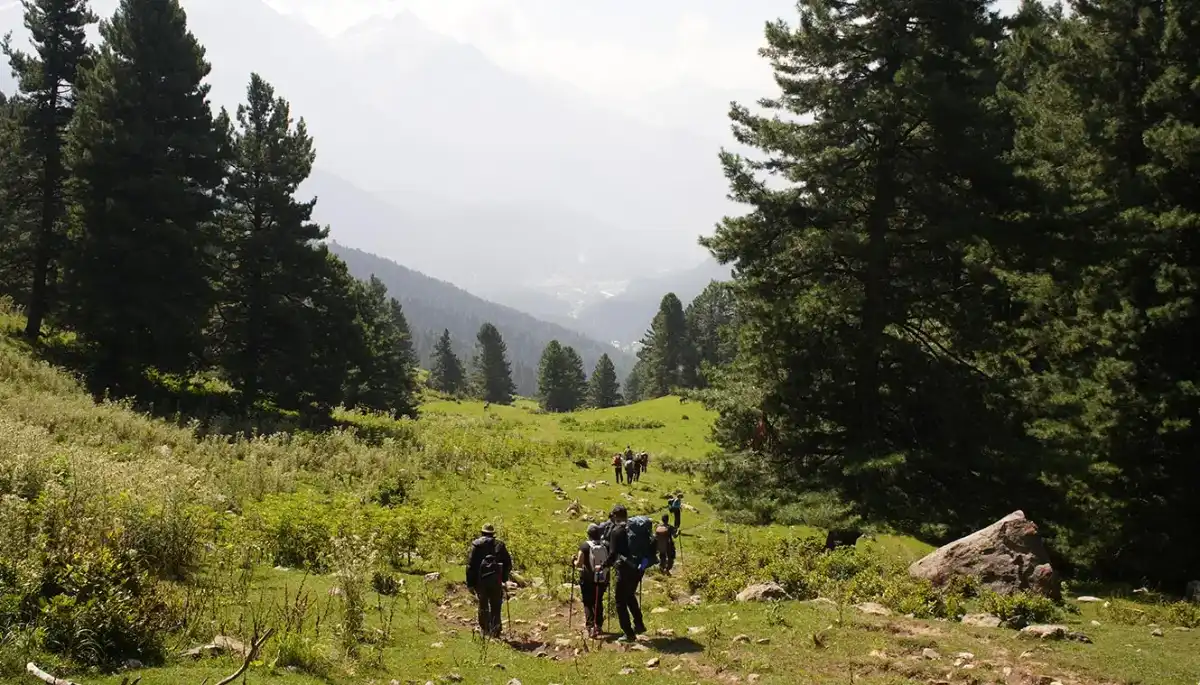
Trek From Dhingapani(Nafran Valley) To Bhaj Margi via Bhajmargi Pass
- Altitude(Bhajmargi): 2900 m/9,500ft.
- Trek Distance: 10 km | 7-8 hrs.
- Stay: In tents (twin sharing).
Today we will descend to Bhaj Margi, one of the most beautiful campsites on the Nafran Valley Trek. From Nafran Valley, walk down the ridge while enjoying magnificent views of the meadows and mountains around. You will cross a forested zone before arriving at the clearing of Bhaj Margi. This is our camping spot for the night. At Bhaj Margi, you will spot horses and cattle grazing leisurely, a beautiful sight to witness.
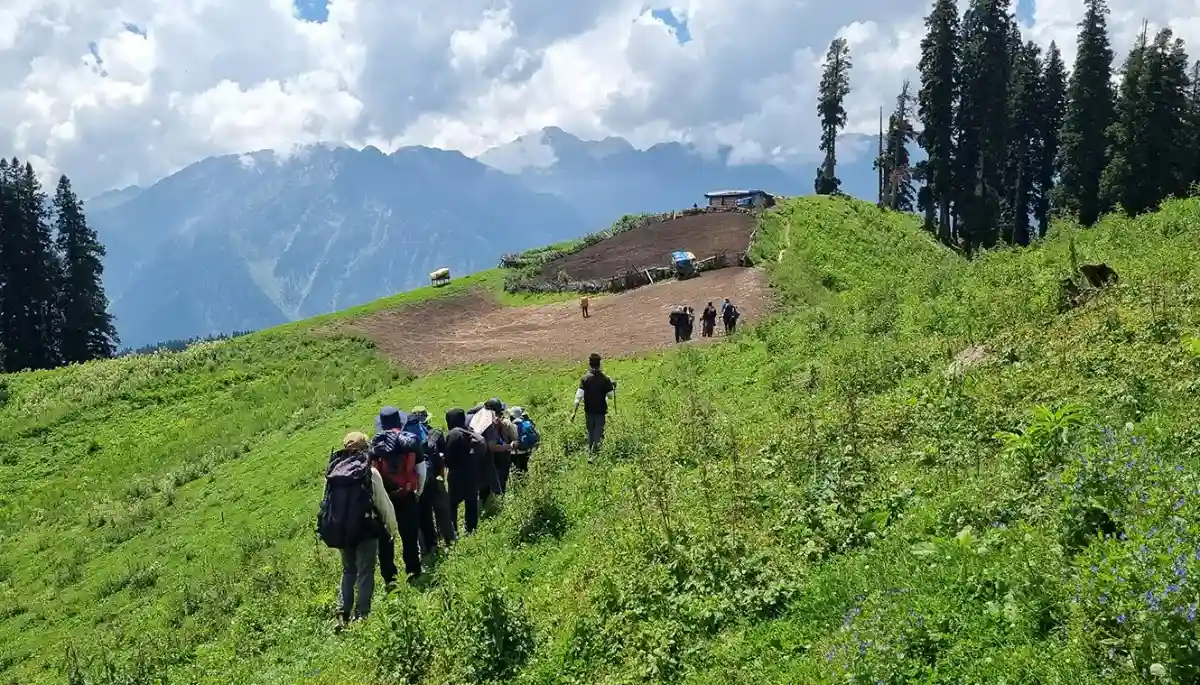
Trek From Bhaj Margi To Mondlan And Drive Back To Srinagar
- Trek Distance(Bhaj Margi to Mondlan): 8 km | 3-4 hrs.
- Drive Distance(Mondlan to Srinagar): 104 km | 4 hrs.
- An easy and gentle walk down to the valley.
- Expect to reach Srinagar by 6:00 PM.
This is the last day of trekking in the mountain and also the last day of this beautiful journey. Today we will trek back from Bhaj Margi to Mondlan and drive back to Srinagar. From the campsite, the trail keeps going southwest until you reach a large wooden gate, which marks the end of the trail. You will now follow a muddy path through a forest cover down to a small shepherd settlement called Shul Margi.
From Shul Margi, you will have to cross a small stream to move further downwards and then again you will have to cross a bigger stream and enter into a forested zone. The forest runs parallel to the road that leads you to Aru. But we will continue on this forested trail and it will lead us into a big clearing that offers a stunning view of Pahalgam.
From here, it is a short descent to Mondlan village situated beside a small mountain stream. Mondlan is 8 km away from Aru and it takes a drive of about 20 minutes to reach Aru. You can expect to reach Srinagar by 6:00 PM.
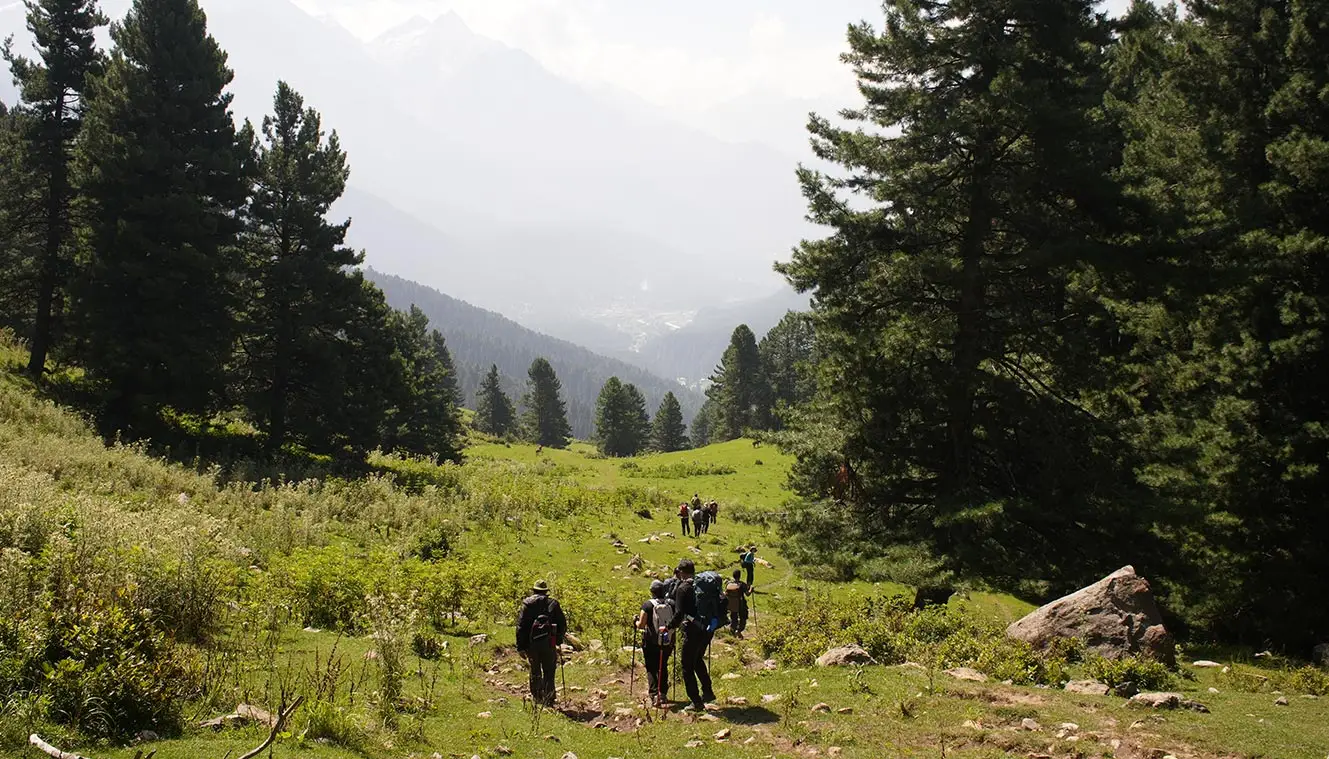
Day-1: Drive From Srinagar To Aru
Day-2: trek from aru to araam pathri.
- Altitude(Araam Pathri): 2,950 m/ 9700 ft.
- Trek Distance: 12 km | 5-6 hrs.
Day-3: Trek From Araam Pathri To Harnag Lake via Harnag Pass
Day-4: trek from harnag lake to harbhagwan lake and back to harnag lake.
- Altitude(Harbhagwan Lake): 4200 m/13800 ft.
- Trek Distance: 8 km(Both way) | 5-6 hrs.
Day-5: Trek From Harnag Lake to Dhingapani (Nafran Valley)
- Altitude(Nafran Valley): 3,200 m/10,500 ft
Day-6: Trek From Dhingapani(Nafran Valley) To Bhaj Margi via Bhajmargi Pass
- Altitude(Bhajmargi): 2900 m/9,500ft.
- Trek Distance: 10 km | 7-8 hrs.
Day-7: Trek From Bhaj Margi To Mondlan And Drive Back To Srinagar
- Trek Distance(Bhaj Margi to Mondlan): 8 km | 3-4 hrs.
- Drive Distance(Mondlan to Srinagar): 104 km | 4 hrs.
Pulse rate at rest must be in between (60 to 90 beats per minute).
Blood Pressure Reading must be in between (DIASTOLIC 70 – 90, SYSTOLIC 100 - 140 mm Hg).
Respiratory rate at rest must be in between (12 to 20 breaths per minute).
Should not have Liver and kidney issues.
Should not have Diabetes Mellitus, Bronchial Asthma, Heart problems, Hypertension, etc.
No pacemaker implant.
People with Sinus issues, Epilepsy please contact to trek coordinator before booking the trek.
If your BMI is not normal, Please contact our Trek coordinator before Trek booking.
Medical & Disclaimer Form (Mandatory Documents) Click here to download Medical & Disclaimer Form
- Government Employees can avail the benefit of Special Casual Leave (SCL) when they join us for a trekking expedition. As per the rules of the Pay Commission, Special Casual Leave can be availed for up to 30 days in a calendar year for trekking/mountaineering expeditions through a registered organization. Trek The Himalayas is a registered adventure tour operator by the Indian Mountaineering Foundation (IMF) and the Ministry Of Tourism (MOT).
- Trekkers have to apply for leave at least 20 days before the trek departure date.
- This service is exclusive to Indian government employees and is applicable only for treks within India.
- Do mail at info@trekthehimalayas to apply and mention your booked trek date and trek name.
Junior trekkers (below 15 years) should have a company of parents/guardians.
Trekkers between 15 to 18 years can come solo with the disclaimer form signed by parent/guardian.
- Medical & Disclaimer Form (Mandatory Documents) Click here to download Medical & Disclaimer Form
Exercise For Moderate to Difficult
Fitness Regime For:
Calculate Your Bmi
Your BMI value is
Congratulations, your body is in good conditions!
Medical & Disclaimer Form (Mandatory Documents) Click Here.
How To Reach
Pick-up information.
- Pick-up location: Tourist reception center, Raj Bagh, Srinagar .
- Once you have reached Srinagar, TTH will manage the rest of your travel arrangements, if you have opted for TTH's pick-up service, you can select this option during the booking process by adding it as an add-on.
- Do reach Srinagar one day before your trek date for a safer side.
- Pick-up Place & Time: Tourist reception center, Raj Bagh, Srinagar 12:00 noon.
Options to Reach Srinagar
1. If you are planning to fly to Srinagar which is well connected to all major airports in India, you can reach the Tourist reception center, Raj Bagh in appx 40 min via taxi from the airport (approx 13 Km).
2. If you’re coming by train, there are two railway stations.
- Jammu railway station is about 260 km away and takes around 8 hours by bus.
- Udhampur is 200 km away and from there, it is a 6-hour bus journey to Srinagar.
3. If you are taking a bus from Jammu, then you have multiple options to take. There are two gates outside Jammu ISBT. You will get shared cabs from both of these gates.
4. If you are reaching the Railway Station, the share cabs to Srinagar will cost between Rs 700 to Rs 1000.
5. Shared cabs are more from the Jammu ISBT compared to the Railway Station. You can travel from the Railway station to the bus stand. The fare of the bus will be Rs 10. The auto will charge around Rs 80 to 120.
Drop-Off Information
- The designated drop-off point is Nishat Garden near the parking area, Srinagar.
- Arrive in Srinagar by 6:00 pm.
- If you have to make any arrangements for further travel from Srinagar, do it the next day.
- TTH offers comfortable transportation through Tempo Traveler, Bolero, or equivalent vehicles. If you wish to upgrade your mode of transportation, please contact your trek coordinator for further assistance.
.webp)
1. Accommodation (as per the itinerary):
- Guest houses on Day 1 (twin/triple sharing basis).
- Camping during the trek (Day 2 to Day 6).
2.Meals (Veg + Egg):
- All meals while trekking.
- Day 1 Dinner to Day 7 Pack Lunch.
3. Support:
- 1 Versatile base camp manager handles communication and deploys extra manpower in emergencies.
- 1 Mountaineering & First aid qualified professional expedition Leader.
- 1 Experienced high-altitude chef.
- Local experienced guides (Number of guides depending on the group size).
- Enough support staff.
4. Trek equipment:
- Sleeping bag, Sleeping liners (if required), mattresses, and Utensils.
- 3 men all season trekker tent (twin sharing), Kitchen & Dining tent, Toilet tent.
- Camping stool, Walkie talkie.
- Ropes, Helmet, Ice axe, Harness(if required).
- Climbing Boots, Gaiters & Crampon /micro spike (if required).
5. First aid:
- Medical kit, Stretcher, Oxygen cylinder, Blood pressure monitor, Oximeter, Stethoscope.
7. Clock room service at base camp. 8. Mules/porters to carry the central luggage. 9. All necessary permits and entry fees, up to the amount charged for Indians. 10. Services from Aru to Mondlan.
1. Insurance (Mandatory). 2. Food during the transit. 3. Any kind of personal expenses. 4. Mule or porter to carry personal luggage. 5. Emergency evacuation, hospitalization charge, etc. 6. Anything not specifically mentioned under the head Inclusion. 7. Transportation (as per the itinerary):
- Mondlan to Srinagar (Day 7).
Srinagar Accommodation: The stay at Srinagar on the last day is not included in the trek fee. However we can assist you in booking a hotel or a houseboat for the same, please let us know at least 15 days in advance to the start of the trek. The intimation is by email only at [email protected]
8. Support
Things can be provided on demand and availability (participant has to pay extra for these things).
1- Satellite phone/set phone - A type of mobile phone that connects via radio links via satellites orbiting the Earth instead of terrestrial cell sites like cellphones. Therefore, they can operate in most geographic locations on the Earth's surface.
2- Gamow/PAC HAPO Bag (Portable Hyperbaric Bag) - It is a unique, portable hyperbaric chamber for the treatment of acute mountain sickness (AMS), also known as altitude sickness.
3- AEDs (Automated External Defibrillators) - Are portable life-saving devices designed to treat people experiencing sudden cardiac arrest, a medical condition in which the heart stops beating suddenly and unexpectedly.
Cancellation terms:
Cancellations prior to 25 days from the start of the Trip
Refund options
- 5% deduction of trek fee
- 100% cash voucher for any trip till one year
- Transfer your trek (any trek, any date) to your friend
Cancellation between 24 days and 15 days to the start of the Trip
- 30% deduction of trek fee
- 100% cash voucher for same trip till one year
- 85% cash voucher for any trip till one year
- Transfer your trek (same trek, any date) to your friend
Cancellation between 14 days and 10 days to the start of the Trip
- 50% deduction of trek fee
- 80% cash voucher for same trip till one year
- 70% cash voucher for any trip till one year
- Book the same trek, in the same season, with any other batch
Cancellation less than 9 days to the start of the trek
- No cash refund
- 20% cash voucher for the same trip till one year
- 10% cash voucher for any trip till one year
- Transfer your trek (same trek, same date) to your friend
Note- If a booking is made using a voucher or discount code, the policies related to vouchers and discounts cannot be modified.
In the unlikely event that TTH cancels a trek prior to the scheduled departure date:
While it is extremely rare for TTH to cancel a trek, we understand that unforeseen circumstances or natural disasters may occasionally require us to do so before the scheduled departure. These circumstances could include continuous rain or snow, thunderstorms, snowstorms, landslides, floods, earthquakes, or any other natural calamity that poses a risk to the safety of our trekkers. Additionally, unforeseeable events such as local riots, curfews, pandemics, lockdowns, government orders, or any similar situations that compromise the safety of the trekking experience may also necessitate a cancellation.
In the event of such a cancellation, TTH will provide you with a voucher equivalent to the amount you paid for the trek. This voucher can be redeemed for any of our treks within the next year, allowing you to still enjoy an adventure with us at a later date.
The issuance of a voucher is not applicable in situations where you are required to descend from the trek for any reason. The trek leader may make the decision to send you down from the trek due to factors such as insufficient fitness level, symptoms of Acute Mountain Sickness (AMS), high blood pressure, exceeding the designated turn-around-time, health concerns, or if you are found smoking, drinking, or violating the rules set for the trek. In such cases, the provision of a voucher does not apply.
In the rare event that TTH shifts a trek:
We would like to emphasize that weather conditions in high-altitude areas are highly unpredictable and can undergo sudden changes at any time, irrespective of the day. Additionally, circumstances beyond our control, such as natural disasters, political unrest, pandemics, and lockdowns, may impact the feasibility of conducting a trek. In cases where we are unable to proceed with an event due to such circumstances that are beyond our direct control, we will make every effort to provide you with an alternative trek that is safer and more suitable.
In such situations, we will issue a voucher to offset the cost difference between the originally scheduled trek and the alternative trek. This voucher can be redeemed at any time within one year from the date of issue. Please note that a refund fee or reimbursement of the cost difference is not applicable in these cases.
- Change of trek batch is dependent on the availability of seats in the batch
- In case of transferring a trek to a friend, he/she should satisfy all the mandatory requirements put forward by TTH
- TTH holds the right to change/cancel the policies, without prior notice
- Cash refund is applicable only in case of bookings made without using any promotional offer code or vouchers
Cash Voucher Terms:
- This is a non-transferable voucher
- The voucher cannot be merged with any other offer of Trek The Himalayas
- The voucher is valid for Trek booked directly with Trek The Himalayas in India
- To avail the voucher please use your register phone number or e-mail id
- All the other Terms of booking a trek with Trek The Himalayas are applicable to the voucher
- Trek The Himalayas holds rights to add/remove any of the Terms and Conditions without prior notice
Itineraries are based on information available at the time of planning and are subject to change. "Trek The Himalayas" reserves the right to change expedition dates, people or itineraries as conditions warrant. If a trip must be delayed or the itinerary changed due to bad weather, road conditions, transportation delays, government intervention, airline schedules, sickness, or other contingency for which TTH or its agents cannot make provision, the cost of delays and/or other changes are the responsibility of the participant. TTH reserves the right to decline, or accept, any individual as a trip member for any reason whatsoever.
Trek Essentials
PDF Of Trek Essential Download
Frequently Asked Questions(FAQ)
How to register/create an account with tth.
To register with TTH, visit our website - www.trekthehimalayas.com and create your account. To create your account you will need to use your email address and fill in all the details, set your unique password and your account is ready to use.
How to book a trek?
- To book a trek with TTH, you first need to register with us and create an account.
- Choose the trek that you want to do and click on available dates.
- You will land at the login page, fill in the required details.
- Add Participants, choose add-on services click on the Pay now button, choose your preferred payment method, and make the payment. TTH accepts multiple payment options, including credit/debit cards, net banking, and UPI.
- You will receive a confirmation email from TTH with all the necessary details about the trek, including the meeting point, transportation, accommodation, and other important instructions.
Click Here to watch Video
Made a payment but did not receive any confirmation.
please send an email to us at [email protected] or reach out to the numbers provided in the Help and Support section of your Trek Page. We will ensure that your issue is promptly resolved.
How to book off-load luggage and transportation?
To book services such as off-load luggage and transportation, you can find them listed as add-ons. These additional services can be booked at the time of your initial booking. If you miss booking add-ons during the initial reservation, you can log in anytime and easily book 4 days before the departure date add-ons through the platform.
If I have booked the wrong trek or date, how can I make changes?
In such a situation, please log in to your account and transfer your trek or date to the desired one within 12 hours or drop us an email at [email protected] 10 days before the departure date of the trek. After the initial 12-hour period, any changes will be processed according to the cancellation policy.
I am a beginner and confused which trek to book.
We recommend visiting our "Suggest Me a Trek" page. By filling out the form, our experts will contact you with the best possible trek options based on your preferences and experience level. Alternatively, you can reach out to us via email at [email protected] or give us a call using the numbers provided on our website for personalized assistance and recommendations.
How is family trek different from regular trek?
Family treks differ from regular treks by focusing on ease of difficulty, offering shorter durations for younger participants, Kid-friendly and easily digestible foods, child-friendly activities, maintaining a higher guide ratio for diverse age groups, and implementing additional safety measures for families.
Ideal treks for children.
Family Trek with Kids recommendation Only Dayara Bugyal and Chopta Chandrashila Trek.
Minimum age for children to trek with TTH.
Minimum age for TTH treks is typically 7 years, though this may vary depending on the specific trek.
Can we take children to high altitudes with their guardian?
Yes, you can take a kids to a high-altitude trek with a parent. Discuss with a trek expert before booking a trek.
Can we send kids without Parents/guardian?
Medical & Disclaimer Form (Mandatory Documents) Click here to download medical and disclaimer form
How to prepare a child for a high altitude trek?
Physical Fitness: Ensure your child is physically fit. Engage them in regular exercise, outdoor activities, and hikes to build stamina and endurance. Hydration: Emphasize the importance of staying hydrated at high altitudes. Encourage your child to drink water regularly, even if they don't feel thirsty. Proper Nutrition: Provide a well-balanced diet with sufficient carbohydrates for energy and foods rich in iron to prevent altitude sickness. Adequate Sleep: Ensure your child gets enough sleep in the days leading up to the trek. Quality rest is crucial for altitude adaptation. Educate on Altitude Sickness: Teach your child about the symptoms of altitude sickness, such as headache, nausea, and dizziness. Encourage them to communicate any discomfort immediately. Appropriate Clothing and Gear: Dress your child in layers to adjust to changing temperatures. Ensure they have appropriate trekking gear, including sturdy footwear. Positive Mindset: Foster a positive mindset. Encourage your child, and let them know it's okay to take breaks when needed. Medical Check-Up: Schedule a medical check-up before the trek to ensure your child is fit for high-altitude activities. Consult with a healthcare professional about any potential health concerns.
Kind of food will be served during the trek for children.
TTH takes special care to provide wholesome and nutritious food for children on treks. Here are some of the foods that are typically served for children: Breakfast: For breakfast, TTH serves a variety of options like porridge, cornflakes, bread, butter, jam, honey, boiled eggs, omelettes, and pancakes. Children can choose from these options to fuel themselves for the day's trek. Lunch: For lunch, TTH serves lunch which includes rotis, vegetables, rice, dal, and salad. The rotis are usually made fresh on the trek and are a good source of carbohydrates. The dal and vegetables provide protein and other essential nutrients. Snacks: TTH provides healthy snacks like fresh fruits, dry fruits, energy bars, cookies, and biscuits to keep the children energized throughout the day. Dinner: For dinner, TTH serves a hot and wholesome meal which includes soup, rice, dal, vegetables, and a non-vegetarian dish (if requested in advance). Children can also choose from a variety of desserts like custard, jelly, and fruit salad. Dietary requirements: If a child has any special dietary requirements, TTH can cater to those needs as well. For example, if a child is lactose intolerant or allergic to nuts, the kitchen staff can make arrangements to accommodate those requirements.
How to choose the right trek?
Choosing the right trek for a beginner can be a bit overwhelming as there are many factors to consider such as distance, elevation gain, terrain difficulty, weather, and time of year. Here are some tips that can help you choose the right trek for a beginner:
1. Determine fitness level: Assess the fitness level of the beginner to understand their physical capabilities. This will help you select a trek that is challenging but not too difficult.
2. Choose a well-traveled trail: A well-traveled trail will have more amenities such as signposts, water stations, and shelter. It is also safer as there will be other hikers on the trail.
3. Consider the length of the trek: For beginners, it is recommended to start with a shorter trek that can be completed in a day or two. This will help them get acclimatized to trekking and build their confidence.
4. Look for gradual elevation gain: Choose a trek with a gradual elevation gain rather than steep ascents. This will make the trek easier and more enjoyable.
5. Check the weather: Check the weather forecast before selecting a trek. Avoid treks during the monsoon season or winter when the trails can be slippery or dangerous.
6. Research the trail: Read about the trail to get an idea of the terrain, altitude, and difficulty level. This will help you select a trek that is suitable for the beginner.
7. Consult with an expert: If you are unsure about which trek to choose, consult our trek expert Mr. Nitin (+91 70600 59773) between 10 AM to 6 PM (Tuesday - Friday). Mr. Nitin will provide you valuable advice and guidance.
Overall, it is important to choose a trek that is enjoyable, challenging but not too difficult, and suitable for the beginner's fitness level and experience.
Can a beginner choose a tough trek?
It is not recommended for a beginner to choose a difficult Himalayan trek. Trekking in the Himalayas can be physically and mentally challenging, especially if you are not used to the high altitude, steep slopes, and rugged terrain. Choosing a difficult trek without the proper experience, fitness level, and preparation can be dangerous and put you at risk of altitude sickness, injury, and other hazards.
If you are a beginner, it is recommended to start with an easier trek and gradually build up your skills and experience. This will help you understand the challenges of trekking in the Himalayas, and also prepare you physically and mentally for a more difficult trek in the future. It is also important to choose a trek that matches your fitness level, experience, and interest.
What is the age limit for a beginner trekker?
There is no specific age limit for a beginner trekker. However, it is important to consider your physical fitness, health condition, and personal interests before embarking on a trek. Trekking in the Himalayas can be physically and mentally demanding, and requires a certain level of physical fitness and endurance.
If you have any pre-existing medical conditions or are above a certain age, it is recommended to consult with a doctor before embarking on a trek. It is also important to listen to your body and take breaks as needed during the trek to prevent exhaustion or injury.
If I am solo, can I join the trek in a group?
Yes, you can join the trek. We have fixed departure groups where you can simply book your trek and we will take care of curating a group.
How does my family get updated about my Trek?
Before you start the trek, it is recommended that you make all the necessary phone calls as during the trek you may or may not receive network coverage, once you come back to the Base Camp, you can reconnect with your family via phone once again. You can share your trek coordinator contact detail with your family members to get the latest updates about your trek batch.
What food can I expect?
At TTH, we provide wholesome and nutritious meals during the trek. The food is vegetarian and includes a variety of dishes such as rice, dal, vegetables, chapati, paratha, pasta, noodles, and soup. We also offer snacks such as biscuits, and salty, and dry fruits during the trek. Special dietary requirements such as vegan, gluten-free, or Jain food can also be arranged if informed in advance.
I am allergic to some foods.
If you are allergic to some foods, you need to let us know in advance so that we can make arrangements accordingly.
How safe is trekking with TTH?
TTH is a trekking company that prioritizes the safety of all its participants, including women trekkers. They have a comprehensive safety system in place, which includes a dedicated team of experienced and trained trek leaders and support staff who are equipped to handle emergency situations and provide first aid.
TTH also takes specific measures to ensure the safety and comfort of women trekkers. They have a separate tent accommodation for women trekkers, female trek leaders, and support staff. They also provide separate toilet facilities for women and encourage a safe and respectful environment for all trekkers.
Moreover, TTH has a strict policy against any kind of harassment and has a zero-tolerance policy towards such incidents. They have a designated Internal Complaints Committee (ICC) to investigate and address any complaints related to harassment or misconduct. Overall, TTH has a good reputation for safety and responsible trekking practices, and women can feel comfortable and safe while trekking with them.
How TTH will manage if I am the only woman in the group?
In case you are the only women in the group, we provide a single sleeping arrangement. Also, during the trek, the trek leader will always remain by your side to provide optimum safety and reassurance.
How can I know that other women are in the batch?
You can reach out to the trek coordinator to inquire about the number of female trekkers and their respective states who have booked the trek. Please note that the trek coordinator cannot disclose personal details of any trekker. Once you've confirmed your booking, a WhatsApp Group will be created for all the trekkers in your batch. This allows you to connect with fellow trekkers before the trek begins.
Can I know in advance, which trek is led by a women Trek Leader?
While many of our treks are led by female trek leaders, however, it is not possible to know which trek leader is assigned to which group. But nonetheless, whether the trek leader is male or female you can be completely assured of your safety and security with us.
Can I trek with periods? If yes, then where can I dispose of the sanitary pad?
Yes, it is possible to trek with periods. However, it is important to take some extra precautions and preparations to ensure a comfortable and safe trekking experience.
Here are some tips that can help you trek during your period:
1. Use menstrual hygiene products that you are comfortable with, such as tampons, pads, or menstrual cups. It is recommended to carry enough supplies for the entire duration of the trek.
2. Pack wet wipes, hand sanitizer, and plastic bags to dispose of used hygiene products.
3. Wear comfortable and breathable clothing that allows for easy movement and reduces friction. Avoid wearing tight or restrictive clothing that can cause discomfort.
4. Carry pain relief medication, such as ibuprofen or acetaminophen, in case of menstrual cramps.
5. Stay hydrated and maintain a balanced diet to support your energy levels and overall health.
6. Take breaks as needed and listen to your body. If you feel uncomfortable or experience any unusual symptoms, seek medical attention immediately.
It is also recommended to consult with a doctor before going on a trek during your period, especially if you have a pre-existing medical condition or are taking medication. By taking necessary precautions and being prepared, you can have a safe and comfortable trekking experience even during your period.
We provide proper disposal facilities for sanitary pad disposal during the trek.
How will the accommodation be during the trek?
We offer three person tents with twin-sharing for optimum comfort. A woman trekker will share a tent with another woman trekker and if you are the only woman in the group, you will be given a single accommodation for your comfort and privacy.
Are trek poles, Jackets and other equipment available for rent from Trek The Himalayas?
Yes, we do provide gears on rent. You can book it using you TTH account directly.
Who will be with us on the trek from Trek The Himalayas?
Mountaineering qualified Experienced and first aid certified Trek Leader, First Aid Certify local guide, Cook, helpers and supporting staff.
Who can not join the trek?
People suffering from Bronchitis, Asthma, High blood pressure, Epilepsy (got faints), TB , Heart problem or on higher BMI side are strictly not allowed to go on any Himalayan trek. Apart from this if you had any medical history, please let us know.
When it gets really cold can I consume alcohol?
No. Alcohol and smoking isn’t allowed while on trek. It is totally misconception that it will keep you warm. Your body need to acclimatize properly and for that eat properly and drink enough water; these things will keep you warm.
What type of toilet facility is TTH providing at the trek?
Toilet tents provide a convenient solution for answering nature's call in the great outdoors. Dry toilets, in particular, offer a highly sanitary approach. By digging a pit and utilizing mud and a shovel, you can easily cover up your waste. This method ensures cleanliness and hygiene while camping or exploring in the forest.
Remember to pack essential toiletries to complete your outdoor bathroom kit and maintain proper personal hygiene during your adventures. With these practices in place, you can enjoy nature while also respecting it.
How do I manage the negative temperatures on the trek at higher camps? Do I need special jackets?
Layer Up From Head To Toe Eat Full Meals, never sleep empty stomach You can keep warmee (if you’re more susceptible to cold). Use sleeping bag in right way and don’t leave free space in sleeping bag.
For upper body – Thermal layer – T-shirt (full-sleeves) – Fleece T-shirt (for extreme colds) – Fleece layer – Thick Jacket/Down Jacket – Waterproof or Windproof layer (outermost layer, when it is snowing or raining) - For Lower Body – Thermal layer – Hiking pants (normal) or Winter hiking pants
Based on how warm you feel you can skip any of the above layers. Your outer later should be windproof since it is windy at high altitude. The idea behind layering is that the more insulation you have the less cold you feel, and instead of wearing a very thick jacket if you wear multiple layers, your body will be better insulated against the cold.
Do you provide crampon/micro spikes and gaiters?
Yes, we provide micro spikes and gaiters, if required.
What documents need to carry on trek?
Mandatory documents: 2 xerox of ID having address (addhar card/driving license), 2 Passport size photographs, hard copy Medical form signed & sealed by doctor, disclaimer form sign by trekker and high altitude insurance.
If we come prior the trek date, Do you provide accommodation?
No. We don’t but we can suggest you good hotel/Stay nearby pick up location.
Do we get enough water for drinking?
Yes, trekker must carry 2 water bottles 1 litre each so they can refill it at campsite for drinking and keep themselves hydrate.
What kind of shoes we should buy for the trek?
You should buy shoes which has these three features –Good grip, Ankle Support and additional water resistant layers. Generally, we advise Quechua Trek 100, MH 500 and MH 100.
What happens if some members of the team need to turn back before the summit?
No one is forced to go on. There is always enough staff to split the party according to need and regroup later at the camp. Most people have no trouble reaching the highest campsite. If some members decide not to climb the final distance they can wait for the climbers to come back down the same way or take a lateral path to the descent route.
How do I reach the starting point of the Nafran Valley Trek from Srinagar?
To reach the starting point of the Nafran Valley Trek, you have to drive approximately 112 km. The journey takes you through breathtaking landscapes, passing by quaint villages, lush valleys, and winding mountain roads. Upon reaching Aru village, you will be greeted with the serene ambiance of the Kashmiri countryside.
What is the difficulty level of the Nafran Valley Trek?
The Nafran Valley Trek is moderate to difficult and presents challenges that require a good level of physical fitness and prior trekking experience in the Himalayas. Trekkers can expect to encounter steep ascents, rugged trails, and varying weather conditions during the journey. However, with proper preparation, guidance, and determination, trekkers of all skill levels can undertake this adventure and revel in its rewards.
Can beginners undertake the Nafran Valley Trek?
While beginners are welcome to join the Nafran Valley Trek, they should undergo adequate preparation and training beforehand. Due to the trek's challenging nature and high altitude, prior experience in Himalayan trekking can greatly enhance the overall experience and ensure the safety and enjoyment of participants. Additionally, joining guided tours or trekking with experienced companions can provide valuable support and guidance along the way.
What is the best time to go for the Nafran Valley Trek?
The optimal time to undertake the Nafran Valley Trek is during the months of July to September when the region is adorned with blooming wildflowers, lush greenery, and clear skies. This period offers favourable weather conditions with moderate temperatures, making it ideal for trekking and outdoor activities.
Are there any specific highlights or attractions along the Nafran Valley Trek route?
The Nafran Valley Trek boasts a plethora of highlights and attractions that add to its appeal. From the picturesque Aru Valley and tranquil Harnag Lake to the charming shepherd settlements scattered along the route, trekkers are treated to a feast for the senses at every step of the journey. Whether it's marvelling at the panoramic views of the Nafran Valley or interacting with the local shepherds and experiencing their way of life, each moment on the trek is filled with unforgettable experiences and memories to cherish.
How are the camping facilities along the Nafran Valley Trek?
Camping facilities along the Nafran Valley Trek are carefully arranged to provide trekkers with a comfortable and immersive outdoor experience amidst nature's grandeur. Designated campsites are chosen for their scenic beauty and strategic location, offering panoramic views of the surrounding landscape and easy access to essential amenities. Tents are provided to shelter trekkers from the elements, while hearty meals are cooked to ensure nourishment and warmth during the trek.
Is it possible to encounter wildlife during the Nafran Valley Trek?
While encounters with wildlife are not guaranteed, the Nafran Valley Trek offers ample opportunities for trekkers to observe and appreciate the rich biodiversity of the region. From Himalayan birds soaring overhead to elusive wild animals like ibex and musk deer glimpsed among the trees, the trek is a haven for nature lovers and wildlife enthusiasts alike. Trekkers are encouraged to maintain a respectful distance from wildlife and refrain from disturbing their natural habitat to ensure their safety and well-being.
What safety measures should I be aware of while trekking in the Nafran Valley?
Safety is paramount during the Nafran Valley Trek, and trekkers are advised to adhere to certain precautions to ensure a smooth and enjoyable journey. It's essential to stay hydrated by drinking plenty of water, especially at higher altitudes where dehydration can occur more rapidly. Additionally, trekkers should be vigilant for symptoms of altitude sickness, such as headache, nausea, and fatigue, and notify their trek leader immediately if they experience any discomfort. Following the guidance of experienced trek leaders, sticking to designated trails, and carrying essential safety gear such as first-aid kits and emergency supplies are also crucial for ensuring a safe and successful trekking experience.
Are there any altitude-related concerns during the trek?
Yes, the Nafran Valley Trek involves trekking to altitudes of up to 14,127 ft, which can pose risks of altitude sickness for trekkers who are not adequately acclimatized. To mitigate these risks, the trek itinerary includes acclimatization days at strategic intervals, allowing trekkers to gradually adjust to the altitude and minimize the chances of altitude-related illnesses. Trekkers are advised to stay hydrated, avoid overexertion, and listen to their bodies for any signs of discomfort or distress. If symptoms of altitude sickness such as headache, dizziness, or nausea occur, trekkers should notify their trek leader immediately for proper assistance and medical attention.
What are the options for food and water sources along the Nafran Valley Trek?
When trekking with us, trekkers on the Nafran Valley Trek can expect to be well-provisioned with nutritious meals and safe drinking water throughout the journey. Experienced trekking teams and support staff ensure that trekkers are adequately supplied with hearty meals cooked using fresh ingredients and traditional recipes, providing sustenance and energy for the rigorous demands of trekking. Water sources such as mountain streams and natural springs are readily available along the trekking route, allowing trekkers to replenish their supplies and stay hydrated during the journey. However, it's important to exercise caution and use water purification methods such as filtration or sterilization to ensure the safety and cleanliness of drinking water, minimizing the risk of waterborne illnesses and ensuring a healthy and enjoyable trekking experience for all participants.
What should I pack for the Nafran Valley Trek?
Packing the right gear and essentials is crucial for a successful and enjoyable trekking experience in the Nafran Valley. Some essential items to pack include sturdy hiking boots, comfortable clothing suitable for layering, waterproof outerwear, a warm sleeping bag, a backpack with sufficient capacity, sunscreen, sunglasses, a hat, a headlamp or flashlight, a first-aid kit, water purification tablets or filters, trekking poles, energy snacks, and personal hygiene products. Additionally, it's advisable to carry essential documents such as identification, permits, and emergency contact information, as well as any prescribed medications or medical supplies. Trekkers should pack light but ensure they have everything they need to stay comfortable, safe, and prepared for the challenges of the trek.
Can I hire a porter or mule to carry my belongings during the Nafran Valley Trek?
Yes, trekkers have the option to hire porters or mules to assist with carrying their belongings during the Nafran Valley Trek, especially for those who prefer to trek with lighter backpacks or have limited trekking experience. However, it's essential to negotiate fair wages and adhere to ethical treatment guidelines for porters and mules to ensure their well-being and welfare throughout the trek.
Is there mobile phone reception or internet connectivity available during the Nafran Valley Trek?
Mobile phone reception and internet connectivity may be limited or unavailable in remote areas along the Nafran Valley Trek route, some pockets of network coverage may be sporadically accessible depending on the trekking location and service providers. Trekkers should be prepared for intermittent connectivity and plan accordingly by informing family members or emergency contacts before starting the trek.
Are there restroom facilities available along the Nafran Valley Trek route?
For restroom facilities, we typically provide portable toilet tents or designated toilet areas at overnight campsites to ensure hygiene and convenience for trekkers. These toilet facilities may consist of dry pit toilets or environmentally friendly composting toilets, which require minimal water usage and adhere to Leave No Trace principles. Additionally, trekkers are encouraged to practice responsible waste disposal by carrying out all non-biodegradable waste and minimizing environmental impact during the Nafran Valley Trek. It's essential to maintain cleanliness and respect the natural surroundings.
What should I do in case of an emergency or medical issue during the Nafran Valley Trek?
In the event of an emergency or medical issue during the Nafran Valley Trek, trekkers should immediately notify their trek leader or support staff for prompt assistance and intervention. We are always equipped with first aid kits, and emergency medical supplies to address common trekking-related ailments such as altitude sickness, minor injuries, or gastrointestinal discomfort. If necessary, evacuation procedures may be initiated to transport affected trekkers to the nearest medical facility or evacuation point for further evaluation and treatment. It's essential for trekkers to communicate any health concerns or symptoms promptly and follow the guidance of trek leaders to ensure the safety and well-being of all participants throughout the trek.
- Date and Price
Rent A Gear
Trek Articles
Quick Links
Trekking & Hiking
Mountaineering
Multi Sports
Himalayan Pilgrimage
Website Privacy
Terms & Condition
Contact Info
Get in touch with us. E-mail us Monday-Saturday (10 AM to 6 PM)
Address: Trek The Himalayas 7/2/1, Convent road, Near SBI Main Branch Dehradun-248001,Uttarakhand
Phone: 8191004846
Email: [email protected]
2010 Trek The Himalayas. All rights reserved

IMAGES
VIDEO
COMMENTS
Experience the best of trekking in Kashmir. Explore pristine lakes and vibrant meadows with Tarsar Marsar Trek.
The Tarsar Marsar trek is among the most popular in the Indian Himalayas. The trek takes you through the beautiful valleys of Kashmir, offering breathtaking views of the Tarsar and Marsar lakes. The trek is moderate and can be completed in about 7-9 days. In this article, we will discuss the reasons to go on the trek, what to expect on the trek ...
Complete information on the Tarsar Marsar trek. Trek details, itinerary, reviews, cost, maps, photos, videos and more.
Tarsar Marsar Trek, the Prettiest Lakes in Kashmir Aru valley -INDIA- Complete information, 2024 Tarsar Marsar Trek lies in the fascinating beauty of Kashmir which is well known across the globe. Therefore, on Tarsar Marsar Trek go deep in the heart of Kashmir and get totally different experiences of Trekking in India.
Tarsar Marsar trek group tour starting on 12th August 2023 from Srinagar. Check for complete details with photos and charts.
Tarsar Marsar Trek in Jammu & Kashmir with a total distance of 60 km, starting and ending at Aru. The best time to visit, Trek difficulty, Trek Cost...
The Tarsar Marsar Trek is a popular 7-8 day trek in Jammu and Kashmir that takes you through some of the most stunning landscapes in the region. The trek starts from the Aru Valley and takes you through beautiful alpine meadows, dense forests, and scenic high-altitude passes before reaching the Tarsar and Marsar lakes.
Experience one of the most beautiful lakes trek to Tarsar Marsar, in Kashmir. Experience local cusine, flora, amazing views, and so more.
Located in the most beautiful confines of Kashmir, the Tarsar Marsar trek is a captivating adventure that unveils the pristine beauty of three alpine lakes: Tarsar, Marsar, and Sundarsar. This 7-day trek, starting from the picturesque village of Aru, offers an unparalleled experience of Kashmir's scenic landscapes, lush meadows, and serene ...
The Tarsar-Marsar Trek is a best alternative and most beautiful than its sibling Great Lakes trek. The trek expedition lies in the remote valley of Aru in Lidder Valley. The Tarsar-Marsar as the name suggests treks to the twin lakes of Tarsar and Marsar. The lakes are separated by a mountain.
Tarsar Marsar Trek Overview Kashmir, rightfully proclaimed as 'heaven on Earth', is a land of pristine mountains, verdant meadows, azure lakes, and breathtaking natural splendour. It is also home to some of the most spectacular treks in the lap of Himalayas, the most popular of which is the Tarsar Marsar Trek. Perched on the high altitude of 13,201 feet, the Tarsar Marsar Lake Trek offers ...
Tarsar Marsar Lakes Trek Itinerary Kashmir Tarsar Marsar Trek Summary: Trekking region: Aru valley Pahalgam District, Anantnag Jammu and Kashmir, North Indian Himalayas. Elevation 4000 meters, Grade: Cross country Moderate, Time requires, 5 to 7 Days. Total Distance 55 KM. Best time June, July, August, September, October.
Experience an unforgettable adventure on the Tarsar Marsar Trek. Book your Tarsar Marsar Trek today and explore the beauty of the Kashmir.
Experience the magic of Tarsar Marsar Trek, a captivating journey through the pristine landscapes of Kashmir. Our website is your gateway to discovering the beauty of Tarsar and Marsar lakes, nestled amidst majestic mountains and lush meadows. Explore trekking routes, find detailed information on packages and itineraries, and get expert tips for a safe and memorable trekking experience.
Tarsar Marsar Trek with its snow-capped mountains, colorful valleys is one of the most beautiful and calm trek of the Kashmir Himalayas.
The Tarsar Marsar Lakes trek is graded as a moderate trek when compared to other treks of the Indian Himalayas. For the beginners, it could be a little difficult trek because of their inexperience.
Embark on an otherworldly adventure with the Tarsar Marsar trek. Traverse breathtaking valleys, shimmering lakes, and towering peaks as you immerse yourself in the untamed beauty of Kashmir. Experience the thrill of conquering challenging terrain while forging unforgettable memories amidst nature's finest masterpiece. Discover a celestial escape where time stands still, leaving you mesmerized ...
Tarsar Marsar Lake Trek is one among the highly opted treks of the Kashmir valley. It is a trek encompassing a journey to the two beautiful twin lakes, Tarsar and Marsar, encircled by the peaks of Kolhai Mountain.
Embark on the Tarsar Marsar Trek, where every step unravels the beauty of Kashmir. Join Great Himalayan Vacations for an unforgettable adventure,
Tarsar Marsar Lake. Source: Instagram account @adyantha_venkat. Tarsar Lake and Marsar Lake are two alpine lakes situated at the altitude of 12500ft and 13000ft respectively in the Kashmir Himalayas. These two lakes are of similar nature and separated by a mountain. This is why they are called twin sisters.
Travel The Himalayas is now offering the Classic Tarsar Marsar Trek at the special inaugural Price. All our Treks in this area are lead by locals who would also introduce you to the local culture and flavor. It just wont be a Trek. It would a whole experience. This is one of the most scenic Treks in the Valley its a moderate difficulty level and used to be a huge hit with foreigners once upon ...
The moderate trek route is famous for its explicit beauty of the surrounding and the view of the beautiful lakes surrounded by alpine trees. Tarsar and Marsar lakes rests at the Aru district of Jammu and Kashmir which are quite fascinating due to their almond shape. The lakes are separated by a mountain and flows in the opposite direction where ...
Why Nafran Valley Is A Must-Do Trek? The beauty of Kashmir is simply bewitching and treks like Kashmir Great Lakes Trek and Tarsar Marsar Trek stand as great examples.